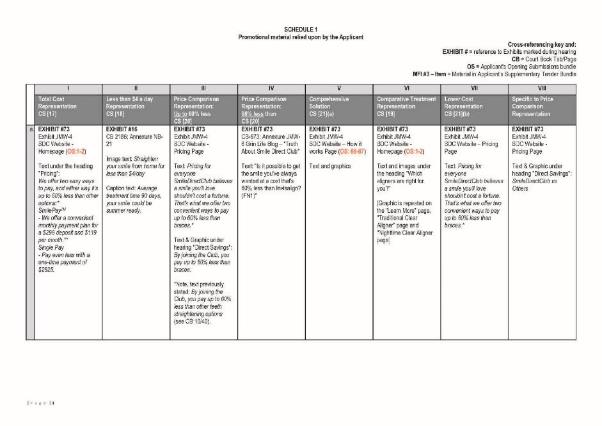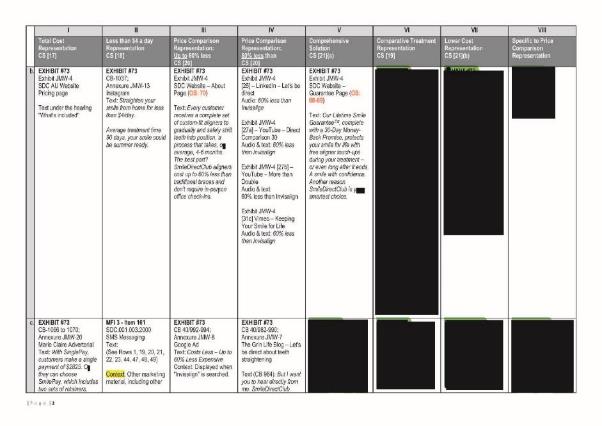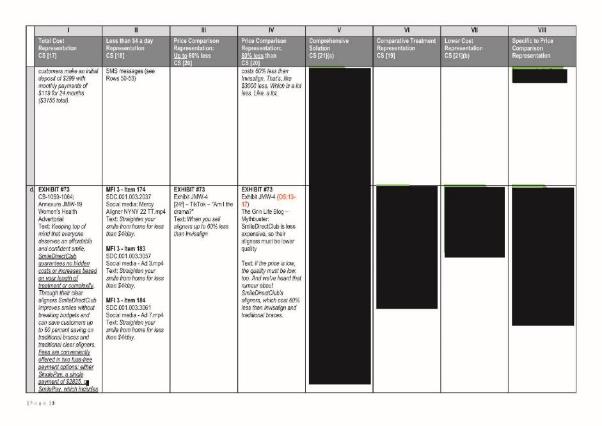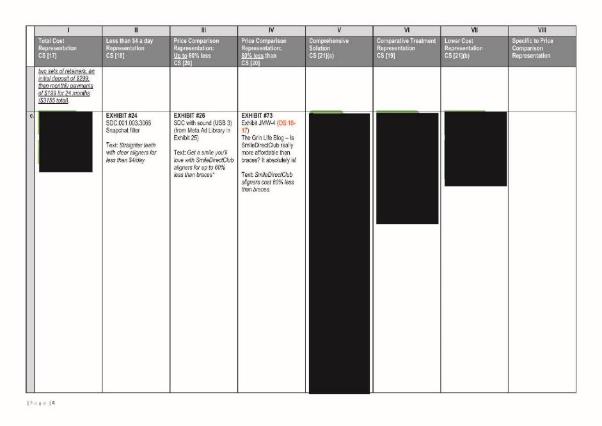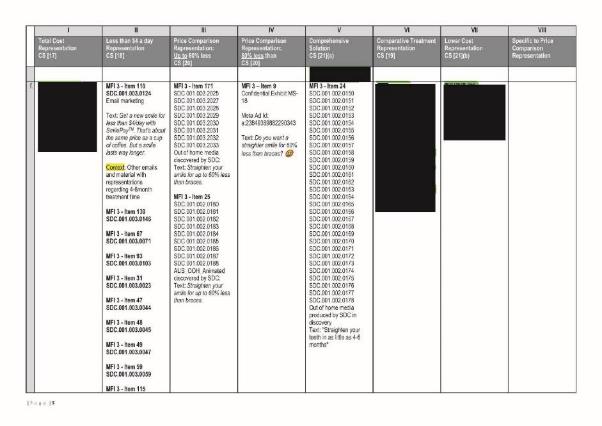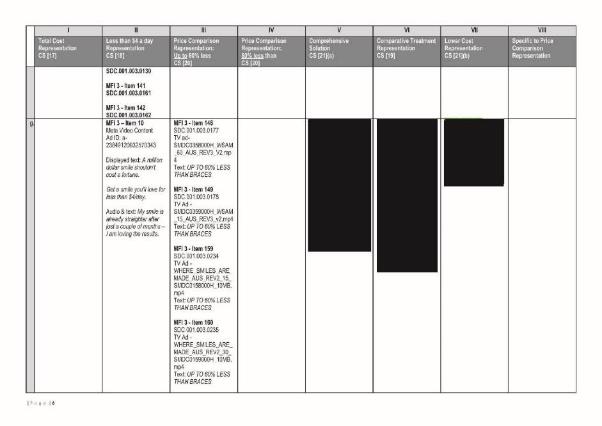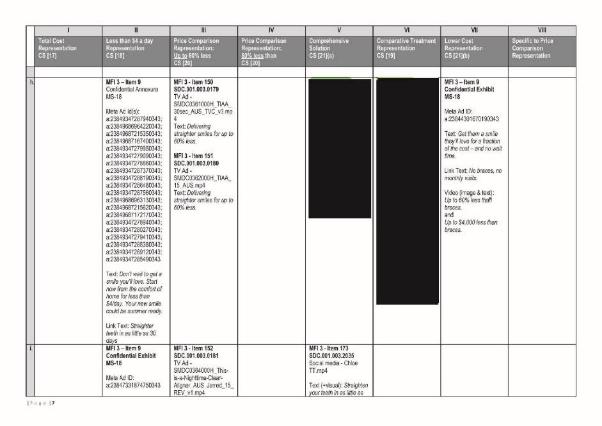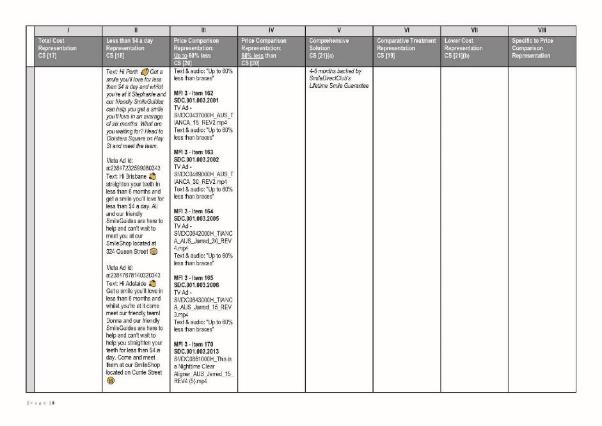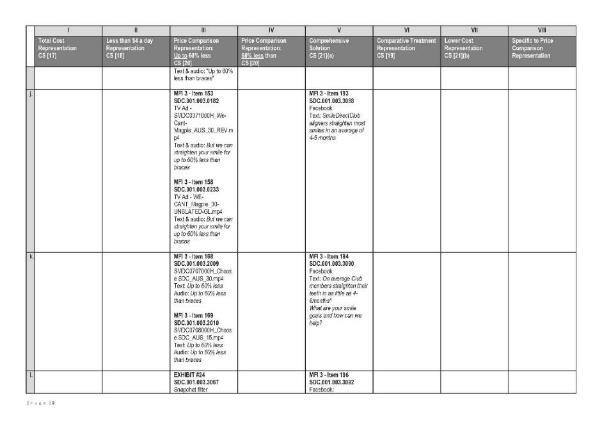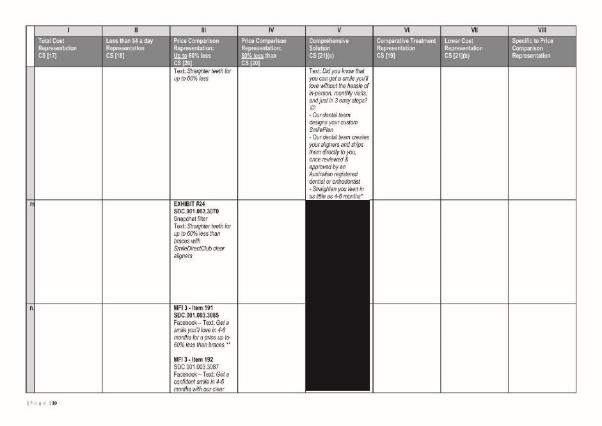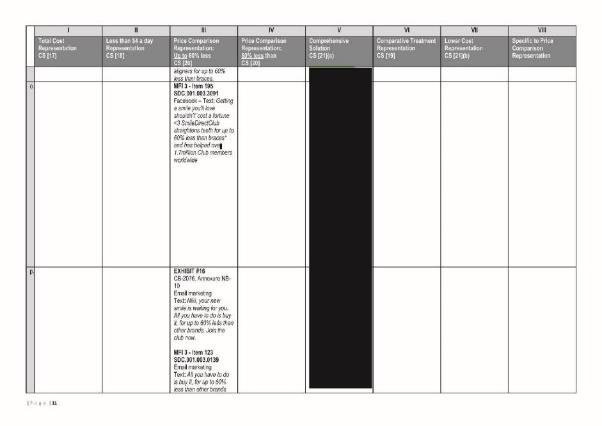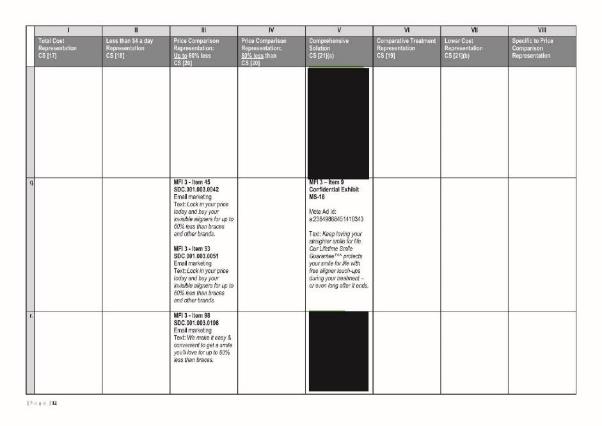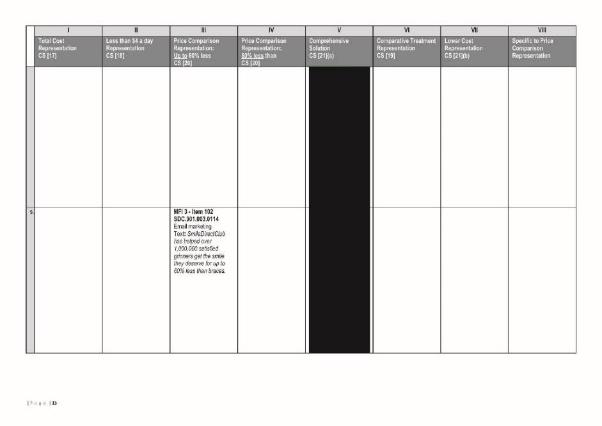FEDERAL COURT OF AUSTRALIA
Invisalign Australia Pty Limited v SmileDirectClub LLC [2023] FCA 395
ORDERS
DATE OF ORDER: |
THE COURT ORDERS THAT:
1. The applicant be granted leave to file and serve the Amended Concise Statement in the form set out in Annexure A to the proposed minutes of order received by the Court on 31 October 2022.
2. The applicant’s claim be dismissed.
3. The applicant pay the respondents’ costs of the claim, to be fixed by way of an agreed lump sum or, in default of agreement, by way of a lump sum fixed by a Registrar.
4. The cross-claimant’s cross-claim be dismissed.
5. The cross-claimant pay the cross-respondent’s costs of the cross-claim, to be fixed by way of an agreed lump sum or, in default of agreement, by way of a lump sum fixed by a Registrar.
Note: Entry of orders is dealt with in Rule 39.32 of the Federal Court Rules 2011.
ANDERSON J:
[1] | |
[14] | |
[16] | |
[22] | |
Rulings on objections to the evidence of Mr David Cristofaro | [43] |
[82] | |
[85] | |
[93] | |
[94] | |
[95] | |
[95] | |
[103] | |
[106] | |
[109] | |
[111] | |
[114] | |
[117] | |
[136] | |
[141] | |
[145] | |
[150] | |
[155] | |
[159] | |
[159] | |
[166] | |
[175] | |
[175] | |
[180] | |
[220] | |
[220] | |
[224] | |
[228] | |
[235] | |
[244] | |
[259] | |
[269] | |
[274] | |
[277] | |
[284] | |
[294] | |
[310] | |
[326] | |
[327] | |
[329] | |
[330] | |
[331] | |
[337] | |
“Up to 60% less than braces” claim on the SDC Australian Website | [339] |
[347] | |
[350] | |
[355] | |
[359] | |
[360] | |
[362] | |
[405] | |
[407] | |
[412] | |
[416] | |
[419] | |
[421] | |
[423] | |
[427] | |
[433] | |
[443] | |
[501] | |
[502] | |
[527] | |
[544] | |
[562] | |
[568] | |
[570] | |
[587] | |
[613] | |
[617] | |
[618] | |
[630] | |
[646] | |
[650] | |
[655] | |
[658] | |
[665] | |
[674] | |
Role of general dentists in diagnostic assessment of patients | [678] |
[681] | |
[692] | |
[697] | |
[698] | |
[699] | |
[699] | |
[718] | |
[731] | |
[733] | |
[733] | |
[739] | |
[740] | |
[741] | |
[742] | |
[743] | |
[778] | |
[785] | |
[799] | |
[803] | |
[815] | |
[819] | |
[825] | |
[831] | |
[837] | |
[873] | |
[874] | |
[883] | |
[887] | |
[891] | |
[893] | |
Representations alleged to have been made by Invisalign in the DIY article | [898] |
[901] | |
SDC’s contention that the “representations” were made by Invisalign | [907] |
[915] | |
[932] | |
[973] | |
[981] | |
[1002] | |
[1009] |
1 The applicant (Invisalign) and the respondents (collectively, SDC) are competing providers of clear aligner teeth straightening products in Australia. Invisalign alleges that SDC has engaged in false, misleading or deceptive conduct in relation to certain promotional material that it has published with respect to its clear aligners (SDC aligners). The promotional material that is the subject of Invisalign’s claim is listed in Annexure A to the Concise Statement (CS), which was later amended under Annexure A to the Amended Concise Statement (Amended CS). This promotional material was then further particularised in Schedule 1 to Invisalign’s closing submissions, which is annexed to these reasons for judgment at Annexure C.
2 The second respondent (SDC AU) has brought a cross-claim against Invisalign. SDC AU alleges that Invisalign has published or caused to be published material which is false, misleading or deceptive.
3 Both the claim and cross-claim are brought pursuant to ss 18 and 29 of the Australian Consumer Law (Schedule 2 to the Competition and Consumer Act 2010 (Cth)) (ACL).
4 This dispute revolves around two companies that offer clear aligner teeth straightening treatment.
5 Invisalign commenced operating in Australia in late 2001 and was the first supplier of clear aligners in Australia. SDC commenced operating in Australia from about 29 May 2019.
6 Clear aligners are teeth straightening products that are designed to gradually move and straighten a patient’s teeth over the course of a number of months. Clear aligners are seen as an alternative to braces and take the form of subtle, transparent mouthguards that are custom fit to each patient’s teeth.
7 Invisalign aligners and the dental treatment that is involved with it (Invisalign Aligner Treatment) is provided by dentists and/or orthodontists who supply the treatment to patients.
8 SDC aligners and the treatment that is involved with it (SDC Aligner Treatment) is supplied by SDC to customers at the direction of, and under the supervision and control of, an Australian registered dentist or orthodontist (Affiliated Dentists) via a web-portal administered by SDC (SDC Platform).
9 Invisalign, by its Amended CS, contends that SDC, in the course of promoting and marketing its SDC Aligner Treatment, made the following representations which it alleges are false, misleading or deceptive or are likely to mislead or deceive:
(a) the total cost associated with treatment with SDC aligners is either $2,825 for upfront payment or $3,155 by instalments (Total Cost Representation);
(b) the total cost associated with treatment with SDC aligners is less than $4 a day for the duration of treatment (or alternatively for the duration of a 90 day to 6-month treatment) (Less than $4 a Day Representation);
(c) various representations set out at Amended CS [19] to the general effect that SDC Aligner Treatment is of comparable efficacy to treatment with traditional orthodontic treatment (being treatment from a dentist or orthodontist with an orthodontic appliance such as braces or Invisalign aligners) for all, or at least a majority of, patients (Comparable Treatment Representations);
(d) various representations set out at Amened CS [20] to the effect that SDC Aligner Treatment is less expensive or ‘60% less’ or ‘up to 60% less’ expensive in all instances or alternatively for equivalent treatments obtained from an orthodontist or dentist such as braces or Invisalign (Price Comparison Representations);
(e) SDC Aligner Treatment provides a comprehensive solution to all orthodontic issues or alternatively all non-severe issues (Comprehensive Solution Representation); and
(f) SDC Aligner Treatment provides a comprehensive orthodontic solution to all orthodontic issues or alternatively all non-severe issues at significantly less cost than that of equivalent treatments with braces or Invisalign (Lower Cost Representation).
10 SDC AU, by its cross-claim, alleges that Invisalign made a number of representations about about the comfort, predictability and treatment time associated with its clear aligners (Invisalign aligners), that were false, misleading or deceptive or likely to mislead or deceive in contravention of ss 18 and 29 of the ACL.
11 SDC AU, by its cross-claim, also alleges that Invisalign has made certain representations about SDC aligners which are false, misleading or deceptive. SDC AU alleges that these representations were made in an “advertorial” published by a number of news outlets entitled, “DIY teeth straightening kits – Should you try this at home?” (DIY article). The DIY article was “created in partnership” with Invisalign. SDC AU alleges that the DIY article, without mentioning SDC by name, makes various statements which it contends the ordinary and reasonable consumer would understand as referring to SDC aligners.
12 SDC AU contends that the DIY article impliedly represents, inter alia, that SDC Aligner Treatment does not involve oversight by a dentist. SDC AU contends that the representations are false, misleading or deceptive as SDC Aligner Treatment is supplied by SDC to customers at the direction, and under the supervision and control of, Affiliated Dentists using the SDC Platform.
13 For the sake of completeness, these reasons for judgment will refer to “consumers”, “customers” and “patients”, however each of these groups are used interchangeably and refer to the same group.
RULINGS ON AMENDED CONCISE STATEMENT AND EVIDENCE
14 Before turning to the evidence, I will deal with certain outstanding issues which remain from the trial and which were articulated in the parties’ joint note to the Court which my chambers received on 7 December 2022.
15 These outstanding issues are:
(a) Invisalign’s Amended CS;
(b) Schedule 1 to Invisalign’s closing written submissions, including the affidavit evidence of Ms Jaimie Maree Wolbers as well as the material in annexure JMW-4 (exhibits 73 and 74); and
(c) the evidence of Mr Cristofaro.
Invisalign’s Amended Concise Statement
16 Invisalign, in its closing written submissions, attached an Amended CS in which it sought to add the words “60% less, or further or alternatively” to the existing Price Comparison Representations allegations pleaded in sub-paragraphs 20(c) and (d), which Invisalign submitted reflected the case, as opened (T60.16-30), and ultimately run, by Invisalign.
17 SDC opposed the amendment to the CS on the basis that it substantially amended the case as pleaded under the Price Comparison Representations and would require SDC to adduce further and better pricing survey evidence. SDC also opposed the amendment on the basis that there has been no explanation for the delay in seeking to amend the CS until closing submissions were filed.
18 The Court’s power to grant leave to amend is broad and has the remedial objective of ensuring that any defect in the pleading is cured and that the real questions that are the subject of the controversy are properly agitated: Caason Investments Pty Ltd v Cao [2015] FCAFC 94; 236 FCR 322 (Caason) at [20] (Gilmour and Foster JJ) and AON Risk Services Australia Ltd v Australian National University [2009] HCA 27; 239 CLR 175 at [14]. The power to grant leave to amend must be exercised in a “way that best promotes the Court’s overarching purpose to facilitate the just resolution of disputes according to law as quickly, inexpensively and efficiently as possible”: Caason at [19].
19 Leave to amend should generally be granted unless the proposed amendment is futile, including, for example, because the issue sought to be raised by the amendment has no reasonable prospect of success, or will be liable to be struck out as not raising a reasonable cause of action, or where the amendment would cause substantial prejudice or injustice to the opposing party in a way that cannot be compensated by an award of costs: Caason at [21] and KTC v David [2022] FCAFC 60 at [110]-[111] (Wigney, Anastassiou and Jackson JJ).
20 I am satisfied that the amendment to the CS is minor in nature and reflects the manner in which Invisalign ran its case, as such the amendment will be allowed.
21 I am also satisfied that granting the amendment will not cause any prejudice or injustice to SDC and that it facilitates the just resolution of the disputes as quickly, inexpensively and efficiently as possible.
Schedule 1 to Invisalign’s Closing Written Submissions
22 Invisalign’s closing submissions include a Schedule 1, entitled, “Promotional material relied upon by the Applicant”. This Schedule 1 sets out, in table form, the promotional material exhibited to the affidavit of Jaimie Maree Wolbers sworn 4 April 2022 and annexure JMW-4, being a USB containing digital promotional material of SDC. On day eight of the trial, on 19 October 2022, I provisionally admitted the affidavit of Jaimie Maree Wolbers sworn 4 April 2022 and annexure JMW-4 and marked it exhibit 73, subject to an objection by SDC: T658.20-660.05.
23 Invisalign seeks to rely upon the promotional material identified in Schedule 1 to its written submissions in support of its claim. As stated above in these reasons at [1], this promotional material is annexed to these reasons for judgment at Annexure C (Annexure C or Schedule 1).
24 Invisalign accepts that the promotional material itemised in Annexure C contains material which goes beyond that identified in Annexure A to the Amended CS.
25 SDC objects to the admission into evidence of certain material identified in Annexure C, which was shaded in green in the version of Annexure C which was annexed to SDC’s closing written submissions. The material that was shaded in green is now redacted in the Annexure C to these reasons for judgment. The basis of SDC’s objection to this material that was shaded in green was that it goes well beyond Invisalign’s pleaded case as identified in the Amended CS and its Annexure A.
26 The promotional material falls into two categories.
27 First, material that contains the same, or substantially the same, statements as those in Annexure A. These statements do not fall outside Invisalign’s pleaded case. Second, promotional material that contains other unpleaded statements which, in SDC’s submission, falls outside Invisalign’s pleaded case.
28 This second category is the promotional material that was shaded in green in the version of Schedule 1 which was annexed to SDC’s written closing submissions.
29 SDC submits that Invisalign should not be permitted, at such a late stage of the proceeding, to tender and rely upon this additional promotional material. That is so, in SDC’s submission, for two reasons.
30 First, Invisalign’s closing submissions failed to squarely assert which of the many statements are said to convey the particular representations alleged. SDC also submits that it is not apparent what Invisalign was referring to in column VII of Schedule 1 entitled “Specific to Price Comparison Representation”.
31 Second, SDC submits that Invisalign has provided no explanation for the delay in identifying the new statements contained in Schedule 1 which were highlighted in green. SDC submits that with the exception of a relatively confined number of Facebook and Instagram advertisements that were produced during discovery and made available to Invisalign on 17 September 2022, the remainder of the promotional material referred to in Schedule 1 is taken from Ms Wolbers’ affidavit sworn 4 April 2022, annexure JMW-4 and the affidavit of Ms Niki Brown affirmed 1 July 2022.
32 SDC submits that Invisalign has been on notice of this additional promotional material for an extended period of time and has not sought to amend its claim. SDC submits that Invisalign is seeking to amend the Amended CS and its Annexure A by replacing it with Schedule 1, without any explanation as to why this was not done earlier and prior to the commencement of the hearing.
33 SDC submits that to permit Invisalign to tender the promotional material which is exhibit JMW-4 to Ms Wolbers’ affidavit sworn on 4 April 2022 for the first time in closing submissions is procedurally irregular and unfair. SDC submits that the new promotional material has no probative value in circumstances where it does not reflect the pleaded statements in Annexure A to the Amended CS.
34 Invisalign submits that SDC has been on notice since it filed and served Ms Wolbers’ affidavit sworn 4 April 2022 and that Invisalign confirmed, by letter dated 28 June 2022, that it intended to rely upon all of the material in Ms Wolbers’ affidavit as well as relevant promotional material that came to light during the course of the proceeding.
35 Invisalign submits that paragraph 15 of the Amended CS expressly stated that Annexure A to the Amended CS was a “sample” of the material ultimately to be relied upon and that Invisalign intended to rely on the entirety of the material in Ms Wolbers’ affidavit sworn on 4 April 2022 and any other relevant promotional material that came to light through discovery.
36 Invisalign contends that a concise statement is not a pleading and that as a consequence it is not required to expose issues in dispute to the same level of detail as in a pleading: Allianz Australia Insurance Ltd v Delor Vue Apartments CTS 39788 [2021] FCAFC 121; 396 ALR 27 per McKerracher and Colvin JJ at [140]-[150].
37 I will not admit into evidence those portions of Schedule 1 which were highlighted in green by SDC, and which are now redacted in Annexure C to these reasons. The additional promotional material goes beyond the scope of the Amended CS and Annexure A
38 Whilst an applicant may not be limited to matters strictly referred to in a concise statement, a respondent is entitled to fair disclosure of the case it is required to meet.
39 In my view, it is unfair for Invisalign, in its closing submissions, to seek to rely upon additional promotional material and to expand the scope of the evidence in circumstances where Invisalign has refused to provide particulars identifying the statements upon which it relies in the additional promotional material. This is particularly the case in circumstances where on 28 June 2022, SDC’s instructing solicitors wrote to Invisalign’s solicitors seeking to understand the relevance of the additional promotional material and how Invisalign put its case. At no point prior to closing submissions has Invisalign provided notice to SDC of the new statements contained in Schedule 1 upon which it now seeks to rely.
40 Invisalign has also failed to identify, in its closing submissions, which of the many statements are said to convey the representations alleged.
41 In those circumstances, in my view, it is unfair and prejudicial to SDC to admit into evidence the promotional material shaded in green which contain statements beyond those identified in the Amended CS and Annexure A.
42 It is also not apparent what Invisalign is referring to by column VIII entitled “Specific to price comparison representation”. The material in this column will also be ruled inadmissible.
Rulings on objections to the evidence of Mr David Cristofaro
43 Mr Cristofaro tendered three affidavits into evidence:
(a) the affidavit of Mr Cristofaro dated 30 June 2022 (first Cristofaro Affidavit), marked exhibit 45;
(b) the affidavit of Mr Cristofaro dated 26 September 2022 (second Cristofaro Affidavit), marked exhibit 46; and
(c) the affidavit of Mr Cristofaro dated 13 October 2022 (third Cristofaro Affidavit), marked exhibit 47,
(collectively, the Cristofaro Affidavits).
44 Mr Cristofaro’s evidence is relevant to the pricing claims made by Invisalign in the Amended CS, in particular, the Price Comparison Representations at Amended CS [20].
45 Invisalign objects to each of the three Cristofaro affidavits on the basis that the evidence given by Mr Cristofaro does not comply with s 79 of the Evidence Act 1995 (Cth) (Evidence Act) and on the basis that aspects of his evidence is hearsay, conclusory and should be excluded pursuant to s 135 of the Evidence Act.
46 SDC filed written submissions on 11 October 2022 in support of the admission into evidence of the first and second Cristofaro Affidavits. Invisalign on 13 October 2022, filed written submissions objecting to the admission into evidence of the first and second Cristofaro Affidavits. On 13 and 14 October 2022, I heard oral argument from the parties as to the objections to Mr Cristofaro's evidence as contained in the first and second Cristofaro Affidavits together with the third Cristofaro Affidavit.
47 On 14 October 2022, I ruled that the first and second Cristofaro Affidavits be admitted into evidence (T407.8-16). At that time I informed counsel that I will publish my reasons for making that ruling in due course. On Monday, 17 October 2022, I heard brief oral argument from counsel for Invisalign seeking to object to admissibility of the third Cristofaro Affidavit on the same basis as the previous two affidavits. I informed counsel that the third Cristofaro Affidavit will be admitted into evidence, and that I will also publish my reasons for making that ruling in due course.
48 I now provide my reasons for the rulings made in respect of the Cristofaro Affidavits.
49 Mr Cristofaro is the principal of Actionable Research, a market research firm that he founded in 2002 in the USA that has clients including Johnson & Johnson, Pfizer, Roche and Invisalign’s parent company, Align Technologies, Inc.
50 Actionable Research specialises in providing primary research for participants in the oral care industry, including all facets of oral health care delivery. Actionable Research has conducted over 140 research projects involving dentists and orthodontists in numerous jurisdictions around the world, including Australia. Mr Cristofaro has personally been involved in the design of the research, the sampling for the surveys, and the analysis of the data.
51 Mr Cristofaro has written the survey and interview guide for approximately 70 percent of the studies conducted by Actionable Research. He also regularly moderates market research focus groups and conducts one-on-one interviews with dentists and orthodontists in order to inform his understanding of the dental and orthodontic industry and so as to appropriately design survey questions.
52 SDC submits that Mr Cristofaro gives evidence of fact about a market research survey he conducted (Actionable Study) and the responses given to the Study. SDC submits that Actionable Research was retained by SDC prior to the commencement of these proceedings in May 2021, to conduct market research into the prices charged for professional teeth straightening by dentists and orthodontists using braces and clear aligner treatment in Australia. In order to conduct this research, Mr Cristofaro developed a questionnaire (Questionnaire) and oversaw a team at Actionable Research that conducted the Study.
53 The first Cristofaro Affidavit sets out the relevant methodology and results of the Actionable Study, including:
(a) the study participants and sample size: [15]-[17], [22];
(b) the screening criteria used when selecting participants for the study: [18]-[21];
(c) the demographics of the study participants, including their geographic location, their years of experience, the types of dental procedures they performed and the number of case starts per year in their practice: [24]-[34]; and
(d) the results of the Actionable Study in relation to pricing habits for braces and clear aligners: [35]-[51].
54 The first Cristofaro Affidavit annexes the raw data containing the responses obtained to the Questionnaire (exhibit DDC-2) (Raw Data), which is a 300 page document. The affidavit also annexes:
(a) the questions asked of dentists and orthodontists (exhibit DDC-1);
(b) an Excel spreadsheet which calculates whether the average price reported in the Survey correlates to 60% less than Invisalign and braces (Calculation Spreadsheet) (exhibit DDC-3); and
(c) two reports created during the course of preparing Mr Cristofaro's evidence which describe the results of the Actionable Study in respect of braces (Braces Report) (exhibit DDC-4) and Invisalign aligners (Invisalign Report) (exhibit DDC-5).
55 Invisalign has been provided with an electronic version of the Raw Data in response to a request made for it.
56 SDC submits that in respect of the First Cristofaro Affidavit, Mr Cristofaro provides a factual account of the processes he followed to conduct the Study and analyse and record its results, as well as the results of the Actionable Study.
57 SDC submits that the Second Cristofaro Affidavit was filed in reply to Invisalign's evidence (specifically the affidavit of Mr MacLean which calls into question the methodology of the Actionable Study) and further exposes Mr Cristofaro’s methodology in conducting the Actionable Study. In particular, it addresses:
(a) the selection of participants for the Actionable Study (Study Participants), including how Actionable Research has developed its database of dentists and orthodontists in Australia and its practices in conducting market research: [8]-[26];
(b) testing of the results of the Actionable Study to account for geographic spread of dentists and orthodontists in Australia, to respond to criticisms of Mr MacLean: [27]-[32];
(c) description of how Mr Cristofaro calculated the sample size of the Actionable Study: [33]-[43];
(d) the financial contribution offered for participation in the Actionable Study: [44];
(e) the nature of the questions asked in the Questionnaire, including the lack of pilot study: [45]-[50]; and
(f) whether it was appropriate to “trim” the results of the Actionable Study to remove outliers: [51]-[52].
58 Invisalign objects to parts of Mr Cristofaro’s evidence on the basis that it is hearsay.
59 SDC submits that some paragraphs to which the hearsay objection is advanced are not hearsay. These are:
(a) [11]-[12] of the first Cristofaro Affidavit contain evidence of fact about the circumstances in which Actionable Research was retained by SDC and the instructions provided;
(b) [15]-[16] of the first Cristofaro Affidavit again contain evidence of fact, this time about how Actionable Research identified potential Study Participants and invited them to participate in the Actionable Study;
(c) [9]-[10] of the second Cristofaro Affidavit is factual evidence describing how Actionable Research developed its database of dentists and orthodontists in Australia;
(d) [12] of the second Cristofaro Affidavit is factual evidence about how dentists were invited to participate in the Actionable Study; and
(e) [20]-[26] of the second Affidavit is factual evidence about the Study Participants and their demographics, as well as some opinions offered about the sufficiency of the sample.
60 SDC submits that there are no prior representations contained in the above paragraphs.
61 Invisalign submits that the results of the Actionable Study that are recorded in [2] and [26]-[33] are hearsay and inadmissible. SDC accepts that insofar as Mr Cristofaro reports the answers given by dentists and orthodontists to the Questionnaire, this evidence is hearsay. However, SDC submits that the evidence is admissible as it falls within one of the exceptions to the hearsay rule.
62 SDC relies upon s 69 of the Evidence Act being the business records exception. SDC submits that the Raw Data are records belonging to or kept by Actionable Research in the course of completing the Actionable Study. The Actionable Study was conducted for the purpose of its business. The previous representations, being the responses from the participating dentists, were kept for the purpose of Actionable Research conducting the Actionable Study. In SDC’s submission, the Raw Data is a business record to which s 69 of the Evidence Act applies.
63 SDC further submits that s 69(2) of the Evidence Act provides that the hearsay rule does not apply to the document if the representation was made:
(a) by a person who had or might reasonably be supposed to have had personal knowledge of the asserted fact; or
(b) on the basis of information directly or indirectly supplied by a person who had or might reasonably be supposed to have had personal knowledge of the asserted fact.
64 Here, SDC submits that the Study Participants were dentists and orthodontists in Australia.
65 SDC submits that the Study Participants responded to questions about pricing for particular treatments at their own practices. As such, SDC submits that the representations were made on the basis of information directly supplied by a person who had or might reasonably be supposed to have had personal knowledge of the asserted fact.
66 Accordingly, SDC submits that the answers to the Actionable Study recorded in the first Cristofaro Affidavit, including the Raw Data, are business records of Actionable Research and admissible pursuant to s 69 of the Evidence Act.
67 SDC further submits that two further exceptions to the hearsay rule apply. First, s 64(2) of the Evidence Act provides an exception to the hearsay rule in civil proceedings where the maker is available, where it would cause undue expense or undue delay, or would not be reasonably practicable, to call the person who made the representation to give evidence. Here, SDC submits that the makers of the representations would be the 73 individual dentists and orthodontists who responded to the survey. SDC submits that to call that evidence first hand would require affidavits from each of those dentists and orthodontists and would cause undue expense, delay and would not be reasonably practicable.
68 Secondly, s 66A of the Evidence Act contains an exception for contemporaneous statements about a person's knowledge. SDC submits that the Raw Data records contemporaneous statements about the Study Participants’ knowledge about their experience, practices and pricing, given at a time prior to the proceedings brought by Invisalign against SDC.
69 Thirdly, SDC submits that insofar as the Raw Data is admissible, so too are Mr Cristofaro’s explanations of the results contained in his affidavit. Mr Cristofaro’s evidence simply summarises the evidence contained in the Raw Data, which spans some 300 pages.
70 SDC submits that s 29(4) of the Evidence Act provides that evidence may be adduced as explanatory material that aids comprehension of other evidence.
71 SDC submits that in the first Cristofaro Affidavit, Mr Cristofaro simply explains what is shown by the Raw Data in respect of particular categories of answers.
72 Fourthly, SDC submits that in relation to [36]-[50] of the second Cristofaro Affidavit, the evidence contained in these paragraphs relates to Mr Cristofaro's use of an online calculator to calculate an appropriate sample size for the Actionable Study.
73 SDC submits that the evidence in [36]-[50] of the second Cristofaro Affidavit, falls into two categories. First, [36] is evidence of the witness' direct knowledge of the formula used on the UBC Power Calculator website. Paragraphs [37] to [38] provide an explanation of the terms used in that formula and in SDC's submission, are not hearsay.
74 Second, [39] describes the process that Mr Cristofaro followed when using the UBC Power Calculator. SDC submits that this is not hearsay because it provides direct evidence of his processes. Similarly, SDC submits that [40] again provides direct evidence of the result generated by the calculator.
75 In relation to [40], SDC submits that it falls within s 146 of the Evidence Act. That section applies where a document is produced by a device or process and is tendered by a party who asserts that, in producing the document or thing, the device or process has produced a particular outcome. If it is reasonably open to find that the device or process is one that, or is of a kind that, if properly used, ordinarily produces that outcome, it is presumed (unless evidence sufficient to raise doubt about the presumption is adduced) that, in producing the document or thing on the occasion in question, the device or process produced that outcome. SDC submits Mr Cristofaro that explained the information he input into the calculator (at [39]) and produced a screenshot of the results generated by the calculator (at [40]). This, in SDC’s submission, is sufficient to meet the presumption in s 146 that the calculator produced the results in that paragraph.
76 Invisalign also objects to the first Cristofaro Affidavit on the basis that it does not comply with the Court’s Survey Evidence Practice Note (GPN-SURV) (Survey Evidence Practice Note). SDC submits that the Survey Evidence Practice Note is directed to the design of surveys conducted specifically for the litigation in which it is proposed to be used to address a particular issue in the proceedings (most commonly involving intellectual property disputes): Australian Competition and Consumer Commission v Australian Institute of Professional Education Pty Ltd (in liq) (No 2) [2018] FCA 1459 at [32].
77 SDC submits that the Actionable Study was conducted well before the commencement of proceedings and therefore cannot be assessed against the standards in the Survey Evidence Practice Note. Insofar as Invisalign objects to any opinion expressed by Mr Cristofaro about the Actionable Study and its results on the basis of his expertise, SDC submits that this objection is answered by Mr Cristofaro’s experience in conducting studies of this kind and in this industry. SDC submits that Mr Cristofaro has conducted market research surveys for around 20 years, and has been involved in around 100 surveys of dentists and orthodontists. SDC submits that he therefore has "specialised knowledge" based on his experience to bring him within s 79 of the Evidence Act and is qualified to offer his opinion about the adequacy of the Actionable Study.
78 Invisalign also objects to Mr Cristofaro’s evidence on the basis that he has not adopted the Expert Witness Code of Conduct.
79 SDC submits that the Expert Witness Code of Conduct and the Survey Evidence Practice Note have no application in this case where a witness, here Mr Cristofaro, has prepared a report prior to the commencement of litigation at a time when he or she was not retained to provide an independent opinion to the Court. SDC submits that Mr Cristofaro and Actionable Research were retained prior to litigation commencing for the purpose of carrying out their survey and were therefore not "retained" to give opinion evidence in the proceeding. In any event, SDC submits that non-compliance with the Expert Witness Code of Conduct does not mandate exclusion of the evidence. Rather, the issue is whether non-compliance gives rise to a reason to exclude the evidence pursuant to s 135 of the Evidence Act.
80 Invisalign also seeks to exclude Mr Cristofaro’s evidence on the basis that its probative value is substantially outweighed by the danger that the evidence might (a) be unfairly prejudicial to a party, (b) be misleading or confusing, or (c) cause or result in undue waste of time.
81 Mr Cristofaro’s affidavits purport to give evidence of an online survey undertaken by Actionable Research pertaining to various matters including the price of clear aligner therapy and braces. In his affidavits, Mr Cristofaro refers to this as the "engaged study". Invisalign’s overarching objection to Mr Cristofaro’s affidavits is threefold:
(a) the Raw Data and the reports, opinions and conclusions that are derived from the Raw Data are relied on for a hearsay purpose and are inadmissible under s 59 of the Evidence Act;
(b) much of this material also amounts to opinion evidence which should be excluded under s 76 of the Evidence Act, given that the conditions of expert opinion evidence under s 79 of the Act are not met, and in any event, SDC has expressly said that Mr Cristofaro is not an expert witness; and
(c) while it seems that there may have been earlier versions of some of these materials, the versions of the Actionable Research reports and the Calculations included in the first Cristofaro Affidavit were prepared for the purpose of this proceeding. For this and other reasons, the evidence should be excluded under s 135 of the Evidence Act.
Section 69 Evidence Act – Business Records
82 Invisalign submits that the authorities consistently distinguish between the "business records" and the "products" of a business. Invisalign's submission is that only the former fall within s 69 of the Evidence Act. Invisalign submits that the Raw Data and all the records and conclusions derived from that data, are the products of Actionable Researcher's business as a market research firm.
83 Invisalign relies upon the decisions of Roach v Page (No 15) [2013] NSWSC 939 per Sperling J and Australian Competition and Consumer Commission v Air New Zealand (No 1) [2012] FCA 1355; 207 FCR 448 for the proposition that published output of a business in literary form such as books, magazines and newspapers are not "business records", but rather, are "products of the business", falling outside the business records exception in s 69(1) of the Evidence Act.
84 Invisalign also relies upon the decision of Middleton J in Hanson Beverage Co v Bickfords (Australia) Pty Ltd [2008] FCA 406; 75 IPR 505 at [110], [114], [131]-[133] where his Honour determined that television rating data (which Invisalign submits is analogous material to the Raw Data in the present case) did not fall within the business records exception to s 69(2) of the Evidence Act and were not admitted into evidence. Middleton J concluded that the ratings data were the "product of a business" and not a business record.
Consideration of objections to Mr Cristofaro’s evidence
85 The proposition that "output" or "product" of a business falls outside the business records exception in s 69 of the Evidence Act has been doubted, and rejected, in more recent authorities on the basis that s 69(1) includes records "kept … for the purposes of a business": Southern Cross Airports v Chief Commissioner of State Revenue [2011] NSWSC 347 (Southern Cross) per Gzelle J at 41-44 and Rodney Jane Racing Pty Ltd v Monster Energy Company [2019] FCA 923; 142 IPR 275 (Rodney Jane) per O’Bryan J at 175-176.
86 Similarly in Charan v Nationwide News Pty Ltd [2018] VSC 3 at [463], Forrest J stated:
…the distinction between 'product' and 'records' is problematic. It does not appear in the text of s 69(1). The language used in the provision is broad and appears to encompass any documents kept by a person, body or organisation 'in the course of, or for the purposes of' a business. To exclude documents that are part of the records of an organisation, however generated and for whatever purpose under this provision (as opposed to a subsequent discretionary exclusion under s 135) involves, I think, an artificial distinction not covered by the wording of the section.
(Emphasis added)
87 In Dr August Wolff GmbH & Co. KG Arzneimittel v Coombe International Ltd [2020] FCA; 149 IPR 1 39 at [112]-[134] (Dr Wolff), the relevant question before Stewart J was whether various survey reports were admissible as an exception to the hearsay rule: at [112]-[134].
88 The surveys were commissioned and obtained by the parties to the proceedings, prior to the commencement of proceedings, for the purpose of the conduct of their businesses. In relation to the reports, Stewart J noted at [122]:
Material common elements of all the reports are the following. First, they were commissioned by the relevant owner of the brand from specialist professional survey companies. Secondly, they record respondents' responses or answers to survey questions, or other feedback from the respondents. Thirdly, they aggregate particular responses and produce, or calculate, some statistical outcomes. Fourthly, they were commissioned in the course of the business of the owner of the brand for the purpose of the conduct of its business (i.e. in order to be able to rely on the information in the reports in taking business decisions), and they were produced by the survey companies in the course of their business. Fifthly, they were kept or stored as part of the records or archives of the commissioning company and (presumably) the survey company.
89 Stewart J did not accept that the survey reports were the “products of the business”. Rather, “guided by the provisions of s 69”, his Honour held that “the survey reports form part of the records belonging to or kept by [Combe or Combe Asia-Pacific] in the course of, or for the purposes of, a business” (at [131]-[132]). Stewart J admitted the survey reports and concluded in respect of whether the reports formed part of the records belonging to the business:
Clearly they do. They were commissioned for the purpose of the business of the owner of the brand in each case, with the intention that they would be relied on in various ways including in devising advertising campaigns and, possibly, in developing and marketing products. Whilst they do not record the activities of the business, they are records produced for the purpose of those activities. They were intended to be relied upon by the business, and there is no reason to suppose that the hearsay statements recorded in the report are other than accurate.
(Emphasis added)
90 Likewise in the present case, the survey was commissioned by SDC prior to the commencement of the proceedings, for the purpose of SDC's business and was intended to be relied on by SDC in its business activities: first Cristofaro Affidavit at [11]-[12].
91 The survey was carried by Actionable Research and the survey data collected in the ordinary course of Actionable Research business: Dr Wolff at [122]. There is no reason to suppose that the hearsay statements contained in the data are other than accurate responses. I am of the view that the survey data falls within the clear and unequivocal meaning of the words in s 69(1) of the Evidence Act and is admissible as an exception to the hearsay rule.
92 Each of the first, second and third Cristofaro Affidavits will be admitted into evidence.
93 A list of the affidavits tendered by the parties are in Annexure A to these reasons for judgment.
94 Invisalign tendered affidavit evidence from a number of witnesses, some of whom were not required to attend for cross-examination. That evidence may be summarised as follows.
95 Ms Karen McGoldrick is the Managing Director of Invisalign in Australia and New Zealand.
96 Ms McGoldrick affirmed one affidavit dated 4 April 2022, which was tendered in evidence and marked exhibit 29.
97 Ms McGoldrick deposed to her significant experience as a company director, having spent 28 years working in various directorship positions at Unilever, immediately prior to commencing as the Managing Director at Invisalign in August 2015.
98 In her current role, Ms McGoldrick is responsible for leading, managing and directing Invisalign’s business in Australia and New Zealand.
99 Ms McGoldrick gave evidence about the background to Invisalign, the Invisalign system and Invisalign treatment in Australia. Ms McGoldrick’s evidence on these topics can be summarised as follows.
100 Invisalign Australia is the Australian subsidiary of Align Technology, Inc. (Align Technology), a global medical device company whose corporate headquarters is located in the United States of America (USA).
101 Since about December 2001, clear dental aligners, under the Invisalign brand name and trade mark, forming an orthodontic appliance treatment system (the Invisalign system) have been available in Australia.
102 At the time of the lnvisalign system’s launch in Australia in 2001, Align Technology already had eight international sales offices in the United States, Europe and Latin America, and had over 30,000 patients that were receiving treatment using the Invisalign system. Invisalign also has around 10,000 doctors trained and certified to prescribe the Invisalign system.
103 The Invisalign system was originally designed and created by Align Technology in 1997, with a vision to design an orthodontic treatment system that could be offered by doctors to their patients as an aesthetic and comfortable alternative to traditional fixed braces. No metal or ceramic brackets nor wires are used as part of the Invisalign system.
104 Since about 2011, following the acquisition of Cadent Holdings, Inc., Align Technology has also been the supplier of the iTero intraoral scanner (iTero scanner), which doctors can use to take 3D scans of a patient’s teeth and gums.
105 The current version of the Invisalign system features:
(a) the use of a series of clear removable aligners, worn over a patient’s teeth, that gently move teeth to a desired final position in order to correct or treat malocclusion;
(b) the clear aligners are made with “SmartTrack” material, a proprietary and multilayer orthodontic aligner material;
(c) “attachments” which are nearly always prescribed by the treating doctor as part of a patient's treatment plan, depending on the patient's individual circumstances. Attachments are small pieces of enamel-coloured composite which the doctor fixes onto the patient's teeth to help the aligner grip the teeth providing additional force and greater control over the movement of teeth than clear aligners alone. The combination of attachments in a treatment plan are custom designed for the individual patient's treatment; and
(d) depending on the patient’s individual circumstances, the treating doctor may also use orthodontic elastics with the lnvisalign system.
Registration of the Invisalign system in Australia
106 Invisalign Australia is the sponsor, for the purposes of registration with the Therapeutic Goods Administration (TGA), of the Invisalign system in Australia.
107 In 2018, in anticipation of the likely regulatory developments in Australia, Invisalign Australia took steps to register the Invisalign system as a class I medical device with TGA.
108 Invisalign Australia holds the following registrations under the Australian Register of Therapeutic Goods (ARTG) for the Invisalign system:

109 Since 2018, Invisalign has offered a number of different treatment options and packages to trained doctors to offer to Invisalign customers. These were:
(a) Invisalign Clear Aligners Express package;
(b) Invisalign Clear Aligners Lite package;
(c) Invisalign Clear Aligners Moderate package;
(d) Invisalign Clear Aligners Comprehensive package;
(e) Invisalign First Comprehensive package;
(f) Invisalign System Comprehensive Phase 2 package; and
(g) Invisalign Go,
(collectively, the Invisalign Treatment Packages).
110 Ms McGoldrick, in her affidavit, described each of the Invisalign Treatment Packages and the type of customers that would fit within a particular package. In short compass, each of the Invisalign Treatment Packages differ based on the idiosyncratic requirements of the level of aesthetic correction required by the customer (such as the amount of tooth movement required, the level of teeth spacing, crowding, malocclusion, as well as the age of the patient).
111 Invisalign Australia only supplies the Invisalign Treatment Packages to eligible doctors who have received training in the use of the Invisalign system.
112 Since 2001, Invisalign Australia has continued to offer training courses in Australia, which is offered by the Invisalign Australia team as well as other independent practitioners. There are three training courses that Invisalign Australia offers:
(a) the Invisalign Fundamentals training course, which is targeted at dentists to use the Invisalign system and is best designed for dentists and orthodontists that have existing teeth straightening experience;
(b) the Invisalign Go Fundamentals training course, which is targeted at general dentists that have little to no teeth straightening experience; and
(c) the Invisalign Ignite training course, which is targeted at dentists that have previous experience using Invisalign Go, but wish to expand their treatment repertoire to include the full suite of Invisalign Treatment Packages,
(each a Training Course, collectively, the Training Courses).
113 Ms McGoldrick, in her affidavit, described each of the Training Courses.
Marketing and promotion of the Invisalign system
114 Since the launch of the Invisalign system in Australia in 2001, Invisalign Australia has promoted its brand and the Invisalign system in Australia through consumer marketing and marketing which specifically targets doctors.
115 With respect to consumer marketing, Invisalign Australia has, since at least 2016, advertised and promoted its products in Australia through a number of channels, including the following:
(a) the Invisalign Australia website located at www.invisalign.com.au;
(b) television;
(c) radio;
(d) print;
(e) social media;
(f) digital channels;
(g) out-of-home advertising commonly by way of digital panels at retail;
(h) shopping centres and gyms; and
(i) interactive customer experiences offered through the Invisalign Centre and popups in Westfield shopping centres.
116 Invisalign also sponsors events in Australia such as the Mercedes Benz Fashion Week in 2019. Ms McGoldrick deposed that advertising its brand at events such as Mercedes Benz Fashion Week offers increased media exposure and further promotes awareness of its products.
Cross-examination of Ms McGoldrick
117 Ms McGoldrick gave evidence that in order to provide Invisalign Aligner Treatment in Australia and indeed, to complete the Training Courses, it was a requirement that the course attendee was a dentist or an orthodontist.
118 Ms McGoldrick was asked about the Invisalign Go Fundamentals training course. Ms McGoldrick explained that the Invisalign Go Fundamentals training course is designed for dentists with little to no teeth straightening experience for simple teeth straightening cases, and involves a full day course. Once the dentist has completed this course, they are able to provide the Invisalign Go treatment in Australia.
119 Ms McGoldrick was asked about the Invisalign Fundamentals training course. Ms McGoldrick explained that this course is for dentists (more particularly, those dentists that have some experience in teeth straightening and have confidence in orthodontic treatment planning) and is designed to enable the dentist to use the full suite of the Invisalign Treatment Packages in Australia, once they have completed the Training Course.
120 Ms McGoldrick explained that the ClinCheck software is the system by which Invisalign interacts with the dentists and orthodontists that have completed one of its Training Courses. Once a dentist or orthodontist has completed a Training Course they are then an Invisalign provider (Invisalign provider).
121 After a dentist has completed the Invisalign Fundamentals training course they are then able to access the ClinCheck software, and that dentist, now an Invisalign provider, is able to access and order the full range of Invisalign Treatment Packages from within the system. Whereas a dentist that has completed the Invisalign Go Fundamentals training course is only able to order the Invisalign Go product through the ClinCheck system.
122 The Invisalign provider is then able to submit information to Invisalign through the ClinCheck system under what is called a “prescription form”. Then, based on the information that is provided within the prescription form, Invisalign, through its ClinCheck system, produces a 3D treatment plan with the help of certain Invisalign technicians (Invisalign technicians). Ms McGoldrick explained that these Invisalign technicians are based in Costa Rica and do not have Australian dental or orthodontic qualifications.
123 Ms McGoldrick gave evidence that Invisalign leaves the process of patient diagnosis entirely up to its Invisalign providers. Ms McGoldrick explained that the ClinCheck software allows Invisalign providers to approve or modify the 3D treatment plan that is generated. Any updates or modifications to these plans can be made by the Invisalign provider in minutes, or less. This process can also be done live, such that the Invisalign provider can work with the Invisalign technician in real time to update or modify the 3D treatment plan at their direction. Ms McGoldrick stated that Invisalign providers are encouraged to use the ClinCheck system in this way to speed up the turnaround time for customers.
124 Ms McGoldrick outlined, in further detail, the process surrounding the use of the ClinCheck system. Ms McGoldrick illustrated how, once an Invisalign provider has diagnosed a patient, they will then complete a treatment form and will enter the patient’s records into the system. These treatment forms are then sent to the Invisalign technicians in Costa Rica who then create the 3D treatment plan for that patient. The 3D treatment plan is then sent back to the Invisalign provider for their review to enable them to make sure that it is in line with the patient’s objectives for treatment. Ms McGoldrick gave evidence that there is usually a series of modifications that the Invisalign provider will make and send back to the Invisalign technician. Ms McGoldrick told the Court that, on average, an Invisalign provider will make three modifications to a patient’s treatment plan. Ms McGoldrick was able to provide this average based on data that is stored within the ClinCheck system. This process occurs until the Invisalign provider is satisfied with the treatment plan.
125 Ms McGoldrick was asked about the number of Invisalign providers in Australia. This information is confidential in nature, however Ms McGoldrick provided a confidential note to the Court, marked MFI-2, which contained the breakdown of these figures.
126 Ms McGoldrick was asked about Invisalign Virtual Care. Ms McGoldrick was played part of a YouTube video entitled “My Invisalign App – patient instruction video” published 7 October 2020, and marked exhibit 33. This YouTube video was annexure GB-126 to the affidavit of Greg Bodulovic affirmed on 10 October 2022. Exhibit 33 is an instructional video which shows the viewer how to use Invisalign’s mobile app (My Invisalign App or Invisalign Virtual Care). A screenshot of part of this video is extracted directly below.

127 Ms McGoldrick gave evidence that Invisalign Virtual Care allows Invisalign providers to monitor the progress of their patients’ Invisalign Aligner Treatment virtually. This is able to be done because Invisalign Virtual Care enables patients to take photos and videos of themselves and upload these photos directly to the My Invisalign App, which can be accessed by the Invisalign provider. The Invisalign provider can then respond to the patient through the app and can also review the progress photos that they receive via the My Invisalign App.
128 Ms McGoldrick was asked about the TGA process undertaken by Invisalign, with particular emphasis on the registration of its products that are registered on the ARTG. Ms McGoldrick gave evidence about the two ARTG identifiers that are each registered as “Medical Device Class 1” on the ARTG. Ms McGoldrick explained that the TGA changed their guidelines and in order to ensure that Invisalign complied with the TGA, Invisalign registered these products as medical devices on 23 November 2020.
129 Ms McGoldrick explained that the “sponsor” of these ARTG registrations was Invisalign Australia Pty Ltd, which means that this entity is the supplier of the product in Australia. Ms McGoldrick gave evidence that these ARTG registered products are subject to certain conditions. Ms McGoldrick, under cross-examination, stated that one of the conditions that has been imposed upon Invisalign is that it, as the sponsor, must report any adverse events which patients experience as a result of being treated with the Invisalign system to the TGA.
130 Ms McGoldrick gave evidence about Invisalign’s consumer marketing. Ms McGoldrick conceded that SDC’s brand is reasonably well-known in Australia and that, in her view, it has become reasonably well-known to Australian consumers that SDC offers a direct to consumer model. Ms McGoldrick agreed that the price of SDC aligners has become reasonably well-known to Australian consumers.
131 Ms McGoldrick was taken to the DIY article and was shown a sentence on the ultimate page of the article which reads:
Invisalign wants to ensure Australians considering teeth straightening know the facts, what to ask and what they’re getting, so they created the Be Clear on the Facts.
132 The above text is hyperlinked, such that when one clicks on the words “Be Clear on the Facts”, they are taken to Invisalign’s website and, in particular, to its webpage entitled “Be Clear on the Facts”, which Ms McGoldrick told the Court she is familiar with.
133 Ms McGoldrick identified that the DIY article would have been “driven” by Invisalign’s marketing team.
134 Ms McGoldrick gave evidence about Invisalign’s review committee. Ms McGoldrick explained that the review committee consists of a marketing representative, a legal representative and a clinical representative and they meet weekly to review material to ensure that it complies with all of these different areas before material gets published and before they take it to the consumer. Ms McGoldrick stated that she was not involved in any of the committee’s meetings in respect of the DIY article.
135 I find Ms McGoldrick to be a truthful witness whose evidence I accept.
136 Dr Stanley swore one affidavit dated 6 May 2022, which was tendered in evidence and marked as exhibit 78.
137 Dr Brad Stanley is an Australian registered dentist with more than 30 years of dental practice experience. Dr Stanley gave evidence relating to the pricing of treatment using the Invisalign system.
138 Dr Stanley deposed to the prices that he charges patients at his practice for the provision of Invisalign Aligner Treatment. Dr Stanley outlined how these prices vary depending upon the complexity of a patient’s treatment plan and the number of clear aligners that are needed to achieve the programmed treatment outcomes. The pricing structure adopted in Dr Stanley’s practice falls into four tiers, which are:

139 The price for each package includes the following products and services:
(a) initial diagnostic assessment which includes an intraoral exam and diagnostic record taking (including radiographs, photographs and an intraoral scan);
(b) treatment planning;
(c) an appointment to place attachments and fit the aligners;
(d) an in-person consultation approximately every 4 weeks to monitor the patient’s progress; and
(e) fixed or removable retainers following completion of treatment.
140 Dr Stanley was not called for cross-examination.
141 Ms Jaimie Maree Wolbers is the solicitor employed by MinterEllison, the solicitors for Invisalign. Ms Wolbers gave evidence relating to SDC marketing material she had obtained by taking internet and other web-based searches.
142 Ms Wolbers swore two affidavits that were tendered in evidence. The first was dated 4 April 2022 and marked exhibit 73. The second was dated 5 August 2022 and marked exhibit 74.
143 Ms Wolbers’ affidavits detail searches which she and MinterEllison conducted. These searches related to:
(a) SDC company information;
(b) SDC website information as well as SDC’s social media webpages;
(c) SDC’s advertisements and advertorial content;
(d) Google search engine results for various terms including “DIY teeth straightening” among other things;
(e) advertorial content of other similar aligner brands;
(f) Australian Competition and Consumer Commission (ACCC) media releases; and
(g) the Orthodontics Australia webpage.
144 Ms Wolbers was not called for cross-examination.
145 Mr Jack Laurence Stanley is a solicitor employed by MinterEllison, the solicitors for Invisalign.
146 Mr Stanley affirmed one affidavit dated 5 August 2022, which was tendered in evidence and marked exhibit 77.
147 Mr Stanley’s affidavit provided a response to the affidavit of Mr Greg Bodulovic dated 1 July 2022.
148 Mr Stanley deposed to searches he made with respect to webpages that were referenced in Mr Bodulovic’s affidavit at [24] and [25] and shown at annexure GB-30. These searches were produced in order to negate any inference that Mr Bodulovic might have made to suggest that patients of dentists and orthodontists who utilise “DentalMonitoring”, (which is a remote monitoring solution that enables dentists and orthodontists to view the progress made by their patients by allowing patients to scan their teeth and take intraoral images with DentalMonitoring’s proprietary ScanBox Pro Device. The patient can then upload these images to the patient app for their dentist to view). Mr Stanley provided copies of screenshots which were annexed to his affidavit.
149 Mr Stanley was not called for cross-examination.
150 Dr Vicki Vlaskalic is a practising orthodontist who owns and operates her own practice and is also a clinical instructor in the Department of Orthodontics at the University of Melbourne. Dr Vlaskalic is a Clinical Consultant to Invisalign. Dr Vlaskalic gave expert evidence relating to orthodontic treatment in Australia, including the use of clear aligner therapy and evidence relating to the price of treatment.
151 Dr Vlaskalic prepared two affidavits which were tendered in evidence. Dr Vlaskalic’s first affidavit sworn 6 May 2022, was marked as exhibit 2; and her second affidavit sworn 6 August 2022, was marked as exhibit 3. Dr Vlaskalic participated in an expert conference which produced a joint expert report dated 5 October 2022, which was tendered in evidence and marked exhibit 8 (Joint Expert Report). Dr Vlaskalic also gave concurrent evidence with the other dental and orthodontic experts called to give evidence in the proceeding.
152 Dr Vlaskalic, in her affidavit evidence, provided an overview of:
(a) the concept of malocclusion, and her understanding of the phrase “mild to moderate malocclusion”;
(b) the basic biomechanics that are involved in moving teeth;
(c) the objectives of orthodontic treatment as well as the diagnostic and treatment planning processes that are involved in orthodontic practice; and
(d) clear aligner therapy in further detail, including the background to clear aligner therapy;
(e) the “Consent and History”, the “Pricing Page”, the “Night time Clear Aligners” and the “Smile Assessment” pages of the SDC’s website.
153 Dr Vlaskalic also provided a response to certain matters raised and opinions expressed in affidavits of Dr Derek Mahony, Dr Hendrick Lai and Dr Jeffrey Sulitzer.
154 Dr Vlaskalic’s affidavit evidence ran 169 pages, including annexures. Ultimately the issues between the experts were narrowly defined, which is exemplified by the Joint Expert Report and the evidence that was given in the expert conclave. I deal with Dr Vlaskalic’s evidence in greater detail below.
155 Dr Eugene Chan is a practising orthodontist who owns and operates his own orthodontic practice. Dr Chan has been appointed by the Dental Board of Australia as an arbitration consultant regarding complaints or concerns raised relating to dental and orthodontic practitioners. Dr Chan is also a clinical consultant to Invisalign. Dr Chan provided expert evidence pertaining to orthodontic treatment in Australia, including the use of clear aligner therapy and evidence relating to the price of treatment. Dr Chan prepared two affidavits which were tendered in evidence. Dr Chan’s first affidavit sworn 6 May 2022, was tendered in evidence and marked as exhibit 1; and his second affidavit sworn 5 August 2022, was marked as exhibit 4. Dr Chan also gave concurrent evidence with the other dental and orthodontic experts called to give evidence in the proceeding.
156 Dr Chan, in his affidavit evidence, provided an overview of:
(a) the orthodontic profession in Australia, including the educational and other requirements for registration as an orthodontist, and also the professional standards that orthodontists practicing in Australia are expected to meet;
(b) general concepts relating to the underlying anatomy and biology that guide orthodontic treatment and practice;
(c) malocclusion, its definition and meaning;
(d) the biomechanical principles that guide tooth movement, as they apply to orthodontic treatments;
(e) the type of orthodontic treatments available in Australia and commonly used in orthodontic practice;
(f) the process of patient assessment and diagnosis in orthodontic treatment, including where clear aligners are used;
(g) the factors that are considered in orthodontic treatment planning and implementation, including choice of orthodontic appliance, use of attachments in clear aligner therapy, and obtaining consent to treatment;
(h) how the outcomes of orthodontic treatment are measured and evaluated;
(i) how Dr Chan manages patients who present with requests for cosmetic-only treatment, (treatment that corrects the aesthetic aspects of their malocclusion without addressing co-existing functional problems);
(j) how Dr Chan uses Invisalign clear aligners in his practice;
(k) the cost of treatment using braces, Invisalign Aligner Treatment, or other clear aligners for treatment of a simple correction of overcrowding or spacing issues involving the front six upper and/or lower teeth; and
(l) his awareness of SDC Aligner Treatment and how it is marketed.
157 Dr Chan also provided a response to certain matters raised and opinions expressed in affidavits of Dr Derek Mahony, Dr Hendrick Lai and Dr Jeffrey Sulitzer.
158 Dr Chan's affidavit evidence ran 270 pages, including annexures. Ultimately the issues between the experts were narrowly defined, which is exemplified by the Joint Expert Report and the evidence that was given in the expert conclave. I deal with Dr Chan’s evidence in greater detail below.
159 Mr Alan Scott MacLean is a marketing research and data analyst and is the Principal and Director of Nulink Analytics Pty Ltd (Nulink Analytics). Mr MacLean was retained by MinterEllison, the solicitors for Invisalign, to provide an expert opinion in relation to the market research Actionable Study undertaken by SDC’s marketing analytics expert, Mr David Cristofaro and his company, Actionable Research.
160 By way of brief background, Mr Cristofaro, conducted the Actionable Study that surveyed 73 Australian dentists and orthodontists about their pricing. Mr Cristofaro, in the first Cristofaro Affidavit, identified the objectives for the Actionable Study. These were:
(a) to determine the average case numbers of a representative sample of general dentists and orthodontists in full-time practice in Australia;
(b) to understand the Study Participants’ usage of aligner-based treatment products from different companies;
(c) to determine the average price charged for aligner-based treatment and fixed appliances (namely braces) and the price charged most often (the mode price charged) as a function of treatment method, condition severity, and other relevant factors;
(d) to determine the criteria used by dentists and orthodontists to determine pricing for treatment of their aligner-based and fixed appliance-based cases; and
(e) to determine the difference between the amounts charged by dentists and orthodontists for aligner-based and fixed appliance-based cases and the amounts patients pay for these services.
161 Mr Cristofaro’s Actionable Study identified that the overall average fee charged for braces in treating mild to moderate malocclusion at the time of the data collection in July 2021 was $6,939 and the overall median fee was $7,100. Mr Cristofaro identified that the overall average fee charged for treatment using Invisalign Aligner Treatment for mild to moderate malocclusion was $6,926 and the overall median fee was $7,000. Mr Cristofaro found that the average and median prices were higher for severe malocclusion. Mr Cristofaro also identified that the fees charged for treating mild to moderate malocclusion by braces ranged from $3,500 to $9,180, whereas Invisalign Aligner Treatment ranged from $4,500 to $9,500.
162 Mr MacLean affirmed one affidavit dated 30 August 2022, which was tendered in evidence and marked exhibit 58 (MacLean Affidavit).
163 Mr MacLean deposed to his experience in marketing research and data analytics. Mr MacLean outlined how in order to design and implement any survey for the purpose of achieving the objectives identified above at, the following matters, at a minimum, are essential to achieve any kind of reliability in the interpretation of results:
(a) the interviewed sample needs to be representative of the target population or able to be reweighted so as to represent the target population;
(b) an appropriate sample size needs to be determined. In this regard, the considerations elucidated by William G. Cochran in 'Sampling Techniques, 2nd Edition' (1963, John Wiley & Sons Ltd) need to be followed, which includes the need to achieve a balance between the reliability in the results and controlling the costs of the work to be undertaken;
(c) questions asked during the interview need to be unambiguously understood by respondents in order for them to frame their responses correctly, as detailed by Sudman, Bradburn, and Schwartz in ‘Thinking about answers – the Application of Cognitive Processes to Survey Methodology’ (1996, Jossey-Bass Publishers). This could be achieved, for example, through both the pre-piloting and piloting of the survey instruments and procedures;
(d) objectives of the project need to be sufficiently clear to allow the appropriate questions to be asked in the appropriate manner;
(e) prior to analysis, results should always be cleaned to remove “speeders” (respondents who answer too quick to sensibly be responding to the survey questions), and “flatliners” – (respondents who show little or no variation across their answers to the questions (e.g. answering 5, 5, 5, 5 for all questions)); and
(f) the assumptions underlying the statistical tests utilised in the analysis need to be sustainable. For example, the “t-test” assumes at least approximate normality in the distribution of the target metrics within the population.
164 Mr MacLean provided evidence about the financial contribution that was offered as part of Mr Cristofaro’s survey. Mr MacLean’s evidence was that he understood that the Study participants in Mr Cristofaro’s Actionable Study were offered a “small financial contribution” to complete the Questionnaire in order to “increase the response rate to the Actionable Study”. Mr MacLean identified that he had not been told the amount of that financial contribution. Mr MacLean’s evidence was that the level of financial contribution can be an important factor in determining whether the Study Participants have been influenced in their willingness to participate in the questionnaire. This is because, in Mr MacLean’s view, if the financial contribution offered is well below a professional’s usual hourly rate, it may negatively affect a professional’s willingness to be interviewed or participate in a survey which can be an obstacle in obtaining the requisite number of respondents for the survey. Further, for those who agree to participate, it may affect the time and care that the individual devotes to answering the survey.
165 In relation to the Questionnaire that was used in the survey that Mr Cristofaro sent out to the Study Participants, Mr MacLean provided the following comments:
(a) it does not appear that Actionable Research conducted a pilot survey before proceeding with the questionnaire. It is best practice to conduct a pilot first, or at least to run through the questions that one intends to ask with a handful of potential respondents;
(b) you cannot in general assume that people understand the questions being asked in questionnaires. Particularly in the absence of a pilot, and given Survey Participants are not being guided through the questionnaire;
(c) the questions in the Questionnaire, relating to prices charged, use terms such as “the fee you charged most often”, “average fees”, “range of fees”, and “minimum and maximum price”. It is unclear why the Study Participants were asked questions in relation to the fees they charge in all of these different ways. In particular, it is unclear why Actionable Research has asked for the fee charged most often as well as the average fee charged. A questionnaire designed to elicit information about prices charged, in order to prompt the most accurate responses, should include instead questions along the lines of: “of the fees you charged, what is the minimum, what is the maximum and what is the average?”. In Mr Maclean’s experience, there would also be a risk of respondent fatigue at this stage of the Questionnaire. Mr MacLean explained that respondent fatigue is a “well-documented phenomenon” that occurs when Study Participants become tired of the survey task and the quality of the responses they provide begins to deteriorate which can lead to unreliable results. It occurs when Study Participants’ attention and motivation drop toward later sections of a questionnaire, particularly in circumstances where the questions become repetitive and/or the cognitive load is large. In order to reduce survey fatigue, it is critical to design questionnaires to be as engaging and efficient as possible; and
(d) when an online market research questionnaire asks participants for details of prices they have charged or have paid, participants do not usually consult their records to determine what they charged or paid but rather answer from their recollection. The answers are ultimately their guess, and perhaps their best/educated guess. Mr MacLean stated that the Study Participants would likely have completed the Questionnaire from their recollection rather than actually consulting their records which may have negatively affected the accuracy of the results.
Cross-examination of Mr MacLean
166 Mr MacLean was taken to [19] of the MacLean Affidavit, which sets out the minimum essential features, that in Mr MacLean’s view, are required in order to achieve reliable results in a survey of the kind conducted by Mr Cristofaro. Mr MacLean was taken to [19(c)] of the MacLean Affidavit, where he provides his view that “questions which were asked during the interview need to be unambiguously understood by respondents in order for them to frame their responses correctly”. It was put to Mr MacLean that he had not undertaken any assessment or testing of the survey questions in issue in this proceeding to see whether they were unambiguously understood by the respondents. Mr MacLean agreed that he had not done so.
167 Mr MacLean was taken to [44(f)] of the Maclean Affidavit, where Mr MacLean commented on the questions in Mr Cristofaro’s questionnaire in relation to the fees charged by dentists and orthodontists. Mr MacLean was taken to [44(f)] of the MacLean Affidavit in which he cited the proposition that “respondent fatigue is a well-document phenomenon” which occurs when survey participants become tired of the task and their answer begin to deteriorate, and stated, with respect to Mr Cristofaro’s Questionnaire that:
In my experience there would also be a risk of respondent fatigue at this stage of the questionnaire.
168 Mr Maclean was asked whether he had undertaken any independent assessment of whether the Study Participants did, in fact, experience respondent fatigue in answering the survey questions. Mr MacLean confirmed that he had not done so.
169 Mr MacLean was taken to [41] of the Maclean Affidavit, where he provides evidence in relation to the financial contributions that were offered to Study Participants. Mr MacLean was taken to the following part of this paragraph:
For instance, if the financial contribution offered is well below a professional's usual hourly rate, in my experience, it may negatively affect a professional's willingness to be interviewed or participate in a survey. This can therefore be an obstacle in obtaining the requisite number of respondents for the survey and, further, for those who agree to participate, it may affect the time and care that the individual devotes to answering the survey.
170 Mr MacLean was asked if he had conducted any independent assessment or analysis of whether the financial contributions that were made in relation to Mr Cristofaro’s survey did indeed affect the results. Mr MacLean conceded that he had not done so.
171 Mr MacLean accepted that, as a statistician, he had not undertaken any survey involving dentists or orthodontists.
172 Mr MacLean was taken to [19(b)] of the MacLean Affidavit, where he stated that one of the essential features of designing a survey that is reliable is to ensure that an appropriate sample size is determined which achieves a balance between reliability in the results and the cost of the survey being undertaken. Mr MacLean explained that, in general terms a larger sample size equates to a more reliable estimate, derived from the sample. Mr MacLean gave evidence that this needs to be balanced with the costs associated with achieving the result, as each extra interview that is conducted bares a cost, and therefore surveyors are subject to budgetary constraints. Mr MacLean stated that the factors that he set out at [19] of the MacLean Affidavit represent best practice in conducting a survey, but are not the requirements to create a “perfect study”.
173 Mr MacLean accepted that he did not conduct any independent analysis as to whether the respondents just addressed their responses.
174 Mr MacLean was an honest and forthright witness who made appropriate concessions during cross-examination. I accept his evidence.
175 Dr Marcus Tod is a registered and practising orthodontist and a partner at Ethos Orthodontics in Brisbane, Australia. Dr Tod affirmed one affidavit dated 28 September 2022, which was tendered in evidence as exhibit 59 (Tod Affidavit).
176 Dr Tod deposed that he had received a request from Ms Sadie Gregory, in which she asked Dr Tod if he would be willing to speak to www.news.com.au in relation to the DIY article, which he agreed to do.
177 Dr Tod stated that he was interviewed on the phone for around 30 minutes by Ms Pilar Mitchell, a journalist whom he understood was associated with www.news.com.au.
178 Dr Tod stated that during that interview, Ms Mitchell asked him a number of questions relating to individuals undertaking their own dental or orthodontic treatment, including teeth straightening, teeth whitening, veneers and tooth filing. Dr Tod deposed that he did not receive any payment, compensation, or consideration from Invisalign Australia or any other person for participating in the interview.
179 At the time of the interview, Dr Tod was aware that there were a number of businesses that offered DIY teeth straightening products or treatments to Australians. Dr Tod gave evidence that he was aware that some of these businesses did not involve dentists or orthodontists, while some offered virtual oversight by dentists or orthodontists.
180 Dr Tod was asked about the request that he received from Ms Sadie Gregory to participate in the news.com.au interview. Dr Tod was taken to a series of email correspondence that occurred between him and Ms Gregory in July 2021 which was annexed to the affidavit of Mr Greg Bodulovic dated 13 October 2022 at GB-143, marked exhibit 60.
181 Dr Tod was taken to an email sent to him from Ms Gregory on 2 July 2021, as well as Dr Tod’s response to it that same day. The second sentence of Ms Gregory’s email sent on 2 July 2021 stated:
I work for Invisalign and worked closely with Alex on the Be Clear on the Facts campaign, I think you must have spoken to her earlier this year before your chat on ABC Perth Radio?
182 Dr Tod was asked to provide further information on “Alex” and to elaborate on the interaction that he had with Alex. Dr Tod told the Court that he has not previously met Alex, but he believes that Alex is engaged by an organisation called Keep Left. Dr Tod explained that Keep Left assist the Australian Society of Orthodontists (ASO) with their public education program.
183 Dr Tod was asked about the Be Clear on the Facts campaign, which was the subject of the 2 July 2021 emails. Dr Tod gave evidence that it was his understanding that the Be Clear on the Facts campaign was an Invisalign campaign.
184 Dr Tod was taken to the third and fourth paragraphs of Ms Gregory’s email sent on 2 July 2021, which stated:
We are looking at extending the Be Clear on the Facts campaign and have an opportunity for an editorial piece with News.com.au. They have asked us for a spokesperson for the campaign and we thought you would be a good fit, as the piece you delivered with ABC Perth was really well received.
Would you be happy to speak to News.com.au if we provide your details as a spokesperson? We're still confirming timings, but they will probably need get [sic] a statement from you at some point next week or W/C 12th July.
185 Dr Tod told the Court that he understood from this that he was being asked to be a spokesperson for Invisalign’s Be Clear on the Facts campaign. Dr Tod then confirmed that, given that context, at [14] of the Tod Affidavit where stated that he would be “willing to speak to News.com.au regarding the “Be Clear on the Facts” campaign for an editorial piece”, this sentence should rather be read as his agreement to be “a spokesperson for the Invisalign Be Clear on the Facts campaign”.
186 Dr Tod was taken to [17] of the Tod Affidavit, where he described that he was aware of a number of businesses that offered DIY teeth straightening products to Australians. Dr Tod was asked why he made no specific reference to SDC at [17], and whether this was because he did not know about SDC’s business. Dr Tod explained that he was aware of SDC, but was particularly aware of a company called EZ Smile, which Dr Tod recalled had received an infringement notice from the ACCC, which he deposed to at [17] of his affidavit. Dr Tod conceded that his affidavit contained no mention of SDC, but Dr Tod did not accept the proposition that this was because he did not know about SDC’s business at the time of the interview with Ms Pilar Mitchell on 9 July 2021.
187 Dr Tod was asked about his knowledge of SDC and its business. Dr Tod gave evidence that he had undertaken an online review into SDC previously, but not for the 9 July 2021 interview. Dr Tod explained that he had looked into SDC’s business before it came to Australia. Dr Tod stated that his review into SDC was undertaken around six years ago, when he first heard about direct to consumer aligners. Dr Tod conceded that none of this information was contained within his affidavit. Dr Tod gave evidence that, at the time of the 9 July 2021 interview, he knew that SDC had Affiliated Dentists in Australia that needed to approve all SDC Aligner Treatments. Dr Tod explained that he knew about this because he, in his capacity as a member of the ASO’s Communications and Information Committee, conducted a “secret shopper” exercise. This “secret shopper” exercise was done to gauge the level of investigation that was completed by SDC on its customers prior to commencing SDC Aligner Treatment. Dr Tod explained that the purpose of this exercise was to see if SDC’s patients were receiving an in-person examination by a qualified dentist with appropriate x-rays and other relevant checks prior to beginning SDC Aligner Treatment. Dr Tod recalled that it was not the case that SDC undertook x-rays prior to moving patients’ teeth.
188 Dr Tod was asked why the ASO considered it necessary to undertake this secret shopper exercise and to assess whether SDC’s patients were receiving x-rays. Dr Tod outlined that the ASO believes that every patient should have a prior examination before undergoing clear aligner therapy and this includes having x-rays completed. Dr Tod also noted, in cross-examination, that the ASO had taken the view that SDC was bypassing orthodontists, and Dr Tod personally shared this view.
189 Dr Tod was asked if, prior to agreeing to be a spokesperson for Invisalign, and prior to the 9 July 2021 interview with Ms Mitchell, he knew that the ASO held the view that every patient should have an x-ray prior to undertaking clear aligner therapy. Dr Tod agreed that he was aware of the ASO’s view in this regard.
190 Dr Tod was asked if he received a copy of the result of the secret shopper exercise. Dr Tod gave evidence that he did not receive a copy of the result, but explained that he was appraised of the result by the Chief Executive Officer of the ASO at the time, Ms Michelle Cutler. Dr Tod recalled that Ms Cutler told him that the secret shopper received the predicted outcome for their treatment from SDC after their visit and they were also given the name of the dentist that would oversee their treatment. Dr Tod stated that he was only aware that SDC’s Affiliated Dentists only receive a 3D scan of the patient’s teeth, which he understood resulted from a scan that the patient undertook at a SmileShop or from a mould that the patient self-administered. Dr Tod conceded that this was an assumption that he made.
191 Dr Tod conceded that this was the totality of the information that he believed was available to dentists at SDC.
192 Dr Tod was cross-examined about the interview on 9 July 2021 conducted by Ms Mitchell for www.news.com.au. Dr Tod gave evidence that, during this telephone interview, he spoke with Ms Mitchell about the risks that are associated with “direct to consumer” or DIY at-home dental treatment kits. Dr Tod’s evidence was that during this interview he explained that one has to be cautious when using such products without undergoing a thorough examination beforehand.
193 Dr Tod was asked about whether he made any of the following statements, or words to the effect of the below statements, which were quoted in the article:
At-home teeth straightening kits have been available for many years in America but they’re fairly new in Australia.
…
The premise is you get a kit in the mail.
…
You mix up the putty, make an impression of your teeth and send it back with a checklist of what you don’t like about your teeth.
…
Some companies are more hands-on, offering a scan centre where customers can have their teeth scanned.
…
The companies used the DIY teeth impressions or scans to create a set of plastic liners that will move your teeth into the desired position.
…
The practice is super dangerous.
…
Although costs of at-home kits and orthodontics vary, DIY kits cost about 60 per cent of what an orthodontist would charge.
194 Dr Tod agreed that he made those statements, or words to the effect of those statements to Ms Mitchell during his interview.
195 Dr Tod was asked what the basis was for making the following statement:
… DIY kits cost about 60 per cent of what an orthodontist would charge.
196 Dr Tod explained that he generally knew the average fees of orthodontists, including from the fees that he charges to his own patients.
197 Dr Tod further explained that he has seen, and generally is aware of the price of DIY aligner treatments after seeing various advertisements for brands such as SDC, EZ Smile and Wondersmile, which he recalled as all having similar costs.
198 It was put to Dr Tod, and he conceded, that the reason he did not make any statements in his affidavit in relation to SDC was because he was concerned that it would imply that he was talking about SDC directly.
199 Dr Tod was asked about the following statement and what he was referring to when he used the term “scan centre”:
Some companies are more hands-on, offering a scan centre where customers can have their teeth scanned.
200 Dr Tod gave evidence that the term “scan centre” was a reference to an SDC SmileShop in Brisbane. Dr Tod conceded that he did not mention this in his affidavit because he was concerned that making such a statement would imply that he was talking about SDC directly.
201 Dr Tod was asked whether he was aware that a draft article had been formulated and sent to Invisalign after his discussion with Ms Mitchell, but was not sent to him. Dr Tod told the Court that he was not aware of this, but that he did recall seeing the draft article prior to its publication.
202 Dr Tod was taken to an email between www.news.com.au and Invisalign in July 2021 which was annexed to the affidavit of Mr Greg Bodulovic dated 13 October 2022 at GB-138, marked exhibit 61. The email was sent from Ms Nicole Sembrano of www.news.com.au on 16 July 2021 to Ms Gregory of Invisalign, with a number of other people copied in, however Dr Tod was not a recipient of this email. Ms Sembrano’s email contained an attachment which was taken to be the draft DIY article, marked exhibit 62.
203 Dr Tod was taken to a number of passages within the draft DIY article marked exhibit 62, these were:
At-home teeth straightening kits have been available in America for many years but Dr Todd [sic] says they’re fairly new in Australia.
…
Some companies are more hands on, offering a “scan centre” where customers can have their teeth scanned.
…
Although costs of at-home kits and orthodontics vary, Dr Todd [sic] estimates DIY kits cost about 60 percent of what an orthodontist would charge.
204 Dr Tod previously agreed, as noted above, that he made the above statements to Ms Mitchell during the 9 July 2021 interview.
205 Dr Tod was asked if he was aware that those passages were removed from the DIY article. Dr Tod conceded that he was not aware of this.
206 Dr Tod was taken to another email within exhibit 61. This was an email from Ms Gregory to Ms Sembrano, with a number of other people copied in, that was sent on 26 July 2021. Ms Gregory’s email attached an updated draft article, marked exhibit 63. The email stated, in part:
Good news – the articles have been approved by our review committee. I’ve attached the marked up versions and also the clean versions of both articles.
Our lawyer ended up sending the articles to external legal council [sic] who recommended a few changes. I also sent the articles to Dr Tod to gain his approval on them and he is also happy with the articles but has requested that we add some wording at the end of the articles to reflect that he represents Orthodontics Australia. This has been marked up in both articles.
207 Dr Tod was asked if there were two articles that were being circulated during this time (being exhibit 62 and exhibit 63). Dr Tod confirmed this to be the case. The article marked exhibit 63 contained a number of amendments which were in mark up. Dr Tod was taken to paragraphs, within exhibit 63, which had been deleted during the editing process, these were:
While at-home teeth straightening kits have been available in America for many years, they’re …
…
Although costs of at-home kits and orthodontics vary, Dr Todd [sic] estimates DIY kits cost about 60 percent of what an orthodontist would charge.
208 Dr Tod was also shown that, during the editing process, the words “super dangerous” in reference to the practice of clear aligner therapy were replaced with “can be harmful”.
209 Dr Tod, was asked whether he had any recollection of anyone from Invisalign asking for his consent to make those changes to the article. Dr Tod did not recall anyone from Invisalign asking to make such a change. Dr Tod explained that he was aware of the changes that were made to the article in relation to the deletion of certain words, such as “super dangerous” but was otherwise unaware of other changes that occurred during the editing process. Dr Tod told the Court that changes to the article, in a marked up draft version, were shown to him by Invisalign.
210 Dr Tod was taken back to exhibit 60 and was shown an email sent from Ms Gregory to him on 26 July 2021. The email contained two attachments and stated:
The first attachment – ‘Confident Smile’ - has been approved by us and our legal team, please can you confirm that you are happy for this to go live?
The second attachment – ‘DIY Beauty’ - has a few comments from our lawyer as she would like to make a couple of minor tweaks to some of your statements. I have left her comments in the document, please can you review and make sure you are happy with the tweaks?
211 Dr Tod confirmed that the “DIY Beauty” article mentioned above is in fact the article marked exhibit 63, which also appears at pages 363 to 365 of exhibit 60. Dr Tod again confirmed that he was not aware of the changes that were made to the article and that he was not asked for his consent for those changes to be made.
212 Dr Tod was taken to an email that he sent on 26 July 2021 which was in response to Ms Gregory’s email that same day, which contained the two attachments of the “Confident Smile” and “DIY Beauty” articles. Dr Tod’s email copied in Ms Melanie Campbell as well as “Alex”, whom Dr Tod confirmed worked for Keep Left. Dr Tod’s response states, in part:
The articles are fine - I'll be guided by the thoughts of Mel as well. That said, I'm speaking as a spokesman for Orthodontics Australia so it would be ideal if we could give OA a plug.
213 Dr Tod was asked why he was willing to be guided by the thoughts of Ms Melanie Campbell, in his email of 26 July 2021. Dr Tod explained that Orthodontics Australia (OA) (being the consumer facing arm of the ASO) had received prior legal advice about concerns that SDC had with some of its online content, and he was willing to be guided by Ms Campbell because he wanted to avoid saying anything which could be “problematic”.
214 Dr Tod was asked why he was seeking for OA to “receive a plug”. Dr Tod gave evidence that he wanted it to be known that he was speaking on behalf of OA, in circumstances where it was also OA that shared the belief that patients should receive x-rays prior to undergoing teeth straightening treatment. Dr Tod was taken back to the “DIY Beauty” article mentioned above, marked exhibit 63, which also appears at pages 363 to 365 of exhibit 60. Dr Tod was asked to explain the choice of words he used when he described the practice of clear aligner treatment as “harmful” and whether this was a veiled comment about SDC’s practices in particular. Dr Tod told the Court that this statement was not a commentary on SDC’s Aligner Treatment. Dr Tod conceded that he did not hold the view, at the time that this article was written, that SDC Aligner Treatment could be harmful.
215 Dr Tod was then asked about the following statement that was also contained in the article:
Moving teeth is a medical procedure. It’s complex and for people not to have a proper investigation of their teeth beforehand, that’s concerning.
216 Dr Tod agreed with this statement and told the Court that this was also not a comment directed to SDC Aligner Treatment specifically. But Dr Tod did tell the Court that he did hold the view, at the time of this article that SDC did not conduct a proper investigation of its patients’ teeth, which was based on his shared belief with the ASO that x-rays and an in person examination are a necessary component in all cases of treatment.
217 Dr Tod was asked if he was aware that SDC’s Affiliated Dentists may and do reject cases until x-ray clearance is given. Dr Tod explained that he did know about SDC’s business based on his online reading into SDC, however Dr Tod conceded that he did not have specific knowledge that SDC would reject cases that required x-ray clearance before progressing to treatment.
218 It was put to Dr Tod that he was motivated to diminish SDC’s business because of his shared belief with ASO that SDC was bypassing orthodontists. Dr Tod agreed with that proposition, but he maintained that SDC Aligner Treatment does not involve a proper investigation of a patient’s teeth.
219 Dr Tod impressed me as a truthful witness that made proper concessions during the course of his cross-examination. I accept Dr Tod’s evidence.
Professor Craig William Dreyer
220 Professor Craig Dreyer is an Emeritus Professor and Senior Visiting Dental Specialist, with 48 years’ experience in the dental filed, including 42 years in orthodontics. Professor Dreyer was retained by MinterEllison, solicitors for Invisalign, to provide an expert opinion and, in particular, to respond to the affidavit evidence of Dr Marc Ackerman filed by SDC. Professor Dreyer affirmed two affidavits. Professor Dreyer’s first affidavit was affirmed on 28 September 2022 (first Dreyer Affidavit), which was tendered and marked exhibit 64 and his second affidavit was affirmed on 14 October 2022 (second Dreyer Affidavit), which was tendered and marked exhibit 65.
221 Professor Dreyer, based on his experience in the dental and orthodontic fields, outlined that the most prominent and credible journals are the American Journal of Orthodontics and Dentofacial Orthopedics, the European Journal of Orthodontics and Angle Orthodontist, which are all peer reviewed journals that have been critically assessed by experts and have undergone scientific rigour prior to publication.
222 Professor Dreyer deposed that he was asked to review and provide his comments on four articles:
(a) Buschang, P. H. et al. ‘Comparative time efficiency of aligner therapy and conventional edgewise braces’ (2014) 84 (3) Angle Orthodontist, 391- 396 (the Buschang Article);
(b) Gu, J. et al. ‘Evaluation of Invisalign treatment effectiveness and efficiency compared with conventional fixed appliances using the Peer Assessment Rating index’ (2017) 151 (2) American Journal of Orthodontics and Dentofacial Orthopedics, 259 - 266 (the Gu Article);
(c) Miller, K. et al. ‘A comparison of treatment impacts between Invisalign aligner and fixed appliance therapy during the first week of treatment’ (2007) 131 (3) American Journal of Orthodontics and Dentofacial Orthopedics, 302.e1 - 302.e9 (the Miller Article); and
(d) White, D. W. et al. ‘Discomfort associated with lnvisalign and traditional brackets: A randomized, prospective trial’ (2017) 87 (6) Angle Orthodontist, 801- 808 (the White Article),
(collectively, the four articles).
223 Professor Dreyer, in the first Dreyer Affidavit, provided the following comments on each of the four articles.
224 The Buschang Article compares the time efficiency of Invisalign aligners with conventional edgewise braces. Professor Dreyer’s comments on the Buschang Article were limited to the methodology and outcomes of the study, insofar as it related to the total length of a patient’s treatment.
225 In order to assess the treatment time for patients treated with Invisalign compared to patients treated with conventional braces, the study obtained treatment information from 300 patients, of which 150 were treated with Invisalign and 150 with conventional “edgewise” braces.
226 The Buschang Article concluded that conventional braces required 5.5 months’ longer treatment duration than Invisalign Aligner Treatment.
227 Treatment time for patients using clear aligners depends, in part, on how frequently the aligner is changed. As a general rule, the more frequently the aligners are changed, the greater the reduction in the duration of treatment. The Buschang Article does not state how frequently aligners are changed for patients being treated with Invisalign, nor does it provide the precise frequency with which braces were adjusted for those patients that were treated with braces. The study only includes patients who have been treated with the “same highly experienced orthodontist”. Based on Professor Dreyer’s experience, this indicated to him that the orthodontist adopted their usual or routine practice in treating patients and, therefore, the results reported would be reflective of the treatment efficiencies (including the treatment time) of that orthodontist in the context of their usual practice.
228 The Gu Article compares the effectiveness and efficiency of Invisalign Aligner Treatment with fixed appliances (another term for braces). A cohort of 48 patients using Invisalign aligners, and 48 patients using fixed appliances, were compared in terms of:
(a) post-treatment Peer Assessment Rating (PAR) scores;
(b) post-treatment reduction in PAR scores;
(c) treatment duration; and
(d) malocclusion improvement.
229 The study was performed retrospectively, by analysis of pre-treatment and post-treatment records.
230 The Gu Article reports on differences between the pre-treatment and post-treatment weighted PAR scores between the Invisalign cohort and fixed appliance cohort. PAR is a measure of how much a patient’s teeth vary from “ideal occlusion” which is, in layman’s terms, where ones teeth are well aligned. Differences in pre-treatment weighted PAR scores were not statistically significant between the two cohorts.
231 The Gu Article found that overall, treatment with Invisalign reduced the total treatment duration by an average of 5.7 months, or 30%, when compared to the duration of treatment with fixed appliances.
232 In the study, patients’ aligners were changed every two weeks for the Invisalign group. The Gu Article does not disclose how frequently patients in the fixed appliance cohort were seen.
233 Overall, the Gu Article concludes that, based on these cohorts of patients, the total treatment duration with Invisalign is substantially quicker than conventional braces.
234 The Gu Article also concludes that fixed appliances improved malocclusion more effectively than Invisalign.
235 The Miller Article compares impact on the patients’ quality of life as reported by the patients treated with Invisalign, compared to patients treated with fixed appliances, during the first week of orthodontic treatment.
236 The first week of orthodontic treatment is usually the most difficult and challenging for patients, as it is associated with greater pain as a result of the initial pressure being applied to facilitate a patient’s teeth movement. After the first week the pain tends to subside. However, patients will still continue to experience discomfort associated with orthodontic appliances (whether it be aligners or fixed appliances) after the first week. Fixed appliances are more aggravating due to the roughness of all the attachments that are bonded to the teeth, which impacts the oral tissues and causes irritation and sometimes ulcers.
237 A daily diary was completed by each patient over the first 7 days of orthodontic treatment.
238 The patient group was restricted to patients over 18, in good general health, with no premolar and incisor extractions.
239 The Miller Article identifies that there were significant differences reported in terms of pain and quality of life between those treated with Invisalign and the patients treated with fixed appliances.
240 The patients that received treatment with Invisalign reported that, by the end of the first week, their pain scores had returned to baseline levels. The group that received treatment with fixed appliances reported that their pain scores remained below baseline (i.e. were more painful than pre-treatment) the entire week. The mean pain level of the cohort that received treatment with Invisalign aligners had returned to baseline level at day five, whereas the mean pain level of the cohort that received treatment with fixed appliances did not return to baseline level by day seven.
241 Professor Dreyer noted that it is important to understand that:
(a) there may be a spike in patient pain after a visit to the orthodontist (subsequent to the first visit), where a patient’s fixed appliances have been adjusted or, otherwise, where a patient has changed into a new aligner in order to progress treatment; and
(b) it can be difficult to assess pain objectively, as it is a highly subjective experience.
242 The conclusion reached by the authors of the Miller Article is that there was a significant difference in the quality of life between patients treated with Invisalign aligners compared to those treated with fixed appliances during the first week of treatment. In particular:
(a) whilst both groups reported decreases in their quality of life after the start of treatment, patients treated with Invisalign aligners had a better quality of life during the first week than patients treated with fixed appliances;
(b) the fixed appliance group reported more intense decreases in function as well as pain and psychological related aspects in their daily lives; and
(c) the fixed appliance patients took more pain medication during days 2 and 3 of treatment.
243 Professor Dreyer stated that, in his view, the conclusions drawn by the authors of the Miller Article are reasonable.
244 The White Article evaluates the level of discomfort experienced by patients treated with Invisalign aligners compared with patients treated with fixed appliances. The study consisted of a group of 41 patients. Like the Miller Article, patients were asked to keep a pain diary and report on their pain levels in the seven days following their initial treatment appointment. However, patients also reported on their pain levels four days after subsequent adjustment appointments one month into their treatment time, and two months into their treatment time. Four days was chosen as the reporting period as patients have previously been shown to adapt to the pain and discomfort of orthodontic treatment devices within three to five days.
245 The results of the study showed that, in the seven day period following the initial appointment, patients treated with fixed appliances consistently demonstrated greater discomfort than those treated with Invisalign aligners. Patients treated with fixed appliances also recorded greater discomfort than patients treated with Invisalign aligners after their first and second month adjustments.
246 The authors of the White Article concluded that fixed appliances produce significantly more discomfort than aligners in the seven day period following the patient’s first appointment, and after the one and two month adjustment appointments.
247 The White Article offers many of the same conclusions as the Miller Article, in terms of the manner in which pain levels have been assessed and the outcomes produced.
248 Professor Dreyer, in the second Dreyer Affidavit, provided a response to Dr Ackerman’s affidavit evidence, wherein Dr Ackerman commented on the four articles.
249 Professor Dreyer provided the following comments.
250 Professor Dreyer agreed that the four articles do not employ perfect academic methodology, but opined that deficiencies can be found in all clinical treatment studies.
251 In terms of the Buschang Article, Dr Ackerman criticised the study for the patients being consecutively treated by one orthodontist. Dr Ackerman also opined that the Buschang study had no control group and was not randomised among other things.
252 Professor Dreyer, in response to Dr Ackerman’s critique, opined that:
(a) implementing a controlled group in a comparative clinical trial of this nature would be impractical;
(b) all subjects in the study fit the inclusion criteria making them candidates for either braces or clear aligners and that the absence of randomisation is not a particular flaw of the Buschang Article;
(c) any selection bias would be mitigated, in part, by the fact that each patient within this clinical trial met the same limited set of diagnostic criteria;
(d) because the patients were treated by one orthodontist, one would expect that the intervals between aligner changes and braces adjustments were consistent as all would conform to that orthodontist's usual practice; and
(e) he would expect that any delays resulting from midcourse corrections in the aligner treatment group would be accounted for in the result of the studies.
253 In terms of the Gu Article, Dr Ackerman criticised the study for the patients being treated by multiple clinicians in the same group, many of whom were students. Dr Ackerman also opined that the Buschang study did not disclose the specific fixed appliance systems that were used and did not state the criteria for deciding when the treatment was complete among other things.
254 Professor Dreyer, in response to Dr Ackerman’s critique, opined that:
(a) it is unclear why Dr Ackerman has criticised the Gu Article study for being a study based on results from subjects treated by multiple practitioners. There are weaknesses in studies which include patients treated by only one practitioner (like the Buschang Article) and studies which include patients treated by multiple practitioners. However, no study is without its flaws;
(b) he does not consider it to be a major flaw of the Gu Article study that the kinds of braces were not disclosed. Multiple different fixed appliance systems were used. The kind of fixed appliance prescribed to the patient is the one that the clinician considers will deliver the best results for that patient in any case, based on their clinical judgment;
(c) he accepted that the Gu study should have disclosed the generation of Invisalign, and it would be helpful to know this; and
(d) he does not think that it is a flaw that the Gu Article study did not disclose whether, and how many, attachments were used in the treatment of each subject.
255 In terms of the Miller Article, Dr Ackerman criticised the study because the inclusion criteria for patients does not include the kind (or severity) of orthodontic problem being treated, the study did not discuss the patient's reasons for seeking orthodontic treatment, the type of braces and generation of Invisalign used was not disclosed, the methodology had not been validated for use in this setting among other things.
256 Professor Dreyer, in response to Dr Ackerman’s critique, opined that:
(a) it is not a significant methodological flaw that the Miller Article does not base its selection criteria on the kind and severity of orthodontic problem being treated. Regardless of the severity of the orthodontic problem being treated, the first week of treatment will be uncomfortable for all patients;
(b) the reason for the patient seeking treatment is not relevant to the level of pain experienced;
(c) it is unclear whether the modified pain diary used in the Miller Article study has or has not been validated;
(d) while the Miller Article does not disclose the types of braces, the generation of Invisalign and attachments used, this does not constitute a significant methodological flaw in the Miller Article study; and
(e) he does not agree with Dr Ackerman's statement that the first week of treatment is not the most difficult.
257 In terms of the White Article, Dr Ackerman criticised the study because, in his view, the first week of treatment is not indicative of overall discomfort or pain during the entire duration of treatment. Dr Ackerman states that the White Article’s attempt to compensate for this by adding two additional time points for pain assessment (at one month, and two months) does not assist the reader in understanding different levels of pain experienced by either group of patients, as the braces adjustments are not reported as standardised.
258 Professor Dreyer, in response to Dr Ackerman’s critique, opined that, while he does accept that standardisation is ideal in the clinical trial setting, this is not always possible where a patient presents with their own unique biology and response to treatment. When a patient presents for an adjustment, the treating practitioner will take the best course of action available in response to that patient's unique circumstances. Professor Dreyer’s view is that subjecting all patients to a standardised adjustment at the one and two month intervals would be departing from implementing the best possible treatment that they know to be suited to that patient. The adjustments being performed were not radically different, because all patients have the same inclusion criteria with similar levels of severity in terms of their orthodontic problems.
Cross-examination of Professor Dreyer
259 Professor Dreyer was asked about the four articles that MinterEllison asked him to comment on in the first Dreyer Affidavit. It was put to Professor Dreyer that the four articles are only a selection of the available research that considers issues such as the time efficiency of aligners against braces. Professor Dreyer agreed with that proposition. Professor Dreyer gave evidence that he was not asked to consider any research about the efficacy of SDC Aligner Treatment and was not otherwise aware of any specific research on this topic. Professor Dreyer also noted that he had not conducted any independent research into the available literature on the time efficiency of aligner treatment versus braces.
260 During cross-examination, junior counsel for SDC, Mr Tynan, provided Professor Dreyer with a 2022 study entitled: Lin, E. et al. ‘Differences in finished case quality between Invisalign and traditional fixed appliances: a randomized controlled trial’ (2022) 92 (2) Angle Orthodontist, 173- 179 (the Lin Article), which was marked exhibit 66. One of the co-authors of the Lin Article is Dr Peter Buschang, who was the lead author of the Buschang Article. It was put to Professor Dreyer, and he accepted, that the stated purpose of the Lin Article was to compare patients that were treated with traditional braces against patients that were treated with Invisalign Aligner Treatment, which incorporated SmartForce features and attachments.
261 Professor Dreyer explained that “SmartForce features and attachments” are plastic attachments that are placed on a patient’s teeth to allow the aligner to grip more positively and firmly to the teeth to induce the type of tooth movement that the patient requires. Professor Dreyer opined that the Invisalign aligners that were the subject of the study described in the Lin Article are the latest generation (most up-to-date version) of Invisalign aligners because SmartForce features are a part of the most recent incarnation of Invisalign Aligner Treatment.
262 Professor Dreyer was taken to page 174 of the Lin Article under the heading “Data Collection” within the section “Materials and Methods”. Professor Dreyer was taken to the following paragraph which outlines the inclusion criteria for patients within the Lin trial:
Inclusion Criteria: Class I molar and canine relationships, non-extraction treatment, mandibular crowding of 4 mm or less, and no missing teeth (from the second molar to the second molar).
263 Professor Dreyer agreed that the trial that was in the subject of the Lin Article was a randomised controlled trial. Professor Dreyer explained that the benefits of conducting a randomised controlled trial is that it removes much of the bias from the participants and examiners, which is advantageous in a field such as orthodontics, which Professor Dreyer described as being subject to a “great deal of subjectivity”. Professor Dreyer outlined how there are a number of different biases that can occur within a study such as selection bias, personal bias, statistical bias and appliance bias, among others. Professor Dreyer explained that “personal bias” is a type of bias wherein an operator might have a preference for a particular appliance system and a mechanism for tooth movement that they prefer to use on patients. Professor Dreyer explained that “selection bias” is a type of bias wherein an operator might select patients that would fit more easily within a particular appliance system. Operators that conduct a study may select patients that have particular characteristics, which are more conducive to a certain type of treatment. Professor Dreyer outlined how the patients within the four articles were selected as their idiosyncratic teeth characteristics were best suited to success with aligner treatment.
264 Professor Dreyer was asked about the “ABO Discrepancy Index” which was a method of assessing the pre-treatment occlusion of each of the patients that were a part of the trial described within the Lin Article. The statistical analysis in this study revealed that pre-treatment occlusion for the patients that were treated with Invisalign aligners was “4.5”, whereas for braces it was “7.0”. Professor Dreyer accepted the fact that pre-treatment occlusion for those patients treated with braces was more complex than the pre-treatment occlusion of patients treated with Invisalign aligners and considered such a discrepancy to be statistically significant.
265 Professor Dreyer was taken to page 177 of the Lin Article under the heading “Discussion”. Professor Dreyer accepted that even though the pre-treatment occlusion of patients with braces was more complex than patients treated with Invisalign aligners, the patients in this study that were treated with braces completed their treatment 4.8 months earlier than those treated with the aligner treatment, which sits in contrast to the findings made in the Buschang Article.
266 Professor Dreyer also accepted that, based on this research, patients with braces that had more complex pre-treatment occlusion, were treated faster with braces than they were with Invisalign aligners.
267 Professor Dreyer identified that the trial that was the subject of the Buschang Article:
(a) was not random;
(b) was a retrospective study;
(c) was performed by one treatment professional who undertook 50 braces treatments and 150 Invisalign treatments; and
(d) did not identify which generation of the Invisalign clear aligners was used in the study.
268 Professor Dreyer was a careful and considered witness whose evidence I accept.
269 Ms Monina Tanya Rivera is an Associate Marketing Director and the consumer marketing lead for Australia and New Zealand at Invisalign Australia. Ms Rivera is responsible for (among other things) locally managing the Invisalign plan, consumer, communications and the website. Ms Rivera is responsible for developing the consumer marketing strategy, implementation and management of budgets of all consumer marketing and lead generating initiatives across Australia and New Zealand, including brand of campaigns, digital platforms, social media, PR projects, consumer event activations, ambassador relationships and consumer-facing communications. In this role, Ms Rivera also manages the media and creative agencies and works closely with regional and global marketing, analytics and research teams in developing localised brand standards, campaign best practice and key performance measures.
270 Ms Rivera affirmed an affidavit on 23 September 2022, which was tendered in evidence and marked as exhibit 76. Ms Rivera, in her affidavit, deposed to the following.
271 Since about 2003, Invisalign Australia has published content on their website which is hosted at the domain: www.invisalign.com.au (Invisalign Website).
272 In July 2020, the content of the Invisalign Website was refreshed and relaunched. The changes made to the Invisalign Website during this refresh included an updated “look and feel” of the website, to create consistency between the Invisalign Website and websites for other markets. Ms Rivera deposed that content which is published on the Invisalign Website is reviewed to ensure that it is consistent with the legal and regulatory requirements in Australia and is otherwise appropriate for the Australian market.
273 Ms Rivera identified the following webpages of the Invisalign Website and outlined how they appeared at the time of the change (or “refresh”) in July 2020.
274 The “Invisalign vs Braces” section is shown at the following web address: https://www.invisalign.com.au/invisalign-vs-braces. This page first appeared on the Invisalign Website in about July 2020, and includes:
(a) a description of metal, lingual and ceramic braces;
(b) a description of Invisalign clear aligners;
(c) a statement of the potential benefits of Invisalign clear aligners; and
(d) a call to action to seek out an expert opinion as to the appropriate course of treatment.
275 The statement regarding the potential benefits of Invisalign clear aligners appears as follows:

276 Each of the footnotes within the statement shown in the image above provides a hyperlink to studies which have been conducted and published in orthodontic and dental journals.
Grid of photographs and quotations
277 From July 2020 to 21 June 2022, a grid showing photographs and quotations from patients who had undertaken treatment with the Invisalign system was displayed on the lower half of the homepage of the Invisalign Website (Grid). A copy of the Grid is set out below:

278 The Grid was removed from the Invisalign Website on 21 June 2022 in order to ensure that the Invisalign Website was compliant following amendments that the Australian Government made to the Therapeutic Goods Advertising Code (No 2) 2018 (Cth) which came into effect on 1 July 2022 and expressly prohibited the use of testimonials in the promotion of therapeutic goods from individuals who have received valuable consideration for their testimonial.
279 During the period in which the Grid was visible on the Invisalign Website, the Grid featured testimonial quotes from the following individuals:
(a) Ms Shannon Lawson;
(b) Ms Lauren Arbonne; and
(c) Ms Lyndl Kean.
280 Each of Ms Lawson, Ms Arbonne and Ms Kean had undertaken Invisalign Aligner Treatment under the supervision of a dentist or an orthodontist. The testimonials included in the Grid were genuine testimonials from those individuals, which quoted content from posts that they had made on their own social media accounts.
281 Each of Ms Lawson, Ms Arbonne and Ms Kean received monetary compensation from Invisalign Australia to create social media content and to post that content on their own social media pages.
282 Ms Rivera deposed that on all social media platforms operated by Invisalign Australia, if a person has received compensation (monetary or otherwise) from Invisalign Australia for providing their photograph and/or a testimonial, the post included words or a hashtag denoting that the person had been paid for their promotion. Examples of hashtags used to denote that the person had been paid are: “#spon”, “#sp”, “#paidpartnership”, “#brandambassador” and “#ad”. If a person had not been provided compensation by Invisalign Australia for providing their photograph and/or testimonial, the post included words or a hashtag denoting that the post was unpaid, user-generated content, for example: “#repost”.
283 Invisalign Australia communicates to consumers when a person has been compensated for use of their image or testimonial in the context of social media, but it does not do so when it uses a testimonial or image on the Invisalign Website. Ms Rivera deposed that the reason for this is because, on social media platforms it is customary for an advertiser to denote what content may be organic and what is sponsored content. This is usually achieved through the use of hashtags described above. Whilst it is customary to provide some kind of indication that a person providing a review or testimonial on social media has been compensated, it is not customary to do so on a company’s own website. A company's website is an environment that is controlled by the company. From a marketing perspective, the website is a channel through which the company can directly communicate information and promotional content about the company and its products and/or services to the public.
284 From about March 2010, Invisalign Australia has published content, including advertising material, on Facebook under the handle @invisalignau which is shown at the following web address: https://www.facebook.com/invisalignau/ (Invisalign Facebook Page).
285 The way in which Invisalign Australia has used Facebook (and subsequently other social media platforms such as Instagram) for consumer marketing has evolved over time as new features have been developed and made available on the platform.
286 In and around the period of 2019 to 2020, Invisalign Australia worked with its advertising agencies to plan content to be published on the Facebook platform on a month by month basis. Most of this content was paid advertising that would appear in a user’s Facebook feed.
287 In and around the period of 2019 to 2020, it was typical for Invisalign Australia to promote 6 to 10 pieces of content on the Facebook platform each month. On 18 May 2019, a post was published on the Invisalign Facebook Page which contained the following statement:
Invisalign® aligners are made with our flexible proprietary SmartTrack® material, which makes them comfortable to wear, insert and remove, unlike other teeth straightening solutions.
288 This post was accompanied by a moving image in the form of a graphics interchange format, otherwise known as a “GIF” (which is an electronic file format that displays a moving image on a loop) which showed a woman taking Invisalign aligners out of an aligner case with a hyperlink to the Invisalign Website and a call to action to “Find out more about Invisalign treatment”. A screenshot of the GIF that accompanied the post is set out below:

289 On or about 6 April 2022, the 18 May 2019 Facebook post was removed from the Invisalign Facebook Page.
290 Further, on 4 March 2020, a post was published on the Invisalign Facebook Page which contained the following statement:
With the world's most advanced clear aligner system, you can straighten your teeth the comfortable and convenient way. Take our free smile assessment to start your Invisalign journey today.
…
Invisalign treatment is a series of clear plastic removable orthodontic aligners that gently move patients' teeth. An orthodontist or Invisalign trained dentist will be able to advise whether Invisalign treatment is right for you. You should always read and follow their directions for use. In rare cases, allergies may occur.
291 This post was accompanied by an image of a woman holding an Invisalign aligner and an aligner case, a hyperlink to the Invisalign Website with a call to action to “Discover Invisalign treatment”. A copy of the post is set out below:

292 On about 2 June 2022, the 4 March 2022 Facebook post was removed from the Invisalign Facebook Page.
293 Ms Rivera was not called for cross-examination.
294 Ms Georgia Holt is a former customer of SDC. Ms Holt affirmed an affidavit on 29 September 2022, which was tendered in evidence and marked as exhibit 81. Ms Holt deposed to her experience as an SDC customer.
295 Ms Holt attended an SDC SmileShop in Melbourne on 2 July 2019. A SmileShop is a physical retail space operated by SDC AU in which a patient can receive an intraoral scan of their teeth which is then used by SDC to create a treatment plan for the patient. During this appointment Ms Holt had a digital scan of her teeth taken by an SDC employee.
296 On 9 July 2019, Ms Holt received an email from SDC which included a link to her treatment plan. The treatment plan showed the 3D model of her teeth and how SDC Aligner Treatment would facilitate the movement of her teeth. Around this time Ms Holt made a further appointment with SDC in order to make further inquiries about SDC Aligner Treatment. Ms Holt recalled that, during this appointment, she spoke with a woman who introduced herself as a “Smile Guide”. Ms Holt deposed that she used an iPad or tablet to fill in some information about herself and had a conversation with the Smile Guide to the following effect:
Ms Holt: I’m worried that the scan might be incorrect and the aligners might not fit because I am going to have my two front teeth trimmed by my dentist soon. Will this affect my SmilePlan?
Smile Guide: Good question. I’m not entirely sure. It’s good that you've been proactive. This won't affect anything. If there are any issues you can pop in.
297 On 12 July 2019, Ms Holt received an email from Dr Jeffrey Sulitzer, the Chief Dental Officer of SDC (from the email address: drs.dentalteam@email.smiledirectclub.com) which informed Ms Holt that she would receive “the highest level of dental care”.
298 On or about 16 July 2019, Ms Holt confirmed, via an online portal, that she wanted to undertake treatment with SDC and placed her order. About two weeks later, she received a box from SDC in the mail. The box contained the aligners that had been prescribed for her treatment by SDC. Ms Holt then commenced SDC Aligner Treatment shortly after receiving the first set of aligners contained in this box.
299 Ms Holt gave the following evidence about her experience using SDC Aligner Treatment. Ms Holt deposed that her SDC aligners did not fit properly and she was not able insert them without a great deal of difficulty. In order to push the aligners onto her teeth, she needed to use the “chewies” (which are little, soft plastic tubes that eliminate the air space between the aligner and the teeth). Ms Holt also explained that the aligners cut into her gums. Ms Holt recalled purchasing other products including pain relief and mouth wash to assist in relieving the pain she was experiencing.
300 Ms Holt explained that after a week into her treatment she had some concerns about small gaps that were developing between her two front teeth (which she now understands are referred to by orthodontists as “black triangles”). Ms Holt posted about her concerns in a Facebook group referred to as “Smile Direct Club Members”. Ms Holt did not receive any response to her post. Ms Holt also called the SDC hotline number (1800 515 198) but was unable to speak to anyone about her concerns.
301 Ms Holt completed her SDC Aligner Treatment despite enduring what she described as “ongoing pain” which was, at times, “excruciating”.
302 On 5 December 2019, Ms Holt attended a SmileShop for a further scan of her teeth as she “was not happy with the result and wanted to investigate obtaining refinements”. Ms Holt subsequently received an email from Dr Hendrik Lai who informed her that the dental team at SDC were reviewing her plan. On 11 December 2019, Ms Holt placed an order for the refinements.
303 Ms Holt, in her evidence, stated that she never received the additional aligners that she ordered on 11 December 2019. After making numerous attempts to follow up on her order via SDC’s Facebook page from January 2020 to April 2020, Ms Holt eventually received a response from the SDC Dental Team.
304 On 12 April 2020, SDC sent a Facebook message to Ms Holt informing her that she would need to take an additional impression of her lower teeth to prepare for the refinements. Ms Holt received the new impression kit on 15 May 2020 and around this time took her impression and provided it to SDC.
305 On 31 May 2020, Ms Holt received a Facebook message from SDC indicating that it would take 6-7 weeks for the refinement aligners to be manufactured and shipped to her.
306 Ms Holt did not receive the aligners in this time period. Ms Holt made around 10 calls to SDC after this period but she was not able to speak to anyone.
307 On 17 September 2020, Ms Holt reached out to SDC again via Facebook message, as she had still not received her new refinement aligners. A copy of this message is set out below:

308 Ms Holt continued her correspondence with SDC at this time. SDC asked Ms Holt to provide a number of photos of her teeth and to outline her concerns using a dental chart. Ms Holt provided photos of her teeth to SDC. SDC then informed her that a dental professional would be in contact with her, however Ms Holt deposed that this did not occur.
309 Ms Holt was not called for cross-examination.
310 Ms Janelle Pyne swore two affidavits which were tendered in evidence. The first dated 7 October 2022, marked exhibit 79 (first Pyne Affidavit) and the second dated 10 October 2022, marked exhibit 80 (second Pyne Affidavit).
311 Ms Pyne is the Director, Clinical Support of Australia and New Zealand at Invisalign.
312 The first Pyne Affidavit was made in response to a request for a subpoena issued by the Invisalign to Full Face Orthodontics (East) Pty Ltd on 27 September 2022.
313 Ms Pyne deposed that she had access to Invisalign’s books and records, including the “Invisalign Doctor Site” (or IDS) portal. Ms Pyne’s evidence was that Invisalign maintains a separate IDS in this portal for each Doctor who prescribes Invisalign treatment to their patients.
314 Dentists and orthodontists who prescribe Invisalign Aligner Treatment to their patients are required to submit their prescriptions via the IDS portal, and the patient’s treatment is managed by the dentist or orthodontist and Invisalign using the IDS portal, including through the creation and maintenance of a “ClinCheck” treatment plan with respect to each patient. The IDS portal contains a search function for patients’ names and ID number. The patients are divided into separate lists, which are:
(a) “In treatment”, which means that a patient has current treatment underway (including those patients who are also listed in the ‘Action required’ list);
(b) “Action Required”, which means that action is required in relation to that patient, such as reviewing a ClinCheck plan, submitting a prescription, or adding information to that patient's records; and
(c) “Archived”, which consists of patients for whom treatments did not proceed, older orders, or any patient file that a doctor opts to archive within their IDS.
315 Ms Pyne deposed that she undertook a search of patient records on 4 October 2022. During this search, Ms Pyne caused a review of all patient records held in the IDS for “Dr Derek Mahony” to be undertaken. Ms Pyne caused this review to be undertaken by:
(a) accessing the IDS for Dr Mahony; and
(b) clicking into the 'Patient' tab of Dr Mahony’s IDS.
316 This search has revealed that Dr Derek Mahony created patient profiles for 70 patients.
317 In relation to these patients, the IDS portal records details with respect to:
(a) 9 patients whose profiles are active (or “in treatment”);
(b) 12 patients of Dr Mahony whose profiles have been archived with ClinCheck treatment plans on file; and
(c) 39 patients of Dr Mahony whose profiles have been archived, but for whom no ClinCheck treatment plan was available on Dr Mahony’s IDS.
318 Ms Pyne caused for the records stored for each of these patients on Dr Mahony’s IDS to be exported through causing screenshots to be taken of the data which appears in each patient profile. These screenshots of patient records were provided by way of a confidential exhibit.
319 Ms Pyne, in the second Pyne Affidavit, deposed to the following.
320 Ms Pyne deposed that she accessed Invisalign’s books and records, including the “Patient Central” platform. Ms Pyne explained that the Patient Central platform is a central repository that contains information on its Invisalign Providers. This platform is not the same as the IDS.
321 The Patient Central platform allows staff members of the Invisalign, its parent company, Align Technology, Inc., and other entities in the same group to search for Invisalign Providers by entering details of the Invisalign Provider into a search field.
322 Ms Pyne deposed that, to the best of her knowledge, all Invisalign Providers who have ever been trained to provide Invisalign treatment have a file in Patient Central, regardless of whether they are currently providing Invisalign treatment to patients. Ms Pyne was otherwise not aware that these files expire after any period.
323 Ms Pyne deposed that on 10 October 2022, she caused a search of Patient Central for all records pertaining to Dr Hendrik Lai to be undertaken by searching for the name “Hendrik Lai” in Patient Central. Ms Pyne located one result for Dr Hendrik Lai, a screenshot of this search result was provided as a confidential exhibit.
324 The confidential exhibit shows that Dr Hendrik Lai was certified as a general dentist, was based in the US and that he has made no Primary Orders, Secondary Orders, and no orders for Vivera Retainers.
325 Ms Pyne was not cross-examined on her affidavit evidence.
326 SDC tendered affidavit evidence from a number of witnesses. A summary of SDC’s evidence is as follows.
327 Ms Niki Brown has, since SDC commenced operations in Australia in May 2019, been its marketing director. Ms Brown is responsible for the marketing of SDC which has included adopting SDC’s global marketing strategy for an Australian audience and developing and implementing direct to consumer strategies.
328 Ms Brown affirmed one affidavit, dated 1 July 2022, which was tendered in evidence and marked exhibit 16 (Brown Affidavit).
329 Ms Brown deposed to the following.
330 Since around May 2019, SDC AU has promoted and advertised its products and services to Australian consumers via the SDC AU website, which can be accessed at the domain name: smiledirectclub.com.au (SDC Australian Website). As part of Ms Brown’s role, she reviews the SDC Australian Website to ensure its content is optimised for an Australian audience, provides input into local promotions and also provides comments or suggestions to the SDC US team about the content of the SDC Australian Website.
331 The homepage of the SDC Australian Website contains buttons in the purple colour commonly used by SDC in its promotional and advertising materials. These buttons on the homepage read “AM I A CANDIDATE?”, as shown below.

332 These buttons link to a page within the SDC Australian Website entitled “Free 30-second smile assessment”, which can also be accessed at: https://smiledirectclub.com.au/enau/smile assessment/ (Smile Assessment Page), shown below.

333 The Smile Assessment Page asks the customer a number of questions including:
(a) “why are you thinking about straightening your teeth?”;
(b) “have you worn braces or invisible aligners in the past”; and
(c) what their biggest concern is with their smile. The customer is then asked to select that the image which best portrays the crowding and spacing they experience with their teeth.
334 The consumer is then required to enter their postcode and email address to “get their results”, which then takes them to the “Product Landing Page”.
335 The Smile Assessment Page does not determine whether an Australian consumer is suitable for treatment with SDC Aligner Treatment (as such determination can only be made by an Affiliated Dentist).
336 The Smile Assessment Page also asks the customer for their postcode and email address. If the customer is within 50 miles of a SmileShop, the Product Landing Page gives the customer two options to initiate the process of having their teeth assessed for suitability for treatment with SDC Aligner Treatment, namely, visiting the consumer’s nearest SmileShop or purchasing an impression kit to be delivered to the customer’s address of choice.
Pricing on the SDC Australian Website
337 The homepage of the SDC Australian Website contains a section entitled “Which aligners are right for you?” which compares standard SDC aligners and SDC Nighttime Aligners with traditional braces, shown below.

338 The current prices shown for standard SDC aligners and SDC Nighttime Aligners in the Website Table are a single upfront payment of $2,825 or monthly payments of $119.
“Up to 60% less than braces” claim on the SDC Australian Website
339 The homepage of the SDC Australian Website also contains a section on pricing which offers its customers “two easy ways to pay” and states that:
… either way it's up to 60% less expensive than braces:*
340 The pricing is shown below.

341 The “two easy ways to pay” referred to in this statement are the option to make a single upfront payment and the option to pay by monthly instalments.
342 The asterisk after the word “braces” links the statement at the end of the SDC Homepage which states as follows:
*Price comparison between treatment with SmileDirectClub aligners (single payment of $2,825) and $7,000 total cost for an 18 month treatment using traditional orthodontics for a patient with low to moderate crowding. Source.
343 The final word, “Source” in the above statement on the SDC Homepage links to a webpage on the SDC Australian Website titled “SmileDirectClub Marketing Claims” which can also be accessed at: https://smiledirectclub.com.au/en-au/claims/ (Claims Page).
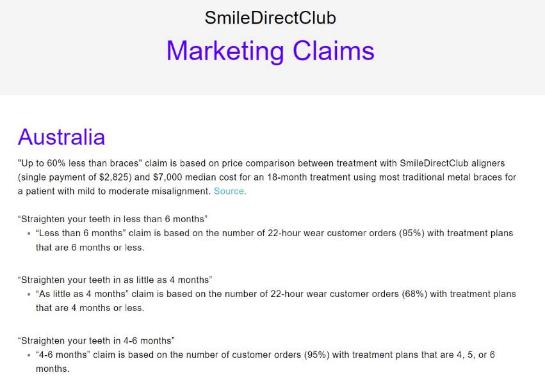
344 As can be seen from the image above, the first paragraph of the Claims Page states:
“Up to 60% less than braces” claim is based on price comparison between treatment with SmileDirectClub aligners (single payment of $2,825) and $7,000 median cost for an 18-month treatment using most traditional metal braces for a patient with mild to moderate misalignment. Source.
345 The final word, “Source” in the above statement on the Claims Page links to an article published by Orthodontics Australia titled “How much do braces cost?”, which can also be accessed at: https://orthodonticsaustralia.org.au/how-much-braces-cost/ (OA Article).
346 In addition to the SDC Homepage, the SDC Australian Website currently includes various versions of the “up to 60% less than braces” claim, examples of which are set out below. However, in each instance, the word “braces” is followed by an asterisk.
SDC’s “Lifetime Smile Guarantee”
347 On the SDC Australian Website, there is a webpage titled “Lifetime Smile Guarantee” which can be accessed at: https://smiledirectclub.com.au/en-au/guarantee/ (SDC Lifetime Smile Guarantee Page).
348 The SDC Lifetime Smile Guarantee Page states:
Our Lifetime Smile Guarantee™, complete with a 30-Day Money-Back Promise, protects your smile for life with free aligner touch-ups during your treatment – or even long after it ends.
349 The “Lifetime Smile Guarantee” referred to on this page is a reference to the three guarantees SDC provides consumers who undergo SDC Aligner Treatment. These are:
(a) a “30-day money back promise”, where a consumer can obtain a refund of 100% of the cost paid for SDC aligners if the consumer decides not to proceed with treatment with SDC aligners within their first 30 days of use of SDC aligners;
(b) “aligner touch-ups during treatment”, where during a consumer's course of treatment with SDC aligners, if the consumer’s teeth are not moving to plan, or the consumer has concerns about their current set of aligners, and if the consumer’s treating Affiliated Dentist considers it necessary, a company in the SDC group of companies will manufacture and SDC will send new aligners to the consumer at no extra cost to the consumer; and
(c) “lifetime aligner touch-ups after treatment”, where, provided the consumer continues to wear retainers obtained from SDC following the completion of treatment with SDC aligners, and replaces their retainers every six months, the consumer can request from SDC a free aligner touch-up every year, if they need it.
Other statements on the SDC Australia Website
350 The SDC Australian Website contains the statement “SmileDirectClub created the first end-to-end solution for your smile”, located at: https://smiledirectclub.com.au/enau/about.
351 Ms Brown understood an “end-to-end solution” to be describing the fact that, in relation to SDC Aligner Treatment, SDC is involved in the process from the start of the customer’s treatment until it is finished. At the beginning, customers may commence the process by having a 3D scan taken of their teeth at a SmileShop, operated by SDC, or by ordering an impression kit from SDC directly.
352 Throughout the course of the treatment, patients use the SDC Platform to track their treatment and check-in with their treating dentist or orthodontist. Finally, following treatment, patients may obtain retainers from SDC to keep their smile in place.
353 The SDC Australian Website also contains the statement “Get a smile you’ll love with clear aligners sent directly to you. No braces. No in-person monthly office visits required. No paying a fortune”, located at: https://smiledirectclub.com.au/en-au/why-smile-directclub/.
354 Ms Brown understood the words “No paying a fortune” to be a reference to SDC aligners being up to 60% less than braces. In Ms Brown’s opinion, “No paying a fortune” is a common phrase made in reference to the price of a product being less than what a consumer would usually expect to pay.
355 SDC AU promotes and advertises its product and services to Australian consumers through the following social media accounts:
(a) its Facebook account, with the associated handle: “@SmileDirectClubAU”, which can be accessed at: https://www.facebook.com/SmileOirectClubAU/ (SDC AU Facebook Account); and
(b) its Instagram account, with the associated handle: “@smiledirectclub_au” which can be accessed at: https://www.instagram.com/smiledirectclubau/ (SDC AU Instagram Account).
356 There is also a YouTube channel named “SmileDirectClub Australia”. This YouTube channel was created on 20 June 2019, however, it has been inactive for at least two years at this stage and is no longer used by SDC AU.
357 Ms Brown deposed that SDC US also has a YouTube channel named “Smile Direct Club”, which can be accessed at: https://www.youtube.com/c/smiledirectclub (the SDC US YouTube Channel). However, neither Ms Brown nor anyone else employed by SDC AU reviews the content that is posted on the SDC US YouTube Channel as it not directed towards Australian consumers and, accordingly, is outside Ms Brown’s remit.
358 Ms Brown deposed that she is also aware that SDC US has a LinkedIn page which can be accessed at: https://www.linkedin.com/company/smiledirectclub/ (SDC US LinkedIn Page). However, neither Ms Brown, nor anyone else employed by SDC AU reviews content on the SDC US LinkedIn Page as it is not targeted towards Australian consumers and, accordingly, is also outside Ms Brown’s remit.
359 SDC AU also engages in advertising through advertorials which are published in online media publications. Ordinarily, the publication of this material is undertaken through the public relations agency engaged by SDC AU, Red Havas Australia (Red Havas). SDC AU provides a brief to the online media publication, which will publish the advertorial. The online media publication then prepares a draft advertorial for review by SDC AU, and there is usually a maximum of two rounds of amendments by SDC AU. After final amendments are made, the draft is published as an advertorial on the publication’s website. Advertorials were published by SDC AU in Marie Claire, Women’s Health and Men’s Health and GQ Magazine.
Examination in chief of Ms Brown
360 Prior to the commencement of cross-examination, junior counsel for SDC, Mr Tynan, tendered two physical exhibits, which were handed up to the Court as well as to the witness. The first exhibit, marked exhibit 17 is a white box with the text “Let’s make a great first impression”. Exhibit 17 is SDC’s impression kit. The impression kit contains an impression guide which provides a step-by-step guide for the patient, putty, impression trays and nitrile gloves to enable the customer to take an accurate impression of their teeth, which is the first step in the SDC Aligner Treatment. Pictures of exhibit 17 can be seen below.
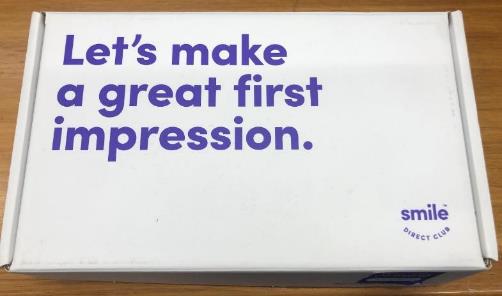
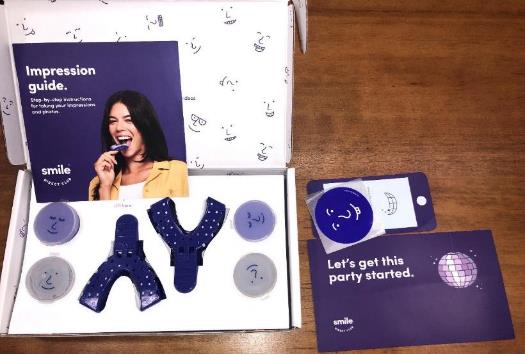
361 The second exhibit, marked exhibit 18 is a purple box with the text “Open for a lifetime supply of confidence”. Exhibit 18 contains the set of SDC aligners, which the customer receives after their impressions have been finalised. This box contains SDC’s “Aligner Guide” as well as instructions for how long to wear each set of aligners and how many hours per day the aligner should be worn. The box also contains an aligner case, lip balm, a “Smile Stretcher” (to enable the customer to take photos of their progress for virtual check-ins), an emery board to smooth out aligners for personal comfort, four teeth whitening pens and a tool to assist the customer in removing the aligners from their mouth. Images of exhibit 18 can be seen below.
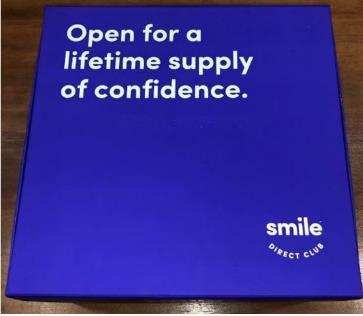
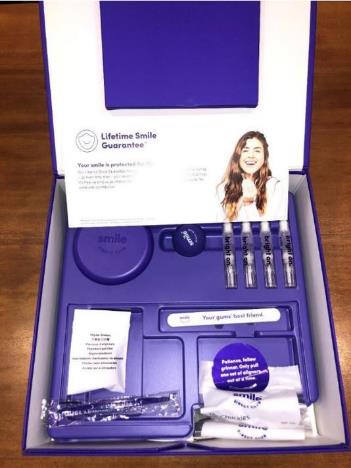
362 Ms Brown was provided with a hard copy of her LinkedIn profile, which was tendered in evidence and marked exhibit 19. To give brief context, LinkedIn is a professional networking social media application which is used by people to look for jobs, connect with other professionals and share posts and stories that others may interact with. Each LinkedIn user has a profile which typically details their employment history, education history, publications and awards, among other things.
363 Ms Brown was taken, in cross-examination, to the “About” section of her LinkedIn profile, which provides a brief synopsis of her professional profile, which states:
Senior Marketing professional with solid experience leading customer-centric data driven marketing strategy across paid, owned and earned media with a focus on performance marketing. Able to pivot strategy when required.
364 Ms Brown agreed that the above passage from the “About” section on her LinkedIn profile set out, generally, her experience in marketing.
365 Ms Brown was asked to explain what “paid media” means. Ms Brown explained that “paid media” refers to marketing channels where the advertiser has to pay to have their advertisements shown to the relevant audience, such as television and social media, for example Meta (formerly Facebook) and Instagram, TikTok, Snapchat as well as Google. With respect to advertising on Google, companies purchase search terms in order to optimise their ranking when people use the Google search engine so that they appear at the top of the webpage, this is referred to as “search engine optimisation”.
366 Ms Brown was asked to explain what “owned media” means. Ms Brown explained that “owned media” refers to media that the company or brand own, for SDC this would be the SDC Website, as an example.
367 Ms Brown was asked to explain what “earned media” means. Ms Brown explained that “earned media” refers to publicity that a company receives for free, for instance, an article is written about them and promotes their company or brand.
368 Ms Brown was asked to explain what “influencer marketing” entails. Ms Brown told the Court that “influencer marketing” is when a company approaches an individual, known as a social media influencer, to provide social media posts about their product. Ms Brown explained that the social media influencer would sign a contract with SDC whereby they are required to meet certain deliverables (typically to post about the product on their social media account(s)) and undergo SDC Aligner Treatment.
369 As a brief aside, a social media influencer is a person that has a large and/or dedicated group of followers on social media. An “influencer” is generally paid or given free products in exchange for posting and tagging pictures of products as a sign of their endorsement of it, a technique that uses the influencers brand or celebrity to drive sales for the company or product they are endorsing. In that regard, “influencer marketing” is simply a form of advertising that uses an endorsement from an influencer to make social media users aware of the product or service.
370 Ms Brown explained that SDC maintains a marketing budget wherein it would pay an “influencer” to post about SDC Aligner Treatment so that it is seen on the influencer’s social media channel and is promoted to their followers.
371 SDC also maintains a budget whereby it pays social media companies (e.g. Instagram) to “promote” its posts as well as the influencer’s posts. This means that SDC pays a premium to have a post that is made by an influencer seen by a larger audience than just their followers – much like an advertisement on the social media platform. Ms Brown described, in greater detail, the process for “promoting” a post. Ms Brown outlined how, as part of this process, SDC would upload the content which has been published by the influencer on their social media account and would then choose a target audience (e.g. people 18 years or older) with which to promote the content to, and would also elect how much money to dedicate to promoting such a post, which is usually an allocation of an amount of dollars per day.
372 Ms Brown was taken to the “Activity” section of her LinkedIn profile which was captured on 9 October 2022. The “Activity” section shows all the posts that Ms Brown has made as well as any posts she has “reposted”, commented on, “liked” or otherwise interacted with, in chronological order. Two versions of Ms Browns “Activity” page were tendered in evidence. Exhibit 20 identifies the most recent posts that Ms Brown has made as well as any posts she has “reposted”. Exhibit 21 identifies the posts that Ms Brown has “liked” or commented on. Ms Brown accepted that the record of posts marked as exhibit 20 accurately recorded her posts. Ms Brown also agreed that exhibit 21 shows that she has reposted material from team members outside of Australia, for instance from SDC employees based in the USA. However, Ms Brown stated that she has no control over, or responsibility for, the marketing content of SDC outside of Australia and would not check whether any of the reposts that she published on her LinkedIn feed were in compliance with Australian law.
373 Ms Brown was shown annexure JMW-15 to Ms Wolbers’ affidavit dated 4 April 2022, which contained the SDC US LinkedIn profile page. Ms Brown was shown the “Jobs” page of SDC’s LinkedIn profile. The “Jobs” page allows LinkedIn members to search for available employment opportunities within a company, here within SDC. Ms Brown was shown a job advertisement for a SmileShop Manager in Perth, Western Australia. Ms Brown gave evidence that she was aware that the SDC US LinkedIn page advertises jobs in Australia. Ms Brown gave evidence that Mr Mitchell Payne was the relevant person is in charge of advertising jobs on SDC’s LinkedIn page.
374 Ms Brown was asked about her interaction with SDC Affiliated Dentists. Ms Brown told the Court that the only involvement that she has with the dental team within SDC is when an influencer is contracted to SDC. When this occurs, she liaises with the dental team to ensure that influencer’s treatment is properly managed. Ms Brown would ordinarily contact Ms Chelsea Easley and Alicia Issa, who are part of SDC’s dental team. Ms Brown explained that she was not sure if Ms Easley or Ms Issa are Australian registered dentists or orthodontists.
375 Ms Brown gave evidence that she reported to the Chief Marketing Officer of SDC, Mr John Sheldon.
376 I wish to note at this point that the Court was played:
(a) two SDC television adverts, marked exhibit 22 and exhibit 23 which ran for 30 seconds and 15 seconds respectively; and
(b) three SDC Snapchat posts which were collectively tendered and marked exhibit 24. I will describe each of these below and will refer to each of them separately as exhibits 24.1, 24.2 and 24.3 as this is how the documents were ultimately provided to my chambers in the tender bundle.
377 Ms Brown accepted that the advertisements, being exhibits 22 and 23 and the Snapchat posts, collectively tendered as exhibit 24, were part of SDC’s social media marketing.
378 Ms Brown accepted that SDC used social media platforms such as Meta (Facebook), Instagram, TikTok and others to market SDC’s clear aligners. Ms Brown accepted that the SDC business model was one where SDC set prices.
379 The Court was played three Snapchat posts. A screenshot of exhibit 24.1 can be found below.
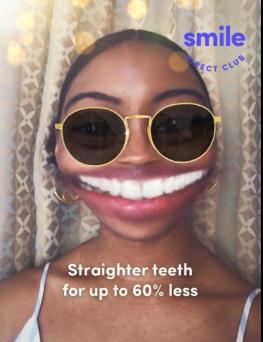
380 A screenshot of exhibit 24.2 can be found below.
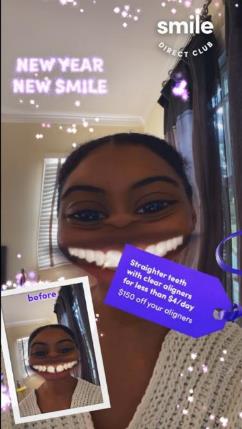
381 The above images portray a cartoonish filter of one of the contracted SDC influencers, showing a before and after SDC Aligner Treatment comparison with an exaggerated smile.
382 In exhibit 24.1, SDC’s logo also appears the top right hand corner with the caption:
Straighter teeth for up to 60% less
383 In exhibit 24.2, SDC’s logo also appears in the top right hand corner with a purple tag on the lower right hand side of the screen which states:
Straighter teeth with clear aligners for less than $4/day
$150 off your aligners
384 Ms Brown told the Court that SDC pays Snapchat to make filters (which also contains the SDC logo and promotion of the SDC Aligner Treatment), such as the one portrayed above. The filter is then made available to Snapchat users who are then able to take photos of themselves which they can play around with and send to friends. This is a way of promoting SDC and its aligner treatment.
385 Ms Brown was then played another Snapchat video, which was identified as exhibit 24.3. A screenshot of exhibit 24.3 can be found below.
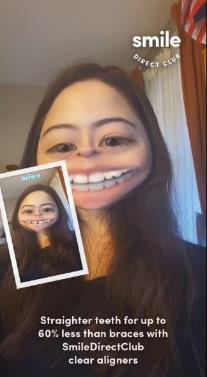
386 Similar to exhibit 24.1 and 24.2, the above screenshot of exhibit 24.3 depicts an SDC influencer showing a before and after SDC Aligner Treatment comparison with an exaggerated smile. The text here reads:
Straighter teeth for up to 60% less than braces with SmileDirectClub clear aligners
387 Ms Brown agreed that the statements made in each of the snapchat videos in exhibit 24 are in line with SDC’s marketing message.
388 Ms Brown was then taken to SDC’s Meta Ad Library, which was tendered in evidence and marked exhibit 25. SDC’s Meta Ad Library shows all of the advertisements that SDC has advertised on the Meta platforms. Ms Brown was then played one of the advertisements contained within SDC’s Meta Ad Library, which was tendered in evidence and marked exhibit 26. A screenshot of the exhibit 26 advertisement can be found below:
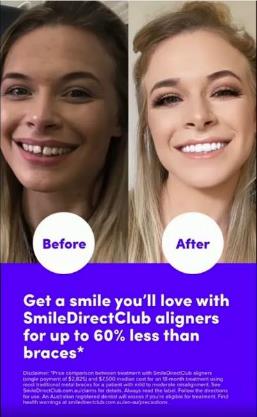
389 Ms Brown was played a recording of an Instagram post made by one of SDC’s contracted influencers, Ms Erin Oprea, which was tendered and marked exhibit 27. A screenshot of exhibit 27 can be found below:

390 Ms Brown agreed that this Instagram post is an example of how SDC engages with influencers to market its product. Ms Brown told the Court that Ms Oprea is an American citizen, and SDC AU does engage overseas influencers in its paid marketing campaigns from time to time. It should also be noted that this Instagram post has been made on SDC AU’s verified Instagram account under the handle “@smiledirectclub_au”. Ms Brown told the Court that, typically, paid Instagram posts such as this will appear in an Instagram user’s feed as a paid advertisement and therefore these posts will appear to a user even if the user does not “follow” the “@smiledirectclub_au” Instagram account (which is the ordinary way an Instagram user will see and curate the content on their Instagram feed). This, as explained above, is the method by which posts are “promoted” on social media websites as paid advertising. Instagram users are targeted for these promoted posts based on an algorithmic selection in line with the target audience that is preselected by the SDC marketing team.
391 Ms Brown was asked about the SDC business model and the prices that it charges to consumers for SDC Aligner Treatment. Ms Brown gave evidence that SDC pays its Affiliated Dentists a fee for aligners that are ultimately purchased and sent to SDC customers. SDC controls the various steps that are taken in the process from the very beginning, when a customer undertakes their first scan to the completion of a customer’s SDC Aligner Treatment. SDC also controls the whole treatment process including the marketing strategy and the various steps in the technological process and the creation of the aligners, which occurs in the SDC laboratory situated in Costa Rica.
392 Ms Brown was then taken to [16] of the Brown Affidavit, which states:
SDC is engaged by Australian registered dentists or orthodontists (Affiliated Dentists) to supply SDC Aligners to consumers who the dentist or orthodontist has determined is suitable for treatment with SDC Aligners.
393 It was put to Ms Brown, in cross-examination, that the evidence she gave while under cross-examination is inconsistent with the above passage of her evidence at [16] in the Brown Affidavit. Ms Brown agreed with this assertion.
394 Ms Brown was then cross-examined in relation to the consent process on the SDC Platform.
395 Ms Brown was asked about the concept of “default bias” in marketing. The concept of “default bias” was explained by Ms Brown to be when a consumer is given a preselected choice or option by default, which, implicitly encourages the consumer to accept the default position. The alternative would be to leave it to the consumer to actively make the choice to select between options, without having any influence that a preselection may cause.
396 Continuing with this concept, Ms Brown was taken to annexure NB-4 to the Brown Affidavit, which shows a series of questions that prospective SDC consumers are asked, prior to commencing SDC Aligner Treatment. A screenshot of the webpage and associated questions can be found below:
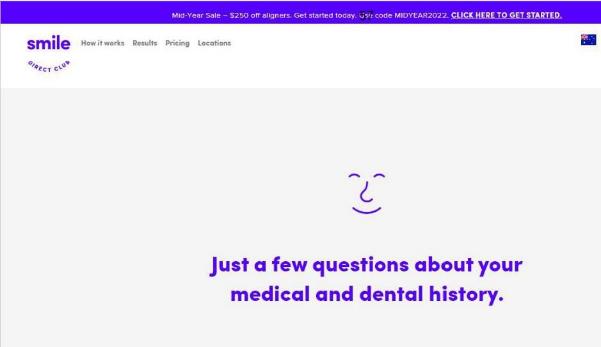
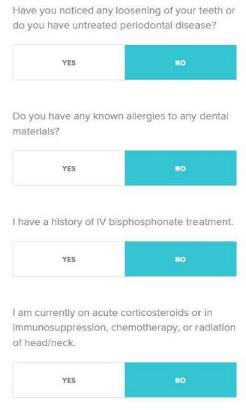
397 Ms Brown accepted that all of the questions are all preselected and set to “no”. Ms Brown accepted that this was a marketing technique which is used to push customers in a particular direction, namely the default direction, here, being the “no” box.
398 Ms Brown was then taken to annexure NB-10 of the Brown affidavit. Annexure NB-10 sets out a chain of emails as well as text messages that Ms Brown received from SDC’s client service representatives which occurred between June and November 2021. Ms Brown told the Court that she undertook this journey as part of an exercise to test the SDC process in order to understand the SDC customer’s journey and experience, from start to finish. The email chain beginning at page 134 of the Brown Affidavit in annexure NB-10 also shows how SDC, as part of customer’s journey, engages in customer relationship management (CRM). CRM is a system that helps companies stay connected to customers, streamline processes, and improve company profitability. Ms Brown had no responsibility for the marketing and CRM within the customer’s journey. An example of the customer’s journey and the CRM is shown below:
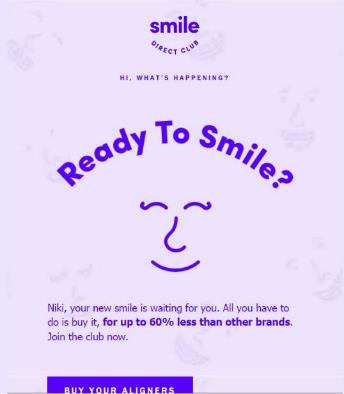
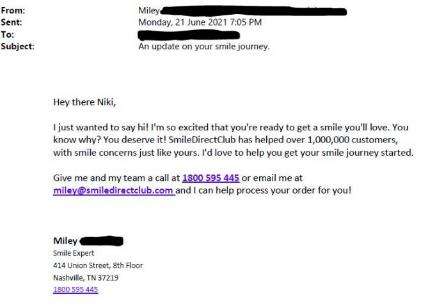
399 Ms Brown agreed that the statement in the first image, “Niki, your new smile is waiting for you. All you have to do is buy it, for up to 60% less than other brands. Join the club now” and the follow up email from Miley at SDC are examples of the way that SDC engages in CRM and encourages the customer to approve their treatment plan.
400 Ms Brown was taken to part of another email within annexure NB-10, which was sent to Ms Brown on 17 October 2021. The email is sent from SDC to Ms Brown as a reminder to switch to her new set of aligners. At the bottom of this email is a purple box which outlines SDC’s Lifetime Smile Guarantee, this can be seen below:
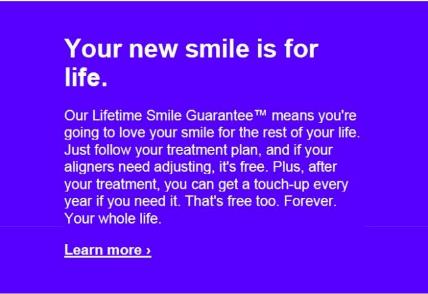
401 Ms Brown was asked about SDC’s Lifetime Smile Guarantee and was taken to the following sentence within the above image:
… after your treatment, you can get a touch-up every year if you need it. That's free too. Forever. Your whole life.
402 It was put to Ms Brown that SDC’s Lifetime Smile Guarantee, which includes a free yearly touch up is not free because the customer must pay for the retainers. Ms Brown accepted that, for the Lifetime Smile Guarantee to be valid, it does require a customer to purchase a retainer every six months at the cost of, what is now, $167. Ms Brown initially refused to accept that it was false to say that the Lifetime Smile Guarantee was free. Ms Brown initially said that the Lifetime Smile Guarantee came with terms which applied to the Lifetime Smile Guarantee. Ms Brown ultimately accepted and agreed that the Lifetime Smile Guarantee was not free. Ms Brown said there was no additional aligner treatment cost. Ms Brown accepted that the yearly touch up was not free because it required the patient to purchase a retainer every six months.
403 Ms Brown was asked about the content that SDC posts to its various social media channels. Ms Brown explained that SDC has a number of social media channels where it publishes content that helps drive organic growth, attracts followers and receives interactions from its followers which assists in marketing the SDC brand and business. SDC does not pay for these social media channels, unlike the paid social media posts which it pays to be promoted and boosted to a wider audience of users of these social media platforms that do not necessarily follow SDC. Some of the paid media posts do ordinarily get reposted by SDC on its own social media channels.
404 Ms Brown had detailed knowledge of SDC’s marketing strategy, and impressed me as an honest and forthright witness who made concessions as required. I accept her evidence.
405 Dr Jeffrey Sulitzer is the Chief Clinical Officer at SDC, which is a global role. SDC tendered two affidavits of Dr Sulitzer in this proceeding. Dr Sulitzer’s first affidavit was sworn on 30 June 2022, and was marked exhibit 34 (first Sulitzer Affidavit), and his second was sworn on 29 September 2022, and was marked exhibit 35 (second Sulitzer Affidavit). SDC also tendered two confidential exhibits to the affidavit evidence of Dr Sulitzer, these were confidential exhibit JS-15, which was marked exhibit 36 and confidential exhibit JS-16, which was marked exhibit 37.
406 Dr Sulitzer in his affidavits deposed to the following.
407 As Chief Clinical Officer, Dr Sulitzer manages a global network of dental practices and Affiliated Dentists who use SDC’s services and telehealth platform to assess, diagnose, and (where they consider clinically appropriate), provide treatment using SDC aligners.
408 Dr Sulitzer indicated that he provides some support to SDC’s retail staff if they have questions but is otherwise not involved with retail staff and does not supervise them.
409 Dr Sulitzer identifies dentists and orthodontists who may be interested in becoming part of SDC’s affiliate network, and ensures that each dentist and orthodontist who provides treatment with SDC aligners is appropriately qualified and is registered to practice in the jurisdiction in which they practice.
410 Dr Sulitzer is also responsible for managing the relationship with each Affiliated Dentist and providing them with any assistance that they might require in relation to their use of SDC’s services. Additionally, Dr Sulitzer is involved in managing SDC employees including:
(a) staff that work at SmileShops;
(b) dental hygienists, dental nurses, dental assistants and dental lab technicians (Dental Team) who work with Affiliated Dentists to assist patients who are undertaking SDC Aligner Treatment;
(c) dentists, orthodontists and technicians who prepare draft treatment plans for consumers (Treatment Setup Team).
411 Dr Sulitzer also acts as a subject matter expert for SDC’s customer care and service representatives (Customer Care Team) who interact with consumers.
412 Dr Sulitzer, in the first Sulitzer Affidavit, provided a thorough explanation about what SDC Aligner Treatment entails, how the treatment works and the steps that are involved in providing treatment to SDC’s customers.
413 Dr Sulitzer explained that SDC supplies SDC aligners, which are clear aligners that are designed to gradually move and straighten teeth for patients with mild to moderate crowding and spacing of teeth. SDC aligners are custom designed to fit Individual patients’ teeth. Each SDC aligner is individually manufactured by a company within the SDC group of companies, in its 3D printing facility in the USA.
414 SDC aligners can be used in the treatment of mild to moderate crowding and spacing of teeth, which Dr Sulitzer explained is not a term that is settled within dental practice. Crowding of teeth occurs when there is a lack of space for all the teeth to fit normally within the jaw. When this occurs, teeth can crowd together, twist and can overlap with each other. Spacing of teeth occurs when there is an excess of space for teeth within the jaw which results in gaps between teeth.
415 In Australia, consumers who are considering treatment with SDC aligners are required to provide information (including their medical and dental history) for evaluation by an Affiliated Dentist. Consumers may either visit a SmileShop, or request an impression kit from SDC.
416 A SmileShop is a physical shopfront where consumers can have a 3D scan of their teeth and gums taken by SmileShop staff using the iTero scanner.
417 SmileShop employees do not carry out any screening of consumers for suitability for treatment with SDC aligners, nor do they provide any dental treatments or procedures. Rather, SmileShop employees gather information for subsequent evaluation by Affiliated Dentists.
418 When a consumer visits a SmileShop and expresses an interest in undertaking SDC Aligner Treatment, a SmileShop employee gathers information from the consumer about the consumer's concerns with their teeth, including any specific improvements the consumer wishes to make about their smile and takes digital photographs of the customer’s face, teeth and gums.
419 Instead of attending a SmileShop, a consumer may opt to do an impression kit and take a mould of their teeth from their home. An impression kit can be ordered online through the Australian SDC Website. If a consumer requests an impression kit online, SDC arranges for the impression kit to be delivered to the consumer at their nominated address. Consumers then mail the impression kit back to SDC once they have taken their mould and the impression kit is completed.
420 After SDC receives the customer’s impression kit, SDC then sends the customer’s kit to its dental laboratory which inspects the impressions for completeness and accuracy. If the dental lab approves the customer’s impressions, they are then used to generate a 3D image of the customer’s teeth and gums. The customer is also directed to sign up to the SDC Portal and upload photographs of their teeth, complete the medical and dental history form and provide their chief complaint to the SDC team.
421 If a customer has any questions about the impression kit or SDC aligners generally, the customer can contact the Customer Care Team. The SDC Customer Care Team comprises customer care and service representatives who are employed by SDC and perform administrative functions that are traditionally conducted by non-clinical staff in dental clinics. If the Customer Care Team is asked a question that is not administrative in nature, the Customer Care Team escalates the enquiry to the Dental Team.
422 The Dental Team have a higher level of expertise in relation to dental issues than the Customer Care Team. The Dental Team undertake activities such as gathering clinical data. For customers who have ordered an impression kit, the Dental Team are able to answer questions about how to use the impression kit to take impressions and how to take photographs of their teeth.
Pre-Screening and Creation of the Draft Treatment Plan
423 The customer information, 3D scan and photographs of the customer’s teeth and gums, as well as their chief complaint are then provided to SDC’s Treatment Setup Team. The Treatment Setup Team performs two main functions:
(1) to create a draft treatment plan, which is a series of 3D models that shows the predicted teeth movement from the start to end of treatment using proprietary software; and
(2) pre-screen cases that are not suitable for treatment with SDC aligners.
424 The Treatment Setup Team comprises over 10 orthodontists, approximately 50 general dentists and around 115 software technicians, all of whom are full time employees of SDC and based in San Jose, Costa Rica. The orthodontists within the Treatment Setup Team oversee the work of the dentists and technicians, including by conducting quality reviews of the work performed by general dentists.
425 If a case is not rejected during the pre-screening process, the Treatment Setup Team, prior to commencing the process of creating the draft treatment plan, evaluates the quality of the 3D image to ensure that it meets the relevant standards that Affiliated Dentists require.
426 If the quality of the 3D image is determined to be acceptable, a software technician in the Treatment Setup Team then, having regard to the chief complaint, creates a draft treatment plan based on the submitted photographs and 3D image of the patient’s teeth.
Evaluation by Affiliated Dentists
427 If a case passes the pre-screening process and a draft treatment plan has been created and reviewed for quality purposes by the Treatment Setup Team, SDC then provides the case to an Affiliated Dentist registered to practise in the jurisdiction where the patient resides. Through the Affiliated Dentist internal SDC Portal (Provider Portal), the Affiliated Dentist can access the patient’s information, photographs and documents submitted by the patient, as well as the draft treatment plan, for their evaluation and determination of whether the patient is suitable for treatment with SDC aligners.
428 In order to become an Affiliated Dentist, the practitioner must:
(a) be registered (or licensed) to practise in their jurisdiction;
(b) the registration (or licence) must be in good standing;
(c) the dentist or orthodontist must have at least four years of experience treating patients with clear aligners in a traditional “brick and mortar” setting; and
(d) the dentist or orthodontist must have completed at least one clear aligner training course administered by another clear aligner company such as Align Technology or Clear Correct.
429 Prior to treating patients Affiliated Dentists are instructed about how to use the Provider Portal including how to evaluate, treat and communicate with patients using the Provider Portal. This comprises a one-on-one demonstration (by video conference) by either Dr Sulitzer or members of the Dental Team who explain how it works. Affiliated Dentists are also provided with a copy of the Dental Practitioner Policies, Procedures and Instructions about the SDC Platform (SDC Instructions).
430 SDC expects Affiliated Dentists to use their own clinical judgment and experience when evaluating cases for treatment with SDC aligners. Should an Affiliated Dentist have questions about SDC Aligner Treatment or how to work within the Provider Portal, Dr Sulitzer is responsible for answering those questions.
431 The process for evaluating a case requires the Affiliated Dentist to access the Provider Portal and assess the patient’s records, including the patient’s chief complaint, medical and dental history, consent form, photographs of the patient’s teeth, the 3D images that were taken at a SmileShop, the draft treatment plan and any other relevant documents such as x-rays and clinical notes.
432 Once the Affiliated Dentist has reviewed all of the information provided about a case via the Provider Portal, in exercising their clinical judgment, the Affiliated Dentist may approve, revise or reject the patient’s case.
433 If the Affiliated Dentist approves the draft treatment plan, the treatment plan is then provided to the patient through the SDC Platform, together with any additional comments made by the Affiliated Dentist when approving the treatment plan. The patient can then review the treatment plan approved by the Affiliated Dentist and can elect to commence treatment according to the approved treatment plan through the SDC Platform.
434 If the patient elects to commence treatment, an SDC affiliate manufactures the SDC aligners that have been approved for the patient, and SDC delivers the SDC aligners to the customer in a box, which is the purple box which was tendered and marked as exhibit 18, shown and described above under the evidence of Ms Niki Brown.
435 Once a customer has received their SDC aligners, the patient may then start their course of treatment by wearing the first set of SDC aligners, in accordance with their approved treatment plan.
436 Customers are also required to register their set of SDC aligners on the SDC Platform so that their progress through the treatment can be tracked by the Affiliated Dentist with the support of the Customer Care Team and Dental Team.
437 Once a patient has started their SDC Aligner Treatment, they are required to take photographs of their teeth and gums and upload the photographs to the SDC Platform, as well as answer a short questionnaire every 60 days, or more frequently if the Affiliated Dentist considers it appropriate.
438 Customers are notified of any upcoming progress reviews that they are required to complete through the SDC Platform and via emails and telephone calls from the Customer Care Team.
439 Customers generally also have an appointment with a dentist or orthodontist every 60 or 90 days. The purpose of these appointments is for the patient to collect their next set of clear aligners and to make the next instalment of their payment.
440 The completed progress review is then pre-screened by the Dental Team to consider if any requests for mid-course correction should be made by the Affiliated Dentist. The Affiliated Dentist is then provided with the progress review via the Provider Portal. The Affiliated Dentist can monitor the progress of the customer and, if required, evaluate any requests for mid-course correction. A mid-course correction is a variation to the approved treatment plan in circumstances where the patient’s teeth are not moving according to the plan and, as a consequence, the aligners do not fit.
441 At any point during the treatment process a patient can also make contact, whether via telephone, email or live webchat, with the Customer Care Team to discuss any questions or issues they may have about their treatment. If the question is clinical or not administrative in nature, the Customer Care Team refers the patient to the Dental Team.
442 In addition to the Dental Team, patients can, at any time, request to speak to the Affiliated Dentist that is overseeing their case by contacting the Customer Care Team.
Cross-examination of Dr Sulitzer
443 Dr Sulitzer explained that he is the Chief Clinical Officer of SDC which is a global role.
444 Dr Sulitzer was taken to [12] of the first Sulitzer Affidavit, where Dr Sulitzer set out his roles and responsibilities at SDC. Dr Sulitzer agreed that his role encompasses identifying and recruiting dentists that may be interested in becoming Affiliated Dentists. Dr Sulitzer also manages SDC’s existing global network of Affiliated Dentists.
445 Dr Sulitzer was asked if he had any involvement with any of the staff that work at SDC’s SmileShops. Dr Sulitzer gave evidence that he does support them, but not in Australia and only within the states of Washington and California in the USA Dr Sulitzer also explained that he assists in the management of the Affiliated Dentists, the Dental Team and Treatment Setup Team.
446 Dr Sulitzer was taken to [14] of the first Sulitzer Affidavit, where he explains that he acts as a “subject matter expert” for the Customer Care Team. Dr Sulitzer explained that because he is a trained clinical dentist, he is able to support this team in responding to any clinical questions, hence his self-description as being a “subject matter expert”.
447 Dr Sulitzer was asked to explain how he interacts with, and provides advice to the Customer Care Team. Dr Sulitzer gave evidence that he assists the Customer Care Team in delineating between clinical questions and administrative questions, as the Customer Care Team does not respond to clinical questions. Dr Sulitzer explained that this does not include providing the Customer Care Team with clinical answers to customers’ questions. Therefore, if a member of the Customer Care Team approaches Dr Sulitzer with a query that they have received from a customer, Dr Sulitzer is able to advise the Customer Care Team representative whether they are permitted to answer the question or not (based on whether it is clinical in nature). Dr Sulitzer gave evidence that hypothetical interactions like this are rare.
448 It was put to Dr Sulitzer that he does not act as a subject matter expert for SDC’s Customer Care Team such that he would confer with individual representatives that handle day-to-day customer queries, but that rather his contact is limited to the managers in the Customer Care Team. Dr Sulitzer explained that he does speak directly to representatives within the Customer Care Team from time to time, but explained that this is not the main role that he assumes as a subject matter expert. Dr Sulitzer told the Court that this role mainly involves advising and assisting in training for the Customer Care Team representatives.
449 Dr Sulitzer was taken to [15] of the first Sulitzer Affidavit, where Dr Sulitzer explains that he participates in providing information to the public about SDC’s products and services. Dr Sulitzer agreed that this is part of his role. Dr Sulitzer explained that this also includes appearing in videos that are available to the public on YouTube and other platforms. The SDC Platform also sends emails and text messages to customers as part of their marketing strategy and as part of the customer experience, once a customer has signed up to a treatment plan with SDC.
450 Dr Sulitzer gave evidence that he is also known as the “Chief Dental Officer”, however this is not a different role from the Chief Clinical Officer role.
451 Dr Sulitzer was shown an example pro-forma email that is sent to SDC customers at the point in time where their treatment plan has been approved (at annexure NB-10, page 135 to the Brown Affidavit).
452 The email signature was that of Dr Sulitzer’s and stated, in part:
A registered dentist or orthodontist has approved your new smile plan, and they will be with you every step of the way. We already sent a 3D rendering to you that lets you see how your teeth will move over time. In case you missed it, you can log in here to see your new smile in our 3D SmileViewer now. You no longer have to imagine how a smile transformation can change your life.
…
If you don't have any questions and are ready to begin your smile journey today, you can go directly to our site and purchase your aligners now.
I can’t wait to see your new smile.
Sincerely,
Jeffrey Sulitzer, DMD
Chief Dental Officer
SmileDirectClub
414 Union Street
Nashville, TN 37219
453 Dr Sulitzer explained that these emails are part of SDC’s marketing strategy, and while he is generally aware that emails of this kind are sent to SDC customers, he does not approve all of these communications to be sent, and is not otherwise informed when they are sent out to SDC customers.
454 Dr Sulitzer told the Court that he is not a registered dentist in Australia and SDC relies upon four registered dentists in Australia to be SDC’s Affiliated Dentists that are capable of approving SDC’s Aligner Treatment for its Australian customers. There are no affiliated orthodontists in Australia. Dr Sulitzer’s role as the Chief Clinical Officer requires him to identify and recruit dentists and orthodontists that may be interested in becoming Affiliated Dentists. Dr Sulitzer and his staff also perform a “credentialing process” as part of this recruitment to ensure the prospective Affiliated Dentist is appropriately qualified.
455 Dr Sulitzer was taken to [12] of the first Sulitzer Affidavit, where he stated:
… It is part of my role to identify dentists and orthodontists who may be interested in becoming part of the affiliated network, and to ensure that each dentist and orthodontist who provides treatment with SDC Aligners is appropriately qualified and registered to practice in the jurisdiction in which they practice.
456 Dr Sulitzer explained that, as part of the process of identifying dentists to become Affiliated Dentists, he partakes in assessing their clinical capabilities, background and history and experience with using clear aligners. Dr Sulitzer also makes sure that they are appropriately qualified to deliver SDC’s service and are registered to practice in the relevant jurisdiction where the SDC customers (that they intend to service) are located, which is what he meant by the reference “in which they practice”. Dr Sulitzer accepted that an Affiliated Dentist may be a dentist which has a registration in the jurisdiction other than from where the patient resides. Dr Sulitzer accepted that the Affiliated Dentist may be registered in the jurisdiction but may not be practicing within that jurisdiction.
457 Dr Sulitzer accepted that Dr Hendrik Lai has not practiced in Australia since 2017.
458 Dr Sulitzer accepted that the process of verifying dentists’ registration involves searching of dental board records and other publicly available records that record the registration and licensing of dentists to practice within the relevant jurisdiction. Dr Sulitzer explained that SDC would access these records via dental board websites as well as other websites to verify that proposed Affiliated Dentists were in fact registered to practice in a particular jurisdiction, that they had good standing, that their registration was current and active and that there were no conditions imposed upon their registration to practice dentistry. Dr Sulitzer said that SDC requires a minimum of four years’ experience using clear aligners in a “bricks and mortar” setting from start to finish in order to become an Affiliated Dentist. Dr Sulitzer explained that a “bricks and mortar” setting means treating and diagnosing patients in person at a traditional dentist clinic. When it comes to monitoring patients, Dr Sulitzer explained that this could be done by the dentist either in person, or through remotely via tele-dentistry.
459 Dr Sulitzer explained that SDC also requires dentists to have completed a clear aligner training course. SDC does not have its own certified training course. Therefore it requires Affiliated Dentists to undertake other clear aligner training courses, such as those offered by its competitors including, Invisalign.
460 Dr Sulitzer was taken to SDC’s “Credentialing Application” at CB1864 (Credentialing Application). Dr Sulitzer explained that this application is completed by dentists that wish to become Affiliated Dentists. Affiliated Dentists are also required to complete this application every two years. These records are maintained by SDC.
461 Dr Sulitzer explained the relevance of the “W9” tax form, which is required as part of the Credentialing Application, and in doing so, he also provided a brief overview of SDC’s business model. Dr Sulitzer told the Court that SDC does not pay dentists, rather dentists pay SDC. The way this works is that dentists pay SDC for the services that SDC provides to the dentist, and SDC operates as a dental support organisation (DSO). The DSOs are responsible for providing administrative support such as billing and setting up appointments for the Affiliated Dentists. There are other teams and support mechanisms which are also offered by SDC to its Affiliated Dentists such as the creation of the aligners themselves through a laboratory that is affiliated with SDC. Because the dentist pays SDC for these services and one of these services is the collection of fees from the customers, the W9 form is lodged with the United Stated Internal Revenue Service (IRS) because of the requirement to declare retained revenue for Affiliated Dentists.
462 Dr Sulitzer was asked about the price of SDC Aligner Treatment and how the price that is charged to customers is decided. Dr Sulitzer explained that the price charged for SDC Aligner Treatment is the same in every jurisdiction, but SDC does not set the price that is charged to consumers, rather, the Affiliated Dentists that provide SDC Aligner Treatment agree upon a set number to charge the patients. Dr Sulitzer, in the face of cross-examination on the issue of who decides the price, was adamant that SDC is not the arbiter that sets the price for its Affiliated Dentists in providing SDC Aligner Treatment, but rather, it is the Affiliated Dentists that do so. Dr Sulitzer told the Court that this process is done through a professional corporation that makes decisions that are set under a “management services agreement” which is an agreement between SDC and the professional corporation. Dr Sulitzer gave evidence that all of SDC’s Affiliated Dentists are comfortable with the price charged for SDC Aligner Treatment.
463 Dr Sulitzer gave evidence that Affiliated Dentists are not employees of SDC.
464 Dr Sulitzer was taken back to SDC’s Credentialing Application. Dr Sulitzer agreed that the application form did not specify a minimum number of aligner treatments that the dentist had previously performed. Rather, the form asked for the percentage of aligner treatments out of a total number of teeth straightening treatments that the dentist had performed. It was pointed out to Dr Sulitzer that there is an inherent issue with disclosing this figure based on a percentage, rather than a total number. This is because it is not possible to know the actual number of aligner treatments that a dentist had undertaken upon a review of the Credentialing Application (i.e. the figure could be listed as “100%” but the dentist had only performed one aligner treatment). Dr Sulitzer explained that while it may be the case that there is no set number of aligner treatments that a dentist is required to complete in order to become an Affiliated Dentist, Dr Sulitzer told the Court that he is able to get a sense of their level of experience during the recruitment process and through his discussions with the dentist and is confident in his assessment of the relevant dentist’s ability to provide the service, having had extensive experience in recruiting dentists.
465 Dr Sulitzer was taken to page five of the Credentialing Application at CB1867, which set out the disclosure questions which the prospective Affiliated Dentists are required to answer. Dr Sulitzer was asked about the first question, being “Are you compliant with all current HIPAA/HITECH rules and regulations?”. Dr Sulitzer explained that HIPAA/HITECH are US-based requirements for the management of patient health records. Therefore some of the disclosure questions on the form were relevant only to the USA. Because this particular question, and some others, did not apply to all prospective Affiliated Dentists, Dr Sulitzer explained where a question did not apply, to a particular dentist, they could simply cross out a particular question and put in an answer that is relevant to the dentist’s particular jurisdiction and SDC will undertake investigations into this.
466 Dr Sulitzer was taken to a bundle of Practice Agreements which were tendered in evidence and marked exhibit 36. Dr Sulitzer was taken to the Practice Agreement between SDC and Dr Hendrik Lai dated 1 June 2019 (Lai Practice Agreement). The Lai Practice Agreement at cl 5.7(a) deals with insurance and indemnification. This clause identifies that SDC provides professional negligence insurance and holds Dr Lai harmless against all liabilities, losses and costs associated with claims arising out of any services that he completes which arises under the Lai Practice Agreement with SDC.
467 Dr Sulitzer was taken to item 9 of schedule 2 to the Lai Practice Agreement. This item deals with legal and risk management services. Dr Sulitzer accepted that this section empowers SDC to deal with “regulatory issues”. Dr Sulitzer stated that he was aware that SDC is required to report adverse events to the Federal Drug Administration (FDA), and this included adverse events which occurred outside the USA. Dr Sulitzer accepted that SDC reports adverse events and maintains records in relation to these events. Dr Sulitzer was asked about the Manufacturers and User Facility Device Experience, which is otherwise known as “MAUDE”. Dr Sulitzer was not previously aware what the acronym “MAUDE” stood for. Dr Sulitzer told the Court that he understood that SDC was responsible for recording and providing information about adverse events both in the USA and outside the USA to the relevant agencies and regulators.
468 Dr Sulitzer gave evidence that he was aware that SDC holds medical negligence insurance and controls the legal and regulatory issues on behalf of its Affiliated Dentists and, in turn, expects its Affiliated Dentists to comply with the relevant standard of care that is required for SDC’s customers.
469 Dr Sulitzer was taken to the SDC Instructions. Dr Sulitzer told the Court that this is the information that SDC provides to its Affiliated Dentists about the use of SDC clear aligners and to whom it may be suited. Dr Sulitzer agreed that the SDC Instructions, under the heading “Intended Use/Indications for Use” at CB1870 does not mention “mild to moderate teeth crowding” or “mild to moderate teeth spacing”. Dr Sulitzer agreed that the warnings contained at CB1871 in the SDC Instructions were generic and were the type of warnings which many dental boards and authorities around the world recommend dentists to advise their customers.
470 Dr Sulitzer was taken to the heading “Clinical Examination” on pages 5 and 6 of the SDC Instructions (CB1873). The SDC Instructions identify that a “comprehensive clinical examination” should take place which includes an intra-oral and extra-oral assessment. Dr Sulitzer gave evidence that this assessment is completed by the Affiliated Dentist online through the Provider Portal, and no physical examination is done by the Affiliated Dentist on the patient. Dr Sulitzer accepted that there was no reference to SDC’s clear aligners being suitable only for mild to moderate teeth crowding or spacing in this section of the SDC Instructions.
471 Dr Sulitzer was taken to the heading “Extra-Oral Review” under Attachment A on page 9 of the SDC Instructions (CB1877). This attachment showed how an SDC customer’s extra-oral photographs would appear to an Affiliated Dentist that is undertaking a clinical examination of a prospective SDC customer through the SDC Portal. Dr Sulitzer told the Court that these extra-oral photographs are a key component in the diagnosis and approval of an SDC customer’s treatment plan.
472 Dr Sulitzer was then taken to the heading “SmileDirectClub Provider Portal” under Attachment B on page 11 of the SDC Instructions (CB1879). Dr Sulitzer gave evidence that this attachment provides the Affiliated Dentist with a step-by-step process of how to use the Provider Portal and how to consider treatment plans for potential SDC consumers.
473 Dr Sulitzer was taken to page 23 of the SDC Instructions which shows the Affiliated Dentist how to reject a treatment plan and the reasons for rejecting a treatment plan that are available to the Affiliated Dentist (CB1891) in the dropdown menu. This can be seen in the image below.
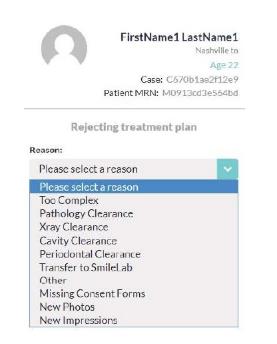
474 Dr Sulitzer accepted that one of the reasons for rejecting a treatment plan in the dropdown menu is because the diagnosis presented was “too complex”. Dr Sulitzer accepted that the Provider Portal does not provide an option in the dropdown menu which allows Affiliated Dentists to reject a patient’s treatment plan because their teeth were beyond “mild to moderate teeth crowding and spacing”. Dr Sulitzer explained that, on telephone calls with Affiliated Dentists, he would discuss with them that the SDC clear aligners were only suitable to mild to moderate teeth crowding and spacing. Dr Sulitzer accepted that the Provider Portal does not say that SDC clear aligners are only suitable to mild to moderate teeth crowding and spacing.
475 Dr Sulitzer was taken to [49] of the first Sulitzer Affidavit. This paragraph states:
SDC expects Affiliated Dentists to use their own clinical judgment and experience when evaluating cases for treatment with SDC Aligners on the SDC Platform. Should an Affiliated Dentist have questions about SDC Aligners and their use in the treatment of patients along with how to work within the Provider Portal, I am responsible for answering those questions. In addition, I inform each Affiliated Dentist before they start treating patients with SDC Aligners that SDC Aligners are used in the treatment of mild to moderate crowding and spacing of teeth …
476 Dr Sulitzer was asked how he informs each Affiliated Dentist that SDC aligners are used in the treatment of mild to moderate crowding and spacing of teeth. Dr Sulitzer gave evidence that even before an Affiliated Dentist has started the induction process they would know that SDC clear aligners were only suitable for mild to moderate teeth crowding or spacing. Dr Sulitzer explained that this was so because Affiliated Dentists would have been informed by other colleagues in the industry that this is the intended use and purpose of SDC clear aligners. Dr Sulitzer said that it was well-known within the dental profession that SDC clear aligners were only suitable for mild to moderate teeth crowding or teeth spacing and that there was no need to tell the Affiliated Dentists because they would have already known this. Dr Sulitzer accepted that he did not have any records wherein he advised SDC’s Affiliated Dentists that SDC clear aligners were only suitable for mild to moderate teeth crowding or spacing. Dr Sulitzer said that he would tell Affiliated Dentists that SDC clear aligners were only suitable for mild to moderate teeth crowding or teeth spacing in conversations that he would have with them. Dr Sulitzer did not accept that, if he wanted to ensure that Affiliated Dentists were aware that SDC Aligner Treatment was only intended for patients with mild to moderate malocclusion, then this should have been made clear within the SDC Instructions. Dr Sulitzer explained that, as a dentist with over 35 years of experience in recruiting other dentists, he is an expert at delivering the required message in order to explain the appropriate use of SDC Aligner Treatment.
477 Dr Sulitzer accepted that the price quoted by SDC did not include pre-treatment dental checks that were required to be carried out to ensure that the customer’s teeth were free from tooth decay, gum disease and that they had no oral cancer. Dr Sulitzer explained that the customer was required to affirm that they did not have these oral health issues prior to commencing SDC Aligner Treatment. Dr Sulitzer also accepted that if a patient required x-rays before commencing their treatment, then this also would not be included in SDC’s price. Dr Sulitzer accepted, in cross-examination, that the quoted price of SDC Aligner Treatment did not cover required dental care or retainers.
478 Dr Sulitzer accepted that any general dental care that was required during the treatment plan would be an additional cost to the consumer.
479 Dr Sulitzer was taken to SDC’s “Consent and History” form (Consent Form) at (CB1824). The Consent Form requires the customer to provide their dental history to SDC. Dr Sulitzer was asked how an SDC customer provides their consent to the SDC Aligner Treatment. Dr Sulitzer explained that the customer signs and provides these documents via the SDC Portal.
480 Dr Sulitzer was taken to the next page of the Consent Form, under the heading “Aligner Risks” (CB1825). This page informs the prospective SDC customer of the risks that may be involved in using SDC Aligner Treatment. Dr Sulitzer agreed that one of the risks which is noted on the Consent Form identifies cavities, gum disease, oral cancer among other conditions as being dental conditions which may require further dental treatment. Dr Sulitzer agreed that this is the first example within the Consent Form where SDC tells the consumer that there is potential dental treatment which may be required. Dr Sulitzer was taken to further examples where a consumer is notified that they may need to acquire dental care at their expense, prior to or during their SDC Aligner Treatment (such as x-rays, or where the customer has impacted teeth). Dr Sulitzer agreed that the costs that are associated with treating these conditions are not included in the price of SDC Aligner Treatment. Dr Sulitzer told the Court that these are the risks involved in receiving aligner therapy and noted that none of these services are included in orthodontic treatment, and therefore is not unique to SDC.
481 Dr Sulitzer was taken to page 5 of the Consent Form, under the heading “Healthy Teeth & Gums” (CB1828). This section states:
It is your responsibility to see a dentist within 6 months prior to starting SmileDirectClub aligners, to verify that your teeth and gums healthy prior to using SmileDirectClub aligners. It is also your responsibility to maintain and have follow-up dental care during and after SmileDirectClub aligner therapy.
482 Dr Sulitzer agreed that this is a further aspect of treatment that SDC requires consumers to agree to before they undertake SDC Aligner Treatment, which is not included within the price of SDC Aligner Treatment.
483 Dr Sulitzer accepted that, other than the monthly payment plan which has two free retainers, a customer must buy a new set of retainers every six months to access the Lifetime Smile Guarantee, and this cost is not included within the price of SDC Aligner Treatment.
484 Dr Sulitzer was taken to page 6 of the Consent Form, under the heading “Informed Consent” (CB1830). By providing their consent under this section of the Consent Form, the customer certified that they have undergone a dental clean as well as a check-up by a dentist, and have verified that they are free from impacted teeth, gum disease and other dental issues within the last 6 months. Dr Sulitzer explained that the SDC customer can complete this form at a SmileShop, or online via the SDC Portal. Dr Sulitzer agreed that the customer was required to incur all of the expenses in order to complete these check-ups as they are not included within the price of SDC Aligner Treatment.
485 Dr Sulitzer was taken to the next paragraph of the Consent From at CB1830, which reads:
I confirm that I do not have pain in any of my teeth or jaws. I further confirm that none of my teeth are loose, that I do not have any "baby teeth" and that all of my permanent teeth are present.
486 Dr Sulitzer agreed that SDC relies on patients self-assessing these issues.
487 Dr Sulitzer gave evidence that if a potential SDC customer is ultimately rejected from receiving SDC Aligner Treatment, then the Affiliated Dentist, would reject the customer through the Provider Portal and would select one of the reasons from the dropdown menu to provide a reason for the rejection. The Affiliated Dentist would also provide a note expanding upon the reason for the rejection. This information is then sent to the Customer Care Team and the Treatment Setup Team who then communicate this to the customer. The potential customer’s relationship with SDC then ceases.
488 Dr Sulitzer was asked about his registration and license to practice as a dentist. Dr Sulitzer told the Court that he is a registered dentist and is licensed to practice in Oregon, USA.
489 Dr Sulitzer was taken to a copy of the Oregon Board of Dentistry license of Dr Sulitzer, which was tendered in evidence and marked as exhibit 38. Dr Sulitzer was also taken to a document, marked exhibit 39, which is a copy of the State of Washington Department of Health Dentist License for Dr Sulitzer. Dr Sulitzer agreed that his status as a dentist states “ACTIVE WITH CONDITIONS” and that he has had conditions imposed on his license to practice as a dentist by the State of Washington.
490 Dr Sulitzer was asked why he had not previously mentioned that conditions were imposed upon his dental license. Dr Sulitzer told the Court that he was not previously asked about this issue specifically.
491 Dr Sulitzer was taken to a document, which was tendered and marked exhibit 40, which is a copy of a document of the State of Washington Department of Health which is titled: “Stipulation to Informal Disposition”. This document identifies a number of conditions which were imposed on Dr Sulitzer’s dental license in Washington, which Dr Sulitzer accepted.
492 Dr Sulitzer accepted he was subject to a stipulation from the Dental Quality Assurance Commission of the State of Washington Department of Health for operating a SmileShop that provided dental services. This was in circumstances where Dr Sulitzer did not examine or diagnose patients prior to delegating dental services to be performed by a licensed dental hygienists. The service performed was the digital scan of a patient’s mouth.
493 Dr Sulitzer was taken to a decision of the Dental Board of California, “In the Matter of the Second Amended Accusation Against: Jeffrey Alan Sulitzer”, which was tendered and marked exhibit 42.
494 Dr Sulitzer accepted that he had been charged with:
(a) the use of fraud and procurement of fictitious name permits in respect of the dental practice;
(b) engaging in advertising which tended to deceive and mislead the public;
(c) aiding and abetting the unlicensed practice of dentistry at SmileShops;
(d) aiding and abetting dental assistants to practice dentistry in an unlawful and/or negligent and incompetent manner, having violated the telehealth statute; and
(e) gross negligence.
495 Dr Sulitzer agreed that his dental license was subject to discipline and that he agreed to be bound by probationary terms. However Dr Sulitzer noted that the settlement, as agreed, was not to be considered an admission of guilt.
496 Dr Sulitzer was taken to a decision and order of the Dental Board of California against Jeffrey Alan Sulitzer dated 22 February 2022, which was tendered and marked exhibit 43. This decision required Dr Sulitzer to attend the Dental Board of California’s probation program among other things, including the payment of costs.
497 Dr Sulitzer gave evidence that he was also registered in the State of Utah as a dentist and that his registration had no conditions. Dr Sulitzer told the Court that he was registered as a dentist in New Mexico and that there were no conditions attaching to his registration there. Dr Sulitzer accepted that nowhere in his affidavit evidence does he identify the fact that he holds a restricted dental licence in the Washington and California and that he was subject to probation.
498 Dr Sulitzer accepted that he did not tell SDC customers about the conditions attaching to his dental licence in Washington and California.
499 Dr Sulitzer accepted that he told the customers of SDC that he was a dentist, but did not tell them about the conditions attaching to his licence in Washington and California. He did not refer to the conditions attaching to his licence in his evidence because he was “waiting to be asked”.
500 Dr Sulitzer prevaricated in answering some of the questions that were put to him in cross-examination. In particular, questions going to the fixed price for SDC clear aligners and the conditions attaching to his dental licences in Washington and California. Overall, my impression was that Dr Sulitzer did the best he could to answer the questions that were put to him and I accept his evidence.
501 Dr Hendrik Lai is a dentist registered to practice in Australia with the Dental Board of Australia and the Australian Health Practitioner Regulation Agency (AHPRA). Since 2019, Dr Lai has treated patients in Australia using a Telehealth platform operated by SDC known as the SDC Platform and has used clear aligners sourced and supplied by SDC. Dr Lai tendered three affidavits in evidence. Dr Lai’s first affidavit was affirmed on 30 June 2022 (first Lai Affidavit), his second affidavit was affirmed on 22 September 2022 (second Lai Affidavit), and his third affidavit was affirmed on 10 October 2022 (third Lai Affidavit). Dr Lai also expressed his opinion in the Joint Expert Report and gave evidence in the expert conclave.
502 Dr Lai’s affidavit evidence largely focussed on the processes that he undertook in assessing the suitability of SDC Aligner Treatment for his patients and his provision of SDC Aligner Treatment. However, limited portions of the first Lai Affidavit and the second Lai Affidavit related to the relative efficacy of SDC Aligner Treatment, and these matters were addressed in expert evidence. The issues between the experts were narrow, which was exemplified by the Joint Expert Report and the evidence that was given in the expert conclave.
503 Dr Lai, in the first Lai Affidavit, provided an overview of:
(a) treatment with clear aligners generally and SDC’s aligners particularly;
(b) his involvement with SDC;
(c) the SDC Platform;
(d) the types of conditions suitable for treatment with SDC aligners;
(e) his process for assessing a patient who has not previously been treated with SDC aligners (called a “new start”) on the Provider Portal;
(f) Dr Lai’s process for assessing the suitability of SDC aligners for a “new start”;
(g) Dr Lai’s use of the Provider Portal to monitor the treatment of each patient;
(h) Dr Lai’s process for approving, revising or rejecting a patient for SDC Nighttime Aligners;
(i) the factors relevant to the length of treatment with SDC aligners;
(j) the relative efficacy of SDC aligners when compared with braces and Invisalign aligners; and
(k) the relative efficacy of treatment with SDC aligners using the SDC Platform when compared with braces or other brands of clear aligners such as Invisalign which involve in-person face-to-face appointments with dentists or orthodontists.
504 In the first Lai Affidavit, Dr Lai set out his experience as a general dentist treating patients with clear aligners. Dr Lai’s evidence was that he started treating patients with clear aligners provided by another clear aligner company, Tru-Line, between 2005 and 2009. Between 2014 and 2017, Dr Lai held a clinical role at Westfund Health, a regional health insurer based in New South Wales and Queensland. In this role he provided Invisalign Aligner Treatment and clear aligner treatment with ClearCorrect, another clear aligner treatment company. Dr Lai further stated that he had collaborated with and supervised dentists employed by Westfund Health in the provision of Invisalign Aligner Treatment and ClearCorrect treatment. Dr Lai’s experience was questioned during the expert evidence conclave, which will be outlined in further detail below.
505 Dr Lai deposed that he is the co-founder and Principal Consultant at Sage Dental Consulting. In this role Dr Lai provides strategic consulting services for a variety of dental service organisations in all stages of their business lifecycle.
506 Dr Lai deposed that he commenced treating patients with SDC Aligner Treatment in May 2019.
507 Dr Lai’s evidence was that, in order to provide treatment to patients with SDC aligners, he was required to first be approved by SDC as an Affiliated Dentist. The approval process required him to provide SDC with confirmation that he was registered to practice dentistry in Australia and that he had at least four years of experience treating patients with other brands of clear aligners and had undertaken training with at least one other clear aligner company.
508 Dr Lai stated that he also engages SDC as a DSO, to provide him with non-clinical support (such as marketing), and clinical support in treating patients with SDC Aligner Treatment. Dr Lai stated that this clinical support is pre-approved by him, and includes ensuring patient consent forms are completed and signed prior to commencing SDC Aligner Treatment, fielding initial patient enquiries and resolving common clear aligner issues such as aligner fit or concerns around gum irritation.
509 Dr Lai deposed that he utilises the Provider Portal to, amongst other things:
(a) consider whether he has sufficient information to determine whether a potential customer is suitable for SDC Aligner Treatment;
(b) assess the patient for suitability for SDC Aligner Treatment (if he has the requisite information of the customer); and
(c) provide SDC Aligner Treatment to approved customers.
510 Dr Lai stated that, based on his experience, SDC aligners are suitable for treating “mild to moderate malocclusion, in patients with otherwise healthy teeth, gums and oral and perioral tissues”. Dr Lai stated that there was no universally accepted definition of the term “mild to moderate malocclusion” however, in his view, customers that fall within this definition would be cases where:
(a) there is an Angles Class I molar relationship - that is a “normal” molar relationship where the mesiobuccal cusp of the upper first molar sits in the buccal groove of the lower first molar;
(b) there is an absence of a bilateral bite with a deep bite - that is, where one or more of the lower teeth sit outside of the corresponding upper teeth on both the left and right hand sides of the jaw and there is, concurrently, an excessive overlap of the upper front teeth over the lower front teeth;
(c) the customer has a “stable centric occlusion” - referring to the stability of contact between the teeth on the upper and lower arch;
(d) there is “less than a 4 mm space discrepancy” - referring to the difference between the total teeth size and the space available in the dental arch;
(e) there is an absence of an anterior open bite - that is, where there is no vertical overlap of the upper and lower front teeth when the back teeth are closed;
(f) there is sufficient “molar tooth anchorage” - referring to a form of tooth anchorage that uses the molar teeth to provide resistance to tooth movement; and
(g) the customer does not require an “extrusive movement” (i.e., pulling teeth, as opposed to pushing teeth), interproximal reduction (the practice of mechanically removing enamel from between teeth), extraction and/or attachments.
511 The meaning of “mild to moderate malocclusion” was further addressed in the Joint Expert Report and the expert conclave.
512 Dr Lai stated that SDC prepares draft treatment plans for it’s for patients and provides this to customers via the Provider Portal.
513 Dr Lai described what is involved in the draft treatment plan. Dr Lai deposed that a draft treatment plan shows the customer the steps that are involved in their treatment and how their teeth movement will be achieved by the clear aligners. The draft treatment plan can be viewed either as a series of 3D models which step through how the teeth are expected to be moved from the start to the end of treatment, or alternatively, as a 3D animation which runs through each step of the customer’s teeth movement from start to finish.
514 With respect to assessing “new start” patients, Dr Lai stated that, via the Provider Portal, he can either reject the customer from treatment with SDC aligners, request revisions be made to the draft treatment plan, or he can approve the patient for SDC Aligner Treatment in accordance with the draft treatment plan. Dr Lai’s evidence was that he has complete discretion to approve, revise or reject a case based on his professional opinion.
515 Dr Lai’s evidence was that, in order to assess whether to approve, revise or reject a case, he first has regard to:
(a) the location of the patient and fact that the patient is in fact a “new start”;
(b) the patient's chief complaint, which is a summary of the patient’s main concern with their teeth as communicated to SDC;
(c) patient photographs, which can be digitally enhanced and magnified,
(d) medical and dental history and an informed consent document completed by the patient; and
(e) 3D digital models of the patient’s teeth which can be viewed from different angles and perspectives to aid in this assessment.
516 Dr Lai stated that if, after having undertaken an assessment of this material, he concludes that there is no reason to reject the patient, he proceeds to review the draft treatment prepared by SDC. Dr Lai’s evidence was that he reviews the draft treatment plan to satisfy himself that the movement required by each set of SDC aligners is reasonable, and that the projected outcome of the draft treatment plan will be functional and also aesthetically pleasing to the patient. Dr Lai stated that he will revise a draft treatment plan if he considers the movement sought to be achieved is more than what a set of SDC aligners, in his view, are capable of achieving both safely and effectively.
517 Dr Lai stated that, when reviewing and assessing new starts, he looks for “a reason to reject the case”. Dr Lai stated that he may reject a case for various reasons, including because the patient’s orthodontic condition does not meet his criteria to be considered within the mild to moderate malocclusion definition, being any of the criteria identified above.
518 Dr Lai also stated that he may reject a case because he does not consider that he has all the information that he needs from a patient relating to their medical and dental history. In this context, if a patient advises that they have a recent radiograph, he will reject the case and request a copy of the radiograph if he considers it necessary. Dr Lai will also reject a case and request the patient obtain an x-ray clearance from their local general dentist if the patient is missing teeth, has a discoloured tooth or teeth, or if the patient has indicated they have a history of trauma to the upper and lower jaw. Dr Lai stated if teeth are ankylosed (that is, fused to the bone), the patient will not be an appropriate candidate for clear aligner therapy. Dr Lai stated that, when assessing cases, he does not require x-rays as a matter of course, because he expects routine issues such as decay and gum disease to be diagnosed by a patient’s general dentist.
519 Dr Lai also stated that he uses the photographs and 3D models available to him on the Provider Portal to assess a patient’s dental health and will reject a case if the patient has untreated cavities if he notices that a patient has these issues.
520 Dr Lai stated that he may reject a case if SDC’s informed consent forms have not been provided by the customer. Dr Lai also stated that if inadequate photographs have been submitted (for example, if Dr Lai requires a full face photograph), or if the photographs are missing a particular view of the patient’s teeth, or the photographs are unclear, blurry or do not show the patient’s gingiva, he will also reject the case. Dr Lai will reject a case if the 3D models in the draft treatment plan are similarly inadequate.
521 Dr Lai gave evidence that he monitors the treatment of each patient that he approves for treatment with SDC aligners though the Provider Portal. Dr Lai explained that patients are required to undertake progress reviews every 60 days at a minimum. These reviews comprise a questionnaire that the patient completes and photographs uploaded by the patient. Dr Lai is able to request additional photographs or other records including videos, additional information about the patient’s use of the clear aligners and x-rays, if necessary.
522 Dr Lai’s evidence was that he may assess a patient as requiring a “mid-course correction”, if, during the treatment, they are not tracking (that is, where the actual movement of the patient's teeth does not match the movement predicted in the treatment plan), or if there are aligner fit issues. Dr Lai stated that he may also assess a patient as requiring a "post-course correction" at the end of the treatment.
523 Dr Lai also gave evidence that, at the end of a patient’s course of treatment, he recommends that the patient wears a retainer to prevent teeth from shifting out of place.
524 Dr Lai stated that his process for approving, revising or rejecting a case for SDC Nighttime Aligners is the same as his process for approving, revising or rejecting a “new start” for standard SDC aligners. However, Dr Lai stated that, in his opinion, SDC Nighttime Aligners are designed only for cases of “very mild malocclusion” (as opposed to cases of “mild to moderate malocclusion”) which he considered were suitable for treatment with standard SDC aligners. Dr Lai explained that this is because, as SDC Nighttime Aligners are designed to only be worn at night, these aligners move teeth less than standard SDC aligners, and the treatment time associated with a course of treatment with SDC Nighttime Aligners is longer than with standard SDC aligners.
525 Dr Lai, in the second Lai Affidavit, responded to comments made by Dr Chan and Dr Vlaskalic in their respective second affidavits. The matters addressed in the second Lai Affidavit were subsequently addressed in the Joint Expert Report and will be outlined further under this section of these reasons for judgment below.
526 Dr Lai, in the third Lai Affidavit, exhibited a video which showed the process that he used when assessing the suitability of a patient for treatment using the Provider Portal. This material was filed after the Joint Expert Report. It therefore was not relied on in that report. The experts were instead taken to this material, and asked to comment on it, during the expert conclave.
Cross-examination of Dr Lai on day 3
527 Dr Lai was first cross-examined on day three of the trial, after the expert conclave.
528 Dr Lai was taken to the last sentence of [12] of the first Lai Affidavit. This stated:
I also collaborated with and supervised dentists employed by Westfund Health 40 in the provision of Invisalign and ClearCorrect clear aligner therapy.
529 Dr Lai accepted that Invisalign’s records showed that he had never prescribed an Invisalign treatment. He explained that this was because, for the sake of operational efficiency and to reduce administrative burden, Westfund Health had stored all Invisalign cases under the name of a different associate doctor who already had access to Invisalign’s portal. Dr Lai told the Court that he did the same for ClearCorrect.
530 Dr Lai was also taken to his LinkedIn profile, which was tendered in evidence and marked exhibit 13. Dr Lai’s LinkedIn profile contained his experience and he accepted that his profile describes him as a management consultant and the founder of Sage Dental Consulting, which Dr Lai described as a consultancy service for dental start-ups, DSO’s among other things.
531 Dr Lai was then taken to his CV which was generated from his LinkedIn profile, which was tendered in evidence and marked exhibit 14. Dr Lai accepted that he was holding himself out to the LinkedIn community as a management consultant in the dental space rather than a dentist. In explaining his LinkedIn profile, Dr Lai told the Court that he has tried “for many, many, many years to get out of wet finger dentistry”, which is another way of describing traditional dentistry. Dr Lai told the Court that he did not want to make his clinical background known because he wanted to move on from wet finger dentistry and did not want to be pigeonholed in a role of this kind.
532 In an affidavit affirmed by Mr Greg Bodulovic on 12 October 2022, marked MFI-3, Mr Bodulovic annexed a copy of a spreadsheet which sets out, amongst other things, the number of SDC treatment plans that have been reviewed by Dr Lai from May 2019 to September 2022. This spreadsheet identified the number and percentage of treatment plans that Dr Lai accepted, rejected or requested revisions in respect of customers that were located in Australia. The spreadsheet recorded that Dr Lai had reviewed 35,904 cases (that is, approximately 875 cases per month). During cross-examination, Dr Lai accepted that this meant that, in addition to his management consulting role at Sage Dental Consulting, he was also reviewing 875 cases per month during the relevant period. Dr Lai accepted that he would not have direct contact with these cases. However, Dr Lai stated that he would still describe himself as the “treating dentist” for those cases. The spreadsheet recorded that, of 35,904 cases, Dr Lai had approved 31,245 SDC Aligner Treatment plans. Dr Lai accepted that he received a payment every time a customer’s SDC aligners were shipped.
533 During cross-examination, I noted that Dr Lai had referred to his cases as consumers. I inquired whether he considered he had patients or consumers. Dr Lai explained that he substitutes the terms “patient” and “consumer clients” to mean the same thing. Dr Lai informed the Court that he does not have any physical contact with “consumer clients”.
534 Dr Lai accepted that his relationship with SDC is set out in two agreements, being the Lai Practice Agreement and the product supply dated 1 June 2019 (Lai Product Supply Agreement). Dr Lai described his relationship with SDC as an Affiliated Dentist who provides a clinical service and pays a “management fee” to SDC for the provision of support services and the provision of SDC aligners. Dr Lai stated that he does not have direct communication with the SDC laboratory that creates the SDC aligners, and instead he only contacts them through the SDC Portal.
535 Dr Lai was taken to paragraph A of the Lai Practice Agreement under the background section, provides:
The Practice is engaged in the practice of dentistry and related activities in the Territory [defined in cl 1.1 as Australia], as regulated by the Australian Health Practitioner Regulation Agency and the Dental Board of Australia.
536 Dr Lai understood that the effect of this clause is that, although he is located in the United States, when he approves a treatment plan for SDC, he does so as an Australian registered dentist. Dr Lai further stated that he is not registered as a dentist in the USA, but is registered as a dentist in Australia and New Zealand. Dr Lai stated that, notwithstanding he is located in United States, he participates in and approves treatment plans through the SDC Portal. Dr Lai accepted that the SDC aligner is a medical device for the purposes of the Therapeutic Goods Administration Act 1989 (Cth).
537 Dr Lai was taken to the Lai Product Supply Agreement. Dr Lai agreed that Paragraph C of the Background to the Lai Product Supply Agreement describes Dr Lai’s relationship with SDC. Paragraph C relevantly states that “The Practice wishes to promote and purchase the Products from SDC and SDC wishes to sell the Products to the Practice on the terms of this Agreement”.
538 Dr Lai accepted that, under the Lai Product Supply Agreement, SDC determines the price of SDC Aligner Treatment; supplies the product to the consumer client; and collects money from the consumer client once they have purchased the SDC Aligner Treatment. Dr Lai was asked whether this model - in which SDC has direct access to consumers - is inconsistent with Paragraph C of the Background to the Lai Product Supply Agreement. In response, Dr Lai gave evidence that he: “look[s] at it in the context of[:] I wish to purchase the products … and I see that SDC then ships them to the client directly without my involvement in that particular process”. Upon further questioning, Dr Lai accepted that he does not sell SDC aligners to consumer clients, nor does he purchase the SDC aligners from SDC.
539 Dr Lai was asked about his obligations in Australia to register “adverse events”. Dr Lai’s evidence was that he was required to register an adverse event by contacting AHPRA or the Dental Board of Australia as required. Dr Lai further stated that he is required to report adverse events to the TGA. Dr Lai was taken to clause 8.2(c) of the Lai Product Supply Agreement which provides that SDC is solely responsible for preparing and submitting adverse events. Dr Lai explained that his practice is to notify SDC of adverse events, and SDC is responsible for reporting the adverse event to the relevant authority. Dr Lai was asked whether this clause is consistent with his obligations as a registered dentist. He stated that, so long as the adverse event is reported, the clause is consistent with those obligations. However, Dr Lai told the Court that, when he submits a matter to SDC for reporting, he does not seek confirmation from SDC that the report has been made. Dr Lai therefore accepted that he is not able to satisfy himself that he is complying with his obligations under Australian law.
540 Dr Lai was cross-examined about the treatment received by one of SDC's customers, Georgia Holt. Ms Holt's evidence is summarised above. Dr Lai was taken to the clinical practice records of Ms Holt which was tendered in evidence and marked as exhibit 15. Exhibit 15 included a page titled “Dental History and Diagnosis”, photographs, scans, and treatment plans dated 5 December 2019 and 22 May 2020.
541 The "Dental History and Diagnosis" page had two columns. The left column set out a series of questions about Ms Holt's orthodontic condition, and answers to those questions. The right column was titled "Diagnosis". The right column recorded Ms Holt's "Dentition Class" as "Class II, Division I"; Ms Holt's upper arch was described as having "Mild Crowding (0 mm to 2.99mm); Ms Holt's lower arch was described as having "Moderate Crowding (3.00mm to 5.99mm); Ms Holt's overbite was described as "Deep"; Ms Holt's overjet was described as "normal"; and Ms Holt was described as having "no cross-bite".
542 As set out above, Dr Lai's affidavit evidence was that he will reject a case for SDC Aligner Treatment if the case does not have an Angles Class I molar relationship, or where there is a spacing discrepancy of more than 4 mm. Dr Lai was questioned as to why he had approved five treatment plans for Ms Holt given the Diagnosis recorded on the "Dental History and Diagnosis" page. In response:
(a) Dr Lai initially gave evidence that he completed the details on the page entitled "Dental History and Diagnosis", including the information recorded in the section titled "Diagnosis". On this premise, Dr Lai stated that his approval of a treatment plan for Ms Holt, notwithstanding that she did not have an Angles Class I molar relationship, was a misdiagnosis that was not typical of his normal practice. Dr Lai also sought to explain why he had approved Ms Holt for SDC Aligner Treatment when he had recorded her lower arch as having crowding of 3.00 to 5.99mm (that is, a spacing discrepancy of more than 4 mm). He stated that his process would typically have been to look at a consumer client’s 3D rendered images, and, in Ms Holt’s case, he would have judged the crowding of her lower arch to be closer to 3 mm. Upon further questioning, Dr Lai accepted that, having recorded as Ms Holt’s diagnosis that she had crowding that exceeded 4 mm, he should have rejected Ms Holt for treatment; and
(b) subsequently, in response to further questions that I posed, Dr Lai gave evidence that he did not complete the section of the "Dental History and Diagnosis" page titled "Diagnosis". His evidence was that this information is entered by a technician who has provided an initial diagnosis. However, Dr Lai does not see this information, because, on SDC's portal, Dr Lai does not have access to the "Diagnosis" section on "Dental History and Diagnosis" page. Dr Lai further stated that there was no evidence of his diagnosis of Ms Holt on the material presented to him. Dr Lai stated that he does not record his diagnosis on SDC's platform for each patient plan that he reviews. Dr Lai ultimately stated that he believed he had misdiagnosed Ms Holt.
543 Dr Lai was also taken to a chronology of treatment notes for Ms Holt. These notes record Dr Lai approving treatment plans for Ms Holt. Dr Lai conceded that the notes contain entries recording SDC's dental team communicating directly with, and providing advice on dental and orthodontic care, to Ms Holt. Dr Lai's evidence was that this team are a group of support agents, which includes some dental assistants and hygienists. Dr Lai was unsure whether SDC's dental team are registered in Australia. Dr Lai stated that SDC's dental team should have referred any issues requiring advice to him. Dr Lai accepted that he was not informed of all of the advice provided by the SDC dental team to Ms Holt.
Further cross-examination of Dr Lai on day 11
544 During his initial cross-examination, Dr Lai accepted that, under the Lai Practice Agreement, patient treatment plans are the property of Dr Lai’s practice. He stated that the records of Dr Lai’s practice are maintained by SDC, but he can request those records from SDC. SDC then called for one treatment plan for each month from May 2019 to September 2022. At the conclusion of Dr Lai's initial cross-examination on day 3 of the trial, counsel for Invisalign requested that Dr Lai not be excused as a witness until the call was resolved. I agreed to this request and informed Dr Lai that he was not excused as a witness.
545 After day five of the trial, SDC disclosed 41 patient files for consumer clients whom Dr Lai had approved for SDC Aligner Treatment. The files were produced in the form of screenshots of certain tabs available on the Provider Portal, being the “Patient Treatment Plans” tab, the “Forms & Records” tab, the “Case Inbox” tab and the “Progress Review” tab, and additional photographs accessible through the “Forms & Records” tab on the Provider Portal. In its closing written submissions, Invisalign sought to rely on these patient files to demonstrate that Dr Lai has approved SDC Aligner Treatment:
(a) in cases well outside the "very, very limited" class of patients or conditions which, during the concurrent expert evidence conclave, he indicated were appropriate for SDC Aligner Treatment; and
(b) notwithstanding the presence of factors that Dr Lai had, in his affidavit evidence, indicated would cause him to reject a case; and
(c) notwithstanding the presence of factors that are listed as contraindications in the SDC Instructions.
546 In its closing written submissions, SDC argued that, insofar as Invisalign sought to rely on these materials to criticise Dr Lai’s process for approving patients for SDC Aligner Treatment, the Court should not entertain these submissions. SDC argued, in reliance on Browne v Dunn (1893) 6 R 67 at 70-71, that if Invisalign intended to criticise Dr Lai’s approval process in its closing submission, that criticism should have been put to Dr Lai during his cross-examination on day 3 of the trial.
547 In response to SDC’s submission, Invisalign proposed, in its closing written reply submissions, to briefly cross-examine Dr Lai on the materials produced in response to Invisalign’s call.
548 On 14 November 2022, I heard oral submissions as to Invisalign’s proposal to further cross-examine Dr Lai. Senior counsel for Invisalign submitted that she anticipated that Dr Lai's further cross-examination would be for a maximum of an hour. She further stated that “to the extent anything flows from cross-examination, it would be minor”. SDC opposed Invisalign's proposal. Senior counsel for SDC submitted that the Court should not permit further cross-examination of Dr Lai on the bases that:
(a) Invisalign had unduly delayed seeking to further cross-examine Dr Lai;
(b) SDC would be prejudiced if Dr Lai was further cross-examined as that cross-examination would occur with the benefit of SDC's closing submissions; and
(c) any such cross-examination would be irrelevant.
549 On the same day, after hearing the parties' submissions, I granted leave for Dr Lai to be cross-examined in respect of the materials produced in response to Invisalign’s call. In my ruling, I made clear that the cross-examination should be confined only to those materials. I further stated that I would not allow Invisalign to undertake a wide-ranging cross-examination or use cross-examination as a means of improving its case with the benefit of SDC's closing submissions.
550 Dr Lai was then recalled for further cross-examination on 28 November 2022, after the parties’ closing submissions had concluded.
551 Dr Lai was taken to the SDC Instructions. Dr Lai stated that he was guided by this document, as well as his own experience and professional judgment, when approving or rejecting treatment plans for consumer clients.
552 The SDC Instructions set out a range of "contraindications" applicable outside of the United States. Dr Lai accepted that contraindications are intended to make sure that an approving dentist does not risk harm or damage to a patient, in particular in relation to their dental health. Dr Lai’s evidence was that, in addition, contraindications may indicate that the "outcome" sought is not achievable. Dr Lai agreed that the treatment outcome that patients are seeking from SDC Aligner Treatment is generally aesthetic in nature.
553 Dr Lai was taken to the following contraindications specified in the SDC Instructions:
(a) severe open bite;
(b) severe overjet;
(c) severe overbite;
(d) patients with mixed dentition (that is with both adult and baby teeth);
(e) patients with active periodontal disease; patients with missing teeth; and
(f) patients with permanent retainers.
554 It was put to Dr Lai that the reason that patients with mixed dentition are contraindicated is the risk of acceleration of root resorption (a process by which the root becomes shorter). Dr Lai stated that all orthodontic treatment will cause some level of root resorption. Dr Lai accepted that if baby teeth are not ankylosed (that is, fused to the bone), it can accelerate this issue. Dr Lai stated that, if the baby tooth is ankylosed, then the tooth is "not really going anywhere". Dr Lai subsequently stated that an ankylosed tooth can be "perfect" for providing "some sort of anchorage".
555 The SDC Instructions provided certain instructions that must be given to a patient. Dr Lai accepted that he does not provide these instructions to patients, and that any instructions are instead provided by SDC. The SDC Instructions also state that all dental practitioners must confirm the patient has signed a record of their medical history and answered all the questions, and that the patient must answer the questions and sign the final entries relating to their dental history. Dr Lai accepted that he relied on SDC to provide him with complete documents recording a patient's medical history and dental history.
556 The SDC Instructions further state that "[d]ental practitioners must review the patient's executed informed consent". Dr Lai accepted that it was fundamental as a dentist prescribing SDC Aligner Treatment to ensure that his consumer clients are aware of the risks.
557 Finally, Dr Lai was taken to Attachment A of the SDC Instructions which sets out the photos that must be taken in order to complete an initial examination. Those photos are a frontal shot, a right and left buccal shot, and shots of the upper and lower arches.
558 Dr Lai was questioned about his affidavit evidence concerning the circumstances in which he would require x-ray clearance before approving a patient for SDC aligners. During his cross-examination, Dr Lai explained that he would not require a patient with a missing tooth to provide to him an x-ray in all circumstances, as this will depend on the tooth that is missing. He also explained that, although the first Lai Affidavit had stated that a patient with an ankylosed tooth would not be an appropriate candidate for clear aligner therapy, clear aligner therapy may be appropriate so long as the treatment plan does not propose to move the ankylosed tooth.
559 Dr Lai was taken to three patient files. In summary:
(a) I will refer to the first patient as “MG”. The patient file records that a consent form was provided by a person other than MG. Dr Lai stated that he assumed the form was provided by the patient's parent or guardian. Dr Lai stated that he did not make inquiries about this. Dr Lai also accepted that he did not see the patient's informed consent form. The patient file recorded that the patient had responded "yes" to a question asking her "Do you currently experience: jaw clicking, pain, difficulty opening or difficulty chewing?". The patient had also stated that she did not have a recent radiograph of her teeth. Dr Lai was asked whether, according to the criteria identified in his affidavit, MG would require an x-ray in the light of these responses. Dr Lai responded that the clinical photographs did not indicate that there was a significant bruxism or parafunctional wear. Dr Lai gave evidence that he therefore did not feel that, in this particular case, MG’s statement that she had jaw-clicking was relevant and would impact treatment.
(b) I will refer to the second patient as “RM”. The patient file for RM records that the patient said she had an impacted tooth. Dr Lai accepted that this was listed as a contraindication in the SDC Instructions. Dr Lai also accepted that the patient had not received a recent radiograph. Dr Lai was asked whether he did ask, or should have asked, for a radiograph in relation to the impacted tooth. Dr Lai stated that the impacted tooth was a wisdom tooth, and “wisdom teeth are not really relevant to the specific movement” used in SDC Aligner Treatment.
(c) I will refer to the third patient as “JK”. Dr Lai accepted that he had approved SDC Aligner Treatment for JK using SDC Nighttime Aligners. Dr Lai accepted that typically, SDC Nighttime Aligners were more appropriate for a case with mild malocclusion. Dr Lai accepted that JK had an anterior open bite. Dr Lai accepted that his approval of treatment for JK was inconsistent with the process set out in the first Lai Affidavit for rejecting patients for treatment with SDC aligners.
560 I interjected during Dr Lai’s further cross-examination and informed senior counsel for Invisalign that I did not find the cross-examination to be helpful. I observed that Invisalign’s case was for breach of ss 18 and 29 of the ACL, as opposed to professional negligence. I stated that I would not permit Dr Lai to be taken to each of the 41 patient files that SDC had produced. Senior counsel informed me that Invisalign was content to conclude its cross-examination of Dr Lai.
561 I accept the lay evidence which Dr Lai gave as to his association with SDC as an Affiliated Dentist. My impression was that Dr Lai gave honest and reliable evidence. As to the expert evidence which Dr Lai gave, I refer to that below in dealing with the Joint Expert Report and the expert conclave.
562 Dr Derek Mahony is a practising orthodontist who owns and manages the orthodontic practice Full Face Orthodontics & Dental Sleep Medicine, which has six branches located in Sydney, New South Wales and one in Melbourne, Victoria.
563 Dr Mahony was retained by DLA Piper Australia, the solicitors for SDC, to provide an expert opinion in relation to the use of clear aligners in Australia.
564 Dr Mahony prepared one affidavit affirmed on 1 July 2022and which was tendered in evidence, marked as exhibit 7 (Mahony Affidavit). Dr Mahony participated in the expert conference which produced the Joint Expert Report. Dr Mahony also gave concurrent evidence with the other dental and orthodontic experts called to give evidence in the proceeding.
565 Dr Mahony, in his affidavit evidence, provided an overview of:
(a) the concept of malocclusion, the discrepancy index and the definition of “mild to moderate” malocclusions;
(b) clear aligner therapy and how it compares to orthodontic treatment options, including a comparison between clear aligners and braces;
(c) the objectives of orthodontic treatment, and its costs;
(d) the professional obligations of orthodontists and dentists; and
(e) SDC and “DIY” dentistry.
566 Dr Mahony also provided comments on certain matters raised and opinions expressed in the affidavits of Dr Vicki Vlaskalic, Dr Hendrick Lai and Dr Bradley Stanley.
567 Dr Mahony’s affidavit evidence ran 277 pages, including annexures. Ultimately the issues between the experts were narrowly defined, which is exemplified by the Joint Expert Report and the evidence that was given in the expert conclave. I deal with Dr Mahony’s expert evidence in greater detail below.
568 Mr David Cristofaro is the founding principal of Actionable Research (Actionable Research) a market research firm based in California in the United States of America. Actionable Research undertakes market research and primary research studies. Actionable Research specialises in providing primary research for participants in the oral health care market. Actionable Research has extensive experience in designing and overseeing studies relating to product pricing in the oral health care market. Actionable Research has conducted over 140 primary research projects involving dentists or orthodontists in a number of jurisdictions around the world including Australia.
569 Mr Cristofaro’s evidence is relevant to the pricing claims made by Invisalign in the Amended CS, in particular, the Price Comparison Representations at Amended CS [20].
570 As outlined above under my rulings on the admissibility of the evidence of Mr Cristofaro, SDC tendered three affidavits of Mr Cristofaro into evidence:
(a) the first Cristofaro Affidavit, marked exhibit 45;
(b) the second Cristofaro Affidavit, marked exhibit 46; and
(c) the third Cristofaro Affidavit, marked exhibit 47.
571 Mr Cristofaro made the second Cristofaro Affidavit in response to MacLean Affidavit.
572 Mr Cristofaro explained that the Study Participants that were selected for the Actionable Study, which was conducted on behalf of SDC, all came from Actionable Research’s proprietary database of dentists and orthodontists that are based in Australia or New Zealand (Actionable Database) which Actionable had developed since 2014.
573 Mr Cristofaro’s evidence was that Actionable Research has, since 2014, continued to add and develop its Actionable Database by contacting new potential dentists and orthodontists. As at the date of the Actionable Study, the Actionable Database contained 2,213 dentists and 385 orthodontists.
574 Mr Cristofaro deposed to Actionable Research’s general practice in terms of conducting its market research. Mr Cristofaro explained that, when conducting market research, Actionable Research’s usual practice is not to “cold contact” professionals to elicit responses to surveys. By only approaching potential participants contained in the Actionable Database or a database of a partner panel organisation, Actionable Research adopts a “double opt in” system, whereby professionals are first asked to participate in general terms in market research, and then are subsequently invited to participate in a particular study. Mr Cristofaro explained that, in his experience in conducting market research among professionals, it is best to work with professionals who have opted in to participating or have otherwise indicated that they are open to receiving communications about market research. Mr Cristofaro deposed that Actionable Research contacted all of the dentists and orthodontists that it had on its Actionable Database.
575 Mr Cristofaro responded to Mr MacLean’s assertions with respect to the Actionable Study at [22]-[25] of the MacLean Affidavit. In these paragraphs Mr MacLean stated that, in determining whether the Actionable Database is an appropriate source with which to draw a sample of participants for the Actionable Study, he would need to understand whether the dentists and orthodontists are representative of the relevant population. In Mr Cristofaro’s opinion, it is not essential nor practicable to achieve a representative sample which reflects all of the relevant criteria for conducting the Actionable Study in Australia. Mr Cristofaro formed this view for the following reasons:
(a) first, Mr Cristofaro is not aware of any resources that would assist in identifying a number of the characteristics identified in [25] of the MacLean Affidavit among the relevant population. Specifically, Mr Cristofaro was not aware of publicly available data that would enable him to determine the size of practice; the breakdown of patient base in terms of age, gender and other characteristics, or the proportion of dentists or orthodontists who use aligner-based treatment and/or fixed appliance-based treatment (irrespective of the brand). The only way to reliably ascertain this information would be to undertake a study, which itself would require a sampling exercise. Accordingly, Mr Cristofaro formed the view that it was not possible to identify whether a sample was representative by using these characteristics; and
(b) second, based upon his experience in conducting surveys of dentists and orthodontists, a number of the characteristics were unlikely to have any significant bearing on the Actionable Study concerning prices charged by dentists or orthodontists to their patients. For example, the gender of a dentist or orthodontist, the numbers of days they practice or the breakdown of their patient base in terms of the demographics mentioned would be unlikely, in Mr Cristofaro’s view, to have a significant impact upon the prices charged.
576 Mr Cristofaro propounded that the most significant demographic characteristic of the Study Participants which needed to be taken into account in determining whether the sample was representative was: ensuring the geographic spread by State and Territory of dentists and orthodontists in the sample was similar to the actual Australian population of dentists and orthodontists. That is because prices may vary based upon geography. When Actionable Research conducted the Actionable Study, Mr Cristofaro made sure to use the overall population of each State and Territory as a proxy for the geographic spread of Australian dentists and orthodontists.
577 Mr Cristofaro deposed that both he and Actionable Research have significant experience in conducting surveys in the dental and orthodontic industry. While no specific pilot study was conducted in respect of the Actionable Study, the questions asked in the Questionnaire have been developed by Actionable Research over time and have been used in over 75 previous studies in the industry, including studies conducted for Align Technology Inc, Invisalign’s parent company in the USA.
578 Mr Cristofaro noted that, while Actionable Research has from time to time received feedback in relation to questions that were asked in previous studies conducted in the dental and orthodontic industry, he has never received any feedback that indicates that the terms “orthodontic case start”, “mild/moderate/severe malocclusion”, and the questions about the frequency, average, and range of fees charged are ambiguous or otherwise lacking in clarity.
579 Mr MacLean opined that, when presented with such a large range of fees, the best approach is to consider whether the extreme outliers should be excluded and whether the mean reduces the risk of an outlier having a significant impact on the relevant calculations. In response to this, Mr Cristofaro deposed that, in his experience, all prices reported represented reasonable fees for treatment (there were no obvious outliers), and there was no reason to trim the mean in the manner contemplated by Mr MacLean.
580 In the third Cristofaro Affidavit, Mr Cristofaro deposed to certain issues pertaining to the data surrounding the Study Participants. Mr Cristofaro annexed, at Confidential Exhibit DDC-8, a copy of the Raw Data of the respondents to the Actionable Study, which was tendered in evidence and marked exhibit 48.
581 The Raw Data in confidential exhibit DDC-8 is identical to exhibit DDC-2 of the first Cristofaro Affidavit, except for the data in columns MZ and NA, which include names and email addresses of the patient names and email addresses to the Questionnaire referred to in the first Cristofaro Affidavit.
582 The Raw Data, as set out in exhibit DDC-2 of the first Cristofaro Affidavit, is the data that Actionable Research used to generate the reports in exhibits DDC-4 and DDC-5; and also to provide information and analysis to SDC about pricing behaviours for clear aligner and fixed appliance treatment in Australia in 2021.
583 Columns MZ and NA formed part of the data collected from Actionable Study Participants when the survey was fielded. Each Study Participant was given the option of entering their name and email address at the end of the survey, when asked where Actionable Research could send them their financial contribution for participating.
584 Confidential exhibit DDC-8 is an export from the SPSS file that was used for the Actionable Study. The data in columns MZ and NA of the spreadsheet was stored in SPSS file format until Actionable was asked by DLA Piper Australia to provide the personal identifying information for Study Participants on the evening of 12 October 2022 (California time).
585 Since the data in columns MZ and NA is personal identifying information and Actionable Research promises anonymity to its research respondents, this data is not included in any information provided to parties external to Actionable Research.
586 A number of the entries in column MZ are marked “Dynata”. Dynata is the world’s largest first party data company and it was the partner panel organisation that provided the verified contact information for some of the dentists and orthodontists who participated in the Actionable Study, which Mr Cristofaro referred to in the first Cristofaro Affidavit. Dynata holds the information about the identities of the Australian dentists and orthodontists with the entry marked “Dynata” in column MZ. Mr Cristofaro deposed that this information is not within Actionable Research’s possession.
Cross-examination of Mr Cristofaro
587 Mr Cristofaro gave evidence that before a study is conducted, it is necessary to determine how many surveys will need to be completed and the required sample size of Study Participants. Mr Cristofaro explained that the surveys that Actionable Research undertakes is for the purpose of assisting businesses with relevant data with which to make business decisions and also to help businesses to get a feel for the market on particular issues.
588 Mr Cristofaro agreed that a quality result in a survey requires reliable data.
589 Mr Cristofaro gave evidence that prior to the Actionable Study, he was proposing to do research for SDC in multiple countries around the world, including Australia, and at this stage he had already completed a study for SDC.
590 Mr Cristofaro was asked about the early stages of the Actionable Study that he completed in 2021 on behalf of SDC, as it related to Australia.
591 Mr Cristofaro was provided with restricted confidential exhibit MS-5, being documents that governed the conduct of the Australian component of the Actionable Study.
592 Mr Cristofaro was asked whether the US law firm Foley & Lardner LLP was retained in relation to the Actionable Study for SDC, insofar as it related to Australia. Mr Cristofaro gave evidence that they were not involved in the retainer of the Actionable Study in relation to Australia. Mr Cristafaro accepted that the data collected was the property of the company for whom Actionable Research undertook the survey. In this case, the data was the property of SDC.
593 Mr Cristofaro accepted that the purpose and ultimate goal of gathering the data from the Actionable Study was to establish that SDC Aligner Treatment was 60% cheaper than Invisalign Aligner Treatment. Mr Cristofaro gave evidence that, while this was the goal and objective, ultimately “whatever the data says, the data says … [and] the data is [not] made to conform to some claim”.
594 Mr Cristofaro was taken to an email chain between himself and Ms Lissa Crisp, an employee of SDC, which was tendered in evidence and marked exhibit 51. The email exchange took place from 23 July to 29 July 2021.
595 Mr Cristofaro explained that this email exchange dealt with the implementation of the survey that was conducted, including the part of the survey that related to Australia. Mr Cristofaro accepted that the correspondence dealt with how best to collate the data in a way that is useful to SDC and its goals.
596 Mr Cristofaro was taken to an email chain between himself and Ms Melissa Smith and Ms Lissa Crisp, each employees of SDC, which was tendered in evidence and marked exhibit 52. The email exchange took place on 11 October 2021 and 3 November 2021.
597 Mr Cristofaro similarly gave evidence that Actionable Research, in this email chain marked exhibit 52, was trying to offer insight into how best to achieve SDC’s goals in relation to the 60% less than claim.
598 Mr Cristofaro was taken to a spreadsheet that was attached to the email from Mr Cristofaro to Ms Melissa Smith on 17 November 2021, which was contained in exhibit 52. The spreadsheet was marked exhibit 53. Mr Cristofaro accepted that the spreadsheet, marked exhibit 53, which collated data from the global Actionable Study, included the Australia and New Zealand data.
599 Mr Cristofaro was asked about the confidence intervals used in the spreadsheet. It was put to Mr Cristofaro that he chose the confidence intervals because he believed it would best suit SDC in justifying its “60% less” claim. Mr Cristofaro stated that this was not accurate.
600 Mr Cristofaro was asked about Dynata. Mr Cristofaro explained that Dynata is the online panel that he used to distribute his survey and is the largest panel provider in the world.
601 Mr Cristofaro was asked how long a respondent typically takes to complete each question in a survey such as the one he conducted. Mr Cristofaro explained that this depends on the survey, sometimes he can, other times he is not privy to such information. Mr Cristofaro gave evidence that the responses received to annexure DDC-2 took approximately 17 minutes. The data in annexure DDC-2 only included people who completed the survey. DDC-4 and DDC-5 to the first Cristofaro Affidavit are revised reports of the Aligner Based Treatment Study conducted for SDC. The reports were prepared by Mr Cristofaro and Ms Katie Crain on behalf of Actionable Research. Mr Cristofaro explained that these reports are in the form of PowerPoint presentations and were based on the data that was collected in 2021.
602 Mr Cristofaro was taken to the survey Questionnaire that was implemented in the Australian component of the global Actionable Study and was sent to the Australian respondents, which was annexure DDC-1 to the first Cristofaro Affidavit, which was tendered in evidence and marked exhibit 55. Mr Cristofaro clarified that the Questionnaire marked exhibit 55 is a sub-set of the questions that were asked in the Questionnaire, which left out the questions relating to treatment time.
603 Mr Cristofaro was taken to question 110 of the Questionnaire marked exhibit 55. Mr Cristofaro accepted that two dentists and five orthodontists stated that they use SDC aligners, which accounted for around 10% of the respondents (and around 25% of all orthodontists who responded). Mr Cristofaro was asked if he was surprised by this result, given that SDC Aligner Treatment is a direct-to-consumer brand. Mr Cristofaro stated that he was a “little bit” surprised, but told the Court that these respondents probably also selected other brands and were not limited to selecting just one in their response. Mr Cristofaro told the Court that the rest of the data was consistent with what he expected to receive.
604 Mr Cristofaro accepted that the Questionnaire would be modified slightly over time.
605 It was put to Mr Cristofaro that he must have known that the data was wrong after he received a response from 25% of the orthodontists that they offered SDC Aligner Treatment. Mr Cristofaro rejected this contention and maintained that the Raw Data collected was reliable.
606 Mr Cristofaro told the Court that he knew that SDC had no Affiliated Dentists in resident in Australia. Mr Cristofaro gave evidence that he checked the data and was satisfied that the responses were valid.
607 Mr Cristofaro accepted that a number of the questions in the questionnaire refer to “dual full arch treatment”. Mr Cristofaro gave evidence that dual full arch treatment meant treatment to both the upper and lower arches which is a comprehensive treatment of the patient’s teeth. Mr Cristofaro was asked why the questions were framed in this manner. Mr Cristofaro gave evidence that Invisalign has a product offering which relates only to the front six teeth, which were not considered to be a “full orthodontic case” and were excluded to make sure that the Actionable Study related only to full orthodontic cases for the price data. Mr Cristofaro told the Court that he and SDC decided to exclude these products collectively.
608 Mr Cristofaro did not know whether pre-dental treatment, treatment that occurred during the patient’s aligner treatment or post dental treatment was included in the SDC fixed price.
609 Mr Cristofaro was taken to two documents which comprised email chains. The first was an email exchange between Mr Cristofaro, Ms Katie Smith and Ms Melissa Smith of SDC, from 28 December 2021 to 3 June 2022 and the second document was an email exchange between Ms Melissa Smith and Mr Cristofaro dated 16 June 2022. These emails were tendered in evidence and marked exhibit 56 and 57 respectively. Mr Cristofaro told the Court that SDC chose not to include the retainer cost in the survey as this “was a more conservative approach” as, Mr Cristofaro found during the course of his research, some providers charged for retainers and others did not.
610 Mr Cristofaro gave evidence that 90% of the respondents to the survey did not include the cost of retainers.
611 Mr Cristofaro was taken to an email chain commencing 6 August 2021 between Ms Melissa Smith and himself, ending 7 August 2021, which was tendered in evidence and marked exhibit 57A. Mr Cristofaro was asked about updated averages to include retainer expenses. Mr Cristofaro told the Court that this was done for a particular instance, but ultimately it was not included in the survey results and is not reflected in the data that was used.
612 I find Mr Cristofaro to be a truthful and honest witness who made proper and valid concessions in respect of the reliability of the data in the Actionable Study during the course of cross-examination. I accept his evidence.
613 Mr Greg Bodulovic is a solicitor and partner of DLA Piper Australia the solicitors for SDC. Mr Bodulovic made a number of affidavits which were relied upon by SDC.
614 Mr Bodulovic tendered two affidavits in evidence. Mr Bodulovic’s first affidavit was affirmed on 1 July 2022, marked exhibit 82. The second affidavit was affirmed on 10 October 2022, marked exhibit 83.
615 Mr Bodulovic’s affidavits detailed searches which he and DLA Piper Australia conducted. These searches related to:
(a) Invisalign company information;
(b) the Invisalign Website, including links to Invisalign’s social media platforms;
(c) the DIY article;
(d) webpages of Australian registered dentists who offer DentalMonitoring;
(e) historical searches of the SDC AU Website;
(f) Invisalign Be Clear on the Facts Webpage;
(g) CNBC video;
(h) SDC’s strategic supply agreement;
(i) various published articles relating to Invisalign between 1999 and 2004;
(j) Invisalign Australia’s Facebook posts on 6 October 2022;
(k) the My Invisalign App; and
(l) Invisalign press releases.
616 Mr Bodulovic was not cross-examined.
617 Dr Marc Bernard Ackerman is a Director of Orthodontics at the Boston Children’s Hospital as well as an Assistant Professor of Developmental Biology at Harvard University School of Dental Medicine, in the USA. Dr Ackerman was retained by DLA Piper Australia, the solicitors for SDC, to provide expert evidence in respect of SDC’s cross-claim. Dr Ackerman’s evidence is a counterweight to Professor Dreyer’s expert opinion and Dr Ackerman challenged the expert opinion of Professor Dreyer in his expert report and oral testimony. Dr Ackerman affirmed two affidavits which were tendered in evidence. Dr Ackerman’s first affidavit was dated 6 October 2022, and marked exhibit 67 (first Ackerman Affidavit) and his second affidavit, dated 10 October 2022, was marked exhibit 68 (second Ackerman Affidavit). Dr Ackerman provided the following evidence.
618 Dr Ackerman annexed his expert report at annexure MBA-4 of the first Ackerman Affidavit (Ackerman Expert Report).
619 Dr Ackerman, confirmed that he was provided with, and reviewed, the Federal Court of Australia’s Expert Witness Practice Note (GPN-EXPT) (Expert Witness Practice Note), including the Harmonised Expert Witness Code of Conduct (Expert Witness Code of Conduct). Dr Ackerman also confirmed that he had read and understood these documents and made the Ackerman Expert Report in accordance with the requirements of these documents.
620 As described above under the evidence of Professor Dreyer, Dr Ackerman conducted a review of the four articles and provided his opinion on the studies that were conducted therein. For ease of reference, the four articles, as defined, were:
(a) the Buschang Article;
(b) the Gu Article;
(c) the Miller Article; and
(d) the White Article.
621 Dr Ackerman reviewed the Buschang Article and provided the following opinion:
(a) the objective of the Buschang study was to compare the time efficiency of aligner treatment and traditional braces and wire treatment. Dr Ackerman noted that this study did not describe how often the aligners were changed to the next stage and the interval between wire adjustments in the traditional braces group;
(b) the Buschang study was a retrospective study which had one orthodontist consecutively treating all of the patients included within this study. These kind of studies have a “high cognitive bias on the part of the clinician” and suffer from the following issues:
(i) the criteria for why patients were originally treated with one or another system are unknown;
(ii) there is no control group in the consecutive case study;
(iii) there is no blinding of the clinician and no randomisation of patients into experimental groups;
(iv) there is a high probability of treatment planning bias on the part of the solo clinician that may render generalisation to the entire population null and void;
(c) the study was “highly biased” as the study was conducted by a single orthodontist who selected the patients for aligner treatment and could have employed personal inclusion criteria that would bias the results.
622 Dr Ackerman reviewed the Gu Article and provided the following opinion:
(a) the Gu study methodology suffers from some significant flaws:
(i) multiple clinicians treated the patients in both groups. Many of these treating clinicians were students and may not have been adept at manipulating both systems. The manipulation of braces takes a significantly longer amount of time, and it is probable that this increased the overall treatment time in the braces treatment group;
(ii) multiple braces systems are used in US Orthodontic Residencies and the study did not disclose which systems were used and the duration of treatment in each of these subgroups; and
(iii) the study does not state the criteria for deciding that treatment was complete. Although the change in the PAR score before and after treatment was reported, it is unclear as to whether the PAR score reduction had to exceed a certain amount before the braces were taken off.
623 Dr Ackerman reviewed the Miller Article and provided the following opinion:
(a) the study found that there was a significant difference between patients treated with Invisalign compared to those treated with braces in how treatment impacted subjects during the first week of treatment;
(b) Dr Ackerman considered that the conclusions that the authors reached this study may be somewhat negated by methodological bias/error. This is so because of the following features of the study:
(i) the inclusion criteria were not specific in the types of orthodontic problems treated. By and large, Invisalign is used by most orthodontists to treat less complex cases than braces. It is unclear as to the severity of problems treated in each study group;
(ii) the study did not discuss the patients’ reasons for seeking orthodontic treatment;
(iii) the amount of movement and consequently force programmed into a 1-week aligner is finite. A ClinCheck computerized treatment plan is what governs the Invisalign treatment course and specifies that amount of movement for each aligner;
(iv) the amount of movement and force applied by an orthodontic wire engaged to a brace glued on the tooth would likely exceed that of an aligner;
(v) hence, the discomfort caused by the aligner force will dissipate significantly faster and, in less time, than the continuous force from braces wires;
(vi) the daily diary modified the Geriatric Oral Health Assessment Index to fit this orthodontic study. Although the tool had been validated in its intended use, the modified form used in this study was not validated; and
(vii) Dr Ackerman did not agree with Professor Dreyer’s assessment that the conclusions of the authors are reasonable as well as his opinion that the first week of orthodontic treatment is the most difficult and challenging for patients vis-à-vis discomfort or pain.
624 Dr Ackerman reviewed the White Article and provided the following opinion:
(a) the objective of the study was to compare the discomfort levels produced by traditional fixed appliances and Invisalign at multiple time points; and
(b) similar to assessing the Miller Article, the first week of treatment is not indicative of the overall discomfort/pain during the entire duration of treatment. The White Article attempts to compensate for this by adding two additional time points for assessment. However, the braces adjustments at those time points were not reported as standardised and the reader does not know how that might affect the level of discomfort.
625 Dr Ackerman, in the second Ackerman Affidavit at annexure MBA-6, provided a supplementary report (Supplementary Report). In his Supplementary Report, Dr Ackerman provided the following additional expert evidence.
626 In terms of the Buschang Article, Dr Ackerman clarified that his opinion that the Buschang study had a “high probability of bias” is based on “the methodological flaw of using consecutive treatments by one orthodontist”. Based on his understanding of clinical research methodology and his own experience in conducting research, Dr Ackerman took the view that the Buschang Article is severely flawed and the findings are highly biased and the conclusions cannot be relied upon.
627 In terms of the Gu Article, Dr Ackerman stated that the Gu study is methodologically flawed and that the issues discussed do not allow for the reader to make meaningful conclusions about the findings of the study. Therefore, the findings about speed of orthodontic treatment with braces versus aligners cannot be taken at face value.
628 In terms of the Miller Article, Dr Ackerman stated that the Miller study is “methodologically weak” and meaningful conclusions about treatment impacts of the two types of teeth moving techniques is not possible. Dr Ackerman did not agree with Professor Dreyer’s assessment that the conclusions of the authors are “reasonable” as well as his opinion that the first week of orthodontic treatment is the most difficult and challenging for patients vis-à-vis discomfort or pain.
629 In terms of the White Article, Dr Ackerman stated that Miller Article is deficient in describing patient treatment which in his opinion clouds the findings and conclusions.
Cross-examination of Dr Ackerman
630 Dr Ackerman was asked about the Expert Witness Practice Note and the Expert Witness Code of Conduct. Dr Ackerman confirmed that he had read and understood these documents. Dr Ackerman agreed that the purpose of expert evidence in proceedings such as this is to aid the Court by providing objective and impartial evidence of their specialised knowledge. Dr Ackerman agreed that an expert witness is required to be impartial and is not an advocate for a party’s cause.
631 Dr Ackerman understood that, in order for the Court to be satisfied that he is complying with this duty, the Court was required to know of any previous associations that he may have had with the party retaining him.
632 Dr Ackerman was taken to his CV which was annexed to the first Ackerman Affidavit. Dr Ackerman agreed that nothing in his CV mentions any prior involvement that he has had with SDC.
633 Dr Ackerman acknowledged that he was, and still is the Founder and Executive Director of the American Teledentistry Association (ATA). This position was noted at page 3 of Dr Ackerman’s CV.
634 Dr Ackerman was also taken to page 7 of his CV, which noted that in 2019 he was part of a research project which was called the “American Teledentistry Association Research Project”. Dr Ackerman’s CV stated that this research project was a study that “assessed the efficacy of doctor-directed at-home aligner therapy”. Dr Ackerman was asked whether this research project involved SDC aligners. Dr Ackerman conceded, in cross-examination, that this was the case. However, Dr Ackerman’s CV neglected to mention this.
635 Dr Ackerman was shown the Commonwealth of Massachusetts Foreign Corporation Certificate of Registration for the ATA, which was marked exhibit 70 (Certificate). This Certificate identified that the ATA was registered as a Non-profit Corporation under Massachusetts state law, but was incorporated in Tennessee.
636 Dr Ackerman was asked about the principal address under which the ATA in Tennessee was listed in 2017, being 414 Union Street. Dr Ackerman accepted this was the ATA’s principal address. Dr Ackerman conceded that this also happens to be the same address as SDC. Dr Ackerman sought to provide an explanation for this. Dr Ackerman explained that SDC, as a founding corporate partner of ATA, offered to provide the ATA with a room within their company to work out of. Dr Ackerman told the Court that he ultimately declined this offer but somehow this was not told to the paralegal charged with filing the relevant paperwork, who made what Dr Ackerman described as a “clerical error”.
637 Dr Ackerman was asked about the donations that his organisation, the ATA, received from SDC, who were a founding partner of the ATA. Dr Ackerman was asked if these donations were in excess of USD $200,000. Dr Ackerman was asked whether it occurred to him that pertinent information such as direct donations from the respondent to his organisation would be relevant in assessing the objectivity of his evidence. Dr Ackerman prevaricated and ultimately avoided providing any answers to these questions. During cross-examination, I asked Dr Ackerman the following question and received the answer below:
HIS HONOUR: Dr Ackerman, you understood your obligations as an expert witness. Did it not occur to you to inform me that your organisation had received monies from SDC, SmileDirectClub? Did that not cross your mind as being a relevant matter? ---When I [was] as engaged by the law firm representing SmileDirectClub, it was done in terms of me being Marc Ackerman, Dr Marc Ackerman. It was not engaging the American Teledentistry Association. I take no salary from the American Teledentistry Association. So this was merely a review using my professional expertise, and I didn’t think it was appropriate to include things about the American Teledentistry Association.
638 It was put to Dr Ackerman that SDC is still a corporate partner of the ATA and that the ATA’s website includes a direct link to the website of SDC. Dr Ackerman agreed with this.
639 Dr Ackerman was asked to explain what it means to be a corporate partner of the ATA. Dr Ackerman conceded that the ATA collects donation money from its corporate partners.
640 Dr Ackerman was asked about an investigation and a subsequent article which was published by the Canadian Broadcasting Corporation (CBC) in March 2020 entitled “Hidden camera investigation finds misleading information, questionable treatment plans from SmileDirectClub”, which was tendered and marked as exhibit 71. This article followed the journey of four “undercover testers” wearing hidden cameras to attend SDC SmileShops to see how the SDC Aligner Treatment is marketed to SDC customers. The article described how, despite various issues which may have precluded them from being eligible for SDC Aligner Treatment, all four of the hidden camera testers were approved. Following this hidden camera investigation, it was alleged by CBC that some SDC customers “could be receiving misleading and potentially harmful information from employees, and that customers are not getting the information they need to make informed decisions”. Dr Ackerman accepted that he is quoted in this article and that he was paid by SDC to assist them in responding to this investigation. The article stated:
In response to the reviews of the four treatment plans, SmileDirectClub had the director of the American Teledentistry Association, Dr. Marc Ackerman, review the same plans. He thought all four were acceptable and would result in the improved appearance of smiles.
641 Dr Ackerman accepted that his assessment formed part of SDC’s response to the CBC investigation.
642 Dr Ackerman accepted that he was paid fees by SDC for treating patients with SDC aligners.
643 Dr Ackerman was asked about an article that was published on 21 December 2019 in The Boston Globe, entitled “Mail order teeth aligners are controversial. Now they have an unlikely promoter at Boston Children’s”, which was tendered and marked exhibit 72. This article was an interview with Dr Ackerman. In this article, Dr Ackerman acknowledged that he had received financial benefits from SDC including payment for expert testimony, fees for treating patients using SDC’s digital platform and valuable medical equipment. Dr Ackerman told the Court that he also received a teeth scanner from SDC, which was subsequently donated to the dental department at the Boston Children’s Hospital. However, Dr Ackerman accepted that this information was not included in The Boston Globe article.
644 Dr Ackerman accepted that he received payments from SDC for providing his expert advice in other cases, and he agreed that he did not disclose this information to the Court. Dr Ackerman agreed that he also received fees for treating patients with SDC Aligner Treatment, and he agreed that he did not disclose this information to the Court. Dr Ackerman agreed that he also received medical equipment from SDC, and he agreed that he did not disclose this information to the Court. After a series of questions in relation to his failure to disclose this information in his affidavit evidence were put to Dr Ackerman, wherein he avoided to directly answer the questions, I directed him to provide an answer, this exchange was as follows:
HIS HONOUR: … Dr Ackerman, I’m directing you to answer directly the question that counsel is now putting to you. Do you understand me? You will answer the question?---Yes.
MS MORGAN: Dr Ackerman, you knew that you should identify any matter to his Honour in your affidavits or your report that might impact on your impartiality and your independence?---Yes.
And you chose not to include any of the information I’ve identified today because you knew that would be damaging to your evidence?---No. I don’t agree with that.
No further questions, your Honour.
645 I find Dr Ackerman to be an entirely unreliable witness whose evidence has no probative value. Dr Ackerman prevaricated and refused to directly answer even the most straightforward questions about payments made to him or to the ATA by SDC. Further, Dr Ackerman, despite reading and agreeing to be an impartial expert in this proceeding, in line with his obligations under the Expert Witness Practice Note and the Expert Witness Code of Conduct, was ultimately no more than a champion for SDC’s cause. I reject his evidence entirely.
JOINT EXPERT REPORT AND EXPERT CONCLAVE
646 On 29 September 2022, I ordered that Senior Judicial Registrar Legge convene a conference of expert witnesses comprising Dr Chan and Dr Vlaskalic who were retained on behalf of Invisalign, and Dr Mahony and Dr Lai who were retained on behalf of SDC.
647 The expert conference took place on 3 October 2022 and the Joint Expert Report filed on 6 October 2022. The experts substantially agreed in relation to many of the questions posed for their expert opinion.
648 The Joint Expert Report provided background to orthodontic practice and treatment in Australia, with particular emphasis on the use of clear aligners in the treatment of malocclusion (teeth that are not in a harmonious arrangement affecting the coordination and the upper and lower jaws when the jaw joint is in the closed position) and malalignment (when the teeth are out of line within a single jaw).
649 The experts subsequently gave concurrent evidence during the trial by way of an expert conclave. The expert conclave addressed, in greater detail, the opinions which the experts expressed in the Joint Expert Report.
Relevant experience of the experts
650 Of the experts, Dr Chan, Dr Vlaskalic and Dr Mahony were orthodontists. Dr Lai was a general dentist.
651 During the expert conclave, Dr Lai was asked various questions about his experience treating patients with clear aligners and braces. Dr Lai gave evidence that he did not have a current clinical practice, and instead, he practiced using the SDC Platform. Dr Lai told the Court that he ceased having day-to-day contact with patients in about 2017. Prior to that, he had a general dentist practice.
652 Dr Lai’s evidence was that his practice had not been focussed on conventional orthodontics and he therefore did not have much experience with braces. Dr Lai’s evidence was that he did have experience with various clear aligner brands, including Invisalign. He estimated that he had provided clear aligner therapy to approximately 100 patients up to 2017. Dr Lai estimated that he had seen thousands of patients, not all of which were approved for SDC Aligner Treatment.
653 During the concurrent expert evidence conclave, Dr Mahony stated that orthodontists had a much higher level of training than non-specialists such as Dr Lai. Dr Mahony also stated that orthodontists deal with a lot more complex cases than those that dealt with by Dr Lai. Dr Mahony later gave evidence that the suitability of a patient for orthodontic treatment could be answered in “two parts” – that is, from the perspective of a specialist and a generalist dentist. Dr Mahony’s evidence was the response from both perspectives would differ, reflecting a patient’s different expectations.
654 In response to Dr Mahony’s evidence, Dr Vlaskalic gave evidence that the movement of teeth is a medical treatment irrespective of the provider. Dr Vlaskalic stated that dentists and orthodontists have the same licence; the only difference is that an orthodontist is restricted to the practice of orthodontics. Dr Vlaskalic stated that there is no different class of treatment offered between dentists and specialists.
655 In the Joint Expert Report, the experts agreed that there is no accepted or common understanding as to what is meant by the phrases “mild to moderate malalignment”, “mild or moderate spacing” and “mild to moderate crowding”.
656 In the Joint Expert Report, the experts also agreed that attachments are placed on the surface of a tooth to increase the surface area contact between the teeth and the clear aligners to enhance mechanical movement and encourage the increased predictability of the tracking of the dentition.
657 The experts agreed that auxiliaries are items which may be used in conjunction with clear aligners to enhance the movement of, achieve additional movement of, gain anchorage or effect a change in, the teeth of skeletal components (examples include elastics and expanders). The experts agreed that interproximal reduction referred to reduction by mechanical removal of enamel on the surface of teeth between teeth.
Limitations of clear aligner therapy
658 The experts agreed that only limited teeth movement can be achieved by clear aligner therapy without attachments. In Dr Vlaskalic’s first affidavit, sworn 6 May 2022, she gave evidence that the use of attachments and orthodontic elastics in combination with clear aligner therapy has been a standard offering to patients by orthodontists and dentists in Australia for over 20 years.
659 In the Joint Expert Report, Dr Chan and Dr Vlaskalic said that in the last five years they had prescribed clear aligner therapy without attachments on only three occasions. Dr Mahony said that he had prescribed clear aligner treatment without attachments “mainly for orthodontic relapse cases”, and there were “good outcomes” for these cases. Dr Lai said that he was unsure of the number of patients he had treated with clear aligner therapy without attachments, but indicated that he had only done so in “very limited kinds of cases” and that good outcomes were yielded.
660 The experts were also asked how many times they had created a treatment plan for a patient involving the patient wearing aligners 8-10 hours per day. Dr Chan, Dr Mahony and Dr Vlaskalic had not created such a plan. Dr Lai gave evidence that he had created such a plan 5-6 times, but the results were “not good”.
661 Dr Mahony’s evidence was that clear aligners without attachments may affect teeth movement correcting up to 5mm of spacing or crowding. Dr Vlaskalic also recognised that clear aligners alone are capable of moving teeth using tipping movements.
662 The experts all agreed that clear aligners can be effective without attachments for treating mild to moderate spacing or crowding.
663 Drs Chan and Vlaskalic agreed that, when using clear aligners without attachments, the predominant movement of teeth that is achieved is the inclination of the crown of the teeth (otherwise referred to as tipping). Dr Mahony’s evidence was that tipping is the simplest form of orthodontic teeth movement and there is nothing wrong with using tipping to achieve teeth alignment. Dr Vlaskalic agreed that tipping can be achieved through the use of clear aligners without attachments.
664 In the Joint Expert Report, the experts agreed that 18 months of treatment with fixed appliances in a cooperative patient is a substantial amount of time “to treat most dental malocclusions including severe spacing, crowding, open or deep bites, extractions and surgical cases”.
Diagnostic assessment of patients
665 In the Joint Expert Report, the experts agreed that various risks arise in the context of orthodontic treatment, and that some of these risks can be identified before treatment is commenced. The experts identified that various issues may arise where clear aligner treatment is commenced on patients with undiagnosed complicating factors such as bridgework, bonded retainers, crowns, impacted teeth, implants, baby teeth, veneers, sores or lumps in or near the mouth, or untreated periodontal disease. Those issues include weakening or breaking bonded retainers and crowns, increased pain, significant damage to teeth, accelerated loss of tooth tissue and reduced or unwanted tooth movement.
666 In the Joint Expert Report, the experts were also asked about the steps that are involved in taking a diagnostic assessment of patients and how this is achieved within each of their respective orthodontic practices. Dr Chan, Dr Vlaskalic and Dr Mahony indicated that, amongst other steps, the following are components of their pre-screening process:
(a) an in-office examination;
(b) x-rays;
(c) extra-oral; and
(d) intra-oral photographs.
667 As Dr Lai was not an orthodontist, he did not respond to this question.
668 During the course of the conclave, Drs Chan, Vlaskalic and Mahony (but not Dr Lai) were provided with material that an Affiliated Dentist is provided with when considering a diagnosis and/or approving a treatment plan. That material comprised a 3D visualisation of a patient’s teeth and high resolution photographs. Upon reviewing this material, Dr Mahony said that he could not:
(a) see the patient’s facial midlines;
(b) see the patient’s lingual frenum correctly;
(c) distinctly see whether the patient had cavities, gross calculus or tartar on the lingual surface; and
(d) see whether any teeth were no longer covered by periodontal tissue on the lingual surface.
669 Dr Chan said that there were no buccal shots (being left/right side view shots) and further, in light of various parallax errors with the photographs that were provided, he could not verify the bite was centric.
670 Dr Chan said that in respect of the 3D rendered images, the computer (in rendering the image) will delete detail including the frenums. Dr Chan noted that each of the four surfaces of every tooth should be assessed to determine whether there is dehiscence or recession, and that the images displayed only about two and a half surfaces to be analysed. Dr Vlaskalic was substantially in agreement with Dr Chan’s evidence on this issue.
671 Dr Vlaskalic also gave evidence that the material provided to an Affiliated Dentist, as viewed during the hearing, would not be sufficient for her, in practice, to confirm whether or not a patient has a bonded retainer, bridgework, crown, an impacted tooth, an implant, any primary teeth, veneers, any sores or lumps, or any signs of gum disease.
672 Dr Chan’s evidence was that the material would not enable him to confirm, in practice, if the patient has a bonded retainer, an impacted tooth, an implant, any primary teeth, veneers, any sores or lumps, or any signs of gum disease.
673 Dr Mahony’s evidence was that the material would not enable him to confirm, in practice, if a patient has a bonded retainer, an impacted tooth, dental implants or veneers or sores or lumps on the lingual surface.
Pre-programming of clear aligners
674 In the concurrent expert evidence conclave, Dr Vlaskalic was asked to explain how Invisalign aligners were programmed. Dr Vlaskalic explained that the mechanics of computer programmed aligners such as Invisalign aligners are pre-programmed on the Align Technology software platform. Dr Vlaskalic explained the steps associated with pre-programming Invisalign aligners. Dr Vlaskalic described those steps as: inputting patient data into the software; completing a prescription form which triggers certain computer defaults; verifying that the patient’s registration on the software is correct by reference to the patient’s photographs and their clinical exam; programming a “final occlusion and alignment” which represents the treatment goal; controlling various matters, such as interproximal reduction, widening and introducing attachments and aligner features; and then attending to the staging of the treatment (such as, for example, the length of treatment and the sequence of tooth movements).
675 In the course of describing these steps, Dr Vlaskalic stated that “it’s the clinician’s responsibility, but it stops with us – not the company – to treat the patient”, and ensure that any tooth movement will be safe, that it will satisfy the treatment goals and “give a functional and aesthetic occlusion and alignment”.
676 Dr Mahony stated that Dr Vlaskalic’s description of her use of the Align Technology software platform is very similar to his interaction with the software platforms that he uses in his practice. Dr Chan agreed.
677 Dr Lai’s evidence during the expert conclave was that the process he uses when programming SDC aligners “very, very closely mirrors” the process described by Dr Vlaskalic, except that in his case, the process is all done virtually. Dr Lai explained that records are uploaded onto the SDC Platform, similar computer defaults are generated to create an initial draft treatment plan and he has the opportunity to review and revise that plan. However, Dr Lai stated that the SDC Platform does not allow for, for example, interproximal reduction or the placement of attachments. Dr Lai described the SDC software as a “much more simple system” in relation to a clinician’s ability to create additional adjustments to the treatment plan.
Role of general dentists in diagnostic assessment of patients
678 In the expert conclave, Dr Mahony gave evidence that he does not clean teeth or check for gum disease, but makes sure when he begins with a patient that the patient’s general dentist has checked these. Dr Mahony stated that he ensures that the general dentist checks the temporomandibular joint to determine if the patient has a stable central occlusion, the patient’s periodontal status, and for cavities or wear facets associated with cavities.
679 Dr Chan largely agreed with Dr Mahony’s evidence. However, Dr Chan noted that, in some cases, he is required to perform a general examination on his patients. Dr Chan gave evidence that, in his practice, he will find a dentist for his patients who have not been referred to him, but he noted that, in some cases the dentists may not provide him with a report.
680 Dr Vlaskalic’s evidence was that she conducts her own bite registration and examination of the temporomandibular joint, without delegating these matters to a general dentist.
681 The experts were asked to opine on what is the ideal outcome of orthodontic treatment for a patient.
682 In the Joint Expert Report, the experts agreed that, from a patient’s point of view, the ideal outcome is that the patient’s chief concern is satisfied, no extraordinary harm is done, and the treatment is economically viable.
683 The experts also agreed that the patient’s point of view may differ from the clinician’s perspective of the ideal outcome.
684 During the expert conclave, the experts gave evidence about how they made a clinical decision as to whether to recommend fixed appliances or aligner treatments.
685 Dr Chan’s evidence was that his decision is based on his consideration of what is suitable for the patient, having regard to, amongst other things, lifestyle considerations, and the patient’s bite. Dr Chan further stated that his decision is not solely based on a clinical diagnosis; instead, it is based on a more holistic approach. Dr Chan later gave evidence that orthodontists have regard to what the patient asks for, if that is viable, as well as aesthetics, function and suitability. Dr Chan said that “suitability” could be viewed in broad terms, having regard to the patient’s individual circumstances and goals. In this context, he stated that “there’s no right or wrong answer”.
686 Dr Vlaskalic’s evidence was that she first requires an understanding of the patient’s diagnosis and treatment plan, as well as her orthodontic goals. Dr Vlaskalic said this may lead her to one option or the other. If she can obtain the desired result for the patient using different appliance systems, she will then discuss those options with the patient, so that they understand what is required for each appliance system, so that she and the patient can come to a decision about which system to apply.
687 Dr Mahony’s evidence was that his recommendation is based on a combination of a patient’s expectations and his own personal advice. Dr Mahony stated that his professional advice to all of his patients is that braces will be more efficient than aligners. However, he noted that, a lot of patients, particularly adults, may prefer a different option for aesthetic reasons.
688 Dr Lai was asked to give evidence as to the factors involved in determining the type of aligner that would be deployed for a particular patient. His evidence was that he considers what the patient is seeking to achieve, even if that may not be what would be described as “optimally ideal”. Dr Lai acknowledged that the choice of aligner will be a function of the type of movement that is required. For certain kinds of movements, he will choose a specific aligner brand which utilises auxiliaries to allow those movements. In other circumstances, where the patient is not necessarily seeking an “idealised” orthodontic outcome, the patient may choose a different aligner brand which does not require the use of attachments or auxiliaries.
689 Dr Lai also gave evidence that SDC Aligner Treatment is only used for “a very, very limited scope of cases”. That limited scope, according to Dr Lai, is cases of “mild to moderate malocclusion” which is said to be characterised by an Angle’s Molar Classification of I, and certain other features, including the absence of a bilateral cross bite with a deep bite, stable centric occlusion and where attachments, interproximal reduction (IPR) and auxiliaries are not needed. Dr Lai said that the cases he treats tend to not involve changing the bite or the back teeth. Dr Lai gave evidence that, if the patient does not present with a mild or moderate malocclusion, he will inform them that they are not suitable for SDC Aligner Treatment, and they may need to look at other clear aligner options or to seek conventional orthodontic treatment.
690 Dr Mahony gave evidence that SDC Aligner Treatment is available to a patient that has decided that they want a “simple fix” as opposed to “a quality high end result”. Dr Mahony described this as “talking two different extremes”. He considered that SDC Aligner Treatment is “very much for the entry-level mild crowding case”.
691 In response to Dr Mahony’s evidence on this issue, Dr Vlaskalic gave evidence to the effect that orthodontists do not know what is going to be “simple” unless they perform an in-depth diagnosis and treatment plan.
Monitoring of patients receiving clear aligner therapy
692 In the Joint Expert Report, the experts were asked how they monitored and supervised their patients who have been prescribed clear aligners.
693 Each of Drs Chan, Vlaskalic and Mahony said their monitoring of patients involves in-person examinations.
694 Dr Mahony gave evidence that, for some patients who may have difficulty attending an in-person clinical visit, he will use remote monitoring software such as “DentalMonitoring”. In the expert conclave, Dr Mahony also stated that he will, in some instances, consult with patients via Zoom or Teams, although he stated that he requires those patients to attend in person for a “proper consultation”.
695 In response to the same question in the Joint Expert Report, Dr Lai said that he monitors patients undergoing SDC Aligner Treatment by reviewing the patient’s responses to a short questionnaire and three photos of the patient’s teeth that they are requested to take themselves and provide at roughly 60-day intervals during the patient's SDC Aligner Treatment.
696 In the Joint Expert Report the experts agreed that the risks associated with patients undergoing clear aligner therapy in the absence of supervision from a dentist or orthodontist include missing off-plan tracking, preventing pain, increased treatment duration, not being able to complete treatment objectives, loss of time and costs to patient and clinician.
697 The experts expressed different views as to whether treatment with Invisalign branded clear aligners is faster than treatment with traditional metal braces. Dr Mahony’s evidence was that the treatment with Invisalign aligners is not faster than with traditional metal braces. Dr Chan opined that in some cases, the treatment time with Invisalign aligners can be faster than traditional metal braces. Dr Vlaskalic opined that the treatment time is largely equivalent, but treatment duration varies depending on various factors.
698 The experts also expressed different views as to whether Invisalign aligners are more comfortable than other teeth straightening options. Dr Mahony and Dr Lai opined that they are not. Dr Chan and Dr Vlaskalic opined that Invisalign aligners are more comfortable than fixed appliances such as braces, but not more than other clear aligners.
False, misleading or deceptive representations
699 Invisalign relies on s 18 (for all the alleged contravening conduct) and ss 29(1)(b) and (i) of the ACL (for certain of the representations). Section 18 prohibits conduct that is false, misleading or deceptive or likely to mislead or deceive. Section 29(1) of the ACL relevantly provides that:
(1) A person must not in trade or commerce, in connection with the supply or possible supply of goods or services or in connection with the promotion by any means of the supply or use of goods or services:
…
(b) make a false or misleading representation that services are of a particular standard, quality, value or grade
…
(i) make a false or misleading representation with respect to the price of goods or service.
700 The principles relevant to determining whether conduct contravenes ss 18 or 29 of the ACL are well-known and may be summarised as follows.
701 There is no material difference between the terms “misleading or deceptive” (used in s 18) and “false or misleading” (used in s 29) and the prohibitions are regarded as similar in nature: Australian Competition and Consumer Commission v TPG Internet Pty Limited [2020] FCAFC 130; 278 FCR 450 (TPG2020) at 459 [21] per Wigney, O’Bryan and Jackson JJ.
702 The central question, in assessing the application of s 18 and s 29 of the ACL, as stated by the Full Court in TPG2020 is “whether the impugned conduct, viewed as a whole has a sufficient tendency to lead a person exposed to the conduct into error (that is, to form an erroneous assumption of conclusion about some fact or matter)”: TPG2020 at 458 [22] per Wigney, O’Bryan and Jackson JJ.
703 The Full Court in TPG2020 set out five subsidiary principles at 459 [22] as follows:
(a) first, conduct is likely to mislead or deceive if there is a real and not remote chance or possibility of it doing so;
(b) second, it is not necessary to prove an intention to mislead or deceive;
(c) third, it is unnecessary to prove that the conduct in question actually deceived or misled anyone. The question whether conduct is misleading or deceptive is objective and the Court must determine the question for itself;
(d) fourth, it is not sufficient if the conduct merely causes confusion; and
(e) fifth, where the impugned conduct is directed to the public generally, or a section of the public, the question is whether the conduct is likely to mislead or deceive has to be approached at a level of abstraction where the Court must consider the likely characteristics of the persons who comprise the relevant class to whom the conduct is directed and consider the likely effect of the conduct on ordinary or reasonable members of the class, disregarding reactions that might be regarded as extreme or fanciful.
704 When considering a claim of false, misleading or deceptive conduct by representations, the initial question is whether the misconceptions alleged to arise are properly to be attributed to the ordinary and reasonable members of the class of prospective purchasers. Advertisements must be judged by their effect, or likely effect, on the ordinary and reasonable members of the relevant class of recipients of the advertising. Extreme or fanciful reactions should not be attributed to ordinary or reasonable members of the relevant class: Campomar Sociedad, Limitada v Nike International Ltd [2000] HCA 12; 202 CLR 45 per Gleeson CJ, Gaudron, McHugh, Gummow, Kirby and Callinan JJ) at [105].
705 The question is not whether the conduct causes confusion or wonderment, but whether it meets the statutory description of “misleading or deceptive”.
706 The central question is whether the impugned representations, viewed as a whole, have a sufficient tendency to lead a consumer to form an erroneous assumption or conclusion about some fact or matter. Only then does the Court consider whether the representations are false, misleading or deceptive, or likely to mislead or deceive: Australian Competition and Consumer Commission v Telstra Corporation Ltd [2007] FCA 1904; 244 ALR 470 (ACCC v Telstra) per Gordon J at [15].
707 Whether a statement in an advertisement is false, misleading or deceptive or likely to mislead or deceive is a question of fact to be determined objectively in its entire context. The veracity of the dominant message of the advertisement is to be measured by reading it as a whole and in its context: TPG Internet Pty Ltd v Australian Competition and Consumer Commission [2012] FCAFC 190; 210 FCR 277 per Jacobson, Bennett and Gilmour JJ at [81] citing Sheppard J in Tobacco Institute of Australia Ltd v Australian Federation of Consumer Organisations Inc [1992] FCA 962; 38 FCR 1 at 4.
708 The use of advertisements in different communication mediums will have, in general, a different impact on consumers. Each medium of advertisement presents its own subtleties in terms of gauging whether an advertisement is misleading or not. An advertisement must be considered in the context of the medium in which it is expressed taking full cognisance of the different consumer experiences arising within different media: Australian Competition and Consumer Commission v Singtel Optus Pty Ltd (No 1) [2010] FCA 1177 per Perram J at [5].
709 The High Court in Australian Competition and Consumer Commission v TPG Internet Pty Limited [2013] HCA 54; 250 CLR 640 (TPG2013) examined the circumstances of TPG Internet Pty Limited’s (TPG) multimedia advertising campaign which included television, radio and newspaper advertisements, cinema screens, the TPG website and billboards. The majority (French CJ, Crennan, Bell and Keane JJ) confirmed the primary judge’s assessment of TPG’s conduct, in particular, the importance of identifying the “dominant message” or “general thrust” of the advertisement given the “advertisements were an unbidden intrusion on the consciousness of the target audience”: TPG2013 at 654 [47].
710 In particular, their Honours observed at 654 [47]:
The intrusion will not always be welcome. The very function of the advertisements was to arrest the attention of the target audience. But while the attention of the audience might have been arrested, it cannot have been expected to pay close attention to advertisement; certainly not the attention focused on viewing and listening to the advertisements by the judges obliged to scrutinies them for the purposes of these proceedings… the attention given to the advertisement by an ordinary and reasonable person may well be ‘perfunctory’ without being equated with a failure on the part of the members of the target audience to take reasonable care.
711 The majority of the High Court in TPG2013 considered TPG’s advertisements led a consumer into error because the advertisements themselves selected some words to emphasise and relegated the balance to relative obscurity via an asterisk, or marginalised other information: TPG2013 at 655 [51].
712 The majority of the High Court in TPG2013 concluded at 656 [52]:
That consumers might absorb only the general thrust or dominant message was not a consequence of selective attention or an unexpected want of sceptical vigilance on their part; rather, it was an unremarkable consequence of TPG’s advertising strategy.
713 As Merkel J said in the context of comparative advertising in Telstra Corporation Ltd v Optus Communications Pty Limited [1996] FCA 1035; 36 IPR 515 at 524:
It will be the first impressions conveyed to that viewer, rather than an analysis of the cleverly crafted constituent parts of the commercial, which will be determinative.
714 The above statement by Merkel J was adopted by Lee J in Reckitt Benckiser (Australia) Pty Ltd v Proctor and Gamble Australia Pty Limited [2018] FCA 378 at [60].
715 In determining whether the advertising and promotional material that is the subject of the claim and the cross-claim in this proceeding is false, misleading or deceptive, the Court must put itself in the position of the relevant consumers to make this assessment: Australian Competition and Consumer Commission v Employsure Pty Limited [2021] FCAFC 142; 392 ALR 205 (Employsure) per Rares, Murphy and Abraham JJ at [98].
716 The Court should also keep in mind, and assess the material in a similar way in which the relevant consumers would have been exposed to the advertising and promotional material, which is in quite different context to “a court environment and … the quiet of chambers”: Employsure at [98]. In this context, the Full Court in Employsure specifically adopted Thawley J’s observations in Australian Competition and Consumer Commission v Google LLC (No 2) [2021] FCA 367; 391 ALR 346 at [86], where his Honour found:
… There is no question that the more one pores over the relevant screens, the more one notices matters of detail, the more one appreciates the literal meaning rather than what might first have been understood and the more one sees nuances and subtleties which might have been overlooked by the consumer.
717 The above statements of principle must be firmly kept in mind when assessing the advertising and promotional material the subject of Invisalign’s claim and SDC AU’s cross-claim.
718 The threshold test for determining whether comparative advertising is false, misleading or deceptive is the same as for general advertising. There is no higher burden than for general advertising. There is no basis in the text of s 18 or s 29 of the ACL for regarding comparative advertising as an inherently disreputable form of conduct, to be viewed with suspicion by the courts: Polaris Communications Pty Ltd (ACN 006 102 601) v Dynamic Hearing Pty Ltd (ACN 098 876 212) [2009] FCA 890 per Sundberg J at [29].
719 The principles relevant to comparative advertising were considered by the Full Court in Gillette Australia Pty Ltd v Energizer Australia Pty Ltd [2002] FCAFC 223; 193 ALR 629 (Gillette Australia) with Heerey J expressing the following at [20]-[24] and [28]:
[20] The characterisation of advertising as comparative does not of itself have legal significance, or create any kind of presumption in favour of a party alleging a breach of Pt V of the TPA. There is no basis in the TPA for regarding comparative advertising as an inherently disreputable form of commercial conduct, to be viewed with suspicion by the courts. On the contrary, to the extent that comparative advertising provides consumers with accurate hard facts about competing products, it assists in the making of better informed consumer choices and thereby results in more effective competition. Of course, the more actual comparisons that are used, the more potential there is for error (and half-truth). So advertisers have to be careful. Understood in context, that is all that the passages referred to by his Honour are saying. Assertions of factual inaccuracy have to be carefully considered by courts in comparative advertising cases, no differently from any other cases.
[21] On the appeal senior counsel for Energizer submitted that the comparison must be a “meaningful” one. Comparison will be meaningful and fair only where it compares products which are approximate peers, except in the respect or respects identified in the advertisement. Comparative advertising, he argued, predicates that the comparison is between like products. If the products are not alike, then, unless the differentiating elements are sufficiently identified, the comparison will be unfair because it will mislead. In the context of the present case, to compare products without mentioning the price was not to make a full comparison and was thus unfair.
[22] I do not accept this argument. Its textual base is the heading of Div 1 of Pt V, “Unfair practices”. But to use general notions of unfairness, which bring to mind the concept of unconscionable conduct appearing elsewhere in the TPA, is to put an unwarranted gloss on the plain words of provisions of Pt V such as ss 52(1) and 53(a). Provided the factual assertions are not untrue, or misleading half-truths, an advertiser can lawfully compare a particular aspect of its product or service favourably with the same aspect of a competitor’s product or service.
[23] To take an example that was discussed in argument, airline X might advertise that its economy class seats provide 20 cm more leg room than those of airline Y. If that is in fact true, I do not see that the TPA obliges airline X to provide in its advertisement detailed information as to the myriad other factors which might influence consumers choosing between airlines. And if airline Y wants to advertise that its fares are cheaper, its aircraft more modern, and its flights more frequent than those of X then again, providing no untruths or misleading half-truths are stated, that is legitimate.
[24] The word “cheaper” was added at the final stage of the modifications proffered by Duracell. But I do not see its presence or absence as being critical. The thrust of the advertisement was to compare the power of the two batteries, not their value for money, like the advertisement considered in Country Road Clothing Pty Ltd v Najee Nominees Pty Ltd (1991) 13 ATPR 41-106. The purchase decision for batteries of this kind is, from the consumer’s point of view, a simple one. The only variables are power and price. A consumer, informed by the advertisement (correctly, it must be assumed for present purposes) that the Duracell battery lasts three times longer than the Eveready Super Heavy Duty battery, can make his or her decision at the point of sale whether the extra power of the Duracell is worth the higher price. I do not see how it could be said that such a consumer has been misled or deceived. Indeed, it would be inconsistent with the policy and objectives of the TPA to restrict a trader from publicising, truthfully, a feature of its product which is superior to the same feature of a competitor’s product. If consumers buy more of a better product then the cost of producing that product can be spread over more items, thus resulting in lower consumer prices (at least this will be so in a competitive market, of the kind that exists in the present case). The competitor will have the incentive to provide products of equal quality, or further reduce prices, or both.
…
[28] There is no doubt on the evidence that the Eveready Super Heavy Duty battery, the highest selling carbon zinc battery in Australia, competes head to head with Duracell’s alkaline battery. Duracell is entitled, in my opinion, to point out truthfully to consumers a feature of its product which is superior to that of a rival product. If viewers think that Energizer has no other batteries which are more powerful than the Eveready Super Heavy Duty, then that belief would spring from their own mistaken assumptions and not from anything Duracell has told them in the advertisement. The appropriate remedy is for Eveready to correct such mistaken assumptions, if they exist, by its own advertising. There is no legal or ethical obligation on a trader to publicise the full range of a competitor’s products, and reasonable viewers would not think otherwise.
720 In Gillette Australia, Lindgren J made the following observations at [53(7)]:
(7) “merely to state that the Super Heavy Duty battery is ‘cheaper’ is inadequate for the purposes of comparative advertising”
It cannot be accepted as a general proposition that in order not to be misleading or deceptive, comparative advertising must refer to all of the criteria by reference to which the goods might be compared. Most goods have several “selling features” and consumers understand that a comparative advertisement referring to only one of them does not necessarily exhaust the field. Consumers understand that the advertiser has selected a feature which favours the advertised product, in the hope that that feature will be so important to consumers that they will not be interested to inquire into other potential bases for comparison.
The present product is unusual in that it has only two selling features: power and price. Its power is indicated by how long it lasts. The Modified Advertisement tells a viewer something about the only criterion other than price by reference to which he or she might choose a non-rechargeable battery.
But I do not think the viewer would understand the commercial to represent that the compared batteries are equal or approximately equal in price. There are other equally likely possibilities, such as, that the price of the Duracell battery will not be more than “up to three times greater” than the price of the Eveready SHD battery, or that the price of the Duracell battery will not be so much greater than the price of the Eveready SHD battery that a buyer of the Duracell battery will get value for money.
In fact, I do not think the commercial makes any representation at all in relation to price. Rather, it leaves the viewer to make further inquiries in order to be satisfied that the price is not so high as to neutralize Duracell’s “lasts up to three times longer” advantage.
721 In Gillette Australia, Merkel J agreed with the reasons of Heerey and Lindgren JJ at [85] and made other pertinent findings at [89]-[91] and [93]:
[85] I have viewed the modified advertisement on several occasions. I agree, for the reasons given by Heerey J and Lindgren J, that the impression that is likely to be created upon the viewer is that the modified advertisement compares the power of the Duracell alkaline battery and the Eveready Super Heavy Duty battery and not their price or value. Accordingly, I do not accept that the advertisement makes any representation as to price or value. Rather, the potential purchaser is left to make his or her own choice on those matters at the point of sale.
…
[89] The difficult question is whether the comparison made in the modified advertisement has been rendered misleading by the omission of any reference to Energizer’s alkaline batteries, which have performance characteristics similar to Duracell’s alkaline batteries: see Collier Constructions Pty Ltd v Foskett Pty Ltd (1990) 97 ALR 460 at 479 and Hoover (Australia) Pty Ltd v Email Ltd (1991) 104 ALR 369 at 375. See also Sterling Winthrop Pty Ltd v The Boots Company (Australia) Pty Ltd (1995) 32 IPR 361 at 365. Whether particular information needs to be provided to avoid a comparison being misleading as a consequence of the omission of particular information will depend on all of the circumstances of the case.
[90] The modified advertisement makes representations about two battery types. It does not make any representation about, or comparison between, the two brands or their respective ranges of batteries. Thus, the modified advertisement does not represent that the Eveready Super Heavy Duty battery is the only direct competitor (within the Eveready range of batteries) of the Duracell alkaline batteries. It does no more than represent in graphic terms the power difference between two specified batteries which are direct competitors in the market place. In the absence of a representation, implication or impression that the Eveready Super Heavy Duty battery is the only Eveready competitor, I do not think that the disclosure of other competitive products in the Eveready alkaline range, having similar performance characteristics to Duracell’s alkaline battery, is necessary to prevent the comparison from being misleading. The position might have been otherwise if the two comparators were not competitors or if the comparison were for some other reason inappropriate. That however, is not the situation in the present case.
[91] There is also a further relevant circumstance, which has been referred to by Heerey J, which should lead to the Court acting with some caution before restraining the publication of information that the parties have accepted as accurate for the purposes of the present application, and which will assist in the making of better informed purchase decisions. His Honour pointed out that it is inconsistent with the policy and objectives of the TPA to restrict a trader from publishing, truthfully, a feature of its product which is superior to that of a competitor or to impede the making of better informed consumer choices. A similar approach has been taken in the United States where the Federal Trade Commission stated in respect of comparative advertising:
For purposes of this Policy Statement, comparative advertising is defined as advertising that compares alternative brands on objectively measurable attributes or price, and identifies the alternative brand by name, illustration or other distinctive information. (Federal Trade Commission Commercial Practices Rule, 16 C.F.R. § 14.15 n. 1 (2002))
The Commission has supported the use of brand comparisons where the bases of comparison are clearly identified. Comparative advertising, when truthful and nondeceptive, is a source of important information to consumers and assists them in making rational purchase decisions. Comparative advertising encourages produce improvement and innovation, and can lead to lower prices in the marketplace. For these reasons, the Commission will continue to scrutinize carefully restraints upon its use. (16 C.F.R. §14.15)
…
[93] Thus, while the authorities cited by the primary judge, Heerey J and Lindgren J point out the dangers in comparative advertising and caution against the “half truth” or the unqualified literal truth, it is also important that advertisers are not inhibited in the lawful provision of accurate and important information that will assist consumers to make rational purchase decisions.
722 In Gillette Australia, a comparison was made between Duracell’s alkaline battery and Energizer’s Eveready Super Heavy Duty carbon zinc battery, even though the Eveready battery was technically inferior, and Energizer produced other batteries more comparable to the Duracell battery (alkaline batteries being inherently more powerful than carbon zinc batteries). Notwithstanding this, the Full Court did not accept that the comparative advertising was false, misleading or deceptive, as although there were differences between the two products, they remained competitors. Further, the advertisements were not false, misleading or deceptive by reason of failing to disclose that Energizer had a comparable alkaline battery to that of Duracell.
723 What arises from the Full Court’s decision in Gillette Australia is that when comparing competing goods or services, there is no obligation to compare all relevant factors that might influence consumers. Advertisers are entitled to select features which favour the advertised product and it cannot be concluded from the fact that an advertiser has promoted one feature of a product that all aspects of the competing products are the same. The Full Court in Gillette Australia found that these were matters that consumers understand.
724 The Full Court’s decision in Gillette Australia has been applied with approval in a number of subsequent decisions of this Court.
725 In Telstra Corporation Ltd v SingTel Optus Pty Ltd [2007] FCA 824 (Telstra v Optus), Gray J considered a comparative advertising claim and made the following observations:
[5] Telstra seeks an interlocutory injunction to restrain the continued publication of advertisements in this form. It does so on the basis that it says that the comparison is a false, or an unfair, or a misleading one, because the comparison is not between like products. It turns out, from the material submitted, that Optus has what is called the “Optus $39 ‘yes’ Plan” which has features, in many respects, similar to the “Telstra $40 Phone Plan”. Telstra also has its own $49 Cap Plan, which has a number of features similar to the Optus $49 Cap Plan.
[6] The major obstacle to Telstra’s application for an interlocutory injunction seems to me to be the principle that underlies the judgment of the Full Court in Gillette Australia Pty Ltd v Energizer Australia Pty Ltd [2002] FCAFC 223 (2002) 193 ALR 629. That case concerned an advertising campaign by one battery manufacturer, in which it compared the particular feature of its alkaline battery with the same feature of the other battery manufacturer’s different product, its carbon zinc battery. The major issue was whether this was a misleading comparison, when it did not inform the consumer that the second manufacturer also had its own alkaline battery. The Full Court made it very clear that it was open to the advertiser to choose which product it compared, and to choose the feature on which it made a comparison.
726 In Telstra v Optus at [7], Gray J noted that Heerey J, in Gillette Australia at [21]-[22], rejected the argument that a comparison would be meaningful and fair only where it compared products which were approximate peers, or were like products. Gray J in Telstra v Optus at [10] and [11], went on to find:
[10] It seems to me that the principle underlying this case tends very strongly against the case put by Telstra. There can be little doubt that the two products specified in the Optus advertising campaign are products that compete one with the other. That being the case, it is legitimate for Optus to make a truthful comparison of whatever feature or features of them it chooses to compare, without it being obliged to inform consumers that the product with which it makes comparison is not the only product in the Telstra range. It is open to Optus to select whichever feature or features it wishes to compare, and as long as it makes a truthful comparison, it does not have to correct any mistaken assumptions on the part of the consumer about the choice of the product with which the comparison is made.
[11] Counsel for Telstra sought to distinguish the Gillette case on the basis that here there is reference to price, whereas in the battery advertising there was no reference to price or indeed to value. The Optus advertising is all about value and certainly specifies price. In my view, those features do not take the Optus advertising campaign outside the principle laid down by the Full Court in the Gillette case …
727 In iNova Pharmaceuticals (Australia) Pty Ltd v Reckitt Benckiser (Australia) Pty Ltd [2018] FCA 1209, Bromwich J, when dealing with the comparative advertising case, stated the following at [26]:
[26] In relation to comparative advertising:
(1) An advertiser can lawfully compare a particular aspect of its product or service favourably with the same aspect of a competitor’s product or service, provided the factual assertions are not untrue or misleading half-truths: Gillette Australia Pty Ltd v Energiser Australia Pty Ltd [2002] FCAFC 223; 193 ALR 629 at [20]. There does not always, or even invariably, have to be any painstaking comparison of all pertinent similarities and differences between competing products or services before a relevant distinction may properly be emphasised that is likely to be relevant to a consumer: Gillette at [23]-[24]. The highlighting of genuine distinctions may be beneficial to consumers in advancing competition and the making of informed choices: Gillette at [20], [53], [91]-[93]; see also Gillette Australia Pty Ltd v Energizer Australia Pty Ltd [2005] FCA 1647 at [14].
728 In Reckitt Benckiser (Australia) Pty Limited v AFT Pharmaceuticals (AU) Pty Limited [2018] FCA 1552 (Reckitt), Gleeson J at [25]-[27] summarised the legal principles relevant to comparative advertising cases as follows:
[25] An advertiser can lawfully compare a particular aspect of its product favourably with the same aspect of a competitor’s product provided the factual assertion is not untrue or a misleading half-truth: Gillette Australia Pty Ltd v Energiser Australia Pty Ltd [2002] FCAFC 223; (2002) 193 ALR 629 (“Gillette”) at [22] per Heerey J; at [43] per Lindgren J; at [91]-[93] per Merkel J.
[26] A comparative, as distinct from a unilateral, promotion of a product necessarily indicates that the advertisement is not mere advertising puff, but involves representations of fact which are either true or false: Gillette at [44] per Lindgren J; Novartis Pharmaceuticals Australia Pty Ltd Bayer Australia Ltd [2015] FCA 35; (2015) 322 ALR 621 (“Novartis”) at [177] per Robertson J.
[27] Particular care needs to be taken by an advertiser when they not only seek to boost their own product but also seeks to compare its competitor’s products unfavourably: Novartis at [177]. There are greater dangers in the “half-truth” or the unqualified literal truth in comparative advertising: Hoover (Aust) Pty Ltd v Email Ltd [1991] FCA 646; (1991) 104 ALR 369 at 375 per Gummow J; Telstra Corporation Ltd v Optus Communications Pty Ltd & Anor [1996] FCA 1035; (1996) 36 IPR 515 at 524 per Merkel J. Particular care to ensure that the advertisement is accurate is needed because errors made in comparative advertising may have a greater potential to mislead consumers than statements made in unilateral advertisements.
729 Gleeson J’s decision in Reckitt was subject to an appeal, but her Honour’s statements of principle were not subject to challenge and her application of those principles was upheld by the Full Court: AFT Pharmaceuticals (AU) Pty Limited v Reckitt Benckiser (Australia) Pty Limited [2020] FCAFC 45; 142 ACSR 522 per Murphy, Wigney and Burley JJ.
730 With these principles in mind, I will now turn to my consideration of the substantive claim and then the cross-claim.
CONSIDERATION OF INVISALIGN’S CLAIM
731 As stated above, Annexure C to these reasons for judgment annexes the schedule of the promotional material relied upon by Invisalign (excluding what I previously ruled as inadmissible, which has been redacted) to support its claim against SDC.
732 I will now turn to consider the promotional material that was admitted into evidence, with respect to each of the representations relied upon by Invisalign in its claim against SDC.
FALSE, MISLEADING OR DECEPTIVE CLAIMS
733 Invisalign, by its Total Cost Representation claim, alleges that SDC represented that the total cost associated with SDC Aligner Treatment is either $2,825 for one lump sum payment or $3,155 by instalments (advertised price) and that this representation is misleading because the advertised price does not refer to:
(a) the costs associated with complying with the terms and conditions of SDC Aligner Treatment in relation to obtaining dental care prior to SDC Aligner Treatment and ongoing dental care during SDC Aligner Treatment (prior and ongoing dental care costs);
(b) the costs associated with further treatment after SDC Aligner Treatment (further treatment costs); and
(c) the ongoing costs associated with purchasing retainers (required to “keep your teeth in their new positions” and purchased at six-monthly intervals after completion of treatment to maintain the “Lifetime Smile Guarantee™” except for the monthly payment plan which includes 2 sets of retainers) (retainer costs),
(collectively, the Additional Costs).
734 Invisalign contends that the promotional material in column I of Annexure C, at items (a) to (d), make no reference to the Additional Costs, and it is therefore misleading because the advertised price is not the total cost that a consumer is required to pay for SDC Aligner Treatment.
735 SDC accepts that the Total Cost Representation was conveyed in its promotional material, but contends that doing so was not misleading because the ordinary and reasonable consumer would not consider the Additional Costs, as alleged, to be included within the price of SDC’s Aligner Treatment.
736 Invisalign, in column I of Annexure C, at items (a) (SDC Website Homepage) and (b) (SDC AU Pricing Page), have identified statements that have been made in parts of each of the SDC Website Homepage and the SDC AU Pricing Page, upon which it relies to substantiate its claim under the Total Cost Representation. However, these statements must be assessed by taking the entire context of the webpage into account, rather than only parts of it. Each aspect of SDC’s promotional material is a form of advertising and marketing which, as Invisalign have correctly submitted, needs to be determined objectively and assessed within the entire context of the medium through which consumers engage with that advertising and marketing material: see also TPG2020 at [25]; Specsavers Pty Ltd v Luxottica Retail Australia Pty Ltd [2013] FCA 648 (Luxottica) at [49] per Griffiths J. In the case of the SDC Website Homepage and the SDC AU Pricing Page, this would be the entirety of these respective webpages.
737 It should also be noted that both Invisalign and SDC, in their respective written submissions have referred to the entirety of these webpages.
738 I will now consider each of the forms of promotional material outlined in items (a) to (d) in column I of Annexure C.
Item (a) – “SDC Website Homepage”
739 The SDC Website Homepage contains the following.
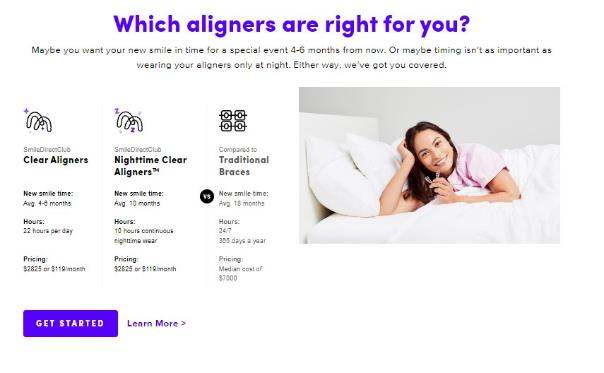
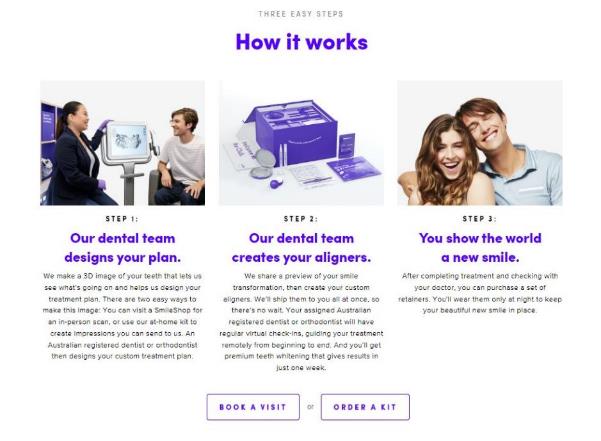
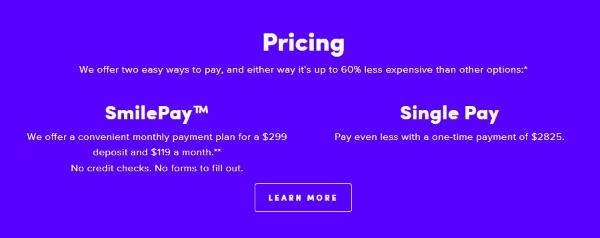
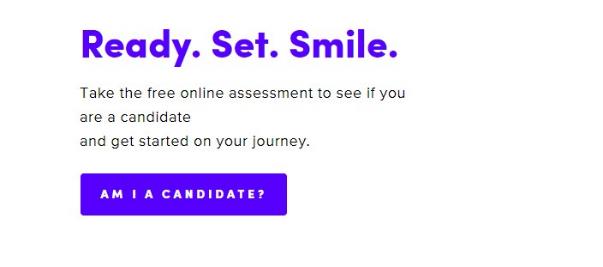
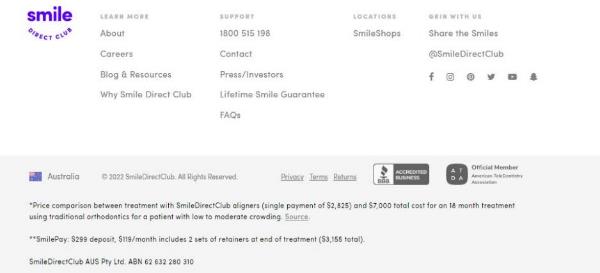
Item (b) – “SDC AU Pricing Page”
740 The SDC AU Pricing Page contains the following.

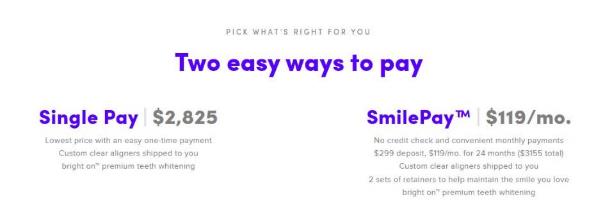
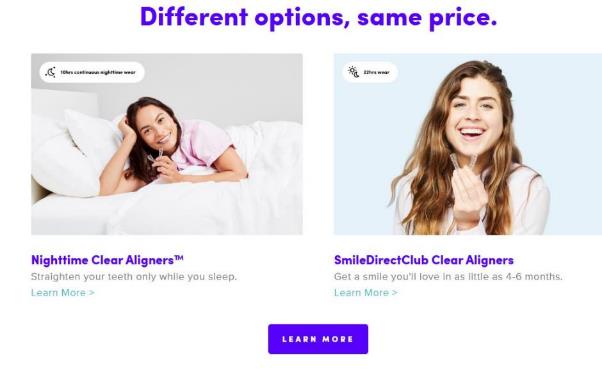
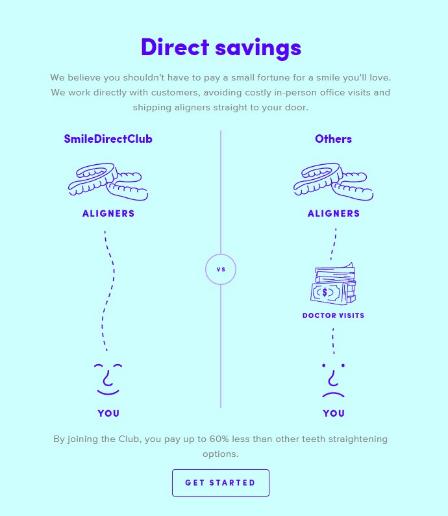
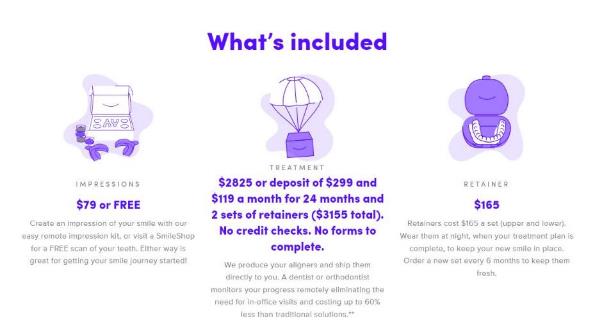

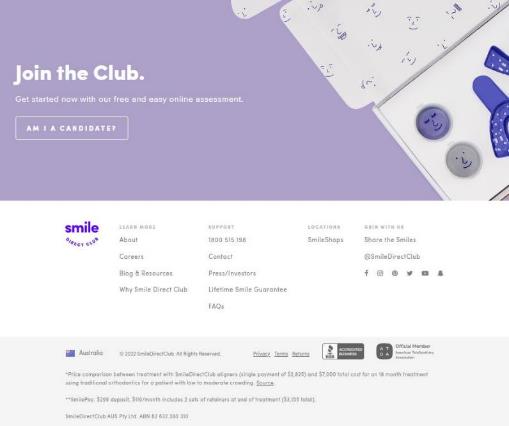
Item (c) – Advertorial in Marie Claire Magazine
741 The SDC advertorial in Marie Claire Magazine contains the following representation as to price.

Item (d) – Advertorial in Women’s Health Magazine
742 The SDC advertorial in Women’s Health Magazine contains the following representation as to price.
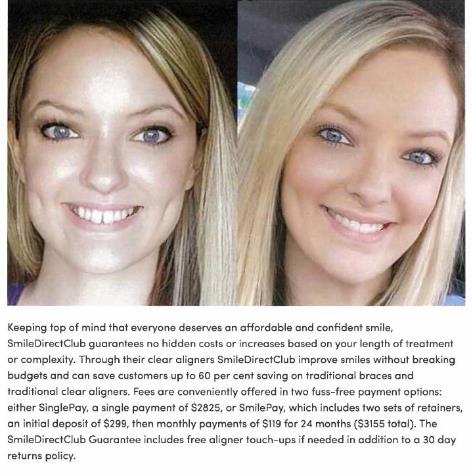
743 Invisalign contends that the above promotional material in items (a) to (d) make no reference to the Additional Costs, and that these representations are therefore misleading because the advertised price is not the total cost that a consumer is required to pay for SDC Aligner Treatment.
744 In my opinion, the ordinary and reasonable consumer who is interested in undertaking treatment for teeth straightening would not consider, from the representations made in items (a) to (d) of Annexure C, that the total cost of SDC Aligner Treatment would include the Additional Costs. This is so for the reasons that follow.
745 When considering whether advertising is false, misleading or deceptive, or likely to mislead or deceive, “the ‘dominant message’ of the material will be of crucial importance”: Australian Competition and Consumer Commission v Coles Supermarkets Australia Pty Ltd [2014] FCA 634 (ACCC v Coles) at [42], citing TPG2013 at [45]. In ACCC v Coles at [160], Allsop CJ stated:
… the courts should be astute and careful not to permit consumers to be misled on available meanings or connotations of phrases deliberately chosen to sell products on the basis that everyone takes advertising with a pinch of salt. To place emphasis on advertising licence that bends the truth will not only degrade the language, but lead to a culture of deception in the market. These matters do not elevate this case to a question of principle, but they should be borne in mind when broad laudatory language, intended to affect the buying decisions of members of the public, is such as to lead consumers into error and so to mislead or deceive, and the justification for such involves an intellectual shrug and a knowing nod to the effect that the public is cynical enough to look after itself…
746 The central question is whether the representations, viewed as a whole, have a sufficient tendency to lead an ordinary and reasonable consumer to form an erroneous assumption or conclusion about some fact or matter: TPG2020 at [22].
747 As to items (a) and (b), I find that the dominant message that is conveyed is that SDC offers two ways to pay for SDC’s Aligner Treatment, either payment by instalments or a payment by lump sum and either method is up to 60% less than other teeth straightening options.


748 The statements as to price pertain solely to the cost of SDC’s Aligner Treatment, rather than other costs that a consumer incurs before, during or after the SDC Aligner Treatment.
749 Invisalign contends that the representations in items (a) and (b) as to price may be best characterised as a “half-truth” or an unqualified literal truth because these representations may lull a consumer into a false sense that the Additional Costs are included in the advertised price. This is so, in Invisalign’s submission, because these representations do not mention the Additional Costs, some of which the consumers may incur (for instance the further treatment costs) and some of which consumers are required to incur in order to commence SDC Aligner Treatment (for instance, the prior and ongoing dental care costs; especially with respect to prior dental care, which the consumer is required to undertake and certify that they have undertaken in their completed consent form: see CB1830 under the heading “Informed Consent”).
750 However, in my view, the ordinary and reasonable consumer would not assume from the statements made by SDC that its SDC Aligner Treatment includes the Additional Costs. SDC’s treatment is premised upon the absence of in-person dental and orthodontic visits, and this is prominently stated throughout the SDC Website. SDC does not purport to provide general dental services or enable the treatment of a patient’s general dental or oral health. Nothing it says, including advertising the cost of SDC Aligner Treatment, suggests otherwise. This is not a “half-truth” of the category identified in Gillette Australia and Hoover Australia Pty Limited v Email Limited [1991] FCA 646; 104 ALR 369.
751 I find, on the evidence, that the representations as to price and the total cost of SDC Aligner Treatment are not false, misleading or deceptive or likely to mislead or deceive the ordinary and reasonable consumer.
752 These statements make no representation as to the Additional Costs and, indeed, insofar as the alleged representations were conveyed, they were not false, misleading or deceptive.
753 With respect to the retainer costs, neither the SDC Website Homepage nor the SDC AU Pricing Page advertise that the cost of retainers are included in the total cost of SDC Aligner Treatment.
754 Counsel for Invisalign, in oral closing submissions at T706.44–T707.3, submitted the following with respect to SDC’s promotional material surrounding the retainer costs:
…SDC is quite upfront that once you’ve finished your treatment you need to wear retainers; otherwise, your teeth will go back to their previous position. So you need to get retainers. But they’re not so upfront about the fact that you need to buy them every six months, and you have to do that in order to get your annual touch-up aligner and to qualify for your lifetime guarantee. So it’s not just one retainer, but it’s retainers every six months in order to take advantage of what is featured prominently in the advertising material as the Lifetime Smile Guarantee
755 However, in contrast to what was submitted above by Invisalign, both the SDC AU Pricing Page as well as the SDC Website Homepage make it expressly clear that additional fees are charged for retainers. Indeed, on the SDC AU Pricing Page under the heading “What’s Included” the promotional material conveys that the customer has the choice to purchase retainers every six months (for $165 a set) after the completion of their SDC Aligner Treatment to maintain their new smile, as can be seen below:
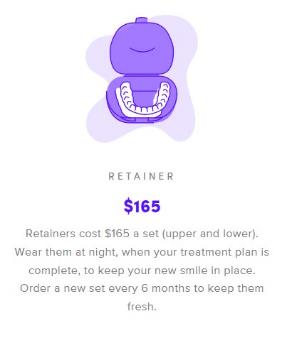
756 With respect to the SDC Website Homepage, a similar representation is conveyed. The promotional material on the SDC Website Homepage is explicit that retainer costs are not included in the advertised price. This can be seen in the image below where the text states “After completing treatment and checking with a doctor, you can purchase a set of retainers. You’ll wear them only at night to keep your beautiful new smile in place”.
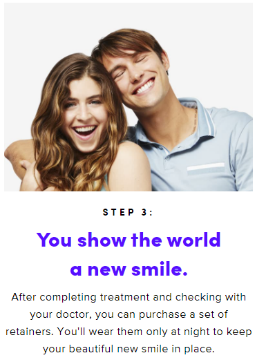
757 The critical point is that, when the patient’s SDC Aligner Treatment is complete, the customer then has the option to purchase a new set of retainers every six months if they wish to keep their smile in place. At no point does the promotional material pleaded under column I represent that such costs are included within the advertised price.
758 Gleeson J in AFT v Reckitt Pharmaceuticals (AU) Pty Ltd v Reckitt Benckiser (Australia) Pty Ltd [2020] FCA 672 (AFT v Reckitt) at [27(3)] found:
In assessing whether “qualifying” or “additional” material is sufficiently prominent or conspicuous, “it is appropriate to consider not simply the words or images depicted but also their relative emphasis (whether by print size, location, colour or other manner of presentation)”: Australian Competition and Consumer Commission v Harris Scarfe Australia Pty Ltd [2009] FCA 54 at [53].
759 The graphic of the retainer under the SDC AU Pricing Page clearly displays the price of $165, in large purple print, immediately under the heading “RETAINER”. The ordinary and reasonable consumer, when viewing the price and graphic alongside the statement which identifies that consumers will need to “Order a new set every 6 months” in order to keep their smile “fresh” would understand that there are ongoing costs after the completion of SDC Aligner Treatment, which a consumer may choose to opt into and which is not included in the advertised price.
760 The same can be said for the SDC Website Homepage. In my view, the representations in the image below, from the SDC Website Homepage, make clear that the retainer costs are not included in the SDC Aligner Treatment. This is because the SDC Website Homepage informs the consumer that retainers “can” be “purchase[d]”. It is plainly wrong to submit, as Invisalign has done, that “[SDC is] not so upfront” about the retainer costs.
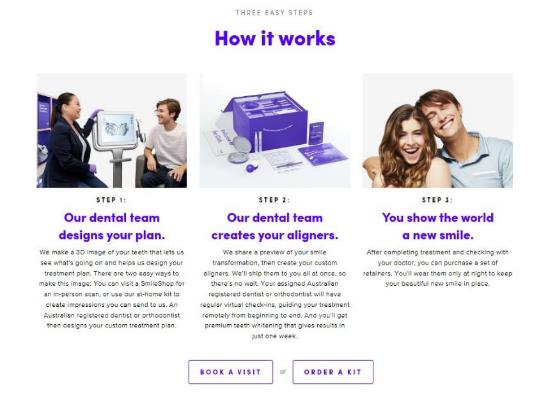
761 Neither the SDC Website Homepage nor the SDC AU Pricing Page conveys to the ordinary and reasonable consumer that, after the SDC Aligner Treatment is completed, the cost of retainers is included in the price.
762 It is clear that the ongoing costs associated with purchasing retainers, are outside of the costs of SDC Aligner Treatment, and were expressly not intended to be included within the price of SDC’s Aligner Treatment.
763 As a result, I do not find this to be false, misleading or deceptive to the ordinary and reasonable consumer.
764 Further, as stated above, SDC’s Aligner Treatment is premised on the absence of in-person dental or orthodontic visits, and this is prominently stated on the SDC AU Pricing Page in the graphic under the heading “Direct Savings”. This graphic shows a comparison between SDC’s Aligner Treatment and the aligner treatment offered by “Others”, being SDC’s competitors in the relevant market. The text states: “we work directly with customers, avoiding costly in-person office visits and shipping aligners straight to your door”. This can be seen in the graphic below.
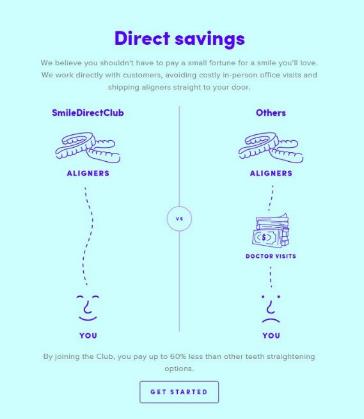
765 Invisalign claims that the above graphic is another example of a “half-truth”, in that the representation above is only true to the extent the SDC Aligner Treatment does not involve any in-person consultation. In Invisalign’s submission, the cost involved prior to or during the SDC Aligner Treatment is required for a consumer to provide “informed consent” to commence SDC Aligner Treatment and should be viewed as a half-truth which is misleading.
766 However, such a submission is a mischaracterisation of what SDC has represented. It is clear that SDC does not provide general dental services or enable the treatment of a patient’s dental or oral health. This is required to be done before the customer undertakes SDC Aligner Treatment and an ordinary and reasonable consumer would understand that this is not something that would be included in the price of SDC Aligner Treatment. There is nothing that is represented in the promotional material which suggests otherwise.
767 The alleged Total Cost Representations are contrary to the actual statements SDC made via the SDC Website Homepage and the SDC AU Pricing Page, which makes plain to consumers that SDC’s Aligner treatment is dentist-directed, does not involve in-person consultations and is designed for mild to moderate teeth correction.
768 Additionally, an ordinary and reasonable consumer, traversing from the SDC Website Homepage or SDC AU Pricing Page, by clicking on the footer of the SDC Website, regarding the “Lifetime Smile Guarantee” would not consider it to be part of the advertised price of SDC’s Aligner Treatment, rather an ordinary consumer would view this to be in addition to, and an option that can be purchased, if desired.
769 The pricing statement represents nothing as to the terms and conditions of the “Lifetime Smile Guarantee”.
770 A consumer that clicks into the terms of the “Lifetime Smile Guarantee” under the “support” column which is provided for at the bottom of each of the SDC Website Homepage and SDC AU Pricing Page (which is provided in the image below), would understand that this guarantee is conditional upon consumers replacing their retainers every six months, and as I have discussed above, is contingent upon retainers being purchased (at a cost of $165) every 6 months.
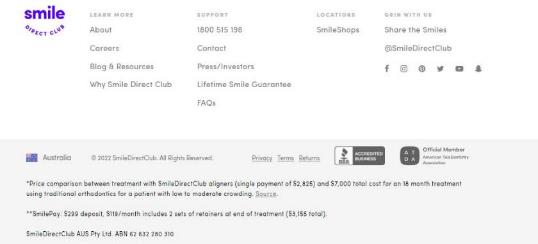
771 I also note the inherent flaw in Invisalign’s submission with respect to the further treatment costs. It is clear that the advertised price for SDC Aligner Treatment encompasses the steps that a customer takes to straighten their teeth within the 4-6 month treatment plan, which includes the clear aligners and all of the other items within the purple box that the customer receives after the customer’s treatment plan has been approved. To say that SDC has misled consumers because the advertised price does not refer to costs that are associated with further treatment after SDC Aligner Treatment is illogical. One would have to ask, why would a consumer form an assumption that the cost of SDC Aligner Treatment would include costs that might be incurred after the customer has completed SDC Aligner Treatment? The answer is that they would not form this conclusion, and this submission has no merit. Moreover, there is nothing within items (a) to (d) above that would lead customers to believe that such costs are included with the advertised price of SDC Aligner Treatment.
772 The cross-examination of Ms Brown on the issue of the cost of retainers and the representation of the “free yearly touch-up”, which occurred at T342 is instructive:
Now, I think you’ve explained this in your affidavit. That’s only free if you’ve purchased on a six-monthly basis and registered a $165 – that’s the current price – retainer. That’s right, isn’t it?---The current price as of today is 167, but yes.
So apart from that – because it’s not free because you have to pay for the retainers. That’s right?---Yes, you pay for the retainers.
So in brackets, you could put, “That’s free (except for the $165 you have to pay every six months)”. That’s right?---Yes, we do have at the bottom, “Terms and conditions apply,” and then you go to the - - -
Where’s that, sorry?---At the bottom of - - -
I see?--- - - - that email on page 164.
Right. And where does that take you?---To the Lifetime Smile Guarantee page on the website.
Right. So when you talk about terms and conditions, you’re saying – let me get this right – that although it’s not free because you have to pay $167 every six months –that’s right?---I guess the free part, to my understanding, is it’s not in – there’s nothing in addition – it’s the aligner treatment, but then should you wish to keep your smile in place, you purchase retainers at an additional cost.
But it’s not only should you wish to keep your smile in place. It’s if you want your free yearly touch-up. That’s right, too, isn’t it?---Yes.
All right. So it’s – you agree it’s not free?---I guess so.
No, not “I guess so”?---Sorry.
It’s not free, is it, Ms Brown?---It’s not in a – from the aligner treatment, it’s not addition – it’s not additional aligner treatment cost.
Ms Brown?---But it’s an additional retainer treatment – retainer cost.
Ms Brown, is it free to have a touch-up every year?---No.
773 Ms Brown’s cross-examination on this point was:
(a) retainers are not included in the treatment cost;
(b) it is open to the customer to purchase retainers at an additional cost to keep their smile in place; and
(c) it is not free to have a touch-up completed every year.
774 This is in fact correct and is what SDC has represented within its promotional material.
775 I will now turn to items (c) and (d), which are representations made in advertorials in Marie Claire Magazine and in Women’s Health Magazine. For ease of reference these are provided again below:

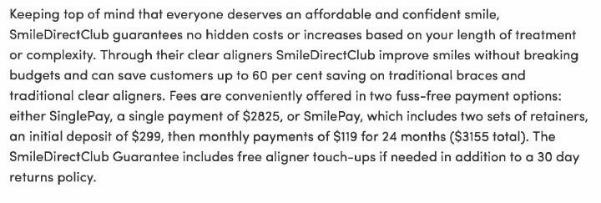
776 An ordinary and reasonable consumer reading the above advertorials, in their entire context would not consider that the Additional Costs were included in the two distinct and discrete price options. The advertorial does no more than provide the price which a consumer would pay for SDC’s Aligner Treatment. There is nothing false or misleading in such an advertisement. The advertorial in item (d) also mentions, in a separate sentence, the “Lifetime Smile Guarantee”, but does no more than inform the consumer about the existence of this guarantee. It says nothing as to the terms which apply to the guarantee. There is nothing false or misleading in such an advertisement.
777 After considering items (a) to (d) under column I of Annexure C to these reasons, I have formed the view that the Total Cost Representation has not been made out, and for the reasons above, this part of Invisalign’s claim must fail.
Less than $4 a day Representation
778 Invisalign contends that SDC has made representations that are false, misleading or deceptive, or are likely to mislead or deceive through various representations it has made in its promotional material which states that SDC’s Aligner Treatment will cost “less than $4 a day” (less than $4 a day representations).
779 By Amended CS at [18], Invisalign has claimed that SDC represented to consumers that the total cost associated with SDC Aligner Treatment is “less than $4 a day” for the duration of the treatment, or alternatively for the duration of a 90 day to 6 month treatment.
780 Invisalign submits that the less than $4 a day representations would mislead an ordinary and reasonable consumer into concluding that they would pay less than $4 a day for the time taken to treat their smile and straighten their teeth. Because SDC, in its promotional material, has made representations that it takes on average 4-6 months to “straighten [a customer’s] smile”, Invisalign submits that an ordinary and reasonable consumer would view the less than $4 a day representations and would form the view that they would pay, on average less than $4 a day for the 4-6 months of treatment time. This would therefore lead the ordinary and reasonable consumer to believe that, using the 6 month treatment time as the prime example, SDC Aligner Treatment would cost approximately $730 (calculated as 365/2 = 182.5. 182.5 x $4 = $730), which is significantly less than the advertised price.
781 SDC accepts that, in certain instances, it has represented to consumers that the cost of SDC’s Aligner Treatment was less than $4 a day, however, SDC does not accept that it represented that the period over which this cost would be incurred was referrable to the 4-6 month treatment time.
782 SDC admits that it has published material which contains the statement “Straighten your smile from home for less than $4 per day”. However, SDC submits that doing so is not false, misleading or deceptive, or likely to mislead or deceive the ordinary and reasonable consumer. This is because the ordinary and reasonable consumer would understand that these representations are not referrable to treatment time, but rather, to the time over which instalments for SDC Aligner Treatment are paid, which is over a 24 month period.
783 The advertised price for SDC Aligner Treatment using the instalment option (SmilePay) is $3,155. This price includes the cost of two sets of retainers at $165 per set ($330 in total). SDC submits that, at all times, the instalment paid via SmilePay was payable over 24 months.
784 The cost of SDC Aligner Treatment, discounting the cost of retainers, when paying by instalments is therefore $2,825 (being $3,155-$330) divided by the number of days in a 24-month period, (i.e. 365 x 2 = 730), which equates to approximately $3.87 per day (calculated at $2,825/730 = $3.87 (rounded up to the nearest cent)). As such, SDC submits that the less than $4 a day representations are not false, misleading or deceptive as alleged by Invisalign.
785 Having regard to the promotional material in Annexure C, under column II, I do not find any of the promotional materials to limit the less than $4 a day representations to treatment time, nor would an ordinary and reasonable consumer viewing these promotional materials understand the less than $4 a day representations to be limited to treatment time.
786 Invisalign contends that ordinary and reasonable consumers would assess the less than $4 a day representations as part of SDC’s general promotional claims, including that SDC Aligner Treatment generally takes 4-6 months to complete. However, if this is correct, the ordinary and reasonable consumer would also have viewed the SmilePay option on the SDC AU Pricing Page, which states that the cost of SDC Aligner treatment occurs over 24 months with SmilePay. The following statement on the SDC AU Pricing Page identifies the SmilePay 24 month instalment plan option:
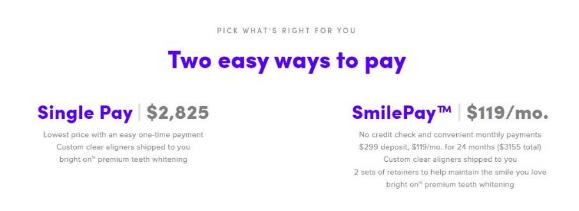
787 I have provided, below, some further examples of the less than $4 a day representations as pleaded under column II of Annexure C.
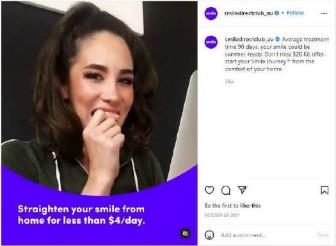
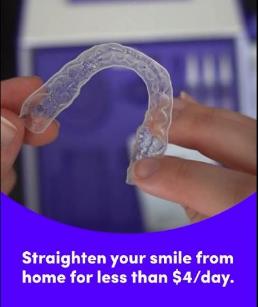
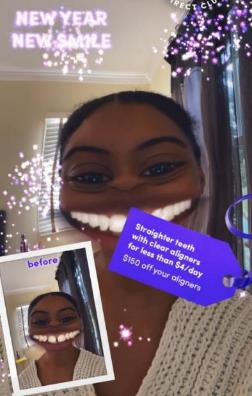
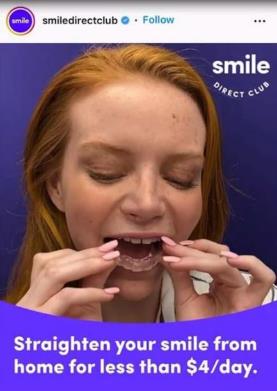
788 The less than $4 a day representations also took the form of text messages, which were sent as promotional advertisements to SDC customers, examples of such text messages are as follows:
SmileDirectClub: Hate being overcharged? So do we. That’s why our premium, Australian registered dentist-directed treatment costs less than $4 a day [REDACTED], start your new smile today and get a $300 off your aligners with code LIA5NPZY7H: Hurry, offer ends 10th Nov.|||Plus, check out our SmilePay™ option with 100% approval. Order your SmileDirectClub aligners smiledirect.co/3EYHYX0
…
SmileDirectClub: Hate being overcharged? So do we. That’s why our premium, Australian registered dentist-directed treatment costs less than $4 a day [REDACTED], start your new smile today and get $300 off your aligners with code NYE7FS4X2B: Hurry, offer ends 20th Jan.|||Plus, check out our SmilePay™ option with 100% approval. Order your SmileDirectClub aligners smiledirect.co/3nx8u3i
…
SmileDirectClub's premium, dentist-directed treatment costs less than $4/day. That’s less than a cup of coffee. Get started from home with a $20 impression kit (free after return). Order now: smiledirect.co/3LDYQGw
…
SmileDirectClub's premium, dentist-directed treatment costs less than $4/day. That’s less than a cup of coffee. Book a free 3D scan today. smiledirect.co/3qqxWsN. Or start from home with a $20 impression kit (free after return). Order now: smiledirect.co/3KWWlha
…
SmileDirectClub's premium, dentist-directed treatment costs less than $4/day. That’s less than a cup of coffee. Get started from home with a $20 impression kit (free after return). Order now: smiledirect.co/3uj7v9h
…
SmileDirectClub: Hate being overcharged? So do we. That’s why our premium, Australian registered dentist-directed treatment costs less than $4 a day [REDACTED], start your new smile today and get a $300 off your aligners with code LIA5NPZY7H: Hurry, offer ends 10th Nov.|||Plus, check out our SmilePay™ option with 100% approval. Order your SmileDirectClub aligners smiledirect.co/3EYHYX0
…
SmileDirectClub: Hate being overcharged? So do we. That’s why our premium, Australian registered dentist-directed treatment costs less than $4 a day [REDACTED], start your new smile today and get $300 off your aligners with code NYE7FS4X2B: Hurry, offer ends 20th Jan.|||Plus, check out our SmilePay™ option with 100% approval. Order your SmileDirectClub aligners smiledirect.co/3nx8u3i
…
SmileDirectClub's premium, dentist-directed treatment costs less than $4/day. That’s less than a cup of coffee. Book a free 3D scan today. smiledirect.co/3oObGrZ. Or start from home with a $20 impression kit (free after return). smiledirect.co/3Jyqy5O
…
SmileDirectClub's premium, dentist-directed treatment costs less than $4/day. That’s less than a cup of coffee. Get started from home with a $20 impression kit (free after return). Order now: smiledirect.co/3LDYQGw
789 In my view, it is clear that none of the above representations equate the less than $4 a day representations against treatment time, nor would an ordinary and reasonable consumer form the view that this is the appropriate metric upon which the representations should be measured.
790 I have also considered, at item (f) of column II in Annexure C, a dozen examples of marketing emails which contained the less than $4 a day representation. These marketing emails were largely repetitive. I have placed a few examples of the content of these emails, insofar as the less than $4 a day representation is relevant, below:

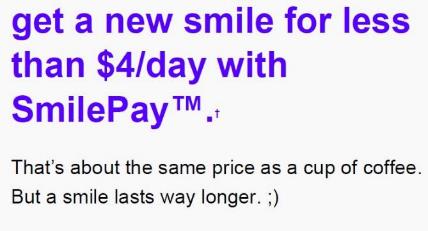
791 The examples shown above of the email marketing material are clear. The less than $4 a day representation is qualified by the SmilePay payment option, which, as noted above, is correct in representing that SDC Aligner Treatment indeed does cost less than $4 a day over the 24 month payment period.
792 It should also be noted that the marketing material emails contain a footnote marked as a “✝”, which qualifies and provides calculations for the less than $4 a day representations. Examples of this can be seen below.



793 Gleeson J in AFT v Reckitt at [27(2)] and [27(3)] outlined the consideration that must be had when viewing qualifying material in advertisements:
While “[t]here may be occasions upon which the effect of otherwise misleading or deceptive conduct may be neutralised by an appropriate disclaimer”, the general rule is that “a person engaging in misleading or deceptive conduct cannot use the device of a disclaimer to evade responsibility, unless that disclaimer erases the proscribed effect”: iNova Pharmaceuticals (Australia) Pty Ltd v Reckitt Benckiser (Australia) Pty Ltd [2018] FCA 1209 at [25(1)]-[25(2)]. See also Australian Competition and Consumer Commission v Signature Security Group Pty Ltd [2003] FCA 3 at [26] and [27]; Medical Benefits Fund of Australia Ltd v Cassidy (2003) 135 FCR 1 at [37] ff and National Exchange Pty Ltd v Australian Securities and Investments Commission [2004] FCAFC 90 at [50], [51] and [55].
…
In assessing whether “qualifying” or “additional” material is sufficiently prominent or conspicuous, “it is appropriate to consider not simply the words or images depicted but also their relative emphasis (whether by print size, location, colour or other manner of presentation)”: Australian Competition and Consumer Commission v Harris Scarfe Australia Pty Ltd [2009] FCA 54 at [53]. Important matters will include “the way the asterisk is placed, the size of the footnote relative to the text in the body of the advertisement, and the terms of the footnote”: ibid, citing Trade Practices Commission v QDSV Holdings Pty Ltd (t/as Bush Friends Australia) [1994] FCA 1562 at [37]-[40].
794 In my view, the placement of the footnote marked as a “✝” in the email marketing material, is sufficiently prominent to alert the ordinary and reasonable consumer to the manner in which the less than $4 a day representations are calculated. In any event, the representation itself makes clear to the ordinary and reasonable consumer that the price is referrable to, and qualified by, the payment time over 24 months using SmilePay.
795 In considering the promotional material pleaded under column II, I have formed the view that the ordinary and reasonable consumer would view the less than $4 a day representations against the metric of time taken to complete the payment via instalments with SmilePay, which occurs over a 24 month period. There is nothing in the promotional material which would lead an ordinary and reasonable consumer to form the view that the $4 a day is referrable to treatment time. If an ordinary and reasonable consumer formed the view that the less than $4 a day representations are referrable to treatment time, it would be their own mistaken assumption, as such a view does not arise from anything SDC has represented in its promotional material.
796 I should also note the practical flaw in Invisalign’s claim under this representation. An ordinary and reasonable consumer would not, in my view, associate the less than $4 a day representation against the metric of “time taken to complete the treatment”, which is highly variable and dependent upon a number of factors including each patient’s level of malocclusion, whether that patient would opt for the regular clear aligners (with an average of 4-6 months) or SDC’s Nighttime Aligners (which take on average 10 months to complete), as well as any number of idiosyncrasies relevant to treating each customer’s smile, which may take longer or shorter than the average treatment time. It is simply impractical and incorrect to take the view proposed by Invisalign, and an ordinary and reasonable consumer, in my view, would not make this assumption.
797 The better view, and the way that an ordinary and reasonable consumer, when viewing SDC’s promotional material under column II would take, is that the advertised price is referrable to the cost of the treatment, which is fixed, and payable via SmilePay.
798 After considering items under column II of Annexure C to these reasons, I have formed the view that the less than $4 a day representations claim has not been made out, and for the reasons above, this part of Invisalign’s claim must fail.
Comprehensive Solution Representation
799 The Comprehensive Solution Representation, as pleaded at Amended CS [21(a)], is as follows:
(a) either separately or collectively, SDC AU and/or SDC LLC has represented to consumers that SDC Aligner Treatment would provide a comprehensive orthodontic solution to all orthodontic issues, or alternatively, provide a comprehensive orthodontic solution in respect of all orthodontic issues that are not severe (the Comprehensive Solution Representation).
800 Invisalign claims that by using orthodontic braces treatment (for a period of 18 months) and Invisalign Aligner Treatment as comparators in its advertising and promotional material, SDC has represented to consumers that SDC Aligner Treatment is capable of treating the same range of orthodontic issues that are achieved by braces and Invisalign Aligner Treatment (amongst other orthodontic treatments).
801 While SDC in its submissions sought to characterise the Comprehensive Solution Representation in terms of comparative advertising principles, in accordance with Gillette Australia, this is an incorrect assessment of the case put against them. I agree with counsel for Invisalign’s oral submissions in closing (from T690.19), that the Comprehensive Solution Representation is not covered by the area of jurisprudence such that it would fit within a comparative advertising case, as this claim is non-comparative. Rather, this claim is simply that: because SDC deploys its advertising by reference to Invisalign Aligner Treatment and braces, SDC is misrepresenting to the ordinary and reasonable consumer that SDC Aligner Treatment can provide a comprehensive orthodontic solution to all orthodontic issues that are not severe. This is not a Gillette Australia case where it is claimed that a feature or features of SDC Aligner Treatment are superior to its competitor, in a comparative sense.
802 In support of its claim, Invisalign relies on the relevant representations pleaded in column V of Annexure C. A selection of these representations are shown below.
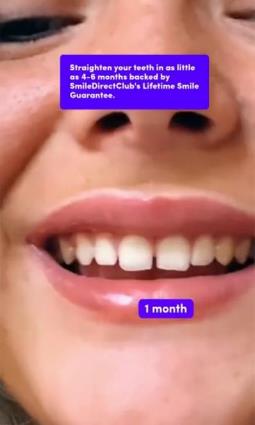
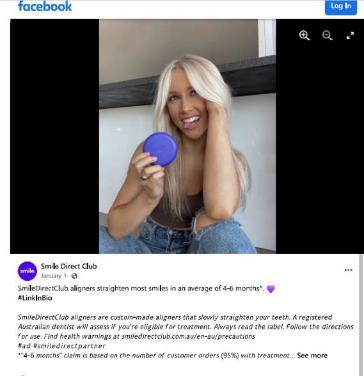
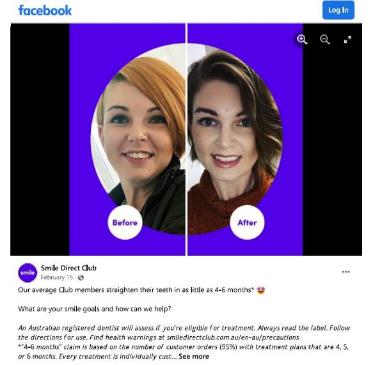
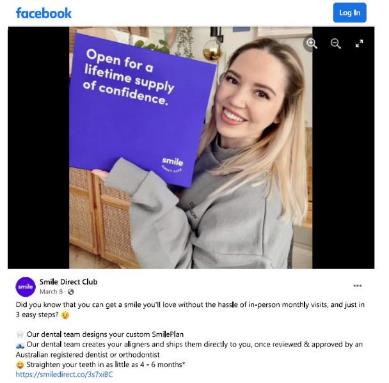
803 I have considered all of the representations pleaded in column V of Annexure C and for the reasons that follow, this part of Invisalign’s claim must also fail.
804 The promotional material that is pleaded simply makes no representation about SDC Aligner Treatment being capable of providing a “comprehensive orthodontic solution” of the kind alleged by Invisalign.
805 It is entirely unclear how these statements are said to give rise to the Comprehensive Solution Representation or make any representation that relates to the severity of treatments that SDC aligners are capable of treating, nor do Invisalign’s submissions address this issue.
806 For instance, when viewing item (a) in column V of Annexure C, as depicted below, nothing within this webpage would lead an ordinary and reasonable consumer to form the view that SDC Aligner Treatment provides an orthodontic solution to all orthodontic issues, or alternatively, provide a comprehensive orthodontic solution in respect of all orthodontic issues that are not severe. The webpage simply depicts the steps that are involved in commencing SDC Aligner Treatment, how it works and what a customer will receive as part of SDC’s Aligner Treatment.
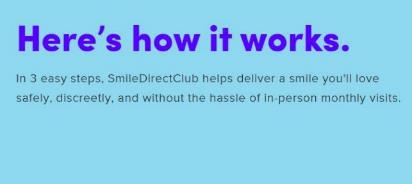



807 Item (i) in column V of Annexure C, as depicted below, contains an SDC television advertisement which depicts a woman’s journey from the first day of her SDC Aligner Treatment, with a time lapse of the progress she has experienced every month until the sixth and final month of her treatment. Two screenshots, which have been taken from this video are shown below.
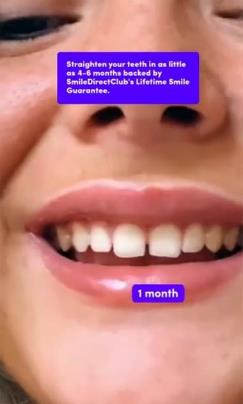
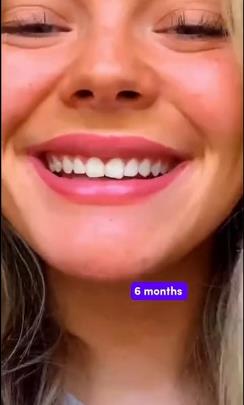
808 The first image contains text which states, “Straighten your teeth in as little as 4-6 months backed by SmileDirectClub’s Lifetime Smile Guarantee”.
809 While Invisalign has not expanded upon why this video in item (i) of column V is said to impermissibly misrepresent SDC Aligner Treatment in the manner pleaded by way of its Comprehensive Solution Representation claim, I surmise that what is alleged is that this consumer’s smile, as depicted, does not reflect a case that is ordinarily capable of treatment with SDC aligners (i.e. it is outside of the threshold of what would be considered mild to moderate malocclusion). However, in my view, having considered this item, I find that it simply does not convey that SDC Aligner Treatment provides a “comprehensive solution” to all orthodontic issues that are not severe.
810 The effect of an advertisement must be tested by reference to its impact on ordinary or reasonable members of the class of consumers to whom it is directed: Taco Company of Australia Inc v Taco Bell Pty Ltd (1982) 42 ALR 177, 202 (Deane and Fitzgerald JJ). The effect of this advertisement would not, in my view, lead ordinary and reasonable consumer to form the view that SDC Aligner Treatment is capable of providing a comprehensive solution to all orthodontic issues.
811 In any event none of the items pleaded under column V make any representations that would give rise to the Comprehensive Solution Representation.
812 Nor is any explanation provided by Invisalign as to why the pleaded promotional material is said to convey that SDC aligners treat all orthodontic issues or all orthodontic issues that are not severe. Plainly it does not.
813 Many of the other items under column V simply state that SDC aligners can straighten teeth in 4-6 months. The promotional material does not say “SDC Aligner Treatment can provide a comprehensive solution to all orthodontic issues (or non-severe issues)”. Nor does the imagery in the promotional material under column V depict that a comprehensive treatment to all orthodontic issues could occur. An ordinary and reasonable consumer, viewing the promotional material under column V would not form the view that SDC Aligner Treatment is capable of doing so.
814 There is nothing within the promotional material pleaded in column V of Annexure C which would lead an ordinary and reasonable consumer to believe that SDC Aligner Treatment can provide a comprehensive orthodontic solution to all orthodontic issues, or alternatively, provide a comprehensive orthodontic solution in respect of all orthodontic issues that are not severe. As a result, this ground must fail.
COMPARATIVE ADVERTISING CLAIMS
815 The balance of the alleged representations are the comparative advertising claims. In determining these claims, the task for the Court is to determine the pleaded case by:
(a) first, deciding whether SDC made the pleaded representations (e.g., that treatment using SDC aligners is less effective, treats patients with comparable needs, is less expensive or is not comparable to treatment using Invisalign aligners or traditional braces); and
(b) second, if made, whether any such representations are false, misleading or deceptive as alleged.
816 Prior to delving into the substantive claims as alleged by Invisalign against SDC under the comparative advertising claims, it is worth noting that the following matters are not in dispute:
(a) SDC aligners are capable of treating mild to moderate cases, whereas Invisalign aligners and braces can treat more complex cases;
(b) treatment using SDC aligners in Australia does not include in-person dental or orthodontic visits;
(c) treatment using SDC aligners does not involve providing patients with general dental care. Patients are expected to see their treating dentist to check and maintain their general dental and oral health; and
(d) SDC aligners do not involve the use of attachments or auxiliaries.
817 Each of the SDC aligners, braces and Invisalign aligners are competing teeth straightening products. They each have different features and treat different issues. This was aptly explained in the expert evidence. However, contrary to Invisalign’s case, and in accordance with the principles in Gillette Australia, the fact that these teeth straightening products treat different features does not have the effect that SDC’s comparative advertising is false, misleading or deceptive. It is true, and SDC accepts, that treatment with SDC aligners cannot treat all of the conditions capable of treatment with Invisalign aligners or braces. However, the pleaded statements made by SDC do not represent that they can. To the contrary, SDC’s Australian website discloses that SDC aligners are designed to treat mild to moderate crowding and spacing. None of the expert witnesses give evidence that SDC aligners are ineffective at treating mild to moderate crowding or spacing.
818 I will now turn to each of the comparative advertising claims.
Price Comparison Representations
819 Invisalign, by its Amended CS at [20], alleges that SDC represented to consumers that:
(a) SDC Aligner Treatment is less expensive in all instances than treatment with braces obtained from a dentist or orthodontist; and/or
(b) SDC Aligner Treatment is less expensive than equivalent treatments obtained from a dentist or orthodontist; and/or
(c) SDC Aligner Treatment is 60% less, or further or alternatively up to 60% less expensive than other treatment options, including Invisalign treatment, in patients with equivalent treatment needs; and/or
(d) SDC Aligner Treatment is 60% less, or further or alternatively up to 60% less expensive than traditional orthodontic treatments obtained from a dentist or orthodontist, including braces, in patients with equivalent treatment needs,
(the Price Comparison Representations).
820 Invisalign submits that the Price Comparison Representations are false, misleading or deceptive or likely to mislead or deceive because SDC does not have a basis for making the claims that SDC Aligner Treatment is “60% less” or “up to 60% less” than Invisalign, other aligners or braces. This is so in circumstances where Invisalign alleges that the evidence establishes that the range of costs for Invisalign Aligner Treatment and traditional braces “fall far short of a range that would support a 60% comparison”.
821 Invisalign contends that, by not factoring the Additional Costs into the pricing comparison (which Invisalign submits are costs that consumers are required to pay), the Price Comparison Representations are false, misleading or deceptive.
822 The promotional material relied upon by Invisalign in support of its claim under the Price Comparison Representations have been split into two separate columns in Annexure C. Under column III of Annexure C, Invisalign has provided extensive representations which it alleges are false, misleading or deceptive in its representation that SDC Aligner Treatment is “up to 60% less” expensive than traditional braces or other similar treatment options.
823 The alternative claim put by Invisalign under column IV in Annexure C is that SDC has made misleading representations in which it has claimed that SDC Aligner Treatment is “60% less than” traditional braces or other similar treatment options.
824 I have considered all of the promotional material pleaded under columns III and IV. I will outline these representations and what is claimed, in greater detail below.
825 Invisalign, under column III of Annexure C has provided a number of examples of representations made by SDC in its promotional material whereby it alleges that SDC has misled consumers into believing that SDC Aligner Treatment costs up to 60% less than braces or other teeth straightening options. A few examples of this material can be found below.
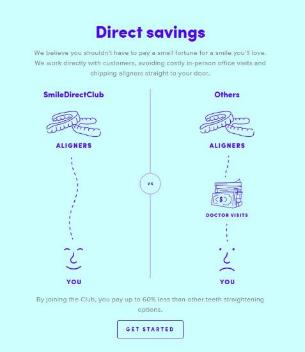


826 The above representation at item (c) under column III portrays a Google search result that appears when an individual causes a search of “Invisalign” to be made. The first search result that appears is an advertisement of SDC’s Aligner Treatment. This advertisement states that SDC “Costs Less” and is “Up to 60% Less Expensive”. Invisalign has asserted that, because SDC, through its use of search engine optimisation which has “boosted” SDC’s advertisement to the top of the Google page when one searches “Invisalign”, it should therefore be considered the case that SDC is promoting itself as being up to 60% less expensive than Invisalign. However the representation does not state that. The representation merely states that SDC is “Up to 60% Less Expensive”, without making any direct comparison with Invisalign. This is not a case, as in Gillette Australia or Telstra v Optus, where a direct comparison of the features of a product are being drawn out or contested against each other in an advertisement. Rather, item (c) merely provides a search result for SDC Aligner Treatment which, through clever search engine optimisation, has allowed SDC to land at the top of the Google search results page when one searches for “Invisalign”. The above representation makes no such comparison with Invisalign Aligner Treatment.

827 The above image which is pleaded at item (d) of column III of Annexure C (and tendered as exhibit 73 (24f)) is a TikTok post from the official “@smiledirectclub” TikTok account. This TikTok video portrays a woman asking herself “Am I the drama? Maybe I am? Am I the villain? I don’t think I’m the villain” which, as far as I am aware, was a viral TikTok trend in which the person making the post seemingly comes to terms with the realisation that they could be the root cause of the current “drama” that they are faced with. In this context the “drama” seems to be, by virtue of the text, that SDC is offering, and is representing that it offers, its SDC Aligner Treatment for “up to 60% less than Invisalign”, which, as can be inferred by this dispute, has caused a degree of “drama” between the parties.
828 The TikTok post at item (d) of column III also contains a disclaimer which qualifies the “up to 60% less” claim as being based on the calculation of average total fees excluding retainers, which can be seen below. Invisalign submits that this disclaimer is wholly inadequate to erase the clear and dominant effect of the video, being that SDC sells comparable aligners to Invisalign at a price of up to 60% less.
829 I find however that this contention is misconceived. At no point does this TikTok video at item (d) ever draw a direct comparison which seeks to promote and compare SDC aligners to Invisalign aligners in terms of efficacy. Rather, in accordance with the principles in Gillette Australia and Luxottica the dominant feature of this promotional material, and the feature which is being highlighted is clearly a comparison between the price of these products. Absolutely no representation is made about any other features of the SDC aligners with that of Invisalign.
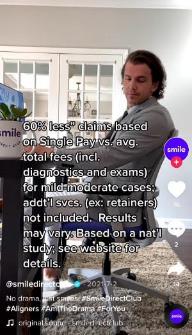
830 Further examples of the “up to 60% less” representations are shown below.
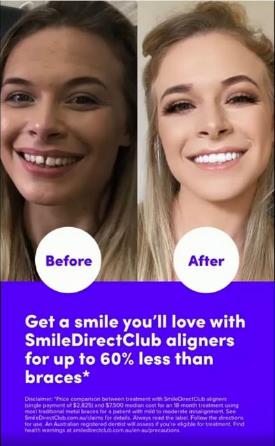
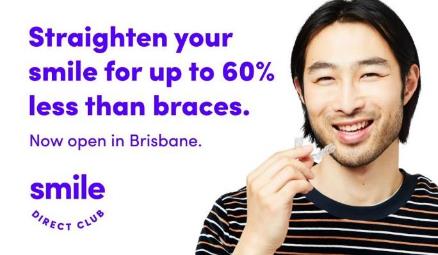
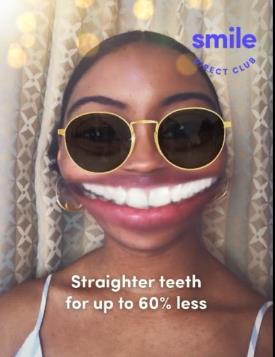
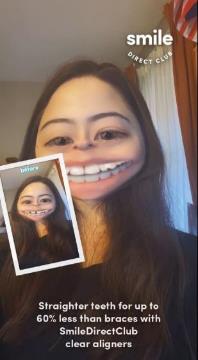

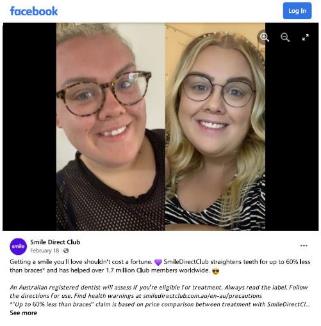
831 Invisalign, under column IV of Annexure C, has provided a number of examples of representations made by SDC in its promotional material whereby it alleges that SDC has misled consumers into believing that SDC Aligner Treatment costs 60% less than Invisalign.
832 A few examples of this material can be found below. I have also provided some relevant footnotes which substantiate the “60% less” claim that are found on the same webpage as some of the items listed below.
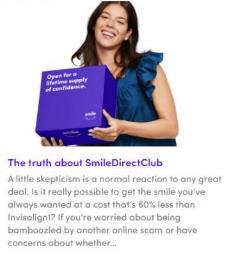
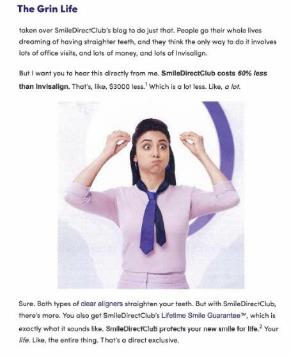

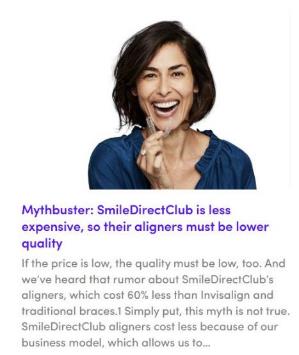

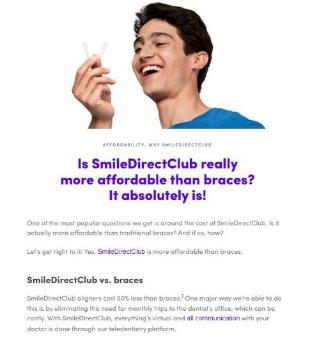

833 Each of the above representations in items (a), (c), (d) and (e) are claims that are made by SDC on its Grin Life Blog webpage, which was tendered in exhibit 73.
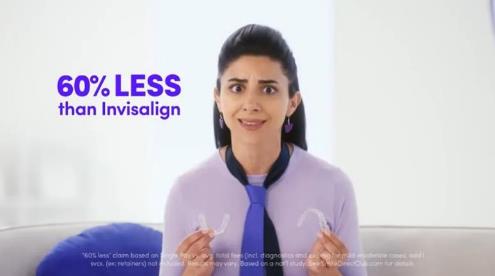
834 The above representation pleaded at item (b) of column IV (exhibit 73 [27a]) is a YouTube video in which the host draws a direct comparison between Invisalign aligners and SDC aligners. In this YouTube video, the host presents both SDC and Invisalign aligners and states that “both [Invisalign and SDC aligners] straighten your teeth, but SmileDirectClub is 60% less than Invisalign. With SmileDirectClub you get a smile you love directed by one of their doctors with aligners sent directly to you, so the savings go directly to you …”.
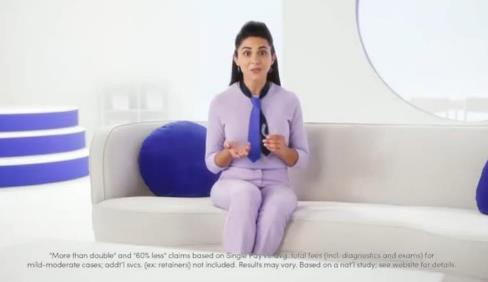
835 The above representation pleaded at item (b) of column IV (exhibit 73 [27b] and [31c]) is another YouTube video in which the host draws a similar direct comparison between Invisalign’s aligners and SDC’s aligners. In this YouTube video, the host states: “Some people are paying more than double for teeth straightening with Invisalign. And then there is SmileDirectClub. You get a smile you love directed by one of their doctors with aligners sent directly to you”.
836 Invisalign submits that the tendency of such an advertisement, and a necessary part of SDC’s advertising is such that it would lead ordinary and reasonable consumers to consider SDC Aligner Treatment as an alternative “in terms of efficacy” to Invisalign (or braces). I find that the alleged representation simply does not arise in the advertising. As has been described above, each of these modes of advertising is strict in what has been represented and is confined to a pricing comparison. I will now discuss my finding with respect to the Price Comparison Representations in greater detail below.
837 The Price Comparison Representations assert a cascading array of representations from Amended CS at [20(a)] to [20(d)]. In my view, however, none of the representations arise.
838 I have considered all of the promotional material pleaded in columns III and IV in light of the pleading and for the reasons outlined below, I find that this part of Invisalign’s claim must also fail.
839 First, the Amended CS at [20(a)] alleges a representation that “SDC Aligner Treatment is less expensive in all instances than treatment with braces obtained from a dentist or orthodontist”. I find that SDC made no such representation. The promotional material pleaded under column III of Annexure C refers to SDC aligners being “up to” 60% less than braces or other options. What has been alleged by Invisalign in its Amended CS at [20(a)] is contrary to the clear and unequivocal meaning of the text used in the promotional material, which is that in some (but not all) instances SDC aligners are 60% less than braces or other teeth straightening options. The representations pleaded in the promotional material under column III, make no mention about SDC aligners being “less expensive [than braces] in all instances”.
840 Second, the pleadings in the Amended CS at [20(b)] to [20(d)] are all cast in terms of “equivalent treatment” or “equivalent needs”. However, the promotional material pleaded in columns III and IV make no reference, expressly or implicitly, to SDC Aligner Treatment being “equivalent” in terms of efficacy to Invisalign Aligner Treatment or other orthodontic treatment options. Indeed there is a disconnect between Invisalign’s pleaded case and what it alleges has been represented by SDC in its promotional material.
841 It is notable that the Price Comparison Representations do not allege a case simpliciter that SDC is up to 60% less than other treatment options or braces. Instead, the representations allege a comparison with “equivalent treatments” or patients with “equivalent needs”. Similar to Gillette Australia, there is no challenge to the factual accuracy of the price comparison per se. Invisalign sought to grapple with this aspect of the claim, in its written closing submissions at [337], where it states:
It is a necessary part of SDC’s marketing strategy that consumers consider SDC Aligner Treatment as an alternative in terms of efficacy to Invisalign and orthodontic treatment with braces and that SDC Aligner Treatment is as effective as in-person appointments with dentists or orthodontists. The tendency and effect of the website, the advertorials, the Facebook and Instagram posts are all directed to that relevant comparison; the comparison was the “unremarkable consequence” of SDC’s advertising strategy (adopting the language of majority in ACCC v TPG Internet Pty Limited).
(Emphasis added)
842 However, the framework with which Invisalign pleaded this claim suffers from the same vice that was impugned in Gillette Australia. This is because SDC did not make any statement (express or implied) that SDC aligners are up to 60% less than Invisalign and is an “equivalent treatment” or can service patients with “equivalent needs” to that of Invisalign or braces. The relevant statements simply compare the price of SDC aligners with braces, Invisalign aligners or “other teeth straightening options”. SDC’s Australian Website does not claim in any way that SDC aligners are able to treat all types of orthodontic and dental conditions, but instead advises consumers that SDC aligners are suitable for “minor to moderate teeth correction”. Accordingly, no implied representations about “equivalent needs” arise.
843 Invisalign seems to suggest that it is permissible to have regard to the entirety of SDC’s marketing strategy in seeking to establish the alleged representations. This approach is not however made good on the evidence. There is no basis to conclude, for example, that an ordinary and reasonable consumer viewing the YouTube video described at item (b) in column IV of Annexure C would have regard to the “tendency and effect” of Facebook and Instagram posts, in construing the YouTube video. Nor is it explained, with any precision, the effect that one particular form of advertising is said to have in construing what is conveyed by the statement that treatment with SDC is, for example, up to 60% less than braces.
844 SDC’s promotional material, as pleaded in columns III and IV simply compare one feature of its product: price; with competing products: braces, Invisalign or other teeth straightening solutions. Contrary to Invisalign’s claims, those statements do not represent that SDC Aligner Treatment is an “equivalent treatment” to braces or Invisalign Aligner Treatment (or other teeth straightening options). Rather, the feature which SDC chose to accentuate in its advertising was price and, in accordance with Gillette Australia, there is nothing misleading about this claim.
845 Further, in stating that SDC Aligner Treatment is “up to” 60% less than braces or other teeth straightening options, SDC does not represent to ordinary and reasonable consumers that this is the case “in all instances”. Any misapprehension that a consumer may have about this does not arise from anything represented by SDC.
846 As to the evidence of Mr Cristofaro. Mr Cristofaro’s survey evidence was provided for the purpose of establishing the Price Comparison Representations, and therefore to prove that SDC Aligner Treatment was 60% less than Invisalign Aligner Treatment. This was accepted in cross-examination by Mr Cristofaro. Exhibits 51 and 52, were a series of correspondence on 23 July 2021 and 3 November 2021 respectively, between Mr Cristofaro and Ms Melissa Smith and Ms Lissa Crisp (among others), who were employed by SDC. The correspondence in these exhibits made clear that the goal of the survey was to prove the “60% less than Invisalign claim”. SDC therefore primarily relies upon the survey conducted by Actionable Research and the evidence of its principal, Mr Cristofaro to support this claim as being truthful.
847 Invisalign, in its closing submissions, sought to undermine the probative value of Mr Cristofaro’s evidence and indeed his credibility. In doing so, Invisalign alleged that:
(a) Mr Cristofaro’s answers in cross-examination were non-responsive, that he looked to his legal team to attain guidance in the face of being questioned and withdrew evidence once tested on it;
(b) the pricing survey and the reports should be given no weight because:
(i) Mr Cristofaro excluded pricing data for less complex treatments which might be more comparable to SDC Aligner Treatment;
(ii) the price that Mr Cristofaro attributed to SDC aligners was the lower upfront payment price which did not include the cost of retainers and in circumstances where the higher, monthly instalment price was the option chosen by a very large number of Australian consumers of SDC aligners;
(iii) the vast majority of Study Participants indicated that they included at least initial retainers in their fees, but the price chosen by SDC and Mr Cristofaro to use as the comparator price excludes provision of retainers;
(iv) was generally unreliable due to sample sizing, lack of representation, unidentified respondents, among others things;
(c) Mr Cristofaro was not put forward as an expert and does not have a degree in statistics nor mathematics; and
(d) the evidence of Mr MacLean should be preferred.
848 I do not accept the assertions alleged by Invisalign against Mr Cristofaro or his evidence.
849 Invisalign asserts in its closing submissions at [191(b)] that in assessing Mr Cristofaro’s evidence, the Court should take into account that during his oral evidence Mr Cristofaro “often looked towards SDC’s legal team, or perhaps their instructor, Ms Melissa Smith, apparently for guidance”.
850 This is a serious allegation. If Invisalign wished to rely on this allegation, it was required to put it to the witness, as a matter of fairness consistent with the rule in Browne v Dunn. As it was not, the submission cannot be advanced by Invisalign.
851 Second, Invisalign submits in its closing submissions at [191] that Mr Cristofaro’s credibility is in issue in the proceedings. This submission must also fail. Whilst Mr Cristofaro was asked questions about the methodology and conduct of his research, no questions were put to Mr Cristofaro during the course of cross-examination that he should not be believed, or in any other way challenging his credibility. To make a finding in this manner would offend the rule in Browne v Dunn and I make no such finding.
852 Invisalign also criticises Mr Cristofaro’s survey as lacking objectivity because it was designed in collaboration with representatives of SDC. Again, this is a criticism without substance in circumstances where Actionable Research was commissioned by SDC to undertake a global survey of prices as part of its market research. It is not surprising that Mr Cristofaro would be required to work with SDC to ensure that his work was undertaken in accordance with SDC’s goals and objectives.
853 A further aspect of Invisalign’s critique that Mr Cristofaro’s evidence is not “objective” is asserted because he did not compare the price of other aligner brands in his survey results. It is clear, however, that the objective of the survey, as stated on the first page of the Questionnaire, was to determine the prices charged by dentists and orthodontists in Australia for Invisalign aligners and for braces.
854 Invisalign through its witness, Mr MacLean, sought to impugn the methodology and conduct of Mr Cristofaro’s survey. The evidence of Mr MacLean, however, is of no assistance in assessing the weight to be given to the results of Mr Cristofaro’s survey. While Invisalign suggests that Mr MacLean’s evidence should be preferred over Mr Cristofaro’s this, is an erroneous comparison. Mr MacLean was not advanced as a witness by Invisalign that was an expert who was capable of giving evidence of dental or orthodontic pricing practices. In fact, MacLean conceded during cross-examination that he had no experience conducting a market research survey involving the pricing of dentists and orthodontists. Rather, Mr MacLean gave affidavit evidence of “best practice” for research and statistical analyses. It is inapt to assess Mr Cristofaro’s survey against those standards. In any event, Mr MacLean accepted that a survey conducted in the absence of the matters he suggested were essential, such as a perfectly representative sample and a pilot study (at [19] of his affidavit), “may be sufficiently reliable for the purposes of the research”. Moreover, unlike Mr MacLean, Mr Cristofaro has significant experience in designing and conducting surveys in the dental and orthodontic field.
855 In his affidavit Mr MacLean posited a number of matters which, in his opinion, may have affected the quality and reliability of the results obtained to the survey. For example, at [44(g)] of his affidavit, Mr MacLean hypothesised that the Study Participants would have likely completed the survey questions about prices charged from their recollection or by “guessing”, rather than actually consulting their records, which “may negatively affect the accuracy of the results collected through the survey”. However, this was a matter of hypothesis. Mr MacLean conceded during cross-examination that he had not undertaken any independent assessment of whether that was the case or not.
856 Mr MacLean also opined in his affidavit that:
(a) there was a risk that the questions may not have been “unambiguously understood” by the Study Participants, which can affect the reliability of the responses: MacLean Affidavit at [19(c)];
(b) there was a risk that the Study Participants may have experienced “respondent fatigue” which may have affected the quality of the findings: MacLean Affidavit at [44(f)]; and
(c) there is a risk that the financial contribution offered to respondents may affect the time and care that the individual devotes to answering the survey: MacLean Affidavit at [41].
857 However, in respect of each of these matters, Mr Maclean gave evidence during cross-examination that he had not undertaken any assessment of whether any of these matters had a bearing on the survey results obtained.
858 Mr MacLean opined that the range of fees charged by the Study Participants, which he relied on to query the reliability of the results was large (being from $3,500 to $9,180): MacLean Affidavit at [47]. Again, however, Mr MacLean conceded that he had no experience in relation to the prices charged by dentists and orthodontists, on which to base that opinion: T591.13-18.
859 The methodology employed by Mr Cristofaro was sufficiently robust and reliable for the purposes of the survey he conducted. Mr Cristofaro gave transparent evidence of the methods he employed. The survey used a “double-opt in procedure” whereby dental professionals who had already given their consent to participate in market research were contacted to participate in the Study. This process is followed to maximise response rates among participants: second Cristofaro Affidavit at [11].
860 Actionable Research did not select the Study Participants, which would have run the risk of sample bias, rather, Actionable Research contacted all of the dentists available to it on various databases. Mr Cristofaro aimed to obtain as many Study Participants as possible, but there were real practical issues including the limited number of dentists and orthodontists in Australia: second Cristofaro Affidavit at [34].
861 Mr Cristofaro gave clear and cogent evidence that increasing the sample size was unlikely to have any real bearing on the results: second Cristofaro Affidavit at [32]; and that Actionable Research always uses a 90% confidence interval to analyse the results of the market research it conducts: T560.17-18; which is sufficient to obtain reliable results.
862 Mr Cristofaro also explained that because of the limited number of potential respondents, it was “not essential nor practicable to achieve a representative sample” which reflects a perfectly sampled balance of respondents along all of the following criteria:
(a) patient base broken down by age and gender, their size of practice, the number of years they have had in practice;
(b) the number of days they practise per week, their geographic spread within Australia, the number of men versus women;
(c) the number of dentists versus orthodontists; and
(d) the proportion of dentists or orthodontists who use either aligner-based treatment and/or fixed appliance-based treatment (irrespective of brand), as suggested by Mr MacLean for Invisalign.
863 The only way to reliably ascertain these matters would be to undertake a study, which itself would require a sampling exercise: second Cristofaro Affidavit at [14]. Further, Mr Cristofaro gave evidence that in his experience conducting research of this kind, including for Invisalign, these characteristics were unlikely to have any significant bearing on the results, including the gender of the dentist or orthodontist, or the number of days they practice: second Cristofaro Affidavit at [16].
864 Mr Cristofaro identified that the most significant demographic characteristic of respondents that needed to be taken into account in determining whether the sample was representative was ensuring that the geographic spread by State and Territory of dentists and orthodontists in the sample was similar to the actual Australian population of dentists and orthodontists by State and Territory. Mr Cristofaro weighted the results to ensure that the results were not skewed based on geography (for example, on the assumption that dentists in New South Wales may charge more than dentists in Tasmania): second Cristofaro Affidavit at [18], [19], [27] and [32]. This exercise resulted in no significant differences in the results: second Cristofaro Affidavit at [31].
865 I reject Invisalign’s submission that no weight should be given to the evidence of Mr Cristofaro. I accept Mr Cristofaro’s evidence. While I have already made findings above that the Price Comparison Representations, as alleged, were not made, I am, in any event, satisfied that insofar as SDC has made claims that SDC Aligner Treatment is “60% less than” or “up to 60% less than” braces or Invisalign Aligner Treatment, such a representation is not false, misleading or deceptive for the reasons that follow.
866 I am satisfied that the evidence of Mr Cristofaro has established that SDC Aligner Treatment is up to 60% less than braces and Invisalign Aligner Treatment: first Cristofaro Affidavit at [54]. The Actionable Study identified that the fees charged in Australia for treating mild to moderate malocclusion with braces, in fact, far exceeded the prices pleaded by Invisalign ranging from $3,500 to $9,180, by more than 60%: first Cristofaro Affidavit at [43]. The prices for Invisalign Aligner Treatment in Australia also far exceeded the prices pleaded by Invisalign, which ranged from $4,500 to $9,500: first Cristofaro Affidavit at [43], [45].
867 Additionally, the Actionable Study revealed that the overall average fee charged for braces in treating mild to moderate malocclusion at the time of the data collection in July 2021 was $6,939 and the overall median fee was $7,100: first Cristofaro Affidavit at [42]. The overall average fee charged for treatment using Invisalign aligners for mild to moderate malocclusion was $6,926 and the overall median fee was $7,000: first Cristofaro Affidavit at [44]. The average and median prices were slightly higher for complex forms of malocclusion: first Cristofaro Affidavit at [46], [48].
868 The results of Actionable Study are also supported by other evidence relied upon by SDC. Dr Mahony’s practice, Full Face Orthodontics, has five branches across Sydney and one in Melbourne, which have around 4,000 case starts a year: Mahony Affidavit at [19]. Dr Mahony deposed that the total price Full Face Orthodontics charges patients that undertake orthodontic treatment with braces or Spark aligners (another brand of clear aligners that he uses in his practice) is around $10,000 in Sydney and $7,000 to $8,000 in Melbourne, and this cost is applied regardless of the complexity of the treatment: Mahony Affidavit at [101], [103]. In May 2019, Dr Mahony’s fees in Sydney were around $8,000 for braces or clear aligners (he did not have a Melbourne branch at the time): Mahony Affidavit at [104]. This evidence is clearly supportive of a finding that SDC Aligner Treatment is up to 60% less than braces or Invisalign Aligner Treatment.
869 Invisalign, at [342] of its closing submissions, contended that the advertised price of SDC Aligner Treatment fails to contemplate that many patients in Australia hold private health insurance policies that provide for rebates associated with dental and orthodontic treatment, and such rebates ought to be factored into any price comparison. This is so because, in Invisalign’s submission, patients are not entitled to claim a rebate from their private health insurer for SDC Aligner Treatment because there is no in-person consultation with a dentist or orthodontist.
870 However, the reference to health insurance rebates in Invisalign’s closing submissions at [342] is not relevant to the price comparison made by SDC, in accordance with the principles set out in Gillette Australia. The ordinary and reasonable consumer would not simply assume, without suggestion from SDC, that the stated price comparison embraces insurance. If a consumer reached any assumption in this respect, it would not have been caused by anything that SDC represented. Perram J in Luxottica Retail Australia Pty Ltd v Specsavers Pty Ltd [2010] FCA 423 (Specsavers) at [28]-[32], found that consumers watching advertisements casually on television would not be affected by the inclusion or exclusion of health fund rebates (the average amount that customers who have purchased private health insurance receive as rebates from their private health insurance fund) in a pricing comparison. Therefore, excluding the existence of any such rebates is not false, misleading or deceptive.
871 Having regard to the totality of the available evidence, I find that the Price Comparison Representations are not false, misleading or deceptive.
872 After considering the promotional material pleaded under columns III and IV of Annexure C to these reasons, I have formed the view that the Price Comparison Representations have not been made out, and for the reasons above, it must fail.
Comparable Treatment Representation
873 Invisalign, by its Amended CS at [19] alleges that, SDC represented to consumers that:
(a) all, or alternatively the majority of, patients will achieve the same or a similar clinical outcome from SDC Aligner Treatment as they would achieve from traditional orthodontic treatment, including clear aligner treatment such as Invisalign; and/or
(b) patients with equivalent treatment needs will achieve the same clinical outcome from SDC Aligner Treatment as they would achieve from traditional orthodontic treatment, including Invisalign treatment; and/or
(c) SDC Aligner Treatment is as effective as face-to-face appointments with dentists or orthodontists using other clear aligner products or orthodontic braces; and/or
(d) SDC Aligner Treatment is of comparable efficacy to Invisalign treatment and/or traditional ‘braces’ treatment,
(the Comparable Treatment Representations).
874 Invisalign contends that SDC’s promotional and marketing strategy sets itself up as an alternative to Invisalign and braces. Invisalign relies upon item (a) of column VI of Annexure C below as evidence to make good its claim. Invisalign contends that the image below misrepresents to consumers that SDC Aligner Treatment is of comparable efficacy to braces.
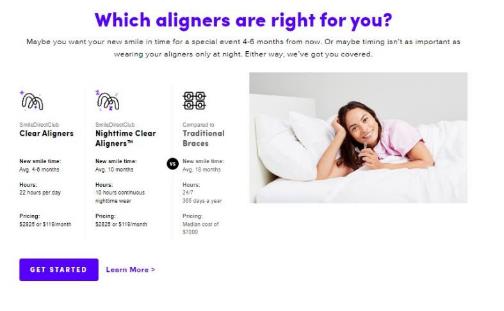
875 Invisalign claims that by the graphic showing the “versus” symbol between braces and the other SDC Aligner Treatments, SDC has compared the efficacy or clinical outcome of these three different options. Invisalign also contends, in its closing submissions in reply at [6], that “[the words] “new smile time” conveys to consumers they will end up with the same “new smile” irrespective of which treatment method they proceed with”.
876 This is so in circumstances where Invisalign claims that, to be a true alternative to braces, SDC has to market the SDC Aligner Treatment as capable of correcting the range of malocclusions that Invisalign and braces can correct.
877 An analysis of the above representation, in my view however, shows a comparison between SDC’s aligners, SDC’s Nighttime Aligners and Traditional Braces, with three elements that have been accentuated, which are:
(1) treatment time;
(2) hours worn per day; and
(3) price.
878 Invisalign’s Comparable Treatment Representation is foreclosed by the principles set out by the Full Court in Gillette Australia. As in Gillette Australia, SDC has advertised its product by reference to particular features (here: treatment time, hours worn and price). The above representation does not give rise to any implied representation about “like for like” (or equivalent) products or about other potential bases for comparison. Nothing in item (a) above gives rise to any express or implied misrepresentation about the “clinical outcomes” or “efficacy” of its products compared to braces or Invisalign aligners.
879 Like in Gillette Australia, if a consumer formed the conclusion, after viewing item (a) above, that SDC Aligner Treatment is of comparable efficacy to braces or Invisalign treatment for all or the majority of cases, it would be their own mistaken assumption, and not from anything SDC has represented in its promotional material.
880 While Invisalign submits that SDC “set[s] itself up as an alternative to Invisalign and braces” and that in doing so “SDC has to market the SDC Aligner Treatment as capable of correcting the range of malocclusions that Invisalign and braces can correct”, this submission is not supported by SDC’s promotional material which states that SDC aligners are designed for correction of mild to moderate teeth crowding and spacing. It is contrary to the principles in Gillette Australia to assume that because a comparison is made in respect of certain features of a product, that the comparison represents that the products are alike or comparable in all respects. SDC has made no representation to consumers that it provides treatment of the same efficacy that a consumer would receive from Invisalign Aligner Treatment or braces.
881 With respect to Invisalign’s submission that the words “new smile” would convey to a consumer that they will end up with the same smile irrespective of whether they chose braces or SDC Aligner Treatment, this places an exaggerated and fanciful emphasis on the ordinary use of the words and is plainly wrong.
882 There is nothing within the promotional material pleaded in column VI of Annexure C which would lead an ordinary and reasonable consumer to believe that SDC Aligner Treatment is of comparable efficacy to braces or otherwise impermissibly misrepresents the efficacy of its SDC Aligner Treatment in a way alleged by Invisalign under the Comparable Treatment Representations. For the reasons above this part of Invisalign’s claim must also fail.
883 Invisalign, by its Amended CS at [21(b)] alleges that, SDC has represented to consumers that SDC Aligner Treatment would:
(a) provide an orthodontic solution or alternatively, provide an orthodontic solution in respect of all orthodontic issues that are not severe, at a cost which is significantly less than that of equivalent treatments with metal braces and/or Invisalign (the Lower Cost Representation).
884 Invisalign contends that it is a necessary part of SDC’s marketing strategy that consumers consider SDC Aligner Treatment as an alternative, in terms of efficacy, to Invisalign and orthodontic treatment with braces and that SDC Aligner Treatment is as effective as in-person appointments with dentists or orthodontists.
885 In support of this claim, Invisalign alleges that the image below of the SDC AU Pricing Page is an example of a representation made by SDC comparing SDC Aligner Treatment to braces and making a misleading Lower Cost Representation. I should note that the below example which was tendered under JMW-4 as exhibit 73, from the SDC AU Pricing Page states “other brands”, where in fact this representation is pleaded as “than braces” under item (a) of column VII. For the purpose of my consideration I have taken the below representation to read “than braces” in place of “other brands”.

886 Invisalign also relies on the following advertisement published on Meta, in item (h) of column VI:
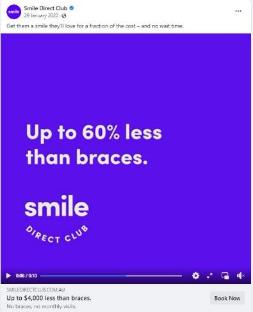
887 Invisalign’s contention that the Lower Cost Representation, is false, misleading or deceptive or likely to mislead or deceive is misplaced.
888 This alleged representation again falls foul of the principles in Gillette Australia. The only representation that is conveyed above in items (a) and (h) of column VII in Annexure C is that the relevant individual is able to access SDC Aligner Treatment at a cost that is up to 60% less than braces. It says nothing about equivalency of treatments, nor does it say anything about the comparative efficacy of SDC Aligner Treatment against that of braces.
889 The advertisement makes a representation as to price only. It says nothing about efficacy. Again, SDC has not represented to consumers that it provides treatment that is equivalent in terms of efficacy to that of Invisalign or braces and in accordance with the principles set out in Gillette Australia, SDC is not required to point out each and every feature of its aligner treatment that differs from treatment using Invisalign or braces.
890 Invisalign has failed to make out any of the grounds relevant to its substantive claim and as a result, its claim must be dismissed with costs.
OUTSTANDING ISSUES ON THE SUBSTANTIVE CLAIM
891 I note that Invisalign, in its promotional material referred to in Annexure C to these reasons, provided an additional column under VIII described as the “Specific to Price Comparison Representation”. I have ruled this material inadmissible because I find it is beyond the scope of the Amended CS and its Annexure A.
892 I will therefore not consider the promotional material under this alleged representation.
CONSIDERATION OF THE CROSS-CLAIM AGAINST INVISALIGN
893 By its cross-claim, SDC alleges that Invisalign made representations about SDC aligners, and alleged comparisons about the comfort, predictability and treatment time associated with Invisalign aligners, that were false, misleading or deceptive or likely to mislead or deceive in contravention of ss 18 and 29 of the ACL.
894 SDC’s cross-claim arises from representations alleged to have been made by Invisalign in the DIY article.
895 The DIY article was part of an advertising campaign conducted by Invisalign with support from the ASO.
896 SDC contends that, without mentioning SDC by name, Invisalign makes various statements in the DIY article which ordinary and reasonable consumers would understand to be referring to SDC and SDC Aligner Treatment. In that way, the DIY article made various representations about SDC Aligner Treatment which SDC alleges were false, misleading or deceptive.
897 SDC also alleges that Invisalign made representations in other promotional material, including on its website, through its social media posts and in a hard copy brochure. SDC alleges that each of these representations is false, misleading or deceptive or likely to mislead or deceive.
Representations alleged to have been made by Invisalign in the DIY article
898 SDC, by its cross-claim, alleges that Invisalign made two categories of representations which arise from the DIY article, and that such representations are false, misleading or deceptive.
899 The first representation was that:
(a) clear aligners such as SDC aligners that do not require in-person dental or orthodontic visits are equivalent to “do it yourself” dental treatment; and
(b) through its implicit reference to SDC as the “DIY” solution described in the article, the treatment by SDC aligners do not involve oversight by a dentist or orthodontist for the purpose of treatment with clear aligners,
(the DIY Representation).
900 The second representation was that:
(a) unlike clear aligner treatment that involves in-person dental or orthodontic visits, clear aligners such as SDC aligners that do not involve in-person dental or orthodontic visits are risky, harmful, dangerous and/or may cause severe or permanent damage, gum shrinkage, gum disease and bone loss;
(b) unlike clear aligner treatment that involves in-person dental or orthodontic visits, clear aligners such as SDC aligners that do not involve in-person dental or orthodontic visits may ultimately cost the consumer more than the advertised cost of treatment because the consumer may incur additional expenses in fixing the problems caused by the aligners; and
(c) consumers will suffer if they undertake treatment by clear aligners such as SDC aligners that do not involve in-person dental or orthodontic visits,
(the Harm Representation).
901 The text of the DIY article is set out below.
DIY teeth straightening kits – should you try this at home?
At-home “dentistry” is on the rise in Australia.
Pillar Mitchell
…
[Photo omitted]
This content was created in partnership with Invisalign Australia
The risks of at-home, DIY teeth straightening kits
While it sounds like something from a dystopian future to most, do-it-yourself (DIY) dentistry is on the rise. From teeth-whitening, at-home veneers and tooth-filing, to attempting to straighten crooked teeth, people are trying all kinds of things at home.
While it may seem appealing from a cost perspective - some DIY or at-home treatment kits appear to save you thousands of dollars - without a professional's expertise, many treatments may result in permanent damage.
Brisbane-based orthodontist and lnvisalign Provider Dr Marcus Tod of Ethos Orthodontics cautions against being tempted by the idea that you're saving money by doing treatments yourself. "Your smile is going to be with you for a long time, so you need to think of the long-term investment," he says.
The risks of at-home, DIY teeth straightening kits
Dr Tod says that at-home teeth straightening kits have been gaining popularity in Australia over the last couple of years. "The premise is you get a kit in the mail. You mix up the putty, make an impression of your teeth and send it back with a checklist of what you don't like about your teeth," he says.
Companies rely on consumers to take accurate moulds of their mouth to create a set of clear aligners - hoping that the moulds move their teeth in the desired direction.
Dr Tod says the practice can be harmful. "Moving teeth is a medical procedure. It's complex, and for people not to have a proper investigation of their teeth beforehand, that's concerning."
[Photo omitted.]
DIY teeth straightening may cause permanent damage
The potential damage can be severe, and in some cases, impossible to reverse. "When you're straightening teeth, you're moving teeth through the bone, which is surrounded by gums. You need to make sure the teeth are adequately supported by the bone."
"It might be appealing to some people to bring their teeth forward enough so they have fuller lips, but if you move your teeth out past the supporting bone, it can result in gum shrinkage, gum disease and bone loss."
If the process goes wrong, getting a professional to fix the new issues will cost much more than any upfront "saving" the consumer may perceive when comparing the cost of an at home kit against the cost of seeing their dentist or orthodontist.
"Maybe you've already spent $3,000 on the DIY solution. If there's damage, you might need a full treatment with an orthodontist and even an oral surgeon, and even then, you can't regenerate lost bone or tissue. The cost of that would far outweigh any of the savings had by the DIY treatment."
DIY dental treatments trending on TikTok
TikTok is full of dangerous DIY dental trends to try at home. Some recommend using nail files to flatten canine teeth that are "too pointy" or to smooth out chipped teeth or fillings. Others show videos of people using metal implements like screws to scrape plaque off their teeth.
These practices can wear away your tooth's protective layer of enamel, and cause damage to your gums. "Always ask yourself, 'does this seem too good to be true?"' Dr Tod says.
Professional whitening is best for severe stains
At-home teeth-whitening is common practice, and safer than some of the more significant treatments people might attempt at home. Most people have a tube of whitening toothpaste in their bathroom, which Dr Tod says is great for maintenance of teeth that aren't significantly discoloured or stained.
"There are some great products by respectable companies. You can get them at the chemist and they can be quite effective on teeth that aren't too discoloured or not too uneven with discoloration," he said.
"But I'd be wary of anything that overpromises. Whitening toothpaste can maintain a nice colour, but in situations where your teeth are darker or unevenly coloured, nothing beats professional whitening."
[Photo omitted]
What to ask before attempting a DIY procedure
Whether it's DIV veneers aimed at making front teeth look big, white and straight, or products that purport to help you move and straighten your teeth at home, it's important to ask yourself a few questions: Is this a reputable, well-known company, or a new player with little-to-no track record?
Have you invested in an in-person consultation with your dentist or orthodontist about whether the treatment is safe, and suited to you? Who will be responsible for applying or fitting the products you are being recommended? Who will manage your care throughout treatment? Does it all seem too good to be true?
Besides teeth-whitening for minor discolouration, Dr Tod says that dental procedures should always be performed by professionals. The cost savings up front may be tempting, but in the long run, you'll probably suffer.
"We live a long life, and your smile is going to be with you a long time. When you think about it that way, the outlay for getting a dental procedure done properly won't seem like that much. It really is a long-term investment," he says.
Invisalign wants to ensure Australians considering teeth straightening know the facts, what to ask and what they’re getting, so they created the Be Clear on the Facts.
Dr Marcus Tod is an Invisalign Provider and representative of Orthodontics Australia, the Australian Society of Orthodontists’ public advice channel. No payment was provided to Dr Marcus Tod for this article and the opinions expressed are his own.
Invisalign treatment is a series of clear plastic removal orthodontic aligners that gently move patients’ teeth.
An orthodontist or Invisalign trained dentist will be able to advise whether Invisalign treatment is right for you. You should always read and follow their directions for use. ©2021 Align Technology, Inc. All rights reserved.
902 SDC submits that in determining its cross-claim, it is important to understand the context in which the DIY article was commissioned, drafted, edited and published. Dr Tod’s evidence was that he received a request from Ms Gregory of Invisalign asking if he would be willing to speak to www.news.com.au regarding the “Be clear on the facts” campaign for an editorial piece. Dr Tod agreed to do so. SDC submits that because Dr Tod did not ask any questions or otherwise speak to Invisalign before agreeing to act as spokesperson, the inference I should draw is that Dr Tod was willing to assist Invisalign and the ASO in relation to the campaign. SDC submits that Dr Tod’s willingness was motivated by his antagonism towards SDC and his support for Invisalign.
903 Dr Tod’s evidence was that he spoke to the Chief Executive Officer of the ASO at the time, Ms Michelle Cutler, to inform her that he was going to speak on behalf of the ASO in relation to the campaign. Dr Tod is a committee member of the ASO. Dr Tod considered himself aligned with the ASO in relation to its view on SDC.
904 SDC submits that at the time, Dr Tod and the ASO held the view that SDC’s direct to consumer model was “by passing orthodontists” and that patients of SDC should receive an x-ray and in-person examination from a dentist or orthodontist (T597.44-599.36; T612.5-8; T606.39-44). SDC submits that Dr Tod was motivated to diminish the business of SDC.
905 Dr Tod impressed me as a forthright and truthful witness who made proper concessions during the course of cross-examination and I accepted his evidence. I specifically reject the submission by SDC that Dr Tod was motivated by his antagonism towards SDC and his support for Invisalign. There was nothing in the substance of the evidence that Dr Tod gave nor in the manner and demeanour in which he gave his evidence which would support making any finding that Dr Tod was motivated by his antagonism towards SDC in the manner in which he gave his evidence.
906 I also reject SDC’s submission that Dr Tod was motivated to diminish the business of SDC. This was put directly to Dr Tod in cross-examination and he denied it: T612.41-42. I accept Dr Tod’s denial, as he was in my view, a truthful witness.
SDC’s contention that the “representations” were made by Invisalign
907 SDC submits that the statements contained in the DIY article were made by Invisalign or on behalf of Invisalign. I accept SDC’s submission for the reasons that follow.
908 First, Invisalign has admitted, at [8] of its response to the cross-claim, that it did “caused” the DIY article to be published, in the manner put forward by SDC at [8] of its cross-claim: see also Invisalign’s outline of closing submissions on cross-claim at [17].
909 Second, the opening words of the article (reproduced above) state clearly in prominent and bold text, “This content was created in partnership with Invisalign Australia”. The DIY article contains quotes from a “Brisbane-based orthodontists and Invisalign provider”. The DIY article includes a hyperlink to the Invisalign Australia website’s “Be clear on the facts” campaign published by Invisalign, on a webpage about questions for consumers to ask about teeth straightening.
910 Whether it would appear to ordinary and reasonable members of the relevant section of the public that any representation conveyed by the DIY article, was in fact, made by Invisalign, is a matter for the Court to determine. Where it appears to the relevant section of the public that Invisalign has adopted the representations in the DIY article, then the mere fact that it is not the source of the misrepresentation is not sufficient to enable Invisalign to avoid liability for a contravention under ss 18 and 29 of the ACL: Google Inc v Australian Competition and Consumer Commission [2013] HCA 1; 249 CLR 435 at [11] and [15] (French CJ, Crennan and Kiefel JJ), citing Global Sportsman Pty Ltd v Mirror Newspapers Pty Ltd [1984] FCA 167; 2 FCR 82.
911 I find that the ordinary and reasonable consumer would regard Invisalign as having adopted the statements in the DIY article by expressly stating prominently at the top that the article was “created in partnership” with Invisalign. That adoption is further fortified by the other references to Invisalign throughout the DIY article. I find that ordinary and reasonable consumers would attribute the statements in the DIY article as representations being made by Invisalign.
912 Third, with Invisalign’s agreement and consent, Dr Tod acted as “spokesperson” for Invisalign for the purposes of the DIY article: exhibit 60. The DIY article was published by News Corporation Australia Pty Ltd with the consent and agreement of Invisalign: exhibit 61.
913 The evidence establishes that Invisalign in fact reviewed, amended and approved the content of the DIY article, which went before its review committee for final approval: exhibit 61. Invisalign amended the statements attributed to Dr Tod (T605.5-40).
914 For the above reasons, I find that the statements attributed to Dr Tod in the DIY article were made with the consent and agreement of employees of Invisalign. Invisalign, in these circumstances, was liable for any contravention of ss 18 and 29 of the ACL in the DIY article.
Implied reference to SDC not made out
915 SDC submits that although the DIY article does not refer to SDC by name, when viewed from the perspective of the ordinary and reasonable consumer, the article by implication refers to SDC and SDC Aligner Treatment. To make good this submission, SDC relies upon the following matters.
916 First, the DIY article refers to an at-home impression kit which is identical to the process followed by SDC. The article states:
The premise is you get a kit in the mail. You mix up the putty, make an impression of your teeth and send it back with a checklist of what you don’t like about your teeth.
917 SDC submits that this description reflects SDC’s practice which includes the following:
(a) a consumer may order an impression kit from SDC via the SDC website, which includes putty and impression trays which enable a consumer to take impressions of their teeth at home;
(b) the putty contained in the impression kit must be mixed together prior to use. The consumer is directed on how to mix the putty and place it into the impression tray in the guide that accompanies the impression kit; and
(c) the consumer then sends the impression kit back to SDC and also provides their “chief complaint” (being the consumer’s primary concern about their teeth) via the SDC Portal.
918 Second, SDC relies upon the reference to the price of the “DIY” solutions referred to in the article which it submits reflects SDC’s pricing. The DIY article refers to consumer spending $3,000 on the DIY solution. That amount is approximate to SDC’s pricing.
919 Third, SDC relies upon the fact that the DIY article refers to the relatively recent advent of the “DIY” teeth straightening companies. The DIY article states:
Is this a reputable, well-known company, or a new player with little to no track record?
920 SDC submits that the above three factors would lead the ordinary and reasonable consumer to understand that the descriptions in the DIY article are referring to SDC and its aligner treatment.
921 For the reasons that follow, I reject this submission.
922 First, the phrase “do it yourself dentistry” in the DIY article is not sufficient to convey a reference to SDC. The evidence establishes that there are a number of competing aligner treatment companies who provide “Do It Yourself Dentistry”. Those competing companies include Ez Smile, Byte, Wonder Smile and Bite Soft. The ordinary and reasonable consumer that is in the market for teeth straightening treatment would be aware of the existence of these other companies.
923 Second, the central question is whether the impugned conduct (for s 18) or the alleged representations (for s 29) viewed as a whole and in context “have a sufficient tendency to lead a person exposed to the conduct into error”: Employsure at [92] (Rares, Murphy and Abraham JJ).
924 In addition, the Full Court in Employsure at [93] found that where the impugned conduct or representation is directed to the public generally:
… the Court must consider the likely characteristics of the person who comprise the relevant class to whom the conduct or representation is directed, and consider the likely effect of the conduct on hypothetical ordinary or reasonable members of the class, disregarding reactions that might be regarded as extreme or fanciful.
925 I reject SDC’s submission that the reference in the DIY article to an at-home impression kit identifies SDC and its aligner treatment to the ordinary and reasonable consumer. That is because, at-home impression kits are not exclusively or solely used by SDC. The evidence is that other competing aligner treatment companies use at-home impression kits similar to that used by SDC. The evidence is that SDC was one of a number of companies promoting and selling over the internet treatment with clear aligners to patients in Australia. At the time of publication of the DIY article, another company, EZ Smile Pty Ltd, was supplying clear aligners to consumers without the requirement for face to face consultations with a dentist or orthodontist. There is no evidence which would support the conclusion that at-home impression kits were distinctive only of SDC such that “an ordinary and reasonable consumer” when reading the DIY article would understand it to be referring to SDC.
926 Third, I do not accept that the reference to price in the DIY article of a consumer spending $3,000 gives rise to an implied reference to SDC. That is because the evidence is that the advertised price of other aligner treatments is EZ Smile at $2,149; Byte at $2,749; Wondersmile at $2,690 and Bite Soft at $2,229. There is no reasonable basis for inferring that the reference to $3,000 was intended by Dr Tod, Invisalign or the journalist, Ms Mitchell, to be a reference to SDC. The evidence was that Invisalign’s intention was to avoid “targeting” SDC and that was why it edited the draft DIY article accordingly. Invisalign also made other edits to the draft article to “pare back” any suggestion that all instances of DIY dentistry “cause danger/harm to all patients”: exhibit 63.
927 Fourth, the unchallenged evidence of Dr Tod was that during his interview with the News Corporation journalist, Ms Mitchell, neither of them referred to SDC. I accept that evidence.
928 Fifth, I do not accept SDC’s submission that a number of statements identified at [28] of SDC’s closing submissions on its cross-claim and referred to in an earlier draft of the DIY article refer exclusively to SDC. That is because the evidence the shows that:
(a) other new market entrants, including Byte, also originate in the United States;
(b) other suppliers, including EZ Smile and Wondersmile promote scanning centres; and
(c) other suppliers, including Wondersmile, were advertising the cost of treatment as being “up to 60% less” and some such as EZ Smile for “up to 70% less than traditional braces”.
929 In any event, the statements set out at [28] of SDC’s closing submissions on its cross-claim do not in fact appear in the published version of the DIY article but appear in an earlier draft of the article. As such, the statements in the earlier draft which was not published are not relevant to whether the DIY article would be understood by an ordinary and reasonable consumer in the market for aligner treatment to refer exclusively to SDC.
930 There is no basis on the evidence to find that the statements in the DIY article are a reference to SDC and its aligner treatment rather than some other aligner treatment provider in the market.
931 I find that SDC has failed to prove that the DIY Representation and the Harm Representation in the DIY article are referrable to SDC. It follows that SDC cannot succeed on this part of its cross-claim.
Alleged Treatment Time Representation
932 SDC alleges that the Invisalign website contains the statement, under the heading “Treatment Process – Invisalign vs Braces”:
When comparing Braces vs Invisalign aligners, it’s clear that the Invisalign system could deliver more benefits, from aesthetics and comfort through to oral hygiene and treatment time.2
(Braces Comparison Statement)
933 The Braces Comparison Statement is accompanied by additional text in footnote 2 (cited after the words “treatment time”) which states:
2. Treatment time with Invisalign clear aligners completed finished 5 months faster sooner [sic] on average than treatment with fixed appliances braces.
- Gu, J et al. Evaluation of Invisalign treatment effectiveness and efficiency compared with conventional fixed appliances using the Peer Assessment Rating index, Am J Orthod Dentofacial Orthop February 2017; 151:259-66.
- Buschang, P et al. Comparative time efficiency of aligner therapy and conventional edgewise braces. Angle Orthodontist. Vol 84, No 3, 2014
934 SDC contends that the Braces Comparison Statement, when read in the context of the accompanying reference in footnote 2 to the selected journal articles, conveys the representation that teeth alignment with Invisalign aligners is faster than teeth alignment using traditional metal braces (Alleged Treatment Time Representation).
935 SDC submits that the Alleged Treatment Time Representation arises from the express comparison with braces in the heading on the Invisalign Website and the reference to the “benefit” of treatment time in the body of the statement, in the context of the additional text in footnote 2 that refers to Invisalign aligners completing treatment five months sooner than treatment with braces.
936 In my opinion, the Braces Comparison Statement conveys information about the potential benefits from Invisalign treatment, including aesthetics, comfort, oral hygiene and treatment time. The additional text which appears as footnote 2 to the Braces Comparison Statement is to the effect that the results of the Gu study and the Buschang study show that, for the cohorts in those two studies, treatment was completed an average of five months faster with Invisalign aligners than with braces.
937 I am of the opinion that the text of the Braces Comparison Statement and the additional text of footnote 2, when read in context, do not contain any statement to the effect that, in all cases, treatment with Invisalign aligners is faster than treatment with braces.
938 I accept Invisalign’s submission that, at its highest, the representation conveyed by the combination of the Braces Comparison Statement and the additional text of footnote 2 is only that:
(a) treatment with Invisalign aligners could be faster than treatment with braces;
(b) the results of the two studies appearing in footnote 2 support the fact that treatment with Invisalign aligners could be faster, because the results of these two studies show that, on average, treatment with Invisalign aligners was completed five months faster than treatment with braces; and
(c) potential patients should choose the treatment process that will give them the best results taking into account their own circumstances.
939 The Braces Comparison Statement and the text of footnote 2 cannot be viewed in isolation from the “Treatment process – Invisalign vs Braces” webpage. Such material must be determined objectively and assessed within the entire context of the medium through which consumers engage with that material: TPG2020 at [25]; Luxottica at [49] per Griffiths J. When having regard to this material, in my view, it is clear that text which appears on that webpage has a material effect on the impression that the webpage leaves on a consumer viewing that webpage. In this regard, the webpage relevantly contains, in addition to the Braces Comparison Statement and the text of footnote 2, the following statements:
(a) “Start by seeking an expert opinion”;
“The decision of Braces vs Invisalign Treatment rests on you and your doctor reviewing and discussing your:
• age and oral development
• individual case and the treatment needed for long-term oral health
• aesthetic preferences
• lifestyle and day to day routines
• cost/budget”
940 The above statements would, in my opinion, convey to the ordinary and reasonable consumer in the market for teeth straightening that the decision to undergo treatment with Invisalign aligners or braces is a decision which the consumer makes in consultation with an expert, and the selection of the type of treatment (Invisalign aligners or braces) is one which depends on the consumer’s individual circumstances.
941 When viewing the “Treatment process – Invisalign vs Braces” webpage as a whole, I am of the opinion that the representation conveyed to the ordinary and reasonable consumer in the market for teeth straightening by the Braces Comparison Statement and footnote 2 is not that, in all circumstances, treatment with Invisalign aligners will be faster than braces, but rather that, in some circumstances, for some individuals, treatment could be faster (Conveyed Treatment Time Representation).
942 I am also not satisfied on the evidence that SDC has established the falsity of the Conveyed Treatment Time Representation and that treatment with Invisalign aligners is not faster than braces in some circumstances. The experts, Drs Chan, Mahony, Vlaskalic and Lai, were asked to express their opinion in respect to question 42 in the Joint Expert Report. This question was: “In your experience, is treatment with Invisalign branded clear aligners faster than treatment with traditional metal braces?”. The experts subsequently gave evidence on this question in the expert conclave. Professor Dreyer also gave evidence, by way of the first Dreyer Affidavit, concerning the treatment time for patients using clear aligners, including Invisalign, and fixed appliances, in the context of giving evidence on his review of the four articles referred to above. Professor Dreyer was separately cross-examined on his evidence.
943 The experts’ evidence varied greatly.
944 In the Joint Expert Report, Dr Mahony stated unequivocally that Invisalign was not faster than treatment with traditional braces. In the expert conclave, Dr Mahony similarly stated that his professional advice to all of his patients is that fixed braces will be more efficient or work in a shorter timeframe than Invisalign aligners. Dr Mahony explained in his affidavit that the reasons why treatment using braces is always, in his opinion, faster than treatment with Invisalign aligners, includes: compliance issues with patients wearing Invisalign aligners that do not occur with braces (by virtue of the fact that braces cannot be removed by the patient), and that it is possible to affect a greater range of movement with braces than with Invisalign aligners.
945 In the Joint Expert Report, Dr Chan opined that in some cases, such as open bite and deep bite cases, Invisalign can provide a faster treatment than traditional metal braces. However, in most pre-molar extraction cases, traditional braces will be more efficient.
946 Similarly, in Dr Chan’s second affidavit, sworn 5 August 2022, Dr Chan stated that, unless the patient did not wear clear aligners as directed, it was not his experience that the treatment time for clear aligners was longer than treatment with conventional fixed braces. He said that, in a number of cases, treatment duration can in fact be shorter with the use of clear aligners, such as in the case of patients with a deep bite.
947 In Dr Chan’s affidavit, sworn 6 May 2022, he stated that the choice of whether to use braces or clear aligners was based on a number of factors. Those factors included patient compliance (including whether the patient was able to wear clear aligners for a minimum of 20 to 22 hours per day) and logistical considerations (including whether the patient was able to return to the orthodontist or dentist every four to six weeks for adjustments to their braces, or every eight to ten weeks for reviews when using clear aligners).
948 In the expert conclave, Dr Chan was asked to comment on Dr Mahony’s evidence that braces are quicker than clear aligner treatment. Dr Chan said that, in his experience, it is case dependent. Dr Chan provided a number of factors which went into this consideration, such as braces requiring more orthodontist visits (every four to six weeks) whereas, with clear aligners, that consultation can be stretched out to about eight weeks or sometimes ten weeks. Dr Chan explained that not all patients are able to attend for a consultation every four to six weeks. Dr Chan’s evidence is that, given this, the decision of whether to recommend fixed applications or clear aligners is not just a clinical diagnosis, it is also a holistic approach having regard to what is more suitable for each patient.
949 In the Joint Expert Report, Dr Vlaskalic opined that physiology and intensity, duration and frequency of force dictate the velocity of tooth movement not the appliance per se. Dr Vlaskalic stated that the major difference between braces and Invisalign aligners is the treatment process. In the case of braces, once a diagnosis and treatment plan are performed, braces are able to be applied. In contrast, Invisalign aligners need to be programmed, manufactured and delivered. In the case of braces, if continuous arch mechanics are utilised, which Dr Vlaskalic said was the most common, the orthodontist may need to undo certain unwanted effects and this may take time. Dr Vlaskalic concluded with the statement that, largely, the treatment times are equivalent.
950 Dr Vlaskalic, told the Court during the expert conclave, that peer reviewed studies have shown that treatment duration for clear aligners and braces is very similar, but those studies really only considered mild to moderate cases of malocclusion. Dr Vlaskalic opined that the treatment duration can also be dependent upon the patient’s individual circumstances, their level of compliance in attending their appointments, the practitioner’s goals for the treatment and the practitioner’s experience with the software and system for programming the mechanics into the aligners. Dr Vlaskalic further noted that the frequency with which clinicians asked their patients to wear aligners also made a sizable difference in terms of treatment duration.
951 In the first Dreyer Affidavit, Professor Dreyer opined that treatment time would vary depending on individual factors. Professor Dreyer stated that treatment duration with braces or clear aligners depended, in part, on the frequency of adjustments (of fixed appliances) or changes (of aligners) that were required. Professor Dreyer stated that treatment duration, with braces, is dependent on the frequency of “adjustments” performed when a patient attends an orthodontist’s clinic to have adjustments made to their fixed appliance. Professor Dreyer’s evidence was also that the same can be said in relation to the frequency of changes of all clear aligners, including Invisalign aligners. Professor Dreyer stated that, the more frequently an aligner or fixed appliance was changed, the greater the reduction in the duration of treatment.
952 In the Joint Expert Report, Dr Lai stated that he did not have sufficient experience with braces to be able to compare Invisalign aligners with braces.
953 I have considered the expert evidence in the opinions expressed in the Joint Expert Report in answer to question 42 and in the evidence given in the expert conclave by Drs Chan, Mahony and Vlaskalic. I prefer the expert opinions of Drs Chan and Vlaskalic to that of Dr Mahony. On the topic of treatment time, I found the evidence of Drs Chan and Vlaskalic to be more comprehensive than Dr Mahony’s evidence in identifying factors which impact upon treatment time using traditional metal braces as opposed to Invisalign aligners. Drs Chan and Vlaskalic’s evidence establishes that those factors include whether there is a deep bite or open bite case, the patient’s ability to attend consultations with orthodontists to have adjustments made to their fixed appliance, patient compliance and the practitioner’s goals for the treatment.
954 I also accept Professor Dreyer’s evidence that treatment time will vary depending on individual factors, which includes the frequency of adjustments made to fixed appliances and the frequency of changes to aligners. The evidence of Drs Chan and Vlaskalic is consistent with Professor Dreyer’s evidence. The evidence of Drs Chan and Vlaskalic, and Professor Dreyer establishes that Invisalign aligners could be faster than treatment with braces for some patients.
955 SDC also made submissions with respect to the expert evidence of Professor Dreyer, who was shown and commented on the Gu Article and the Buschang Article referred to in footnote 2 of the additional text accompanying the Braces Comparison Statement.
956 Professor Dreyer was also shown and cross-examined on the Lin Article which was tendered in evidence and marked exhibit 66. Professor Dreyer accepted that the Lin Article concluded that patients that were treated with Invisalign aligners required 4.8 months’ longer treatment time than patients with braces. The substance of SDC’s submission was that, due to deficiencies in the studies that were the subject of the Gu Article and Buschang Article, those articles should be given no probative weight on the question of whether or not Invisalign treats orthodontic conditions faster than braces. Instead, the Court should accept the findings of the Lin Article, which SDC characterised as containing more rigorous research findings.
957 The Buschang Article compared the time efficiency of Invisalign aligners compared to conventional braces. The research is now eight years old and involved a comparison with a now superseded version of Invisalign aligners, which is no longer supplied to consumers. The study involved a retrospective analysis of patients who had completed treatment.
958 The Gu Article is five years old and assesses patients who underwent orthodontic treatment between 2009 and 2014. Like the Buschang Article, this study compared treatment time with previous versions of Invisalign aligners against treatment time with braces. The study found that, compared to Invisalign aligners, conventional braces required 5.7 months’ longer treatment duration.
959 Professor Dreyer was not asked to advise the Court what other articles were available that might bear upon the findings in the articles shown to him and whether there was any other research which contradicts the Gu Article and the Buschang Article. Professor Dreyer accepted, in cross-examination, that there was a “great deal” of published articles on the time required to conduct an orthodontic treatment program. Professor Dreyer also explained that the two articles which he was asked to opine on was only a small selection of the available academic literature on this topic. In the course of providing his evidence, Professor Dreyer did not conduct an independent literature review or meta-analysis of the research available in relation to the time efficacy of aligners.
960 Professor Dreyer’s evidence referring to the Buschang Article and the Gu Article was challenged by Dr Ackerman. Dr Ackerman gave evidence that the findings in the Buschang Article were highly biased and the conclusions could not be relied upon. Dr Ackerman stated that the study in the Buschang Article involved a retrospective analysis of patients who had completed treatment. Dr Ackerman gave oral evidence that this type of research was lower on the evidence pyramid in terms of the persuasiveness and significance of the evidence. Dr Ackerman gave evidence that the results of the Buschang Article were likely to have been influenced by treatment planning bias, in circumstances where the criteria for treatment with braces or Invisalign aligners was not exposed or explained in the research. Dr Ackerman also stated that the Buschang Article suffered from further deficiencies. In Dr Ackerman’s view, these deficiencies were that the Buschang study:
(a) had no control group;
(b) there was no “blinding” of the clinician; and
(c) there was no randomisation of the patients or their inclusion in the braces or clear aligners group.
961 Dr Ackerman also gave evidence that the results of the study in the Gu Article were subject to the following limitations:
(a) multiple braces systems (which were not disclosed) were used;
(b) multiple clinicians treated patients in both groups of the study; and
(c) the study did not state the criteria for deciding when the treatment was complete.
962 In the second Dreyer Affidavit, Professor Dreyer accepted that the Buschang Article and the Gu Article did not employ a perfect academic methodology. However, Professor Dreyer stated that similar deficiencies can be found in all clinical treatment studies. Professor Dreyer stated that while it is ideal to have patients be randomised into treatment groups in a clinical trial setting, to do so in circumstances where two different medical devices are used to correct malocclusion can be difficult and potentially unethical.
963 Professor Dreyer’s evidence was that it was also difficult to implement a “control group” in a comparative clinical trial of the nature in which the Buschang study was conducted. This is also the case, in Professor Dreyer’s view, for implementing “blinding” in order to reduce any bias which might arise from the researcher or patient knowing the treatment method allocated to them.
964 Professor Dreyer gave further evidence that, where it is not possible to implement randomisation, any possible bias that may arise towards one method of treatment over the other may be reduced if patients are selected with similar clinical features. Often this is reflected in a study’s inclusion criteria. Professor Dreyer’ evidence was that by limiting the selection criteria to records of patients with very similar pre-treatment conditions, the Buschang study, as much as possible, compared patients like for like that fit within the inclusion criteria. This made them candidates for either braces or clear aligners, subject to other considerations such as compliance. As a result, Professor Dreyer did not consider the absence of randomisation to be a flaw of the Buschang Article.
965 Professor Dreyer reviewed the Lin Article and accepted in cross-examination that:
(a) the purpose of the study was to measure the treatment time of patients treated with traditional braces compared to patients treated with the latest generation, as at 2022, of Invisalign aligners;
(b) one of the inclusion criteria of patients in the study was patients with mandibular crowding of 4mm or less;
(c) pre-treatment occlusion among patients assigned to the braces treatment group was more complex than that of patients assigned to the Invisalign Aligner Treatment group. The difference in complexity was statistically significant;
(d) patients treated with Invisalign aligners required 4.8 months’ longer treatment time than patients treated with braces (despite the fact that the patients treated with braces had more complete occlusion to being with); and
(e) one of the authors of this study (Dr Peter Buschang) was the lead author of the 2014 Buschang Article.
966 The heading of the Lin Article described it as using a “randomized controlled trial” method. Professor Dreyer accepted, in cross-examination, that a randomised control trial reduces the risk of bias on the part of the researchers, including treatment planning bias. When asked whether Professor Dreyer accepted that the Lin Article involved a “randomised control” trial, he explained that it was a randomised trial but only to the extent that the participants in the study were selected then randomised. More particularly, Professor Dreyer’s evidence was that the patients were selected because of particular characteristics associated with the position of their teeth, and then randomly assigned prior to treatment to either the braces group or the Invisalign aligner group for treatment. Professor Dreyer stated that, in the Buschang Article, Gu Article and Lin Article, the patients had been selected on basically the same characteristics. Professor Dreyer also accepted that the Lin Article was a prospective study as opposed to a retrospective study.
967 For the reasons given above, I found that Dr Ackerman was not a reliable witness and was not independent of SDC. As a consequence, Dr Ackerman’s evidence is of no probative value.
968 I accepted the expert evidence given by Professor Dreyer and, in particular, his evidence that deficiencies may be found in all clinical treatment studies.
969 For this reason, I place greater weight on the expert evidence given by Drs Chan and Vlaskalic in the Joint Expert Report and the evidence which they gave in the expert conclave, which I have referred to above.
970 I place little weight on the Buschang Article and the Gu Article because of the deficiencies in those articles identified by Professor Dreyer. However, I reject SDC’s submission that the Buschang Article and the Gu Article should be given no probative weight on the question of whether or not Invisalign treats orthodontic conditions faster than braces. The only evidence challenging the reliability of the Buschang Article and Gu Article was provided by Dr Ackerman, whose evidence I have not accepted. The cross-examination of Professor Dreyer did not establish that the deficiencies in the Buschang Article and the Gu Article warranted a conclusion that they should be given no probative value.
971 As to the Lin Article, I accept Professor Dreyer’s evidence that the study in the article was not an entirely “randomised” controlled trial, as patients were selected because of particular characteristics associated with the position of their teeth. The Lin Article therefore has its own deficiencies. Moreover, the conclusions in the Lin Article – that the patients in the study treated with braces completed treatment 4.8 months earlier than those treated with Invisalign aligners – does not detract from a conclusion that treatment with Invisalign aligners is faster than braces in some circumstances. I am therefore not satisfied that the Lin Article establishes the falsity of the Conveyed Treatment Time Representation.
972 I am not satisfied, on the evidence, that SDC has established the falsity of the Conveyed Treatment Time Representation and that treatment time with Invisalign aligners is not faster than braces in some circumstances.
Organic Content Representation
973 SDC alleges that during the period from July 2020 to June 2021, Invisalign published testimonials and accompanying images of social media influencers on its website. These influencer testimonials were the basis for SDC’s claim in respect of the Organic Content Representation (Promotional Testimonials). SDC claims that Invisalign misled consumers by representing that this content was not sponsored content.
974 The Promotional Testimonials on the Invisalign Website are not accompanied by any sponsorship disclosure, such that consumers would be aware that these testimonials were paid endorsements. As such, SDC contends that the Invisalign Website does not inform consumers that the content is sponsored content and that Invisalign paid the influencer to promote the Invisalign brand.
975 SDC relies upon Invisalign’s Instagram page which has the same Promotional Testimonials but which are accompanied by hashtags including “#paidpartnership”, “#brandambassador” “sp” and “#spon”. SDC alleges that hashtags such as these inform consumers that it is in fact sponsored content, and that the influencers have been paid to promote the Invisalign brand. Invisalign’s Instagram page and the relevant posts which contain the hashtags are only visible to consumers who have an Instagram account and are logged into their account.
976 SDC relies upon the evidence of Ms Rivera, Invisalign Australia’s Associate Marketing Director, that it is customary for social media posts which contain paid content to be accompanied by a sponsorship disclaimer which puts the viewer on notice that such content is, in effect, a paid advertisement. That knowledge, SDC submits, would be attributable to the ordinary and reasonable consumer. In this context, SDC submits that by publishing the Promotional Testimonials on the Invisalign Website without disclosing the nature of the sponsorship, Invisalign has impliedly misrepresented to consumers that the Promotional Testimonials were organic rather than sponsored content.
977 SDC has led no evidence to support the contention that an ordinary or reasonable consumer would be misled by the publication of the Promotional Testimonials.
978 I accept Ms Rivera’s evidence that it is Invisalign’s usual practice to communicate to consumers when a person has been compensated for the use of their photograph or their testimonial on social media. Ms Rivera explained that this is because social media users are exposed to a feed of posts from a variety of sources: friends, family, accounts they follow (celebrities and corporate entities) as well as advertisements and sponsored content.
979 Ms Rivera’s evidence was that it was not customary for the same approach to be taken on Invisalign’s own company website. The basis for the difference is that the company’s website is an environment controlled by Invisalign. I accept that the ordinary and reasonable consumer visiting Invisalign’s website does not need to be informed that they are being exposed to information and promotional content about Invisalign and its products as that is obvious from the platform they are on. I also accept that the ordinary, reasonable consumer in accessing Invisalign’s website would expect that the promotional advertisements and testimonials would be paid for and sponsored by Invisalign.
980 I find that the Organic Content Representation is not made out on the evidence and this part of SDC’s cross-claim must fail.
981 SDC relies upon two Facebook posts from Invisalign Australia’s Facebook page, which were annexed to the Affidavit of Mr Bodulovic, which was marked exhibit 82.
982 The first Facebook post took place on18 May 2019. The post stated “Invisalign aligners are made with our flexible proprietary Smart Track material, which makes them comfortable to wear, insert and remove, unlike other teeth straightening solutions” (Comfort Comparison Statement).
983 The 8 May 2019 Facebook post relied upon by SDC AU has reproduced below:

984 The first Facebook post took place on 4 March 2020. The post stated “With the world’s most advanced clear aligner system, you can straighten your teeth the most comfortable and convenient way” (Most Advanced Aligner Statement).
985 The 4 March 2020 Facebook post relied upon by SDC AU has reproduced below:
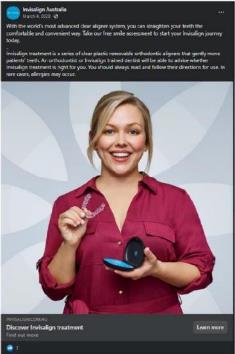
986 SDC contends that both statements represent to an ordinary and reasonable consumer that Invisalign aligners are more comfortable than all other teeth straightening options including other clear aligners in the Australian market, and/or that clear aligners other than Invisalign aligners are not comfortable to wear, insert or remove (Comfort Representations).
987 SDC contends that the Comfort Representations are conveyed in the Comfort Comparison Statement by reason of the reference to comfort and the juxtaposition with “other teeth straightening solutions”, which is unqualified and sufficiently broad to draw in all other teeth straightening options, including other brands of clear aligners.
988 SDC contends that the Comfort Representations are conveyed in the Most Advanced Aligner Statement by the statement of comparison to other clear aligners (“the world’s most advanced clear aligner system”), which is then used as a platform for the statement that Invisalign aligners are “the most comfortable”, being more comfortable than other clear aligners.
989 The 18 May 2019 Facebook post appeared with an electronic file (a GIF) which displayed a moving image on a loop which showed a woman removing Invisalign aligners from her Invisalign case and provided a hyperlink to the Invisalign Website with text “Find out more about Invisalign treatment” displayed. A screenshot of this GIF is provided below.

990 Contrary to SDC’s submission, I am of the opinion that this Facebook post does not convey that Invisalign aligners are more comfortable than all other teeth straightening options, including other clear aligners. I am also of the view that it does not convey that clear aligners other than Invisalign aligners are not comfortable to wear, insert or remove.
991 In my view, the only comparison that is made is based on an undisputed distinguishing feature between Invisalign aligners and fixed appliances (such as braces) namely, the capacity for a patient to insert and remove the clear aligners. There is, in my opinion, no comparison between Invisalign aligners and all other aligners available to Australian consumers, given they too are to be inserted and removed and are not “fixed”.
992 I am not satisfied that the 18 May 2019 Facebook post makes any comparison to other brands of clear aligners. The statement in the post is, in my view, ambiguous when it refers to “unlike other teeth straightening solutions”.
993 The expert evidence established that fixed appliances such as braces are more aggravating to the soft tissues of the mouth and cannot be removed without a dentist’s assistance.
994 Drs Chan and Vlaskalic expressed the opinion that Invisalign branded clear aligners are more comfortable than fixed appliances: Joint Expert Report, question 43. Dr Vlaskalic noted at question 43 in the Joint Expert Report, that “…literature supports the finding that Invisalign aligners are more comfortable than fixed appliances at the initiation of treatment…”.
995 Drs Mahony and Lai did not disagree with the proposition that clear aligners were more comfortable than fixed appliances: Joint Expert Report, question 43.
996 To the extent that the Comfort Representations compare Invisalign aligners with fixed appliances such as braces, the expert evidence establishes that Invisalign aligners are more comfortable than fixed appliances and as such the Comfort Representations are not false, misleading or deceptive.
997 SDC’s submissions with respect to the Most Advanced Aligner Statement from the 4 March 2020 Facebook post explicitly uses the words “the most comfortable …”. However, as can be seen in the image below, the word “most” does not appear in the context which is submitted by SDC. This post is shown below.
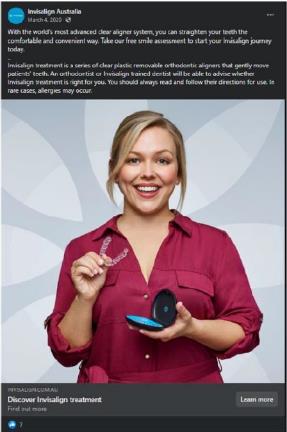
998 As can be seen above, no express comparison of comfort is made between Invisalign aligners and SDC aligners or other brands of aligners in the 4 March 2020 Facebook post.
999 I am not satisfied that the Comfort Representations arise from the 4 March 2020 Facebook post.
1000 I accept Invisalign’s submission that, at its highest, the 4 March 2020 Facebook post conveys that:
(a) the Invisalign system is the most advanced clear aligner system (a representation which SDC does not take issue with); and
(b) treatment with the Invisalign system is a comfortable and convenient way to straighten your teeth.
1001 Insofar as SDC relies upon the Most Advanced Aligner Statement in the 4 March 2020 Facebook post, I am not satisfied that the statement conveys to the ordinary and reasonable consumer the alleged Comfort Representations.
1002 The “Predictability Representation” is alleged by SDC to arise from a brochure entitled “Get ready for something great. Start with your smile” which was first published in 2017 and was last published in July 2019.
1003 On page 1 of the brochure, there is a series of bullet points set out under the heading “The advantages of Invisalign treatment”. The fourth bullet point states:
Get straighter teeth more comfortably and predictably thanks to innovative SmartForce and SmartTrack® technologies in Invisalign Aligners.
1004 SDC alleges that this statement conveys a representation that Invisalign aligners straighten teeth more predictably than traditional metal braces (Predictability Representation).
1005 I do not accept that the Predictability Representation is conveyed by the above text either alone or in the context of the brochure as a whole. There is no express or implied statement as to the predictability of the Invisalign aligner system as compared with braces. Such an imputation does not arise because another bullet point on the page refers to metal braces in the context of a statement about the suitability of Invisalign aligners for persons with an active lifestyle.
1006 The context of the brochure as a whole supports this interpretation. Pages 1-2 of the brochure predominantly feature the following description of the Invisalign system in response to the question (set out as a heading) “What is Invisalign?”:
The Invisalign system is a virtually invisible treatment that uses an innovative approach to gently and yet effectively straighten your teeth. Through a series of customer-made, removable aligners made with unique SmartForce® technology, the Invisalign system gradually and predictably moves your teeth to the desired position.
(Emphasis added)
1007 The concept of predictability is further addressed in the second bullet point under the heading “How does the Invisalign system work?” which describes the use of Invisalign’s technology to create a customised treatment plan for each patient. This, in my view, is the context in which “predictably” is used in the brochure.
1008 I am not satisfied on the evidence that the statement in the brochure would convey to the ordinary and reasonable consumer that Invisalign aligners straighten teeth more predictably than traditional braces.
1009 For the reasons set out above, I find that Invisalign’s claim against SDC must fail. Costs should follow the event.
1010 I also find that SDC’s cross-claim against Invisalign must fail. Costs should also follow that event.
1011 I make orders accordingly.
I certify that the preceding one thousand and eleven (1011) numbered paragraph is a true copy of the Reasons for Judgment of the Honourable Justice Anderson. |
Associate:
Dated: 5 May 2023
ANNEXURE A
LIST OF AFFIDAVITS TENDERED IN EVIDENCE
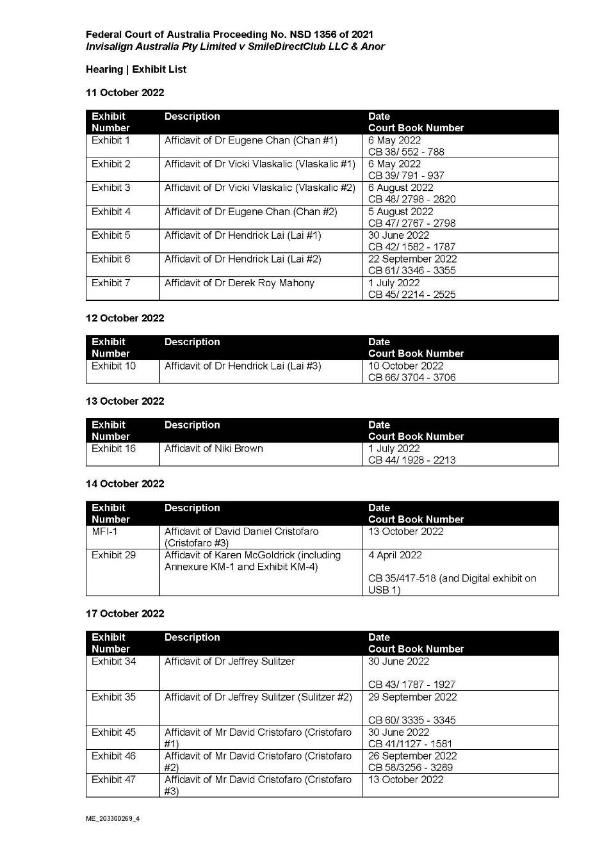
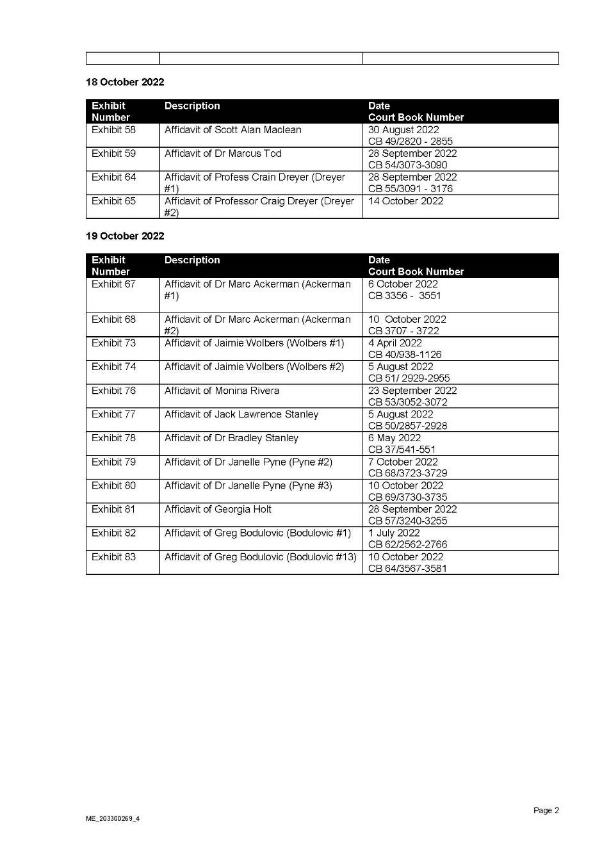
ANNEXURE B
LIST OF EXHIBITS TENDERED IN EVIDENCE
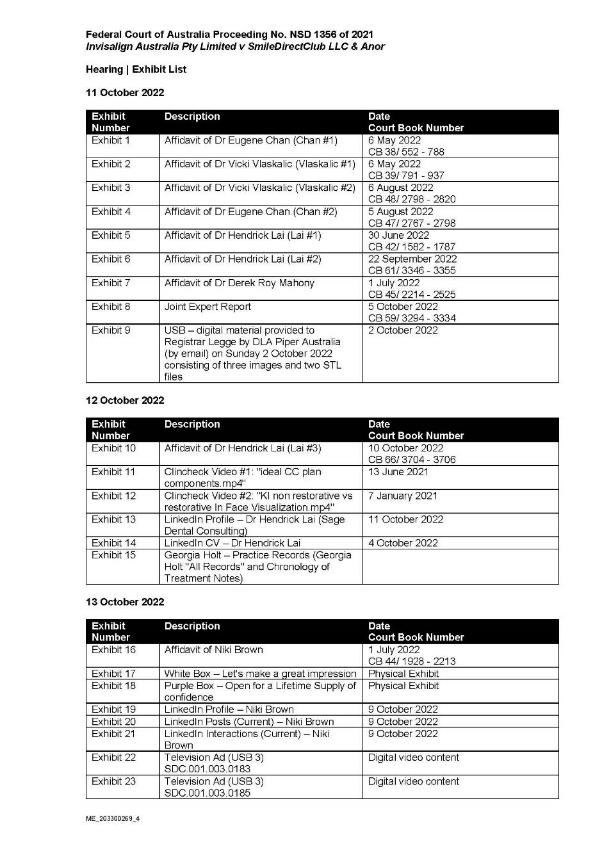
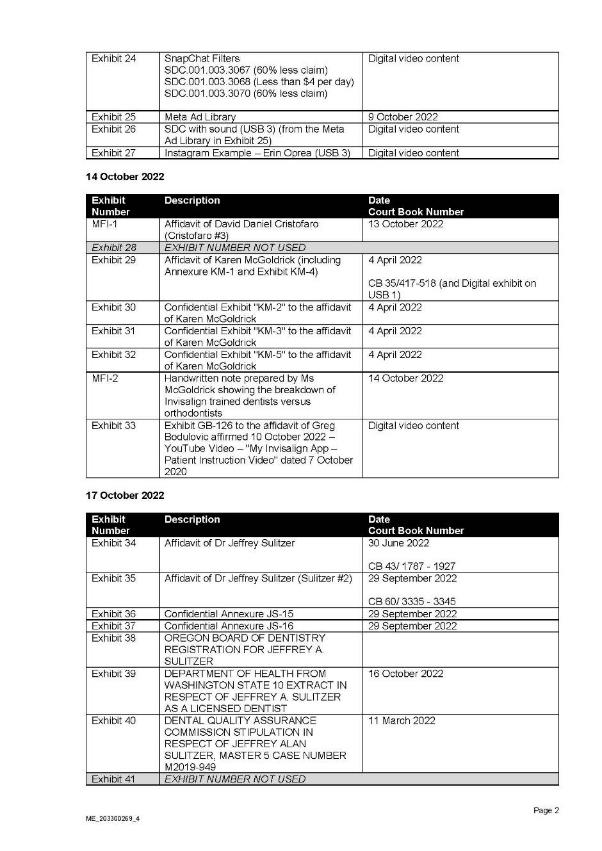
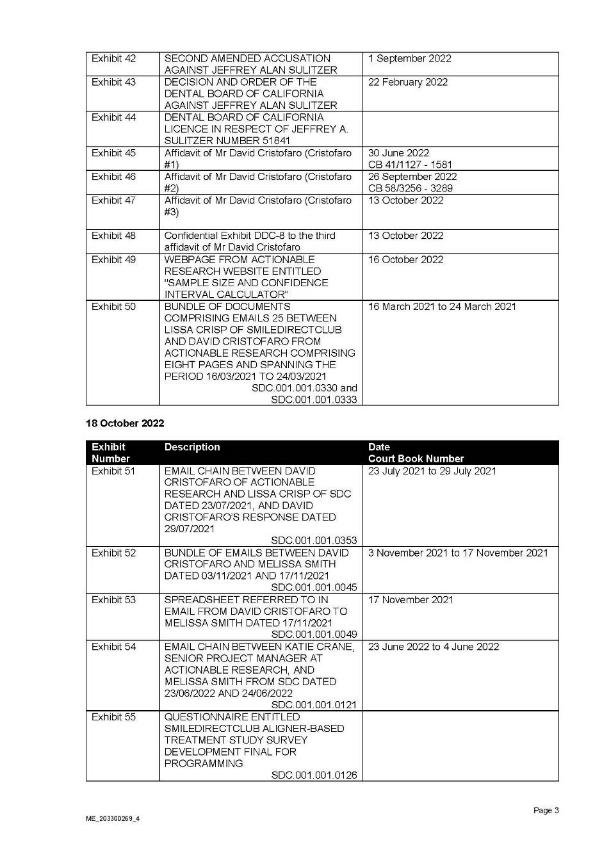
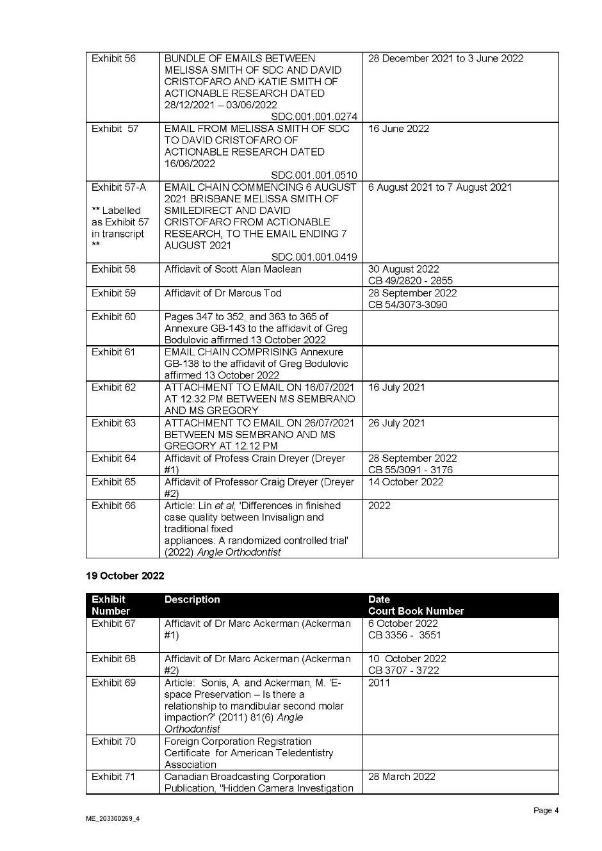
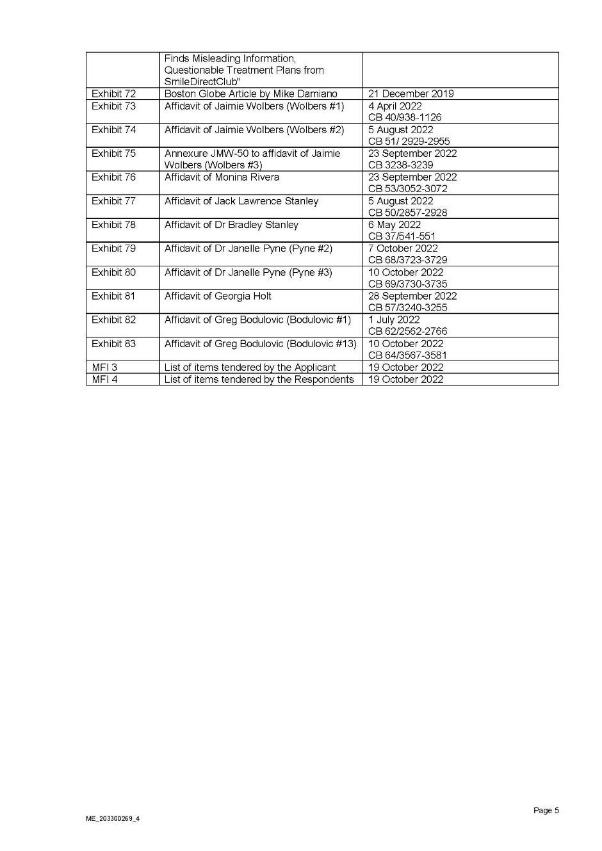
ANNEXURE C
PROMOTIONAL MATERIAL ADMITTED INTO EVIDENCE RELIED ON BY INVISALIGN IN ITS CLAIM AGAINST SDC
